
100 Established in 1921 National Scholastic Press Association & Associated Collegiate Press 2829 University Ave. SE, Suite 720, Minneapolis, MN 55414 info@studentpress.org • nspa.studentpress.org • acp.studentpress.org ©2022 ISBN: 978-0-9742089-6-1 Printed by Herff Jones NATIONAL SCHOLASTIC PRESS ASSOCIATION ASSOCIATED COLLEGIATE PRESS CELEBRATES 100+ YEARS
CELEBRATING SUCCESS
Student journalists from Francis Howell North High School, St. Charles, Missouri, celebrate at the Nov. 23, 2019, awards ceremony at the Fall National High School Journalism Convention, at the Wardman Park Marriott, Washington, D.C.
With 6,161 in attendance the 2019 convention was one of the largest in history. The 2014 convention, also in Washington, D.C., attracted 6,406.
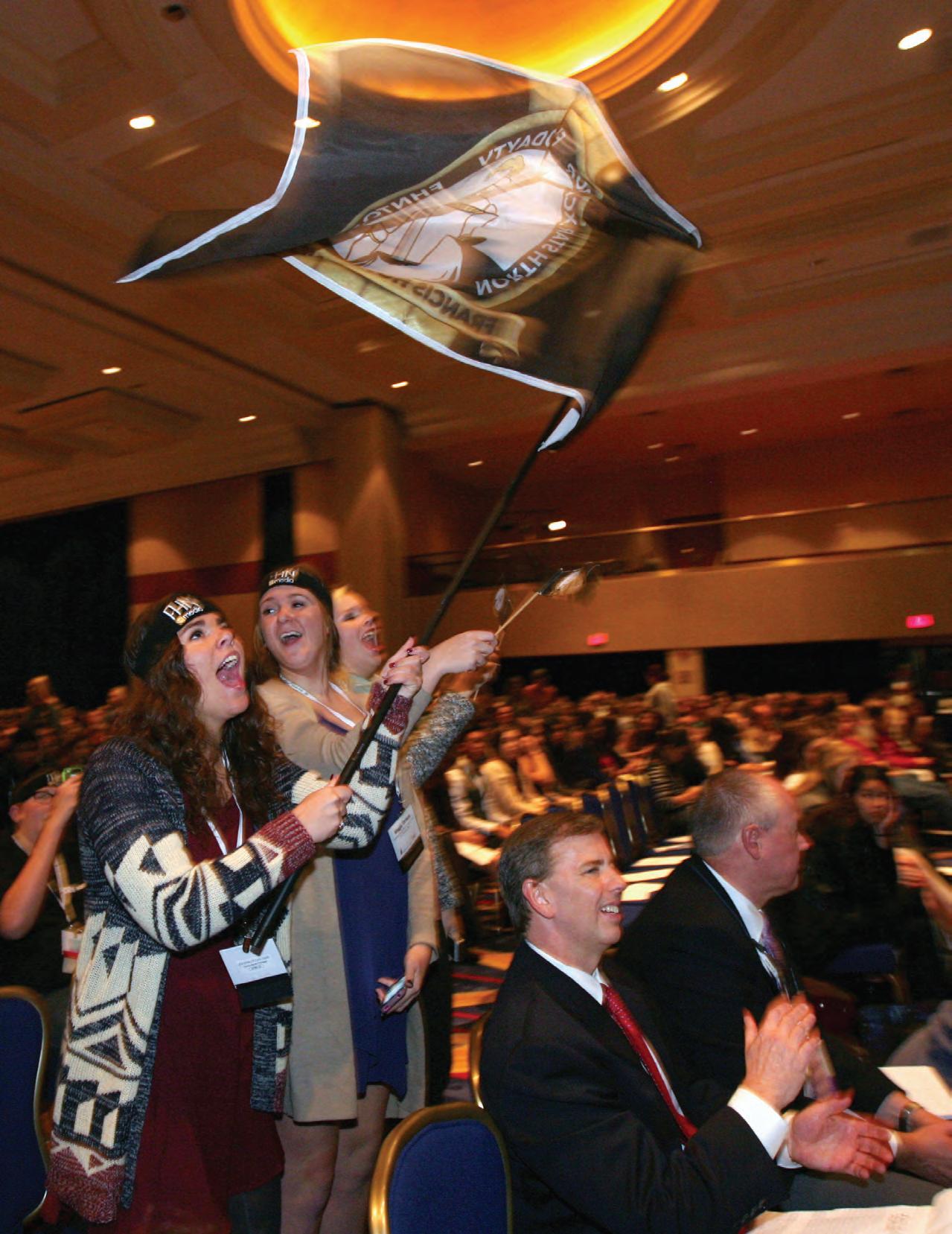
A CENTURY OF SERVICE
National Scholastic Press Association and Associated Collegiate Press celebrate 100 years of service to student journalism.
ITMIGHT HAVE BEEN when your yearbook or newspaper got an All-American rating.
It might have been that first convention trip, by carriage, train, bus, car or airplane.
It might have been that convention keynote speech by Jimmy Carter or Walter Cronkite or Bob Woodward or Abby Phillip or Nina Totenberg.
It might have been that first visit to the U.S. Capitol, to Chicago museums or to the Big Easy.
It might have been when your story, your image, your broadcast or your podcast was posted as an Individual Award finalist.
It might have been that convention awards ceremony, and the anticipation before the Pacemaker awards were announced.
Continued >
ARRIVING IN STYLE
“It’s Thursday morning and Chicago’s railroad stations are jammed with NSPA delegates including this Michigan group,” says the caption in Scholastic Editor magazine. “In 1939, 2,720 delegates representing, 330 institutions in 27 states jammed the Stevens Hotel, the world’s largest hostelry, for the largest roll call in NSPA’s history.”
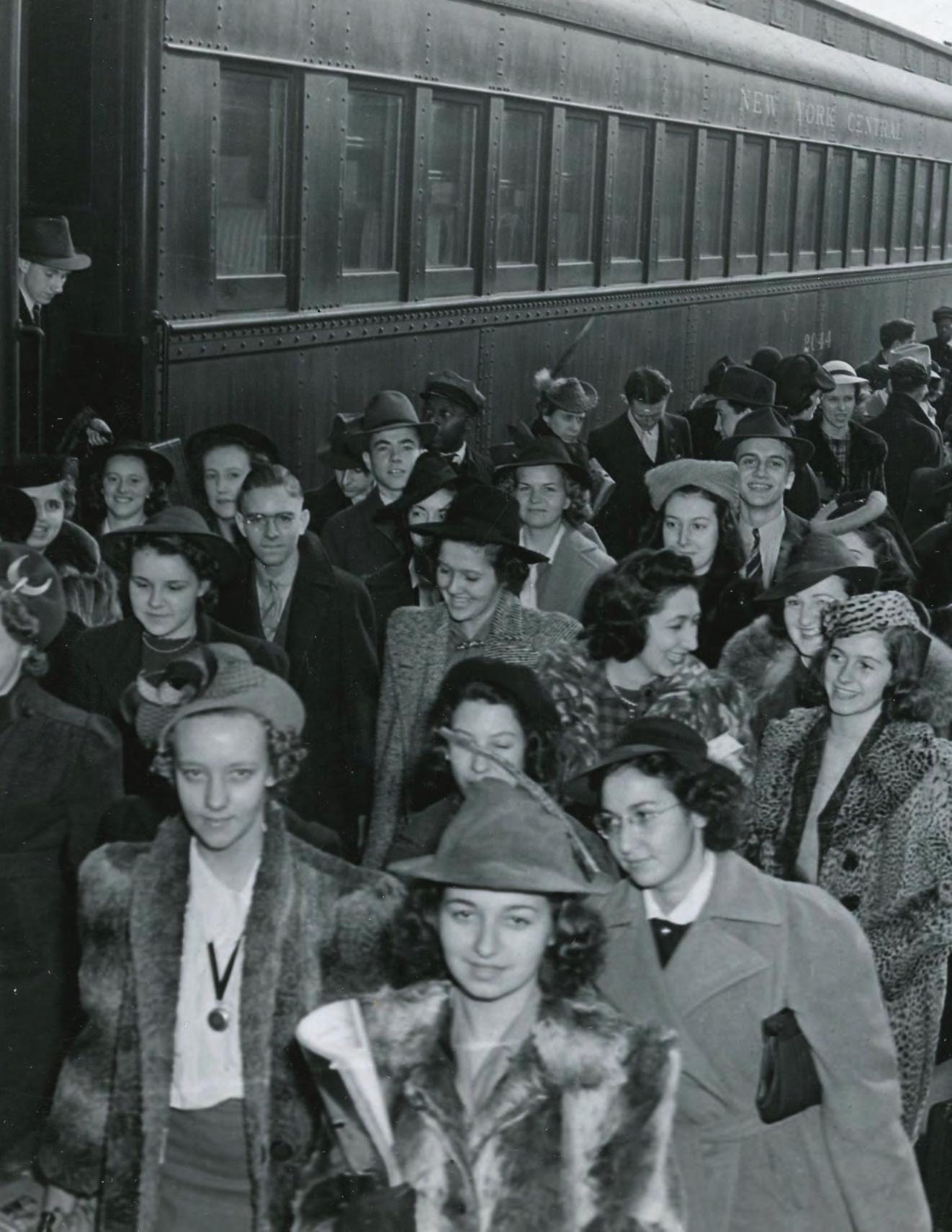
It might have been that convention session or workshop critique or personal connection that gave you the confidence to succeed. Or meeting someone who understands what you do and the challenges you share.
For a century, thousands of student journalists and advisers have been united — through the National Scholastic Press Association in high school and middle school journalism, and the Associated Collegiate Press in collegiate journalism.

NSPA AND ACP SHARE a mission. Through education, training and recognition programs for student journalism, the associations promote the standards and ethics of good journalism as accepted and practiced by print, broadcast and digital media in the United States.
NSPA was founded in 1921 as the Central Interscholastic Press Association, in Madison, Wisconsin. In 1928, CIPA became NSPA and moved to the University of Minnesota, Minneapolis. NSPA is now an independent association, with headquarters near the university.
NSPA has three divisions — National Scholastic Press Association, Associated Collegiate Press and Minnesota High School Press Association. Each association provides journalism education services and support to students, media advisers, teachers and others, including national conventions, student competitions and critique services.
The NSPA division has student-media members in secondary, junior high and middle schools.
The ACP division, since 1933, has student-media members in colleges, universities and professional and technical schools.
The MHSPA division, since 1921, has student-media members in Minnesota’s secondary schools.
All three are organizations for student journalists, with journalism advisers and teachers supporting, advancing and enhancing the organizations’ efforts. For all divisions, memberships are open to student media at public and private schools, with an annual membership fee.
NSPA and ACP conventions, at various sites across the nation, are the nation’s largest gatherings of student journalists. Thousands of student journalists and
Continued >
advisers participate in the conventions, with keynote speeches, learning sessions, awards programs and vendor exhibits.
NSPA’s first convention was in 1921. ACP’s first convention was in 1935, with collegiate journalists meeting at NSPA conventions from 1921.
Two national adviser associations, started at NSPA and ACP conventions, have been long-time convention partners — NSPA fall and spring conventions with Journalism Education Association, and ACP fall conventions with College Media Association. ACP’s midwinter conventions, on the West Coast, began in 1985.
Like the conventions, the national awards programs for both NSPA and ACP provide crucial recognition and support for student journalists and their advisers.
The Pacemaker has long been considered the top prize in student journalism, and honors exceptional work by an organization in print, broadcast and digital media, as well as business management and innovation.
The organizations’ Individual Awards recognize student achievement in a broad range of categories, and, at the conventions, the Best of Show competitions celebrate current achievement in student media.
Dozens of volunteers offer vital support for student media through NSPA and ACP. They speak at conventions. They critique other student media. They judge competitions. They share insight on what student journalists and advisers need. They set the standards of excellence for which NSPA/ACP are known.
A volunteer board of directors governs the associations. For many years, the board president was the top journalism administrator at the University of Minnesota. In 2020, bylaws revisions established the president and president-elect as representatives of scholastic and collegiate journalism.
NSPA/ACP also support and assist state, regional and national student-media associations and other non-student groups and businesses that share the mission.
The goal — for more than a century — has been to educate, support and celebrate student journalism.

Continued >
THE TOP PRIZE
First awarded in 1927, the Pacemaker has long been considered the top prize in student journalism. Angel Vogel, editor of the Tulane Hullaballoo, receives the Pacemaker from William Dickenson, editor of the Philadelphia Bulletin at the 1966 ACP convention in Philadelphia.
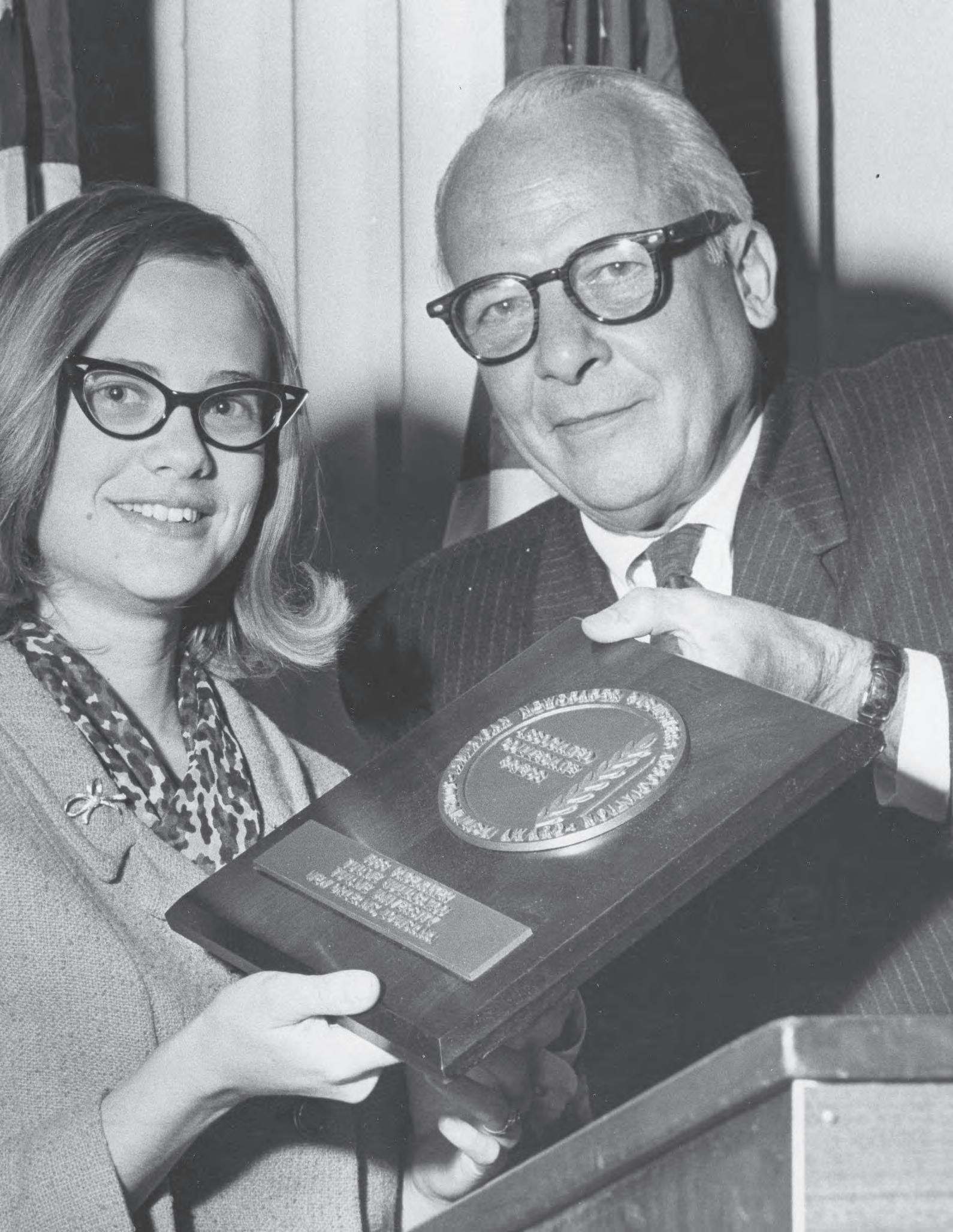
A TIME FOR FUN

In 1925, the convention ball was held after the banquet. Approximately 885 attended the sixth national convention in Madison, Wisconsin. Decades later, Claire Meyers, Convent of the Sacred Heart High School, San Francisco, enjoys 2003 convention dance in Washington, D.C.

LAURA WIDMER, executive director since 2015, is one of us who found a community within student journalism.
Widmer grew up in central Missouri, attended Northwest Missouri State University, in Maryville, and joined the Tower yearbook staff.
“When I attended Northwest, I initially never imagined a career as a student media adviser. I wanted to be a feature writer,” Widmer said. “But then, I attended my first ACP convention in New Orleans in 1977. I saw the Pacemaker award ceremony and knew I wanted to be a part of it.
“I loved everything about student media, and my career path changed.”
Her adviser? Linda Puntney.
Her fellow staff member? Ann Visser. One of her alumni? Lisa Renze Rhodes.
Laura went on to teach and advise student media at Northwest and become CMA president.
Linda taught, advised and became the long-time director of JEA.
Ann taught journalism and advised student publications in Iowa, led JEA as president and served on the NSPA board.
Lisa worked as a reporter and now advises student media at Ball State University, Muncie, Indiana.
“We have seen much change in student journalism over the years,” Widmer said. “However, the bottom line is NSPA and ACP support good journalism and good storytelling.”
LAURA, LINDA, ANN AND LISA are just four among dozens, even hundreds of us.
We are storytellers — through text, through images, through audio and video.

We are inspired by the teachers and advisers who preceded us. They taught us how student journalism serves and engages audience.
We become journalists and work in media around the world.
We become advisers and teachers who build the future of journalism within our democracy. We find our community. n
CENTENNIAL RECOGNITION
Celebrating the top student publications as well as advisers and educators during the past century.
12 INTRODUCTION
Laura Widmer, NSPA/ACP executive director, reflects on a century of service.
13 THE ACP PIONEER AWARDS
Presented to 101 advisers and educators at a special recognition breakfast at The National Press Club during the 2022 Washington, D.C. convention.
15 THE NSPA PACEMAKER 100
Presented at a special ceremony at the 2022 St. Louis, Missouri, convention and designating the most Pacemakers in the past century.
18 THE ACP PACEMAKER 100
Presented at a reception at The Washington Post during the 2022 Washington, D.C. convention and designating the most Pacemakers in the past century.
DEAR
FRIENDS, NSPA and ACP have empowered student journalists for 100+ years.
On a personal note, I attended my first college convention in 1977 in New Orleans. In 1982 I took students from Clinton (Missouri) High School to the fall National High School Journalism Convention in Kansas City. As student publications director at Northwest Missouri State University, I brought students to the ACP/CMA fall convention for 28 years, starting with Chicago in 1982.
Both organizations have provided the services and resources to enable student media programs achieve success. Whether it’s showcasing our past winners, providing Pacemaker Master Classes, Town Halls or hosting training workshops, our goal has always been to give students and advisers the tools needed for a great publication.
One of our primary tools to help newsrooms improve is through our critique service. It is safe to say that millions of critiques have passed through our offices over the years. These critiques educate staffs about the standards of good journalism. If a staff excels, they will be awarded an AllAmerican status by a judge. This rating is a great achievement, but even if it isn’t awarded, the publication and its staff are still winners because they will benefit from the evaluator’s comments.
NSPA partners with Journalism Education Association to present a fall and spring National High School Journalism Convention. ACP partners with College Media Association in the fall to co-host the National College Media Convention. In the spring, ACP hosts its Spring National College Media Conference in California.
These conventions are some of the best benefits we provide our members. It’s an opportunity to not only learn from experts, but to learn from each other. What a great experience for staffs to explore a city together. It’s a great way to learn from each other and share experiences that will become life-long memories. There’s no better bonding experience than to explore a city
LAURA WIDMER Executive Director
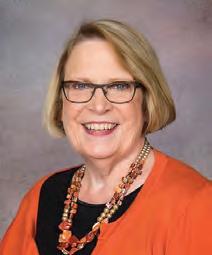
together laughing and having fun because in the end the staff will gel and become a team.
NSPA and ACP love to recognize our national award winners. Whether it’s the Individual Awards, Pacemaker, Hall of Fame, and now, the Pacemaker 100, these prestigious programs are simply the best in student media. In Washington, D.C., ACP recognized our 101 Pioneer recipients. This was the first time ACP awarded advisers and educators such an elite honor. In spring 2022, ACP and NSPA will introduce our next tier of Hall of Fame recognition, the Platinum Level.
Throughout our scholastic press association journey, partnerships made us stronger.
We’re not in this alone. Our strength comes from our members and from the collaborative relationships we have developed with JEA, CMA, Journalism Educators of Minnesota and Quill and Scroll. When one prospers, we all benefit, and student journalism is the winner. We also acknowledge the time and support of our judges, sponsors and exhibitors. Our success is tied to your contributions. We are stronger together.
To me, so many things related to scholastic media have to do with friendships. Those friendships tend to form and evolve at national conventions. Conventions are more like nonstressful family reunions. Your hugs are heartfelt. Your “let’s find time to catch up” line is sincere. When you ask for help, your journalism friends always say, “What can I do?” You can talk about anything and laugh at almost everything. It’s those colleagues who make us a better adviser, teacher and journalist. They have become lifelong friends. Thank you for your friendship.
As the oldest national student press association in the country, you can rest assured we will be there to teach you, provide resources for you, recognize your good work and celebrate you. We will continue to empower you to lift up your voices to be heard as you seek and report truth and as you tell the stories of the next 100 years. n
CENTENNIAL RECOGNITION // INTRODUCTION
012
ACP PIONEER AWARDS
IN HONOR of its 100th birthday, Associated Collegiate Press celebrated journalism educators and advocates of the organization.
At the Fall National College Media Conference in Washington, D.C., ACP honored 101 advisers and educators with the Pioneer Award during a special Friday morning breakfast at the National Press Club.
The Pioneer is the only award ACP presents to journalism educators and media advisers.
Pioneers are distinguished journalism educators who have made substantial contributions to ACP and provided exceptional leadership in their college media programs.
“We wanted to recognize 101 great journalism advisers and educators in this first class, Laura Widmer, ACP executive director, said. “These educators and journalists have been supportive of ACP and believed in our mission. These recipients are educators who have gone above and beyond, not only for ACP, but in their own newsroom. These Pioneers represent a Who’s Who of collegiate journalism.”
ACP will maintain a composite plaque of Pioneers and display it at its headquarters. Candidates were selected by a six-member committee of retired and active advisers from across the country.
PIONEER AWARDS
DAVID ADAMS
Fort Hays State University
Kansas State University
Indiana University
ROBERT ADAMS
Western Kentucky University
ANN AKERS
Associated Collegiate Press
CHUCK BALDWIN
University of South Dakota
BOB BERGLAND
Missouri Western State University
Northwest Missouri State University
PAUL BITTICK
California Polytechnic State University, San Luis Obispo
ROBERT BOHLER
Texas Christian University
KAREN BOSLEY
Ocean County College (New Jersey)
JOHN BOYD
Indiana State University
MAX BRANSCOMB
Southwestern College (California)
BOB BULLARD
Michigan State University
STACIA CAMPBELL
Northwestern University (Illinois)
STEVEN CHAPPELL
Northwest Missouri State University
JAN CHILDRESS
Texas Tech University
WILLIAM CLICK
Winthrop University (South Carolina)
JOLENE COMBS
El Camino College (California)
MONA CRAVENS
University of Southern California
JENNY TENPENNY CROUCH
Middle Tennessee State University
ALBERT “FLIP” DELUCA
James Madison University (Virginia)
WILLIAM D. DOWNS JR.
Ouachita Baptist University (Arkansas)
BILL ELSEN
The Washington Post
STACY SPARKS ENGLAND
Dodge City Community College (Kansas)
St. Mary of the Plains College (Kansas)
Southwestern College (Kansas)
DOROTHY ESTES
University of Texas at Arlington
VINCE FILAK
University of Wisconsin Oshkosh
ANNETTE FORBES
Iowa State University
BETH FRANCESCO
University of Texas at Arlington
National Press Club
JOE GISONDI
Eastern Illinois University
LLOYD GOODMAN
University of Texas at Arlington
MARK GOODMAN
Student Press Law Center
NANCY GREEN
University of Kentucky
University of Texas
LAURA YORK GUY
Garden City Community College (Kansas)
GERRY HAMILTON
Pennsylvania State University
JAY HARTWELL
University of Hawai’i at Mānoa
MIKE HIESTAND
Student Press Law Center
CHET HUNT
San Antonio College (Texas)
LOUIS INGELHART
Ball State University
ERIC JACOBS
University of Pennsylvania
RON JOHNSON
Fort Hays State University
Kansas State University Indiana University
013 CENTENNIAL RECOGNITION // ACP PIONEER AWARDS
100 Continued >
MICHAEL JORDAN
Pepperdine University (California)
RACHELE KANIGEL
San Francisco State University
FRED KILDOW
Associated Collegiate Press
DOUG KIRCHBERG
Madison Area Technical College (Wisconsin)
DAVID KNOTT
Ball State University
LILLIAN LODGE KOPENHAVER
Florida International University
KELLEY LASH
Rice University (Texas)
IRA DAVID LEVY
Wilbur Wright College (Illinois)
Kansas State University
C.W. LITTLE
Santa Ana College (California)
FRANK LOMONTE
Student Press Law Center
GARY LUNDGREN
University of Arkansas
DICK LYTLE
Southern Methodist University (Texas)
WAYNE MAIKRANZ
University of North Carolina at Charlotte
KATE MCCARTY
University of Alabama
University of Texas
C.J. MEDLIN
Kansas State University
GARY METZKER
California State University Long Beach
HARRY MONTEVIDEO
University of Georgia
REID MONTGOMERY
Florida State University
BILL NEVILLE
University of Alabama at Birmingham
LINDA OWENS
University of South Carolina Aiken
PAT PARISH
Louisiana State University
ERICA PEREL
University of North Carolina
MARILYN PETERSON
Midland College (Nebraska)
TOM PIERCE
Valencia College (Florida)
MARK PLENKE
California State University, Chico
DARIO POLITELLO
University of Massachusetts
LINDA PUNTNEY
Kansas State University
JOSE QUEVEDO
Miami Dade College (Florida)
SARA QUINN
Poynter Institute
Kansas State University
University of Minnesota
MARK RADUZINER
Johnson County Community College (Kansas)
JUDY RIEDL
University of Oregon
TOM ROLNICKI
Associated Collegiate Press
NILS ROSDAHL
North Idaho College
KEN ROSENAUER
Missouri Western State University
ARTHUR “SANDY”
SANDERSON
University of Iowa
CHARLES SAVEDGE
Yearbook consultant
LAURA SCHAUB
University of Oklahoma
KEVIN SCHWARTZ
University of North Carolina
AL SCROGGINS
University of South Carolina
MICHAEL SERINO
Ithaca College (New York)
TRUM SIMMONS
Harrisburg Area Community College (Pennsylvania)
SUSAN SMITH
South Dakota State University
RON SPIELBERGER
College Media Association
University of Memphis
RANDY STANO
University of Miami
RICHARD “DICK” SUBLETTE
University of Illinois
EDMUND SULLIVAN
Columbia Scholastic Press Association
SHERRI TAYLOR
Syracuse University (New York)
ANN THORNE
Missouri Western State College
JAMES TIDWELL
Eastern Illinois University
AL TIMS
University of Minnesota
TERRY VANDER HAYDEN
Franklin College (Indiana)
PETE WAACK
Colorado State University
BRUCE WATTERSON
yearbook consultant
DAVID WENDELKEN
James Madison University (Virginia)
NANCY WHITE
Hillsborough Community College (Florida)
RON WHITE
Louisiana Tech University
LAURA WIDMER
Northwest Missouri State University
ED WILLIAMS
Auburn University (Alabama)
BRADLEY WILSON
Midwestern State University (Texas)
MARK WITHERSPOON
Iowa State University
RUTH WITMER
Indiana University
MARK WOODHAMS
University of Arizona
PAUL WRIGHT
University of Alabama
014 CENTENNIAL RECOGNITION // ACP PIONEER AWARDS
> ACP Pioneers continued
100
NSPA AND ACP RECOGNIZED
its top 100 publications in its 100th year. Founded in 1921, NSPA/ACP has trained and honored student journalists through conventions, workshops and awards.
First presented in 1927 as the “Pace-Maker,” the Pacemaker awards are now recognized as the top prizes in scholastic journalism. They honor the very best student broadcasts, literary arts magazines, newspapers/ newsmagazines, online publications, specialty magazines and yearbooks.
“The Pacemaker really represents the best of the best and it is appropriate that we recognize the rich tradition this award has in scholastic journalism as part of our centennial celebration,” associate director Gary Lundgren said.
The Pacemaker 100 represents a onetime snapshot of the top 100 publications recognized in the competition during its history. Each Pacemaker finalist was awarded five points and each Pacemaker earned 10 points.
Results were tabulated and announced in May 2021.
PACEMAKER 100
TOP 10
1. LAIR 23 PACEMAKERS / 3 PACEMAKER FINALISTS
Yearbook
Shawnee Mission Northwest High School
Shawnee, Kansas
2. DECAMHIAN
20 PACEMAKERS / 7 PACEMAKER FINALISTS
Yearbook
Del Campo High School Fair Oaks, California
3. WINGS
22 Pacemakers / 2 Pacemaker finalists
Yearbook
Arrowhead Christian Academy Redlands, California
4. INDIAN
18 PACEMAKERS / 4 PACEMAKER FINALISTS
Yearbook
Shawnee Mission North High School
Overland Park, Kansas
TIE: 5. RAMPAGES
16 PACEMAKERS / 7 PACEMAKER FINALISTS
Yearbook
Casa Roble High School
Orangevale, California
5. PIONEER
16 PACEMAKERS / 7 PACEMAKER FINALISTS
Yearbook
Kirkwood High School
Kirkwood, Missouri
7. PARAGON
15 PACEMAKERS / 8 PACEMAKER FINALISTS
Yearbook
Munster High School
Munster, Indiana
8. THE LITTLE HAWK
15 PACEMAKERS / 6 PACEMAKER FINALISTS
Newspaper/Newsmagazine
Iowa City High School
Iowa City, Iowa
TIE:
9. HAUBERK
15 PACEMAKERS / 5 PACEMAKER FINALISTS
Yearbook
Shawnee Mission East High School
Prairie Village, Kansas
9. HTV MAGAZINE
15 PACEMAKERS / 5 PACEMAKER FINALISTS
Broadcast Hillcrest High School
Springfield, Missouri
9. SPARK
15 PACEMAKERS / 5 PACEMAKER FINALISTS
Newspaper/Newsmagazine
Lakota East High School
Liberty Township, Ohio
CRUSADER
Newspaper/Newsmagazine
Salpointe Catholic High School
Tucson, Arizona
HORNET
Yearbook
PACEMAKER 100
(ALPHABETICAL BY STATE)
CS PRESS
Newspaper/Newsmagazine
Cactus Shadows High School
Cave Creek, Arizona
Bryant High School
Bryant, Arkansas
CONNOTATIONS
Literary Arts Magazine
Fayetteville High School
Fayetteville, Arkansas
TITANIUM
Yearbook
Antelope High School
Continued >
CENTENNIAL RECOGNITION // NSPA PACEMAKER 100
015
THE PACEMAKER 100
Antelope, California
EPIC
Yearbook
Center High School
Antelope, California
THE EPITAPH
Newspaper/Newsmagazine
Homestead High School
Cupertino, California
EL ESTOQUE
Newspaper/Newsmagazine
Monta Vista High School
Cupertino, California
EL ESTOQUE ONLINE
Online
Monta Vista High School
Cupertino, California
DECAMHIAN
Yearbook
Del Campo High School
Fair Oaks, California
THE FEATHER ONLINE
Online
Fresno Christian High School
Fresno, California
THE GAZETTE
Newspaper/Newsmagazine
Granite Bay High School
Granite Bay, California
WINGSPAN
Yearbook
James C. Enochs High School
Modesto, California
RAMPAGES
Yearbook
Casa Roble High School
Orangevale, California
CAMPANILE
Newspaper/Newsmagazine
Palo Alto High School
Palo Alto, California
THE PALY VOICE
Online
Palo Alto High School
Palo Alto, California
VERDE
Newspaper/Newsmagazine
Palo Alto High School
Palo Alto, California
WINGS
Yearbook
Arrowhead Christian Academy
Redlands, California
PILOT
Yearbook
Redondo Union High School
Redondo Beach, California
TONITRUS
Yearbook
Rocklin High School
Rocklin, California
DETAILS
Yearbook
Whitney High School
Rocklin, California
LOWELL
Newspaper/Newsmagazine
Lowell High School
San Francisco, California
THE AMERICAN
Yearbook
Independence High School
San Jose, California
STAGG LINE
Newspaper/Newsmagazine
Amos Alonzo Stagg High School
Stockton, California
THE CHRONICLE
Newspaper/Newsmagazine
Harvard-Westlake School
Studio City, California
CUB TRAX
Yearbook
Cupertino Middle School
Sunnyvale, California
CAYUSE
Yearbook
Walnut High School
Walnut, California
UNION STREET JOURNAL
Newspaper/Newsmagazine
Cherry Creek High School
Englewood, Colorado
THE PROWL
Yearbook
Powell Middle School
Littleton, Colorado
EAGLE EYE VIEW
Yearbook
Sierra Middle School
Parker, Colorado
LITERARY AND VISUAL ARTS
Literary Arts Magazine
Maret School
Washington, D.C.
THE SOUTHERNER
Newspaper/Newsmagazine
Henry W. Grady High School
Atlanta, Georgia
U-HIGH MIDWAY
Newspaper/Newsmagazine
University of Chicago Laboratory High School
Chicago, Illinois
RENAISSANCE
Literary Arts Magazine
University of Chicago Laboratory High School
Chicago, Illinois
NEW PENNIES
Literary Arts Magazine
DeKalb High School
DeKalb, Illinois
ETRUSCAN
Yearbook
Glenbrook South High School
Glenview, Illinois
LION
Newspaper/Newsmagazine
Lyons Township High School
La Grange, Illinois
THE CENTRAL TIMES
Newspaper/Newsmagazine
Naperville Central High School
Naperville, Illinois
HILITE
Newspaper/Newsmagazine
Carmel High School
Carmel, Indiana
HILITE ONLINE
Online
Carmel High School
Carmel, Indiana
LOG
Yearbook
Columbus North High School
Columbus, Indiana
PARAGON
Yearbook
Munster High School
Munster, Indiana
THE LITTLE HAWK
Newspaper/Newsmagazine
Iowa City High School
Iowa City, Iowa
016 CENTENNIAL RECOGNITION // NSPA PACEMAKER 100
> NSPA Pacemaker 100 continued
EAGLE/STAMPEDE
Yearbook
Maize Intermediate School/ Maize South Middle School
Maize, Kansas
INDIAN
Yearbook
Shawnee Mission North High School
Overland Park, Kansas
HAUBERK
Yearbook
Shawnee Mission East High School
Prairie Village, Kansas
THE HARBINGER
Newspaper/Newsmagazine
Shawnee Mission East High School
Prairie Village, Kansas
THE HARBINGER ONLINE
Online
Shawnee Mission East High School
Prairie Village, Kansas
LAIR
Yearbook
Shawnee Mission Northwest High School
Shawnee, Kansas
THE NORTHWEST PASSAGE
Newspaper/Newsmagazine
Shawnee Mission Northwest High School
Shawnee, Kansas
EREHWON
Literary Arts Magazine
Winston Churchill High School
Potomac, Maryland
SILVER CHIPS
Newspaper/Newsmagazine
Montgomery Blair High School
Silver Spring, Maryland
COLOPHON
Literary Arts Magazine
Towson High School
Towson, Maryland
WAYLAND STUDENT
PRESS NETWORK
Online
Wayland High School
Wayland, Massachusetts
CENIAD
Yearbook
East Lansing High School
East Lansing, Michigan
FENTONIAN
Yearbook
Fenton High School
Fenton, Michigan
THE TOWER
Newspaper/Newsmagazine
Grosse Pointe South High School
Grosse Pointe Farms, Michigan
THE UPDATE
Newspaper/Newsmagazine
H.H. Dow High School
Midland, Michigan
IMAGES ON THE WIND
Literary Arts Magazine
Edina High School
Edina, Minnesota
CENTRAL HIGH NEWS
Newspaper/Newsmagazine
Central High School
Minneapolis, Minnesota
WEST HIGH WEEKLY/ WEST HIGH TIMES
Newspaper/Newsmagazine
West High School
Minneapolis, Minnesota
KNIGHT ERRANT Online
Benilde-St. Margaret’s School
St. Louis Park, Minnesota
ECHO
Newspaper/Newsmagazine
St. Louis Park High School
St. Louis Park, Minnesota
COGWHEEL
Newspaper/Newsmagazine
Mechanic Arts High School
St. Paul, Minnesota
GLOBE
Newspaper/Newsmagazine
Clayton High School
Clayton, Missouri
PIONEER
Yearbook
Kirkwood High School
Kirkwood, Missouri
THE KIRKWOOD CALL
Newspaper/Newsmagazine
Kirkwood High School
Kirkwood, Missouri
NORTH STAR
Newspaper/Newsmagazine
Francis Howell North High School
St. Charles, Missouri
FHNTODAY
Online
Francis Howell North High School
St. Charles, Missouri
COURIER
Newspaper/Newsmagazine
Normandy High School
St. Louis, Missouri
HTV MAGAZINE
Broadcast
Hillcrest High School
Springfield, Missouri
WESTWIND
Yearbook
West Henderson High School
Hendersonville, North Carolina
YEARBOOK
Yearbook
Bay High School
Bay Village, Ohio
JOHN ADAMS JOURNAL
Newspaper/Newsmagazine
John Adams High School
Cleveland, Ohio
SPARK
Newspaper/Newsmagazine
Lakota East High School
Liberty Township, Ohio
THE AXE
Newspaper/Newsmagazine
South Eugene High School
Eugene, Oregon
EL PAISANO
Yearbook
Westlake High School
Austin, Texas
FEATHERDUSTER
Newspaper/Newsmagazine
Westlake High School
Austin, Texas
HILLCREST HURRICANE
Newspaper/Newsmagazine
Hillcrest High School
Dallas, Texas
MARKSMEN
Yearbook
St. Mark’s School of Texas
Dallas, Texas
THE REMARKER
Newspaper/Newsmagazine
St. Mark’s School of Texas
Dallas, Texas
CENTENNIAL RECOGNITION // NSPA PACEMAKER 100
017
Continued >
NSPA Pacemaker 100 continued
VIBRATO
Literary Arts Magazine
The Hockaday School
Dallas, Texas
HOOFBEATS
Yearbook
Burges High School
El Paso, Texas
STAMPEDE
Newspaper/Newsmagazine
Burges High School
El Paso, Texas
THE RIDER ONLINE
Online
Legacy High School
Mansfield, Texas
THE LION
Yearbook
McKinney High School
McKinney, Texas
THE HAWK
Yearbook
Pleasant Grove High School
Texarkana, Texas
THE TIGER
Yearbook
Texas High School
Texarkana, Texas
RUNES
Literary Arts Magazine
Brighton High School
Salt Lake City, Utah
TJTODAY
Newspaper/Newsmagazine
Thomas Jefferson High School for Science and Technology
Alexandria, Virginia
ODYSSEY
Yearbook
Chantilly High School
Chantilly, Virginia
CHATTERBOX
Newspaper/Newsmagazine
George Washington High School
Danville, Virginia
SENTRY
Yearbook
Robinson Middle School
Fairfax, Virginia
TRNWIRED
Online
Prince George High School
Prince George, Virginia
SAGA
Yearbook
Loudoun Valley High School
Purcellville, Virginia
PENINSULA OUTLOOK
Newspaper/Newsmagazine
Peninsula High School
Gig Harbor, Washington
LINCOLN NEWS
Newspaper/Newsmagazine
Lincoln High School
Tacoma, Washington
SHOREWOOD RIPPLES
Newspaper/Newsmagazine
Shorewood High School
Milwaukee, Wisconsin
WASHINGTON SCROLL
Newspaper/Newsmagazine
Washington High School
Milwaukee, Wisconsin
THE SCROLL
Newspaper/Newsmagazine
The American School in London Middle School
London, England
7.
17 PACEMAKERS / 8 PACEMAKER FINALISTS Newspaper Contra Costa College San Pablo, California
PACEMAKER 100 TOP 10
8.
19 PACEMAKERS / 4 PACEMAKER FINALISTS Newspaper Michigan State University East Lansing, Michigan
9.
University of North Carolina at Chapel Hill Chapel Hill, North Carolina
10. FLUX
018 CENTENNIAL RECOGNITION // NSPA & ACP PACEMAKER 100
1. ROYAL PURPLE 30 PACEMAKERS / 7 PACEMAKER FINALISTS Yearbook Kansas State University Manhattan, Kansas
2. DAILY TEXAN 22 PACEMAKERS / 12 PACEMAKER FINALISTS Newspaper University of Texas at Austin Austin, Texas
3. INDIANA DAILY STUDENT 22 PACEMAKERS / 8 PACEMAKER FINALISTS Newspaper Indiana University Bloomington, Indiana
4. MINNESOTA DAILY 22 PACEMAKERS / 7 PACEMAKER FINALISTS Newspaper University of Minnesota Minneapolis, Minnesota
5. AUBURN PLAINSMAN 21 PACEMAKERS / 8 PACEMAKER FINALISTS Newspaper Auburn University Auburn, Alabama
6. COLLEGE HEIGHTS HERALD 16 PACEMAKERS / 11 PACEMAKER FINALISTS Newspaper Western Kentucky University Bowling Green, Kentucky
THE ADVOCATE
THE STATE NEWS
THE DAILY TAR HEEL
14 PACEMAKERS / 13 PACEMAKER FINALISTS Newspaper
19 PACEMAKERS / 2 PACEMAKER FINALISTS Magazine University of Oregon Eugene, Oregon >
PACEMAKER 100
(ALPHABETICAL BY STATE)
AUBURN PLAINSMAN
Newspaper
Auburn University
Auburn, Alabama
COROLLA
Yearbook
University of Alabama
Tuscaloosa, Alabama
THE CRIMSON WHITE
Newspaper
University of Alabama
Tuscaloosa, Alabama
ARIZONA DAILY WILDCAT ONLINE
Online
University of Arizona
Tucson, Arizona
OUACHITONIAN
Yearbook
Ouachita Baptist University
Arkadelphia, Arkansas
RAZORBACK
Yearbook
University of Arkansas
Fayetteville, Arkansas
AMERICAN RIVER REVIEW
Magazine
American River College
Sacramento, California
THE ORION
Newspaper
California State University, Chico
Chico, California
THE ADVOCATE
Newspaper
Contra Costa College
San Pablo, California
WARWHOOP
Newspaper
El Camino College
Torrence, California
JUNIOR COLLEGIAN/ LOS ANGELES COLLEGIAN
Newspaper
Los Angeles City College
Los Angeles, California
OASIS/CURRENTS
Magazine
Pepperdine University
Malibu, California
THE GRAPHIC
Newspaper
Pepperdine University
Malibu, California
GOLDEN GATER/GOLDEN
GATE XPRESS
Newspaper
San Francisco State University
San Francisco, California
THE GOLDEN GATE XPRESS ONLINE
Online
San Francisco State University
San Francisco, California
EL DON
Newspaper
Santa Ana College
Santa Ana, California
SOUTHWESTERN SUN
Newspaper
Southwestern College
Chula Vista, California
THE DAILY BRUIN
Newspaper
University of California, Los Angeles
Los Angeles, California
DAILY TROJAN
Newspaper
University of Southern California
Los Angeles, California
THE REVIEW
Newspaper
University of Delaware
Newark, Delaware
THE GW HATCHET
Newspaper
George Washington University
Washington, D.C.
FALCON TIMES
Newspaper
Miami-Dade Community College North
Miami, Florida
METROPOLIS
Newspaper
Miami-Dade Community College Wolfson
Miami, Florida
DISTRACTION
Magazine
University of Miami
Coral Gables, Florida
IBIS
Yearbook
University of Miami
Coral Gables, Florida
THE EMORY WHEEL
Newspaper
Emory University
Atlanta, Georgia
THE RED & BLACK
Newspaper
University of Georgia
Athens, Georgia
CARDINAL REVIEW/THE SENTINEL
Newspaper
North Idaho College
Coeur d’Alene, Idaho
ECHO
Magazine
Columbia College Chicago
Chicago, Illinois
THE COLUMBIA CHRONICLE
Newspaper
Columbia College Chicago
Chicago, Illinois
THE COLUMBIA CHRONICLE ONLINE
Online
Columbia College Chicago
Chicago, Illinois
THE DAILY NORTHWESTERN
Newspaper
Northwestern University
Evanston, Illinois
F NEWSMAGAZINE
Newspaper
School of the Art Institute of Chicago
Chicago, Illinois
DAILY ILLINI ONLINE
Online
University of Illinois
Champaign, Illinois
CENTENNIAL RECOGNITION // ACP PACEMAKER 100
019
Continued >
BALL STATE DAILY NEWS
Newspaper
Ball State University
Muncie, Indiana
EXPO/BALL BEARINGS
Magazine
Ball State University
Muncie, Indiana
ORIENT
Yearbook
Ball State University
Muncie, Indiana
ARBUTUS
Yearbook
Indiana University
Bloomington, Indiana
INDIANA DAILY STUDENT
Newspaper
Indiana University
Bloomington, Indiana
INDIANA DAILY STUDENT ONLINE
Online
Indiana University
Bloomington, Indiana
DRAKE MAGAZINE
Magazine
Drake University
Des Moines, Iowa
THE DAILY IOWAN
Newspaper
University of Iowa
Iowa City, Iowa
KANSAS STATE COLLEGIAN
Newspaper
Kansas State University
Manhattan, Kansas
ROYAL PURPLE
Yearbook
Kansas State University
Manhattan, Kansas
KANZA
Yearbook
Pittsburg State University
Pittsburg, Kansas
THE UNIVERSITY DAILY KANSAN
Newspaper
University of Kansas
Lawrence, Kansas
THE UNIVERSITY DAILY KANSAN ONLINE
Online
University of Kansas
Lawrence, Kansas
THE EASTERN PROGRESS
Newspaper
Eastern Kentucky University
Richmond, Kentucky
THE MURRAY STATE NEWS
Newspaper
Murray State University
Murray, Kentucky
THE KENTUCKY KERNEL
Newspaper
University of Kentucky
Lexington, Kentucky
COLLEGE HEIGHTS HERALD
Newspaper
Western Kentucky University
Bowling Green, Kentucky
TALISMAN
Yearbook/Magazine
Western Kentucky University
Bowling Green, Kentucky
THE MAROON
Newspaper
Loyola University
New Orleans, Louisiana
HULLABALOO
Newspaper
Tulane University
New Orleans, Louisiana
THE NEWS-LETTER
Newspaper
Johns Hopkins University
Baltimore, Maryland
THE BRIDGE Magazine
Bridgewater State University
Bridgewater, Massachusetts
THE HARVARD CRIMSON
Newspaper
Harvard University
Cambridge, Massachusetts
THE HARVARD CRIMSON ONLINE
Online
Harvard University
Cambridge, Massachusetts
NECC OBSERVER
Newspaper
Northern Essex Community College
Haverhill, Massachusetts
CENTRAL MICHIGAN LIFE
Newspaper
Central Michigan University
Mount Pleasant, Michigan
THE STATE NEWS
Newspaper
Michigan State University
East Lansing, Michigan
MINNESOTA DAILY
Newspaper
University of Minnesota
Minneapolis, Minnesota
MINNESOTA DAILY ONLINE
Online
University of Minnesota
Minneapolis, Minnesota
THE CHART
Newspaper
Missouri Southern State University
Joplin, Missouri
TOWER
Yearbook
Northwest Missouri State University
Maryville, Missouri
THE MANEATER
Newspaper
University of Missouri
Columbia, Missouri
DAILY NEBRASKAN
Newspaper
University of Nebraska
Lincoln, Nebraska
THE ITHACAN Newspaper
Ithaca College
Ithaca, New York
THE ITHACAN ONLINE Online
Ithaca College
Ithaca, New York
SALT/MPJ: MILITARY PHOTOJOURNALISM
Magazine
Syracuse University
Syracuse, New York
020 CENTENNIAL RECOGNITION // ACP PACEMAKER 100
> ACP Pacemaker 100 continued
THE DAILY ORANGE
Newspaper
Syracuse University
Syracuse, New York
THE DAILY ORANGE ONLINE
Online
Syracuse University
Syracuse, New York
REBEL
Magazine
East Carolina University
Greenville, North Carolina
AGROMECK
Yearbook
North Carolina State University
Raleigh, North Carolina
WINDHOVER
Magazine
North Carolina State University
Raleigh, North Carolina
THE DAILY TAR HEEL
Newspaper
University of North Carolina at Chapel Hill
Chapel Hill, North Carolina
THE DAILY TAR HEEL ONLINE
Online
University of North Carolina at Chapel Hill
Chapel Hill, North Carolina
SANSKRIT
Magazine
University of North Carolina at Charlotte
Charlotte, North Carolina
YAHNSEH
Yearbook
Oklahoma Baptist University
Shawnee, Oklahoma
SOONER
Yearbook
University of Oklahoma
Norman, Oklahoma
THE OKLAHOMA DAILY
Newspaper
University of Oklahoma
Norman, Oklahoma
FLUX
Magazine
University of Oregon
Eugene, Oregon
OREGON DAILY EMERALD
Newspaper
University of Oregon
Eugene, Oregon
THE TARTAN
Newspaper
Carnegie Mellon University
Pittsburgh, Pennsylvania
LA VIE
Yearbook
Pennsylvania State University
University Park, Pennsylvania
THE DAILY COLLEGIAN
Newspaper
Pennsylvania State University
University Park, Pennsylvania
THE DAILY PENNSYLVANIAN
Newspaper
University of Pennsylvania
Philadelphia, Pennsylvania
THE VOLANTE
Newspaper
University of South Dakota
Vermillion, South Dakota
THE ET CETERA
Newspaper
Eastfield College
Mesquite, Texas
THE RANGER
Newspaper
San Antonio College
San Antonio, Texas
THE COLLEGIAN
Newspaper
Tarrant County College
Hurst, Texas
LA VENTANA
Yearbook
Texas Tech University
Lubbock, Texas
THE SHORTHORN
Newspaper
University of Texas at Arlington
Arlington, Texas
DAILY TEXAN
Newspaper
University of Texas at Austin
Austin, Texas
UTMOST Magazine
University of Texas at Austin
Austin, Texas
THE BLUESTONE
Yearbook
James Madison University
Harrisonburg, Virginia
THE BREEZE
Newspaper
James Madison University
Harrisonburg, Virginia
THE CLARION
Newspaper
Madison Area Technical College
Madison, Wisconsin
THE MATC TIMES
Newspaper
Milwaukee Area Technical College
Milwaukee, Wisconsin
SPECTATOR
Newspaper
University of Wisconsin-Eau Claire
Eau Claire, Wisconsin
021 CENTENNIAL RECOGNITION // ACP PACEMAKER 100
PROFILES
Highlighting 17 movers and shakers
who left their mark on NSPA/ACP as well as student media.
24 FRED & LUCILLE KILDOW
A “power couple” long before the term was invented, the Kildows led NSPA/ACP for decades.
26 WAYNE BRASLER
A legendary adviser of 52-years and a member of the board of directors, Brasler “embraced every opportunity.”
36 DONN POLL
In 1982, a young designer/publications manager brands NSPA/ACP as high-energy, cutting-edge organizations.
45 MARC WOOD
Often working behind the scenes, communications manager implements major technology changes during his 15-year tenure.
FRED & LUCILLE
Kildow
FOR NEARLY 50 YEARS, THE FAMILY’S VISION AND LEADERSHIP MADE A TREMENDOUS IMPACT ON STUDENT JOURNALISM.
HE WAS THERE in the beginning — 1921 to be exact.
Fred Kildow, a 22-year-old undergraduate studying journalism at the University of Wisconsin, was among the students who assisted his professor, E. Marion Johnson, in launching Central Interscholastic Press Association — which would become National Scholastic Press Association and Associated Collegiate Press.
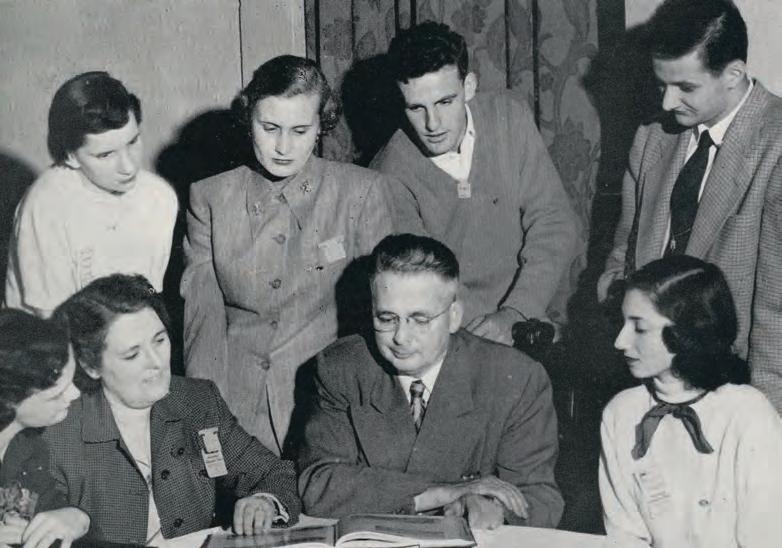
From his start as a student assistant, Kildow would eventually serve as manager, director, editor of Scholastic Editor magazine, emeritus director, board member and student press advocate. His influence on NSPA and ACP spanned nearly 50 years, and it remains evident today.
“Dad was in on the absolute beginning of NSPA at the University of Wisconsin,” Kathy (Kildow) Leabo, daughter of Fred and Lucille Kildow, said. Leabo, 93, now lives in Texas.
In 1927, Johnson was appointed to lead the University of Minnesota journalism department, and with the blessing of Wisconsin, moved the press association with him. In 1928, he hired Fred Kildow to join the Minnesota journalism faculty and manage NSPA.
Kildow immediately started sending out newsletters with suggestions and advice, organized competitions as a means for improvement, began planning national conventions and established a critique service.
His efforts made an immediate effect — especially in the field of yearbooks, which were relatively new on the scholastic level and experiencing a boom in popularity in the 1930s. That trend fostered the birth of companies producing yearbooks.
Kildow advanced through the academic ranks at the University of
Minnesota, from instructor to full professor, and he earned a master’s degree along the way. He established some of the first courses to train education majors seeking to become publications advisers and started the department’s first photojournalism courses.
He also served as student publications adviser for the Minnesota Daily student newspaper and the Gopher yearbook and as director of the Minnesota High School Press Association.
Journalism and NSPA were a family affair for the Kildows.
“They were just an absolute fabulous team,” Leabo said of her parents, Fred and Lucille. “Dad was teaching fulltime, and he was also adviser to student publications in addition to running NSPA.
“Mom ran the office. She had
helpers who took over all of the secretarial work, but she was the one managing the office,” Leabo said.
Lucille worked at NSPA throughout her career in various positions, including acting director and assistant director. She also ran the critical service and was highly regarded as a yearbook expert, frequently writing about trends in Scholastic Editor magazine.
In 1960, Lucille suffered a stroke during surgery for tongue cancer. It resulted in partial paralysis, difficulty swallowing and severe speech impediment. But she was able to keep writing, judging yearbooks and attending conventions with “remarkable courage and lack of fuss,” according to Scholastic Editor.
Leabo said she fondly remembers spending time in the NSPA offices in
FRED AND LUCILLE
KILDOW share yearbook ideas with student editors. Fred was the director and Lucille was yearbook judging supervisor.
024 PROFILES // FRED & LUCILLE KILDOW
Pillsbury Hall in the mid-1930s with her brother, William, while her parents worked in the evenings after classes.
“I must have been about 6 or 7 years old. I can remember going up and down the halls in that wonderful old building while mom and dad were busy at work,” Leabo said.
She and her brother also worked at the office stuffing envelopes for the many mailings that were always going out.
Leabo reminisced about the conventions she attended over the years, starting as a high school student serving as newspaper editor at Washburn High School, Minneapolis. The family tradition of traveling to conventions extended to the next generation.
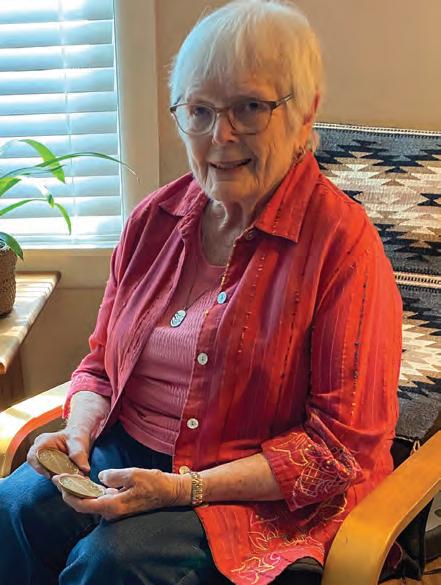
“When I had a family, I can remember taking my kids to the convention,” Leabo said.
“I think my daughter was probably the youngest convention-goer ever, because she was about 5 years old. The convention was over Thanksgiving weekend, so we hated to leave her at home and not be with her.
“To me, getting to know the journalism advisers was such a great experience. They were the brightest bunch,” Leabo said. Many decades later, she cites interacting with the advisers as one of the most rewarding aspects of her job at NSPA.
Leabo earned a journalism degree from Minnesota, where she also edited the Gopher yearbook. After graduation, she was home-decorations editor for the San Francisco Chronicle before serving as NSPA assistant director.
Both Kathy and her husband, C.J. “Skip” Leabo, worked for NSPA. Kathy served as editor of Scholastic Editor, and Skip became NSPA assistant director the year before Lucille suffered her stroke. Skip, who had also worked for the Associated Press, later became journliasm-department chair at Texas A&M University.
“I was always so glad that Skip was hired before mom’s surgical accident,” Leabo said. “He never felt he was doing it because of mom’s health — he was doing it because he wanted to.”
Through the decades, Kildow stressed the independence of NSPA from the University of Minnesota.
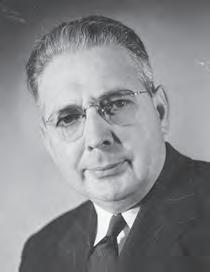
“While NSPA has the friendly sponsorship of the University of Minnesota, nevertheless NSPA has absolutely no connection, educational or commercial. Dues levied yearly
are its means of support,” Kildow wrote in Scholastic Editor.
Those who worked closely with the Kildows described them as hard working and modest leaders who did not seek the limelight.
Wayne Brasler, an award-winning high school adviser at the University of Chicago Laboratory High School for 52 years, said he was adopted by the Kildows, who were his valued mentors and friends.
“It was the Kildows who on the national level successfully imparted the vision of high school newspapers and yearbooks as serious and important parts of the curriculum, not just fun activities, though fun and excitement were part of the venture,” Brasler said.
“The Kildows were upstanding straightarrow citizens — very family, very community-minded, very establishment and very serious,” he said. “Yet there was a degree of warmth, humor, wit, fun and even irreverence seldom evident in their public images. They were both wonderful people and gallant.”
Leabo said her father loved serving as director of NSPA/ACP and didn’t want to retire. This posed challenges for her husband, who was assistant director.
“One of the reasons Skip left NSPA and his job as assistant director was he was convinced dad was not going to give up the directorship,” Leabo said.
Kildow’s family convinced him to retire. “We said, for heaven sakes Daddy, you’re 68 years old. It’s time to get out of it,” Leabo said.
For the first time in 45 years, NSPA/ ACP welcomed a new director — Otto Quale. From 1946-50, Quale served as assistant director. He left NSPA to manage the Jostens yearbook division, and, in 1968, he returned to NSPA/ACP as director.
Kildow said he was delighted with the selection of Quale to succeed him as director. The two men were good friends. Quale was originally one of Kildow’s students.
Lucille died in 1985. Fred followed in 1986.
“No one was surprised when they passed away within a year of each other. They were utterly devoted to each other,” Brasler said.
“The Kildow legacy continues. Today’s scholastic newspapers and yearbooks are built on the journalistic approach advocated by the Kildows and NSPA/ACP.” n
YESTERDAY AND TODAY
Fred Kildow, director
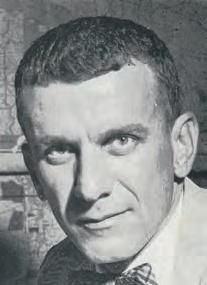
Lucille Kildow, assistant director, judging supervisor
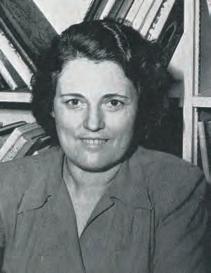
Kathy (Kildow) Leabo, editor of Scholastic Editor
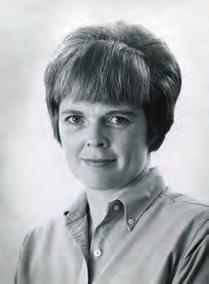
C.J. “Skip” Leabo, assistant director
(Kildow)
025 PROFILES // FRED & LUCILLE KILDOW
Kathy
Leabo, 93, currently lives in Texas and displays the NSPA Pioneer Award medals presented to her and her late husband C.J. “Skip” Leabo.
WAYNE
Brasler
LEGENDARY 52-YEAR CAREER BEGINS AT THE 1965 CONVENTION AS A YOUNG ADVISER
THE EARLY DAYS
Wayne Brasler visits with NSPA conference coordinator Jeanne Buckeye at the 1974 Fifth Annual Spring Publications Conference in San Francisco where Brasler led the Newspaper Short Course. Buckeye would go on to serve as executive director from 1975-1978.
WAYNE
BRASLER’S CAREER
with high school journalism spanned 52 years. It’s a career integral to NSPA/ACP history.
It started in 1964 at the University of Chicago Laboratory High School, where he led students to produce a mimeographed weekly newspaper. He moved to Normandy High School (Missouri), his alma mater, when the adviser there died on graduation day.
From there to the NSPA offices and back to Normandy, his career circled back to the University of Chicago Laboratory High School until his retirement in 2014.
Along the way, he met scores of students, interacted with five generations of student media leaders and became instrumental in writing NSPA’s Nearbook Scorebook in 1967. He served on the NSPA board of directors, spent summer 1968 judging publications at headquarters and wrote NSPA’s history for its 75th anniversary.
Brasler attended his first convention in 1965 at the Palmer House, in Chicago. He said it was there he found mentors and life-long friends.
“I knew no one when I went to the convention, but I embraced every opportunity,” he said. “Ben Alnutt and Col. Charles E. Savedge helped change that. We dined together, laughed together, and I became part of the NSPA family.”
A TRIBUTE TO A LEGEND
Celebrating the organization’s 75th anniversary at the 1996 Chicago convention, Tom Rolnicki, executive director, recognizes Wayne Brasler for his decades of service. In 1967, Brasler was instrumental in writing the NSPA Newspaper Scorebook with several updates in future years. He also wrote profiles of the Pacemaker-winner newspapers for Scholastic Editor magazine.

That NSPA family provided an opportunity for him to observe and learn.
“I met all the leaders my first year,” Brasler said. “Each of the leading people in the field had their own talents and their own viewpoints. There was no cookie cutter going on. You would learn from everybody you met.”
Lessons learned included understanding how to make student journalism real and how to become an effective publications adviser.
Inspiring Brasler were the stories of
Rowena Harvey, adviser in Fort Wayne, Indiana. Harvey was instrumental in the development of the National Association of Journalism Directors, now JEA.
“Rowena built the Southside Times to mirror The New York Times, and they built an entire newsroom modeled after The New York Times. I have never seen a high school paper like that before or since,” Brasler said. “I’ll never know how she got that out of these kids.”
Brasler said Harvey’s publications were reflective of the times for student newspapers.
“By the 1920s, papers had exploded,” Brasler said. “There were few dumb papers — it was what Col. Murphy (Columbia Scholastic Press Association founder) called the ‘magic mirror.’ You could read the story in print, and if you were smart, you could read between the lines. It’s telling a completely other story of what we could be doing in the school.”
Pioneers of scholastic journalism understood how to create the magic mirror, and Brasler said they had another characteristic in common.
“Rowena was very tough and very smart and clicked with kids, which I think is the key to this. Advisers and students who click result in Pacemakers.”
Brasler’s list of friends reads like a Who’s Who of scholastic journalism. At the top are the directors of NSPA.
“I’ve known all the directors. Every one of them was great and had his or her own style, which I thought was very important.
“They have all had their own style — no peas in a pod, no copycats, and they weren’t afraid to change things,” Brasler said. “They had a great talent for knowing who to pick because they weren’t looking for a survivor, but for a personality. In this business you have to have a personality. They were looking for crazy.”
Fred and Lucille Kildow, who led NSPA for 40 years, were mentors to Brasler.
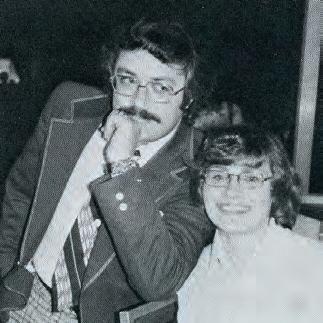
026 PROFILES // WAYNE BRASLER
“EMBRACED EVERY OPPORTUNITY.”
He said summer 1968 was a highlight. “I was adopted by the Kildows,” Brasler said. “We saw eye to eye on everything. I spent the summer in Minneapolis while I judged publications.”
He said the Kildows lived well. “Just being there and being part of it — working on the scorebook and judging was wonderful,” he said. The Kildows later surprised Brasler with an award named in his honor.
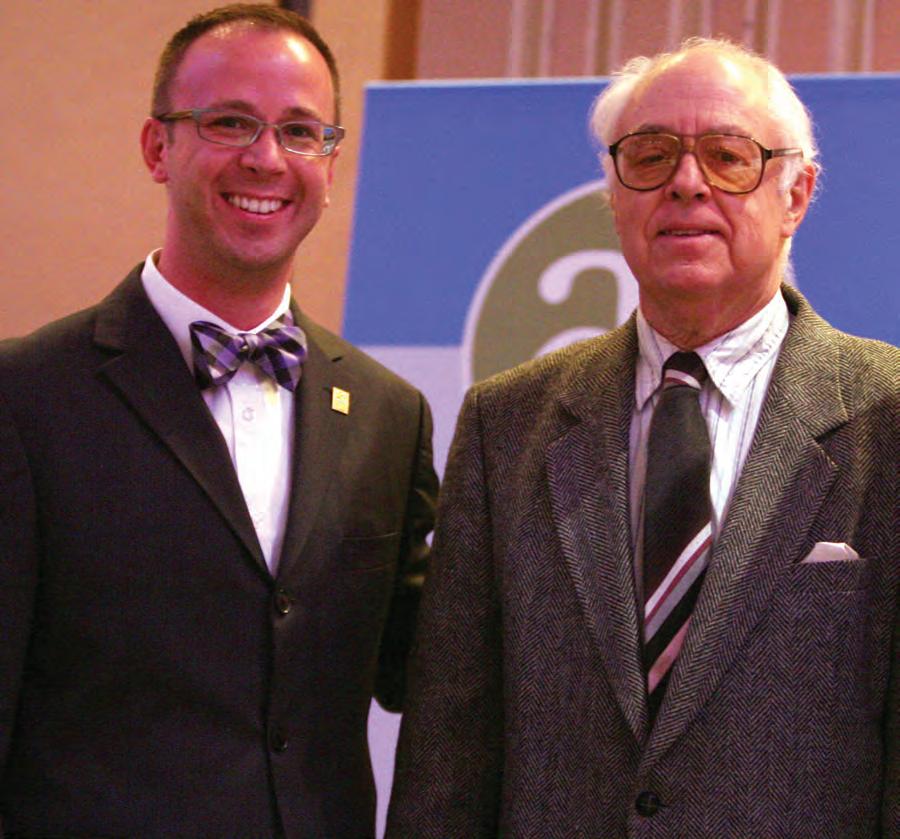
“The first applications were so good,” Brasler said. “They were deep, fearless, innovative, mavericks. Picking the winners was hard.“
Today, the first-place winners from each NSPA Story of the Year category (news, feature story, editorial/opinion story and sports story), as well as the social-justice reporting category, compete for the $1,000 Brasler Prize.
In 2001, the same year he underwent a five-valve bypass surgery, Brasler started an alumni newspaper for Normandy High,
his alma mater. With 1,500 subscribers and proceeds going to scholarships, Normandy alumni distributed papers to legislators then preserved the district.
“I knew it was time to quit when I heard the alumni paper had saved the district,” Brasler said.
“Normandy changed my life, and the Courier was the heart and soul of the school.”
In 2014, Brasler retired from University of Chicago Laboratory High School but not from journalism. Former NSPA director Logan Aimone now advises at the University of Chicago Lab School, and Brasler focuses on the Normandy High School alumni paper.
As reporter and editor, he produces 60-80 pages per issue to inform the school’s graduates and inspire students.
“I told them that after 52 years I wanted to go back to being a journalist,” Brasler said. n

AN ORAL HISTORY
In May, 2019, Gary Lundgren and Linda Puntney traveled to Chicago to interview Wayne Brasler. Over a three-hour lunch at the Atwood, located in the iconic Staypineapple hotel, Brasler shared insights and stories about scholastic journalism and NSPA. “Since I am 78, I knew virtually all the founding mothers and fathers of scholastic journalism — when I came into the field at the age of 23, they took me under their wings.”
027 PROFILES // WAYNE BRASLER
WAYNE BRASLER member of the NSPA/ ACP board of directors assists Logan Aimone, executive director, at the awards ceremony at the 2012 college convention Chicago.
TruebloodLOUANNE
IN 1967, A GROUP OF 167 NSPA CONVENTION-GOERS TAKE THE TRAIN FROM OKLAHOMA TO CHICAGO OVER THANKSGIVING WEEKEND.
SHE KNEW SCHOLASTIC journalism from every angle.
Louanne Trueblood worked on the yearbook staff at Lindsay High School (Oklahoma).
She edited both the newspaper and yearbook at Oklahoma Baptist University.
She taught journalism at John Marshall High School, Oklahoma City, for 15 years from 1964 to 1979.

Then she worked at Jostens, Walsworth and Lifetouch companies for another 30 years.
Along the way, National Scholastic Press Association became an important part of her life, she said.
“From the very first convention session I attended, I knew these people had so much to share and so much for me to learn,” Trueblood said. “That’s where it really got started for me.
“I was so young, and Otto Quale, Wayne Brasler, Bruce Watterson, Elizabeth Hurley and Pat Clark were all so nice and so willing to help me.
“At every convention I just met more and more people — John Cutsinger, Carol Rappaport, John Hudnall, Chuck Savedge, James Paschal — I learned from all of them, and some became life-long friends.”
Trueblood credits Maxine Housholder, the adviser who retired as she was hired at Oklahoma City’s John Marshall, with paving the way for a strong relationship with NSPA.
“She and Liz Burdette were my mentors,” Trueblood said. “They told
me what to do at conventions, what sessions to attend for me and my students and even helped me get there.”
Trueblood died in 2021, and Burdette died in 2011.
In 1967, Trueblood was part of a group of 167 students and advisers who took a train to Chicago over Thanksgiving weekend for the fall convention.
“I always made sure the kids went to sessions,” Trueblood said. “They learned so much, and the publications just got better and better.”
Trueblood saw to it her students learned from the NSPA critiques, too.
“We always had the yearbook and the newspaper critiqued,” Trueblood said, “and I used the rating books as textbooks. We studied the comments and learned from them.”
Her staffs quickly became scholastic journalism leaders, and Trueblood was making her own mark in national scholastic journalism.
In 1975, she was among 10 journalism teachers selected as Achievement Award recipients by the Newspaper Fund.
She left the classroom in 1979 to become the first woman to be hired for the Jostens sales force, a career move that presented even more opportunities for teaching.
“When I was hired, they reminded me that a teacher sells every day when in front of a classroom of students,” she said. “I was still involved with schools so it felt like I was still teaching.”
And she was. She edited Jostens’ adviser magazine and provided content to support advisers. She developed curriculum and marketing materials for Walsworth and Lifetouch as well.
Until her death, she attended class reunions with her journalism alumni.
“There are those who have achieved significant careers, while there are those whose stories might not seem as impressive, except to me,” she said.
“Guiding a student through writing a story and seeing his or her name in print for the first time publshed was fulfilling.
“But hearing, years later, of that same student’s courage in the aftermath of a serious auto accident or her battle to overcome a life-threatening disease is more than just fulfilling,” Trueblood said. “It’s heartwarming and inspiring.” n
028 PROFILES // LOUANNE TRUEBLOOD
LOUANNE TRUEBLOOD, adviser and NSPA member, 1964-1979, and her mentor Liz Burdette, adviser, Northwest Classen High School (Oklahoma).
DECADES LATER, still a proud adviser. Long-time adviser Louanne Trueblood enjoyed staying in touch with her former students posting this photo and message on Facebook: “I had the privilege of attending an Associated Press award ceremony today (June 10, 2017) where Bruce Campbell was awarded first place in Oklahoma in his division for sports writing. Bruce, who was on the Advocate newspaper staff at JMHS in Oklahoma City in 1971-72, has been on the staff of the Enid News and Eagle for over 35 years. Proud of you Bruce!”
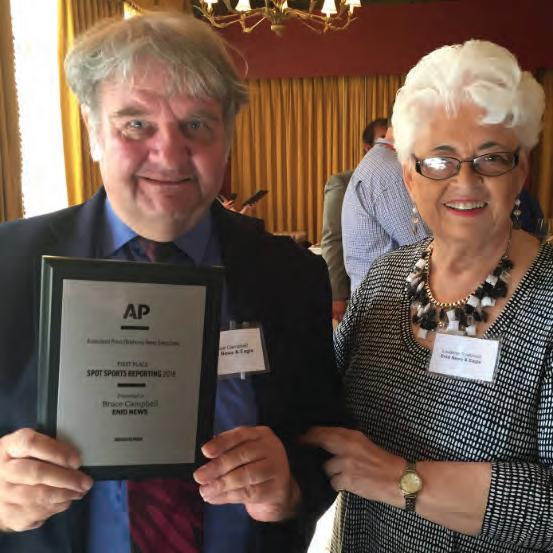
TRAILBLAZER
In 1979, Louanne Trueblood left the classroom to be one of the first women hired as a Jostens yearbook representative. In 1984, Trueblood visits with adviser Ann Wincenread, Heritage Hall High School (Oklahoma) at the state convention. Upon her retirement, after 30 years in the yearbook business, Trueblood held management positions at Jostens, Walsworth and Lifetouch.
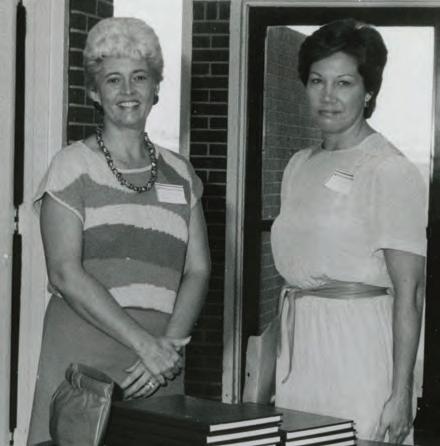
ANNIVERSARY PRESENTATION
Representing the Oklahoma Interscholastic Press Association, Louanne Trueblood and Janice Rogers present a plaque to Otto Quale, NSPA executive director, at the organization’s 50th anniversary gala at the 1970 convention at the Palmer House in Chicago. The inscription on the plaque reads — “OIPA to NSPA: Welcome to the Over-Fifty Club from Number One.” OIPA was established in 1916, five years before NSPA.
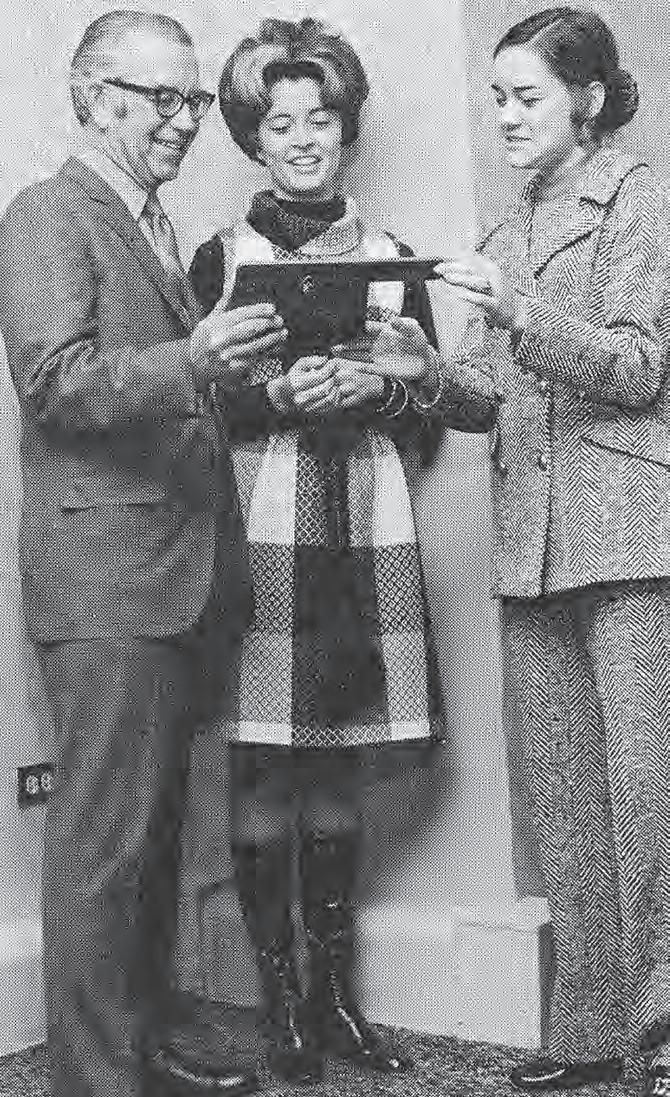
RON
Clemons
A PASSION FOR JOURNALISM EDUCATION GROWS INTO A PURPOSEFUL AND REWARDING LIFE TOGETHER.
SCHOLASTIC JOURNALISM brought Ron Clemons and Molly (Wiseman) Clemons together in a relationship that included sharing 53 years in the classroom.
The Clemons were married for 40 years when Molly died in September 2022.
“We really got to know each other at the spring 1977 Portland convention, when Molly was JEA president, and I was getting ready to chair the 1977 Kansas City convention,” Ron said. “We talked about journalism and board business and personal things.”
Their relationship grew as they worked on journalism education projects and attended summer meetings, workshops, conventions and officer retreats.
“We saw each other a couple of times a year, and talked a lot because she was JEA president and I was vice president. We discovered we had so much in common,” Ron said. “We both taught journalism, had mutual friends and did things as a group at conventions.”
Both were volunteers in NSPA. “I judged both newspapers and yearbooks, and I always learned,” Molly said. “When my students were transitioning from tabloid to news magazine in the ’70s, judging helped us make the transition. I shared the publications I was judging with my students, and we adapted ideas from other schools..”
Molly recalled an NSPA session at the San Jose, California, convention that influenced how she viewed judging.
San Jose Mercury News editors described a third-place regional contest winner that later won the Pulitzer Prize.
“The panelist said everybody looks at things differently,” Molly said. “It depends on who’s reading and the competition. I always thought that was good to remember. Judging and being judged gives a new perspective because it’s a different set of eyes.”
RON & MOLLY CLEMONS and Howard Spanogle (center) were among the advisers celebrating the 75th anniversary of NSPA at the 1999 Chicago convention. Both Molly Clemonts and Spanogle died in 2022.
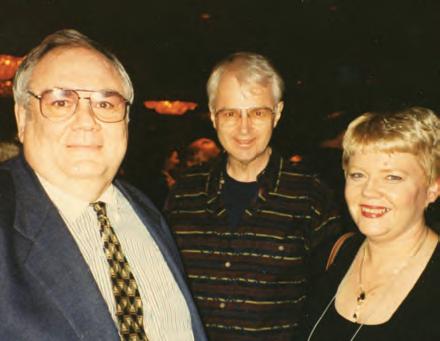
The publications Ron advised at Truman High School in Independence, Missouri, were consistent All American award winners. The Spirit newspaper received 37 All Americans and a Pacemaker, and the Heritage yearbook earned its share of All Americans.
“Judging was so important because it gave students another perspective of the work they had done,” Ron said. “It reinforced what we were doing in the classroom.”
The benefits of NSPA went beyond critiques and judging.
“The value of NSPA is in the number of students it touches and the information it provides. For years, Scholastic Editor and Trends magazines gave student journalists and advisers valuable insights into trends and new developments,” Ron said. “It took journalism education beyond the classroom.”
Molly said the organization has also been something students and advisers could depend on.
“The guidance NSPA gives and the exchange of information it makes available are invaluable,” Molly said. “It’s solid, steadfast and reliable. Convention sessions, awards, meeting
other students and advisers means you simply cannot walk away from a NSPA experience without gaining from it.”
Ron said the moment he knew they should marry happened at a Washington, D.C., convention after they had walked five miles looking at sites. But the decision to talk to Molly came later when they were both back in their classrooms.
“I was surrounded by students in the journalism room when he called. He mentioned getting married, but I didn’t say much because I didn’t want to give information away to the students,” Molly said.
They married in Reno, Nevada, on their way to the 1982 San Francisco National High School Journalism Convention. In Reno, one of Ron’s former journalism students was best man and Dorothy McPhillips, former JEA president, was Molly’s matron of honor.
When they got to San Francisco, Ron’s brothers and the Northern California Journalism Education Association were hosts for their reception.
In 1997 Ron became director of the George Caleb Bingham Academy of the Arts I, a free, month-long fine arts summer program of the Independence School District, and Molly replaced him when he stepped down in 2011. In 2015, they became the voluntary directors of the Music Arts Institute, another fine arts program in the district.
After years of education and service, they were named Citizens of the Year in Independence, Missouri, in 2015.
“When a couple does so much together, you still have to have individuality,“ Molly said. “That’s why you have to have different outside interests and make your own name for yourself and find your own path.” n
030 PROFILES // RON & MOLLY CLEMONS
& MOLLY
CANDACE & JOHN BOWEN have devoted their careers to journalism education because “America Needs Journalists.”
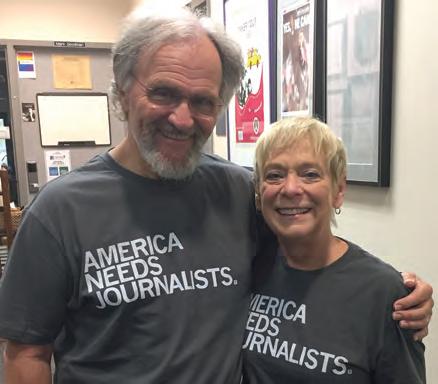
CANDACE & JOHN
Bowen
A RELATIONSHIP OF MORE THAN FOUR DECADES BEGINS WITH A JOURNALISM CONVENTION BUS RIDE.
THE YEAR WAS 1982. The place was the JEA/NSPA Chicago convention.
Candace (Perkins) Bowen and John Bowen shared a bus trip to the Bowling Brook Mall for the adviser luncheon.
That bus ride started a relationship that has lasted for more than four decades.
They sat across from each other at the luncheon. They talked about student press rights with Margaret Johnston, who was John’s co-chair of the JEA Student Press Rights Commission.
“We really became friends working on committees, judging contests and socializing with groups at conventions,”
Candace said. “Talking with someone who gets it and understands and can sympathize reinforced our relationship.”
Long-distance dating was a challenge. “We talked about the idea of going back and forth, and that maybe we should try something different and the sooner the better,” John said.
The proposal and engagement came on the way to the 1995 scholastic journalism convention in San Diego.
“We got the ring in an antique store in Texas on the way to the convention,” Candace said. “Then we realized people were going to notice, and John’s son Cory didn’t know. So at the first staff meeting with John’s students, he announced it.
“The response was ‘Well, it’s about time.’”
They married on Nov. 4, 1995.
“The parent of one of John’s students was mayor at the time and married us,” Candace said.
She returned to Washington, D.C., and John to Lakewood. With a friend’s connections at Kent State University, she became director of Kent State’s scholastic journalism program.
home with John just for me. It was a story — a very personal story about an addiction issue one of her parents had and challenges the family was facing. It was gripping, but, I thought, much too first person and lacking in experts to support what she was saying, so I wasn’t sure how it would be received.”
Candace coached the student on the story.
“The bulky envelope went back and forth between us quite a few times, and finally she was happy with the result and the article went in the newsmagazine.”
Fast forward to a subsequent national convention and one of Candace’s favorite NSPA memories.
“I was sitting on the stage for the Sunday morning awards when NSPA’s top stories of the year were announced. Rachel’s piece had won NSPA’s Feature Story Category.
“I know tears were streaming down my face. John and I had shared at least a bit of her advising, and look what she had done.”
At Lakewood, John’s students earned numerous NSPA Pacemakers and All American ratings.
Candace said. “John taught in Lakewood, Ohio, and the Ohio teachers adopted me as part of their group when we would all go out on Saturday night at conventions.”
In 1993, Candace moved from Illinois to Washington, D.C., to teach English at Marshall High School, Fairfax, Virginia. It was there she understood there was something special in their friendship.
“We called pretty frequently, and at one point when I had a really bad day, I realized he was who I wanted to talk to,”
“I was able to move to Ohio, but I had to work myself into a job with a real salary,” Candace said. “I taught adjunct until 2006 when Kent received the Knight Chair which was a tenure track position. Twenty years later, I was promoted to full professor.”
Although she loved the job, something was missing.
“When I first moved to Ohio, I suffered kid withdrawal,” Candace said. “My job at Kent State didn’t have any teaching or advising so I volunteered to work with his Lakewood Times kids whenever I could.
“I definitely hit it off with one talented reporter. I coached her on several stories, and one day she sent a bulky envelope
“One of the most important aspects of NSPA is that the critiques and contests provide another view of the publication and a professional study,” John said. “The more the merrier when it comes to constructive input.”
Candace said the conventions and workshops have significant value to student journalism, too.
“It’s a real plus to find someone who gets you and with whom you have a natural synergy,” Candace said. “It’s not surprising you would find them through journalism and NSPA.” n
031 PROFILES // C ANDACE & JOHN BOWEN
H.L.
FOR MORE THAN FIVE DECADES, HIS IMPACT ON SCHOLASTIC JOURNALISM IS HUGE — INCLUDING JUDGING 6,400+ PUBLICATIONS.
SHOULD I HAVE MY PUBLICATION critiqued? Should I attend a national convention? Should I take students to a national convention?
Each H.L. Hall answer would be resounding. Ye-es! Ye-es! Ye-es!
Literally, thousaands of advisers and students have been inspired by Hall’s signature, positive cheer because of his presentations at local, state and national conventions. Spanning more than five decades, his influence on scholastic journalism is extensive and a bit of a numbers game.
“I’ve gone to 50 years’ worth of conventions,” said Hall, adviser at Kirkwood High School (Missouri) from 1973-99.
“The first in 1965 was at the Chicago Edgewater Beach Hotel, and I think it was just advisers. Eventually, students were added, and it made a lot of difference in the energy level.”
From 1968-73 the convention was held over Thanksgiving weekend at the Palmer House, in Chicago. Although the date offered good hotel rates, Hall said the timing was problematic.
“A lot of teachers were unhappy about the date because you couldn’t be home for Thanksgiving if you went to the convention,” he said. “I also had a problem getting there on Thanksgiving Day because my high school played a football game every year on that day. I often arrived a day late.”
In 1974 the convention date and location moved to Chicago’s McCormick Inn. That year, the first on-site contests were added to the convention with four newspaper categories — news, features, sports and opinion writing.
Since then, Hall says convention attendance has tripled.
“NSPA and JEA working in partnership to plan the conventions
meant responsibilities could be divided more efficiently,” Hall said. “The conventions have grown so much I think it would be almost impossible for one organization to handle everything.
“When I was co-chair the first time St. Louis hosted the JEA convention, we brought all of the audiovisual equipment from my school. There was so much work for the local committee. Now, that’s just not an issue. Because NSPA was not involved with JEA that year, I also handled all the convention registration and the write-off registrations.”
From 1978-80, the two organizations held separate fall conventions.
Hall said the next time the convention was in St. Louis, NSPA and JEA were partners again. “That made the job of the local chairs much easier,” he said.
Hall attended nearly 100 conventions, besides serving as a local convention chair.
When Tom Rolnicki was NSPA’s executive director, Hall revised the organization’s Yearbook Guidebook — a best-practices guide to producing yearbooks.
Besides working with NSPA and JEA on a variety of projects, Hall filled his summers teaching workshops both nationally and internationally. His schedule was so full one summer that his wife, Lea Ann, met him at the airport twice where they exchanged suitcases — she brought fresh clothes, and he left her with a suitcase full of dirty laundry.
Over the years, he has also judged publications from 22 states for NSPA, as well as Quill & Scroll and the Columbia Scholastic Press Association.
For NSPA specifically, as of July, 2022, Hall has had judged 6,311 publications. He is NSPA’s most prolific judge, and he continues to judge 50-60 yearbooks for NSPA most years.
Hall credits Jeanne Buckeye, NSPA
executive director from 1975-78, with starting his judging career, and he credits his judging for turning the program around at Kirkwood High School.
He points to one yearbook in particular that changed his advising career.
“I really felt lucky to be the judge for the Colonel at William Fleming High School in Roanoke, Virginia, in 1976. That was the book with the theme ‘A Lot to Look Back On,’ that I thought had such great copy,” Hall said.
“It turned my thinking around totally about what copy should be like in yearbooks. Anyway, I felt lucky that it was sent to me to evaluate. I gave the book five marks of distinction. Fewer than five books received that award. That was in the days when the top books were 5-star All Americans.
Hall said the quality and focus of publications has changed over the years.
“Photography is probably the most improved because the technology has changed so much, but copy is still an area where improvement is needed,” he said. “Academic coverage often doesn’t tell what happened in the classroom, and sports coverage may not give highlights of the season.
“When we rely primarily on quotes to cover the year, we miss a lot of the details. Staffs need to go beyond the first superficial quote and dig deeper,” he said.
Hall also recommends publication critiques for their educational experience.
“You learn from critiques,” he said. “If the critique is positive, it solidifies what you have been doing, but there is always room for improvement.
“A good critique is a pat on the back, and when suggestions are made, the staff can decide which ones to adopt to make their publication better.” n
032 PROFILES // H . L. HALL
Hall
H.L. HALL dances during the closing ceremony of the 2006 Nashville convention.
PROLIFIC JUDGE
Arguably, no one has judged more publications than H.L. Hall. During his career he has critiqued 6,342 publications as of October, 2022. And, the number continues to grow. A significant number of the critiques were for NSPA. In June, 2019, he completed his 6,000th critique. The milestone critique was for the 2019 Odyssey, Chantilly High School, Virginia.
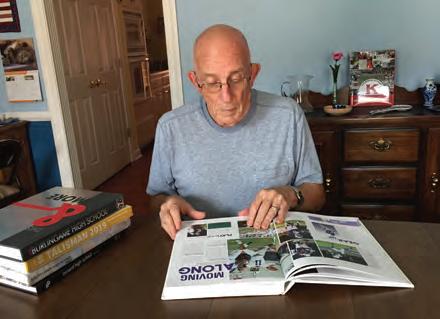
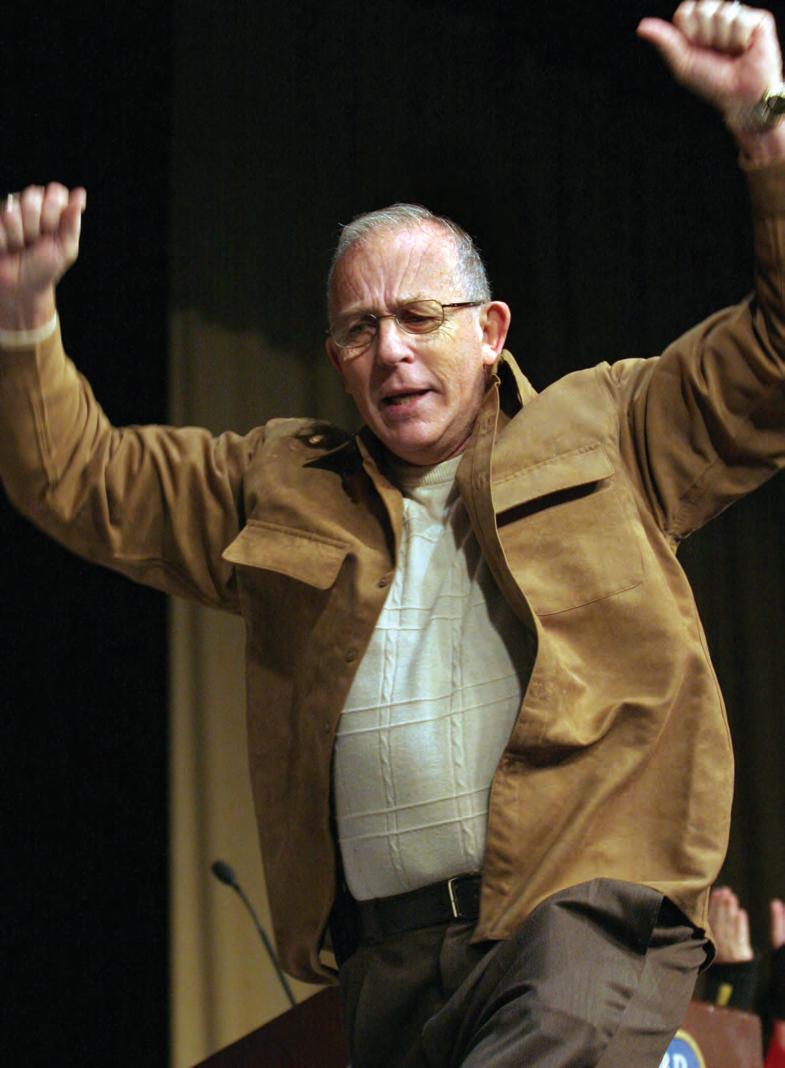
HALL IN THE HAT
“But that is not all,” says the Cat in the Hat. “Oh no. That is not all!” H.L. Hall, JEA president from 1997-2001, adds a lighter moment to a board meeting at the 1998 Seattle convention. “I have always been a fan of Dr. Seuss. I read a lot of his books to my two daughters when they were growing up,” Hall said. “when I was chair of the Yearbook Adviser of the Year contest I wrote a poem for each recipient based on one of his books.”
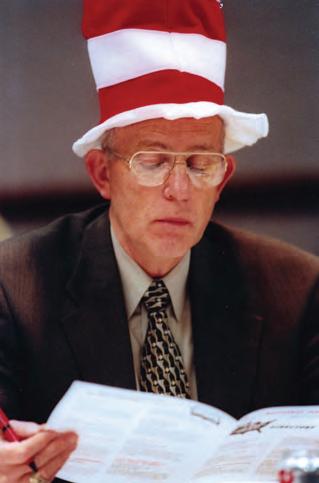
033 PROFILES // H . L. HALL
CHALK TALK
Discussing strategies for photo placement, Tom Rolnicki leads a workshop session in the early 1980s. An award-winning teacher and adviser at both the high school and collegiate levels, Rolnicki was named executive director in 1980.
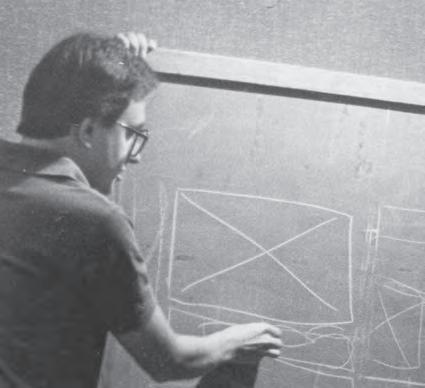
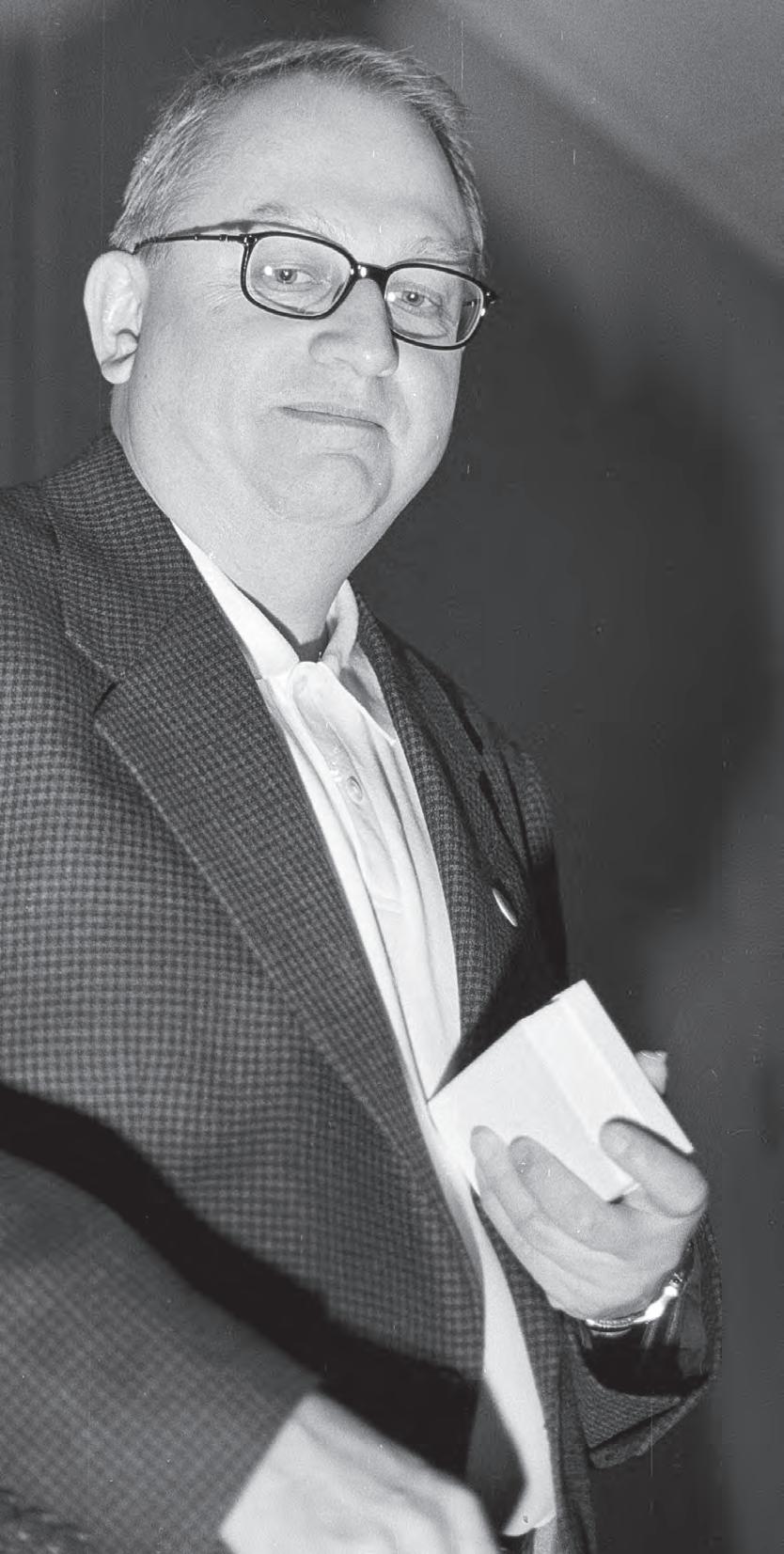
CONVENTION PARTNERS
Colleagues and friends, Linda Puntney, JEA executive director (1989-2010) and Tom Rolnicki, NSPA executive director (1980-2006), worked closely on convention planning including extensive travel to secure convention sites and for advance meetings with local committees. The directors celebrate NSPA’s 75th anniversary at the 1996 Chicago convention.

TOM
Rolnicki
THE EXECUTIVE DIRECTOR FROM 1980-2006 TRANSFORMED NSPA/ACP INTO FORWARD-THINKING ORGANIZATIONS.
IT’S DIFFICULT TO UNDERSTATE just how much student journalism changed in the last decades of the 20th century.
In content and style, in technology and outreach — the nation’s scholastic and collegiate journalism grew to rival commercial journalism.
Supporting, guiding and celebrating that advancement was Tom Rolnicki, executive director from 1980 to 2006.
“Tom was a remarkable diplomat for both NSPA/ACP and for our country and its strong tradition of student-press freedom,” said Mark Goodman, who was then the executive director of the Student Press Law Center. SPLC’s service and outreach grew in parallel with NSPA/ACP.
National conventions for both organizations grew exponentially, with national newsmakers as keynotes and partner associations Journalism Education Association and College Media Advisers expanding and strengthening convention programming.
The Pacemaker became the gold standard of recognition during Rolnicki’s leadership. Individual awards expanded to reflect advancements in student journalism, and the convention Best of Show awards punctuated the conventions with lively celebrations of current student work.
The co-author of “Scholastic Journalism,” one of the most respected textbooks of its time, Rolnicki established himself as both a national and international authority on student journalism.
“Tom was the first person I knew in scholastic and collegiate journalism who made an organizational commitment to connect with international students,” Goodman said. “He taught and supported
student-journalism conferences in Germany, South Korea, Japan, the Czech Republic and Croatia.”
Rolnicki earned his bachelor’s degree at the University of Wisconsin and his master’s degree at Iowa State University. After teaching journalism and advising publications at Ames (Iowa) High School, he understood the challenges of both student journalists and advisers.
Paul Ender, long-time adviser at Independence High School, San Jose, California, was one of many advisers who benefited from Rolnicki’s support.
“When I started to learn about journalism, I used the NSPA critical service,” Ender said. “Getting critiques really helped confirm what we were doing right and what we needed to do.”
In 1988, the yearbook Ender advised won the NSPA Pacemaker.
“The critiques gave us direction, and Tom gave us the support we really needed,” Ender said. “Tom’s personal interest in making programs better turned a lot of schools around.”
Gary Lundgren, current associate director of the associations, said Rolnicki studied the student press.
“When I got to know Tom, in 1985, NSPA was the epicenter of coolness — high energy and cutting edge.”
Rolnicki, working with designer/ communications manager Donn Poll, launched Trends in Publications.
“The name was very fitting, both in terms of content and design,” Lundgren said. “Thanks to Trends, the design of high school newspapers became as important as the content.
“Tom was brilliant, and I use that word carefully. He was so incredibly smart. Some people found him aloof, but that
wasn’t the case,” Lundgren said. “For someone in such a high-profile job, he was rather shy. He had an incredible sense of humor.”
Ron Johnson, now NSPA/ACP communications director, worked with Rolnicki when Johnson was an officer in College Media Advisers, now College Media Association.
As ACP and CMA produced the evergrowing fall conventions, the collaboration occasionally fractured, Johnson said.
“Through the years, Tom had actually expanded ACP’s financial obligations for CMA’s benefit,” Johnson said. “When that institutional memory was lost in CMA, Tom took a strong stand to preserve the independence of ACP.
“I and others worked to maintain the ACP/CMA partnership for the benefit of everyone, and I’m thankful they work together today.”
Rolnicki was honored with JEA’s Carl Towley Award and Medal of Merit, as well as Columbia Scholastic Press Association’s Gold Key and the Dow Jones Newspaper Fund Merit Award. He served on the board of directors for JEA, SPLC, the National Commission on Co-Curricular Education and Every Penny Counts/AIDS Emergency Fund.
His tenure at NSPA/ACP ended in 2006, in a financial controversy with the board of directors. Rolnicki died in 2009.
Yet his decades as director laid the groundwork for today’s student journalism.
“Often working quietly, behind the scenes, few people have influenced contemporary scholastic journalism more than Tom Rolnicki,” Lundgren said. n
035 PROFILES // TOM ROLNICKI
TOM ROLNICKI, secondlongest serving executive director, at 26 years.
FROM
FOR DONN POLL, becoming NSPA/ ACP’s publication director was a matter of being the right person, in the right place, at the right time.
In its first 61 years, the organization established itself as a credible resource and respected critical service for student publications, but in 1982, executive director Tom Rolnicki was looking for a breath of fresh air.
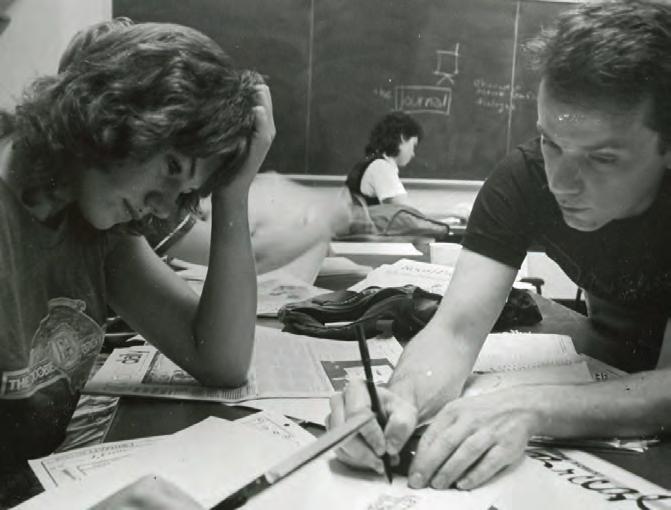
“Shortly after I joined the staff, we moved from a small, dusty office to a new, bigger space,” Poll said. “It was sort of symbolic — the organization was blowing the dust off and moving forward, but we needed to stay connected to our core.”
Poll worked with Rolnicki to refresh Scholastic Editor, the flagship publication of the organization.
“The redesign of the magazine was really a collaboration with Tom discussing what the publication needed to be,” Poll said. “I came from a commercial, professional background and he knew what the magazine should be. Tom was open to seeing the trends and incorporating some into the magazine.
“We tried some things, worked on design and discussed content. We wanted to step away from old patterns but not give up on the integrity of the magazine,” he said.
Trends launched in the fall of 1982 at about the same time as USAToday. Poll studied what some termed the nation’s newspaper for techniques to translate into Trends.
“The USAToday launch changed how we engage people with information. It prepared us for the digital age,” Poll said. “The user-oriented process of putting it together changed how we connected with people.”
When he adapted some of those techniques to NSPA/ACP publications, the response was positive.
“Students were excited because it was their world — color and infographics connected with people. In the ’80s and ’90s USAToday was what was happening,” Poll said. “There were great discussions with students and advisers about Trends,” Poll said. “People were anxious to talk about what was happening.”
In the 75th anniversary history, Brasler credits Poll for much of the change in the publications.
“His influence in NSPA publications would extend to the entire field of scholastic journalism. Poll’s design technique was adventuresome, crisp, subtle and the epitome of good taste. His 1993 analysis of USA Today remains a model of its kind.”
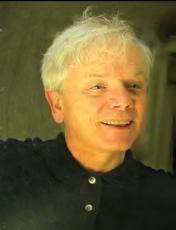
Poll’s interest in student media continues to focus on connecting with consumers.
“We have to engage people with a conversation,” Poll said. “These days, a
whole new dimension of reporters who write, work with video and audio makes the educational process so complicated.
“Today, we have to help people understand their role and teach them to come back from an event and pull together a multi-dimensional package. Our job is to figure out if we are telling the accurate story and not let the technology overwhelm us.”
Poll said he sees NSPA/ACP as a catalyst for communication and growth.
“I’m happy to have been there at a major moment as we figured out how to communicate. We started with a gray page and learned how to package information in a way that was attractive and communicated information clearly. It was just before the internet and we saw it coming and started developing skills. What we did then, got us to today.”
Donn Poll, indeed. The right person, in the right place, at the right time. n
036 PROFILES // DONN POLL
DONN
Poll
DONN POLL, designer and publication manager, 1982-1991, teaching at the 1983 NSPA Summer Workshop and looking back during an interview in 2020.
1982-91, DESIGNER/PUBLICATON MANAGER BRANDS NSPA/ACP AS HIGH-ENERGY, CUTTING-EDGE ORGANIZATIONS.
TRENDS IS A TRENDSETTER
In September, 1982, Scholastic Editor, the organization’s flagship magazine for 61 years, was redesigned and renamed Trends in Publications. Donn Poll, designer and publication manager collaborated with Tom Rolnicki, executive director, to create a tabloid publication printed on high-quality paper and featuring a hybrid newspaper/magazine format.

“MISH-MASH OR MASTERPIECE?”
With a bold, colorful format, USAToday forever changed the design of newspapers after it launched in September, 1982. Donn Poll provided an extensive analysis of USAToday on the pages of Trends. “Overall, it’s busy, but you know what they said about
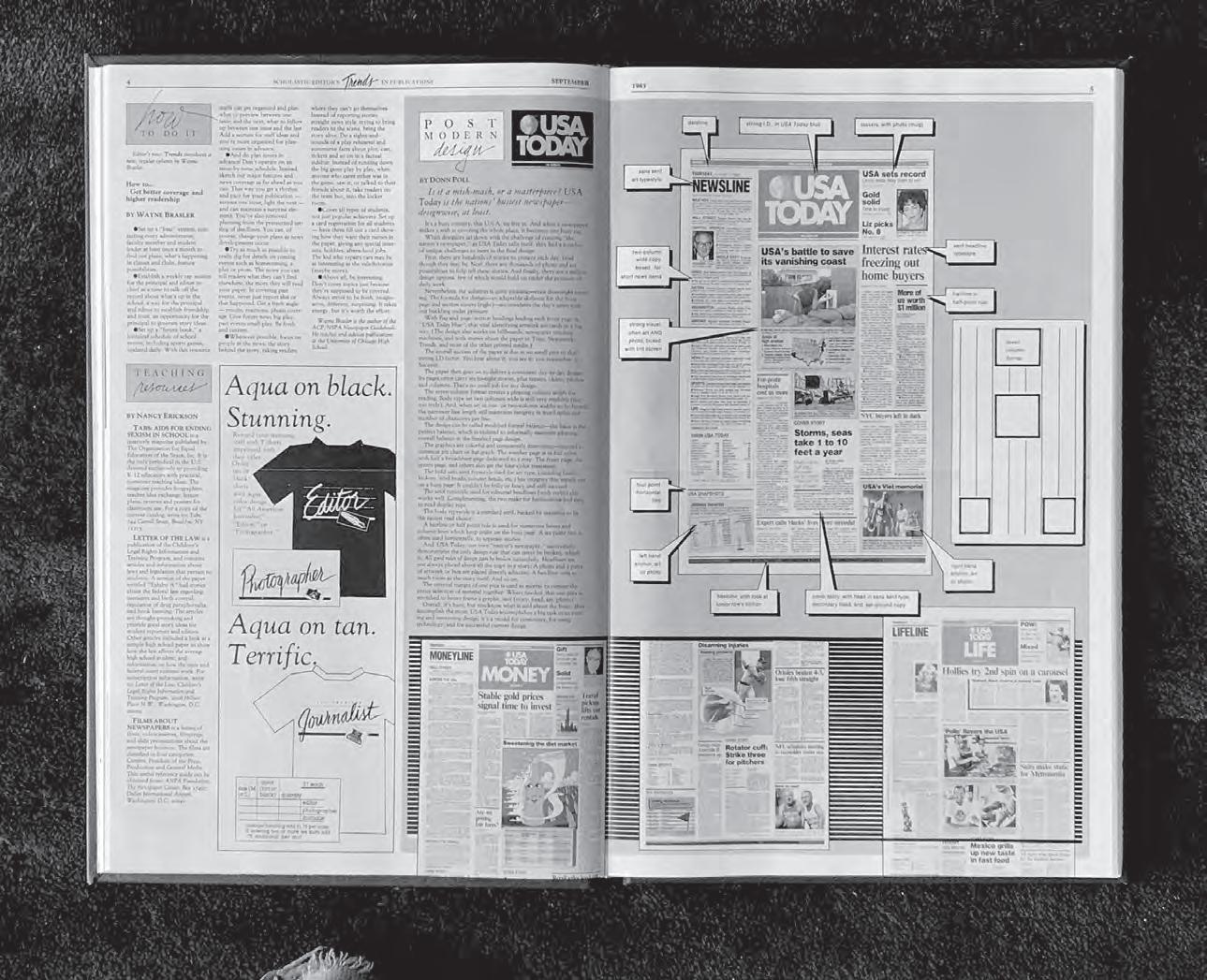
PROFILES // DONN POLL
LORI & TOM
Keekley
YOUNG COUPLE TOGETHER, AND DECADES LATER THEY STILL “LIVE AN NSPA LIFE.”
IN 1998, NSPA BRINGS
NSPA AND ACP BRING PEOPLE together, sometimes forever.
No one knows better than Tom Keekley and Lori (Harris) Keekley. Both have worked for NSPA but not at the same time.
Tom joined the staff in 1991 shortly after graduation from University of Wisconsin-Stout. A design and packaging major, he followed up on a lead from a friend who saw the ad in the Eau Claire, Wisconsin, newspaper. A quick phone call, and he was set for an interview in the NSPA offices five hours away.
“I drove there in a T-shirt and jeans but changed clothes in the parking lot,” he said. “ Dressed in my suit and tie, I walked into the NSPA office and was directed to then executive director Tom Rolnicki’s office on the fifth floor.
“The story goes that the staff rolled their eyes and dubbed me the Eager Beaver as soon as I left the staff office. The suit and tie just didn’t fit in with their casual, relaxed dress style.”
After the interview, Keekley made another trip to the parking lot for a quick change of clothes and then back on the road for another five hours. Keekley said he was nervous and anxious, but Rolnicki must have been anxious too because he called to offer the job before Keekley got home.
“I picked up the message from my answering machine and called him back. He asked me to join the staff with a question ‘Do you think there is room in the office for two Toms?’”
During his nearly seven years as NSPA print communication manager, Keekley handled the design for the group. From advertising, brochures and fliers to Trends, a monthly magazine. Any organizational branding was Keekley’s work.
During a brainstorming session, staff members suggested putting together a collection of the best of the high school publications they saw and The Best
of the High School Press was born.
“It was a good project that survives today,” Keekley said. “It takes a lot of work to gather the images, but it is worth the effort because schools all over the country can see some of the best student work in the nation.”
In 2022, the 27th volume was published. Another project carrying Keekley’s stamp was ACP’s Best of the Midwest convention.
“We knew not every school could afford to go to the larger national conventions, and we wanted to do something to support schools near us, so we developed the Best of the Midwest.” Keekley said.
Creating programs to support student media was a lot of the attraction of the NSPA job, but equally important were the relationships formed with other staff members.
“We were a super close group,” Keekley said. “I loved working there and those people I worked with are definitely an extension of my friend group. I’m lifelong friends with Jim (Bernard), Annie, (Christman) Brian (Jones), Marc (Wood), Donn (Poll) and so many of them.
“We had a lot of fun, but we worked hard because we each had our own things to do. It was a great experience and gave me a good work ethic.”
Tom Keekley left NSPA in 1997 to join the design firm launched by former NSPA/ACP staff member Donn Poll. So NSPA led him to his second job.
Soon after Tom Keekley left NSPA/ ACP, Lori Harris joined the staff in 1998.
Lori had been teaching at Portage High School (Indiana) for three years. She hadn’t really applied for the job and was surprised when Rolnicki contacted her, she said.
“Tom (Rolnicki) left me a message on my home phone saying to check my email. I drove back to school, because that was where my email access was, and saw the offer. He said he had asked around about a good person for the position and people had mentioned me,” she said.
“I ended up accepting the job and moving to Minneapolis.”
As director of contests and critiques, she said one of the best aspects of her job was seeing publications improve.
“It’s like watching a transformation of the publication. I loved seeing how the newspapers improved from the first issue of the school year to the end,” she said. “It was also great to see new publications work their way into the top group by applying what they learned in the critique process.”
Pacemaker judging was another highlight, she said.
“I learned so much from listening to the judges evaluate the publications. They were selecting the best of the best, and it was fascinating.”
In late October 1998, when Tom Keekley was invited to return to an NSPA happy hour. He met the new kid in the office.
The next day Tom emailed Lori, and they set up their first date. It was Oct. 31,

038 PROFILES // LORI & TOM KEEKLEY
TOM KEEKLEY was print communications manager from 1991-97.
LORI
KEEKLEY was contest and critique director from 19982000 and returned to NSPA in 2022 as associate director for Quill & Scroll.
and they attended his friend’s Halloween party. Lori said the conversations and their relationship continued to evolve.
Fast forward to winter and a ski trip resulting in a serious leg injury for Lori. Recuperating for the next three months meant Lori and Tom spent even more time together. So much so that on a road trip to meet her parents at the Indianapolis 500, they planned their wedding in the car.
“By the time we got there, the wedding was pretty much all planned,” Lori said. Lori left NSPA in 2000 because she missed the classroom, she said. Eighteen months later, she accepted a position teaching journalism at St. Louis Park High School, in the Twin Cities.
“It was great to be back with students, but working at NSPA gave me a clear perspective of the importance of student media,” Lori said. “I appreciated how passionate the organization has always been to support the students. My teaching benefits from my NSPA experience
because I transfer things I have seen in the office to my own students. I learned from workshops and conventions and I call on those ideas to keep the publications from becoming stagnant.”
Their son Harris was born in 2004, and Alex was born in 2007. Harris worked on the newspaper staff his mom advised at St. Louis Park before his graduation in 2022.
“To this day, we still attend conventions, judge and laugh about NSPA stuff,” Tom said. “We’re still in the circle and part of the ecosystem.
So much so that in summer 2022, when the Quill and Scroll honor society merged with NSPA, Lori was hired as the NSPA associate director for Quill & Scroll.
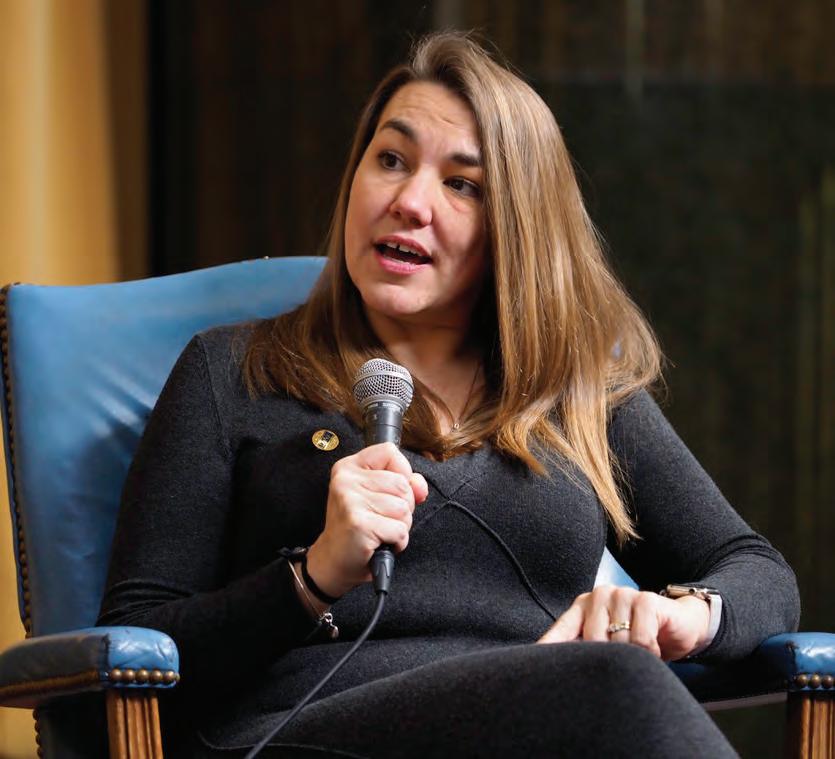
Tom noted just how much their lives were connected through NSPA.
“We met because of NSPA, our best friends have NSPA connections, we’re better at our jobs today because of what NSPA taught us,” he said.
“We’ve lived an NSPA life.” n
FRIENDS & FAMILY
Beaming with pride, Lori Keekley was named the 2016 National High School Journalism Teacher of the Year at the Indianapolis convention. To mark the occasion, she poses with long-time friend Logan Aimone, former NSPA/ ACP executive director and adviser at the University of Chicago Laboratory High School. Tom Keekley, her husband and former NSPA/ACP communications manager, captures the image.
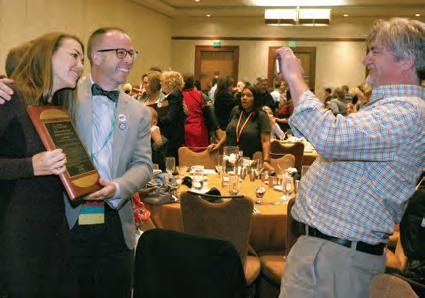
039 PROFILES // LORI & TOM KEEKLEY
(HARRIS)
Tims AL
DURING HIS 18 YEARS, THE LONGEST SERVING PRESIDENT EXPANDS AND RESHAPES THE ROLE OF THE BOARD OF DIRECTORS.
WHEN AL TIMS became director of the School of Journalism and Mass Communication at the University of Minnesota, he said, he had no idea the position included another title — president of the board of directors of National Scholastic Press Association.
The board governs three divisions: National Scholastic Press Association, Associated Collegiate Press and the Minnesota High School Press Association.
“Somehow, they just forgot to mention that, and it wasn’t until I was well into the director’s job that I discovered I was to oversee the organizations,” Tims said.
Earlier in the school’s history, the associations were housed in Murphy Hall, the journalism building. “The faculty was more involved,” Tims said. “But in the late ’80s, the focus in journalism schools was on research faculty more than a skills faculty. The visibility of the organizations drifted away.”
Things were running smoothly for NSPA/ACP, he said. “The attitude became ‘let them do their own thing.’”
It turned out Tims’ tenure as board president, from 2000-18, was the longest in the organization’s history.
“Before I was president, the board didn’t have much of a role,” Tims said. “The organization functioned on its own and wasn’t very visible on campus. When I learned it was part of my job responsibility, I looked into the infrastructure, and it seemed like some attention was needed.”
So Tims and the staff worked to establish a board of directors, review existing policies, create other policies and develop a more visible structure for the organization. The vision — to serve the needs of students — remained as constant as it had since 1921.
“Putting students first was always at the forefront,” Tims said. “I worked hard studying the files and understanding the
history. I learned we always needed to ask — ‘Is this in the interest of the students?’
“Whether we were developing contests or providing critiques or finding ways to hold down the cost of the conventions, the focus was on student needs,” he said.
Tims looked to partner organizations Journalism Education Association and College Media Association for guidance on structure and policies. He also hired Heidi Christianson, an attorney and former assistant attorney general in Minnesota who regulated charities and private foundations.
She worked with NSPA throughout Tims’ tenure. He said she provided expert counsel and was instrumental in establishing best practices policies and procedures in concert with the board.
As the staff and board developed new materials, including an evaluation form for the executive director, Tims said he realized a special set of tools was needed for the executive director.
“Maintaining symbiotic relationships with our partner organizations, managing a young staff and overseeing contracts
and the budget made it clear, the executive director needed to be a leader and not just a manager,” Tims said.
“High school journalism advisers might bring one set of tools, like knowing the field and being familiar with the partner organizations, but they might not have the skills needed for managing staff and negotiating contracts,” he said. “On the other hand, people with those managerial skills might not translate into the culture of student media.”
The more Tims learned about NSPA, ACP and MHSPA, the more he recognized their value to the journalism school, he said.
“The organizations have a home, and they serve as a link to what is happening in colleges and high schools,” Tims said. “That’s important because their presence provides the school with a link to the future. Faculty members who serve on the board gain a new perspective in terms of what’s going on in student media.”
During his 18 years as board president, Tims said the organizations faced challenges. From CMA looking for a new alignment to JEA’s interest in revenue to difficult personnel decisions — there was more than enough stress to go around, he said. Having an active board helped ease the situations.
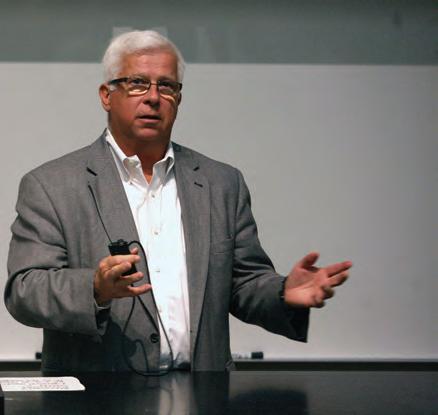
“The reality is that over the years, the board brought credibility and maturity to the organizations,” Tims said.
“I loved watching when the board was fully engaged with new and better ways to serve students and collaborate with partner organizations.”
Tims said he was proud of where the organizations were when he left in 2018 but that the work wasn’t done.
“Before 2000, the organizations had a healthy foundation. Now they have a legacy,” Tims said. n
040 PROFILES // AL TIMS
AL TIMS, was the longestserving board president, serving from 2000-18.
CELEBRATING SUCCESS
Board president Al Tims presents a Pacemaker award, the association’s highest honor for student media, to editor Caitlin Burns of the Kansas State University Royal Purple at the 2012 ACP/CMA convention in Chicago.
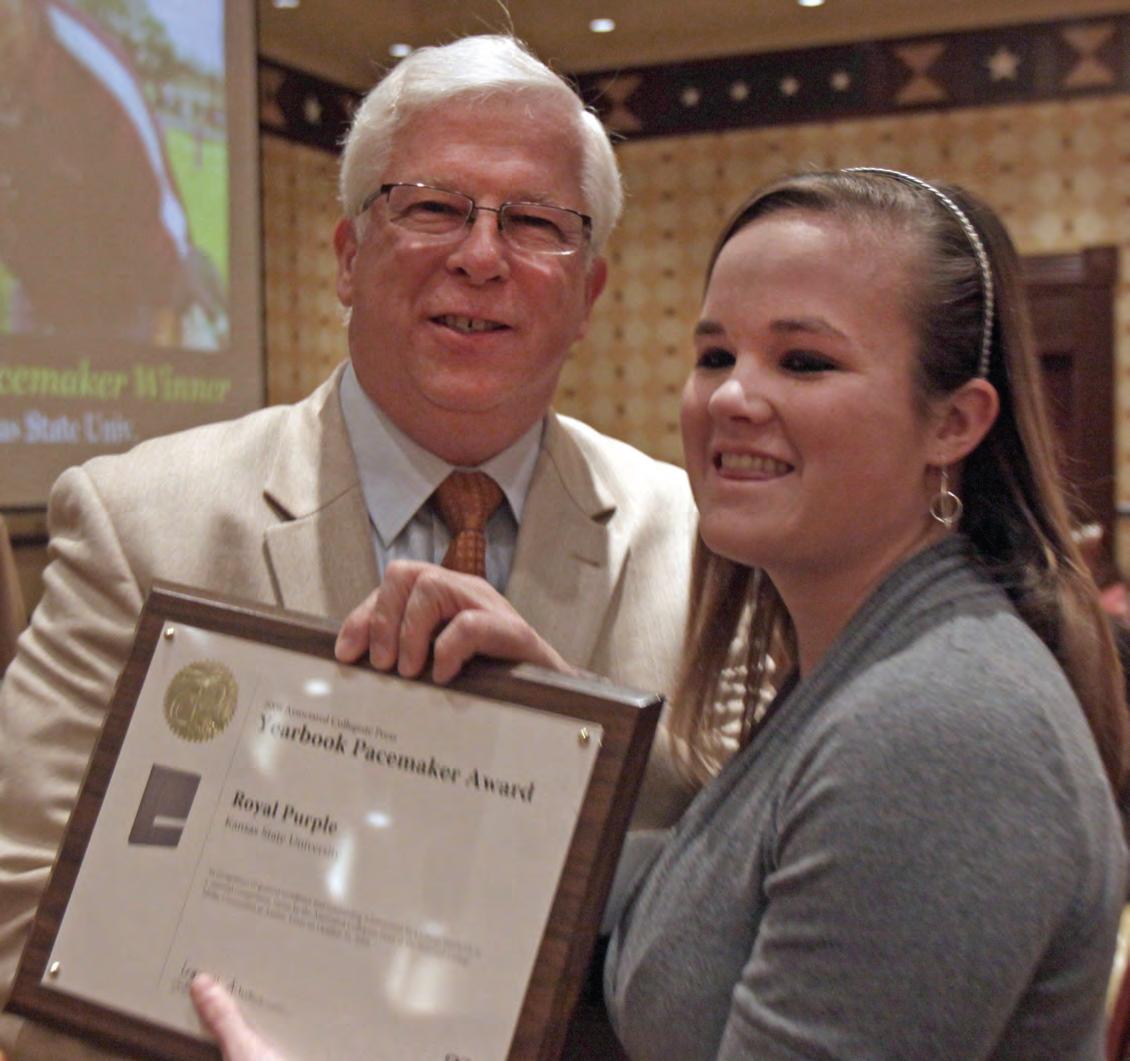
041 PROFILES // AL TIMS
CONVENTION BUSINESS
Managing registration for high school conventions was an NSPA responsibility. Ann Akers, associate director, looks over records with Albert “Flip” DeLuca, board member and Al Heider, NSPA staff.
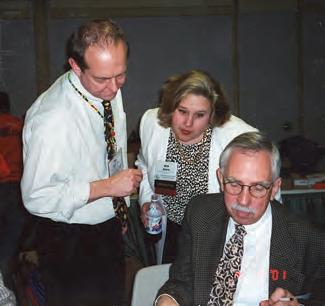
WORKSHOP INSTRUCTOR
As an award-winning adviser in Iowa and California, Ann Akers taught at the NSPA Summer Workshop at the University of Minnesota from 19821990. In 1983, she instructs students in the Newspaper Production Lab.
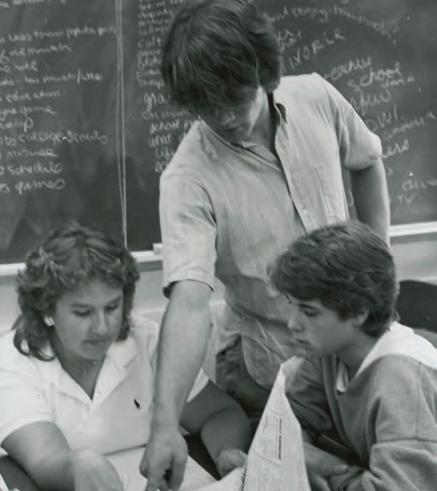
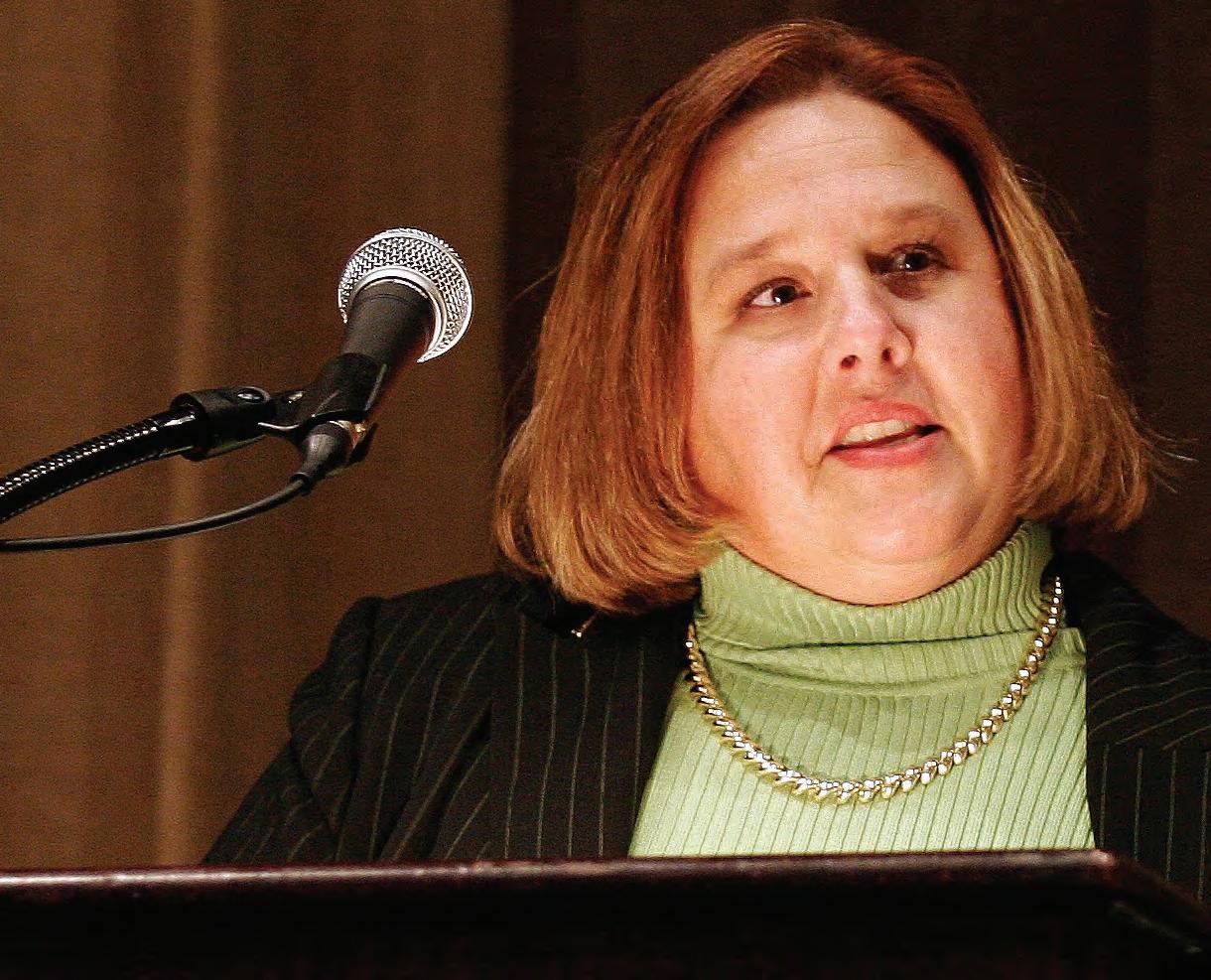
042 PROFILES // ANN AKERS
S
Akers
FORMER NSPA/ACP ASSOCIATE DIRECTOR IS AN EXPERT ON ALL THINGS SCHOLASTIC JOURNALISM.
HE WAS 17 when she attended her first convention.
It was 1975, and Ann (Gramlich) Akers was newspaper editor at West Des Moines Valley (Iowa) High School. The convention, at the Palmer House, in Chicago, began her lifetime relationship with NSPA/ACP.
As it turned out, her high school adviser, Greg Franck, was a friend of Tom Rolnicki, then the Ames High School (Iowa) adviser who became the NSPA/ ACP executive director from 19802006. Rolnicki and Akers were on the convention bus that Thanksgiving Day.
“Several Iowa schools shared a bus to the convention,” Akers said. “We stopped in the Amana Colonies for a ‘family’ Thanksgiving dinner, but we had to hurry because we needed to be in Chicago in time for Write-Offs.”
The rushed meal was worth it. Akers took first place in Newsmagazine Layout, the highest award given at the time, and the staff took second in Sweepstakes.
That convention cemented Akers’ love for scholastic journalism, she said. The working relationship with Rolnicki continued at Iowa State University. Rolnicki had accepted a position there. Akers had enrolled there.
“It was cool when we reconnected,” Akers said. “T.R. was the adviser to our yearbook staff and taught the journalism-education classes. He was supposed to be my observer when I student taught, but the NSPA opportunity began weeks before school opened that fall, and he moved to Minneapolis.”
In 1981, Akers returned to the fall high school convention, but this time as the Ames High School adviser, and Rolnicki was the NSPA executive director. Since then, she’s only missed one fall convention — Cleveland in 1985 — and she has attended every spring convention since 1984.
Her count is at 160. Akers says she has attended more than her fair share of scholastic and collegiate journalism conventions.
In 2000, Akers became NSPA/ ACP associate director. She helped plan two high school and two college conventions a year, as well as attend conventions for partner organizations Columbia Scholastic Press Association and College Media Advisers.
What keeps her coming back?
“The best thing about conventions is the sense of community they build,” Akers said. “Everyone there realizes they are part of something bigger than just doing journalism at their school.
“Even if your program is respected at your school, it is rarely the No. 1 activity. Staff members don’t realize what a big deal it is,” she said. “But, at a convention, rather than 30 of you, there are thousands who want to tell stories, take amazing photos — it’s empowering for the students.”
Akers said the feeling of camaraderie isn’t limited to the students.
“For the advisers and for me, it’s being with the people you only get to see once or twice a year,” Akers said. “There’s a feeling of tribe and a mission of shared truths.”
She has attended conventions as a student, teacher, yearbook publishing representative and NSPA/ACP staff member. Now she attends as the Herff Jones manager of customer engagement. She has watched how they evolved.
“They’re bigger. In 1975 only about 1,000 people attended the Chicago convention, and large delegations were 15-18 from a school,” Akers said. “Then there were years when schools brought 65 plus to conventions. Now, the pendulum is swinging back. Fewer people get to travel big because of travel policies, expenses and other demands on students’ time.”
There may be fewer delegates per school, but the number of convention
attendees keeps growing. Akers said the increase indicates more schools are attending because the convention experience has expanded.
“The trade show is big and crazy now” Akers said.
The focus in the exhibit hall from individual companies and colleges is on interaction with students. “Students can visit with college representatives about programs geared to journalism and media, and that’s a real draw,” she said Akers credits convention recognition programs with helping enhance the convention experience, too.
“Best of Show is really important,” Akers said. “So many administrators are influenced by that kind of recognition. It’s also a fast way to make the students and advisers smile and cement their intentions to follow through with strong publications”
The 2019 pandemic forced the convention experience to evolve even further.
“Using the internet to offer online sessions made it possible for more schools to attend conventions virtually, and the organizations made the sessions available online for a time after the convention so the learning could be shared more broadly to staff members,” Akers said.
Access to information might be more readily available, but Akers said there are some experiences that are missed.
“Students learn about traveling, being part of a group, eating in restaurants, navigating an airport — all of those life experiences,” she said. “There’s so much team bonding that happens when you move as a group, share as a group and learn as a group.
As associate director of NSPA/ACP from 2000-06, Akers cites three highlights.
“We continued to evolve conventions by working with local committees in each convention site. The exhibit and promotional materials were better, and
043 PROFILES // ANN AKERS
ANN
Continued >
ANN AKERS, associate director from 20002006, accepts the Carl Towley Award from JEA at the 2005 Chicago convention. The award is the highest tribute to a member.
working with JEA allowed us to capitalize on a shared vision for how we could best serve our members,” she said.
With offices in Minneapolis, NSPA/ACP accepted the charge to provide a headquarters and programming for the Minnesota High School Press Association.
“We worked with area teachers to develop a summer workshop and a state convention,” Akers said. “We were a national organization, but we felt we needed to take care of the state organization, too.”
But the focus wasn’t limited to high school programs, she said. Under Rolnicki’s direction, ACP evolved, too.
ACP built relationships with other professional groups, created a book recording collegiate media coverage of 9/11 and developed international programs in Eastern Europe and Canada so those students could see what collegiate journalism was like on a bigger scale, she said.
“We started ACP Best of the Midwest and it focused on schools with less support and from the Midwest area that often couldn’t attend a national convention.”
Akers said the associations also developed publications to support staffs.
Trends magazine recognized journalism programs, and shared the newest techniques.
Best of the High School Press was developed in 1993 to show off what was good and what was being done right, Akers said.
“Tom was especially proud of the Guidebooks that supported the critical services we offered,” Akers said. “The Guidebooks were kept fresh and updated frequently. The world was changing, and so were the Guidebooks. They served as a best-practices manual for what made a great publication and what the judges would look for.”
For the last 100 years, NSPA/ ACP has provided learning opportunities, Akers said.
“It’s been a source of information on how to improve publications. It’s been a continuous source of external feedback through critiques and recognition.
“The needs and the issues are more complex than ever, and the staff has to be ready to answer that,” Akers said.
“The organizations need to stay aware and flexible.” n
MARC WOOD served as communications technology director for 15 years, 1997-2012.
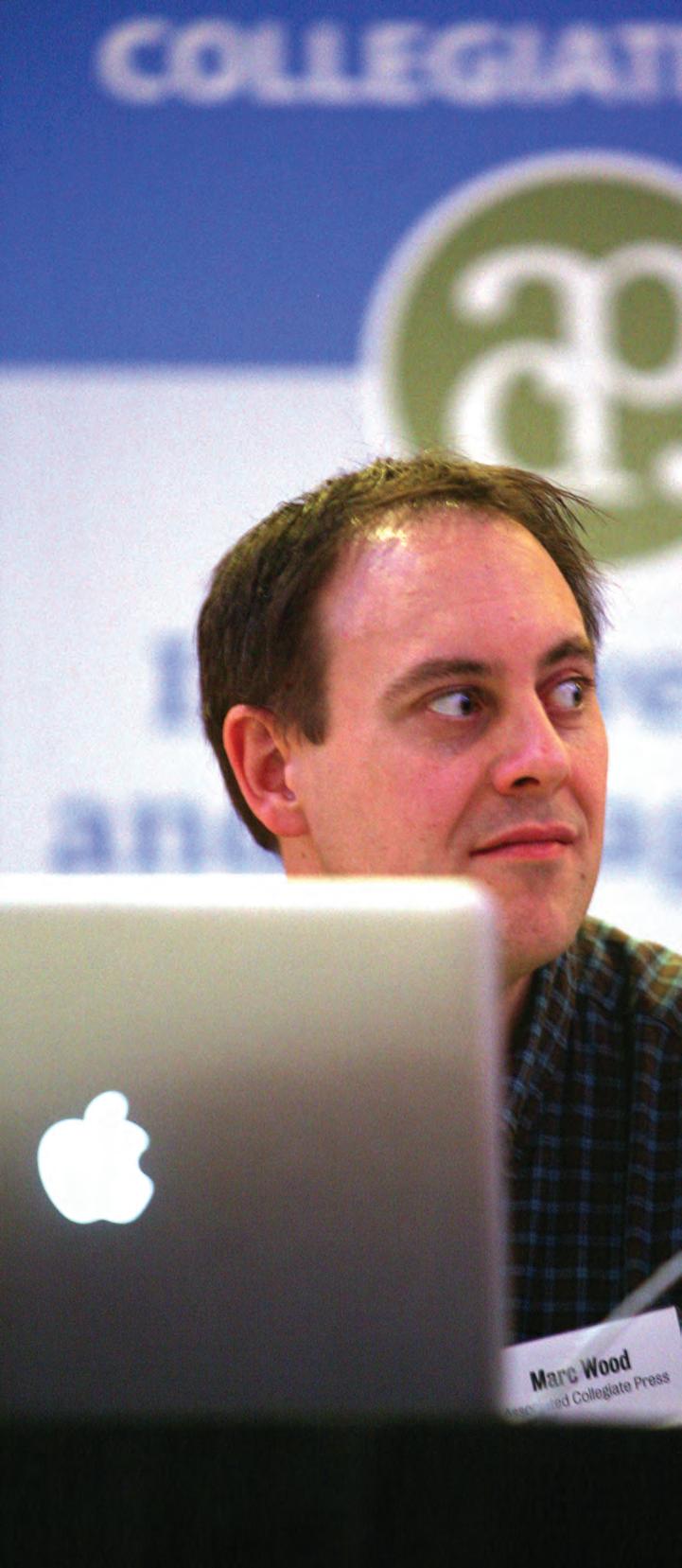 > Ann Akers continued
> Ann Akers continued
MARC
Wood
DURING HIS 15 YEARS AT NSPA/ACP, COMMUNICATIONS MANAGER IMPLEMENTS SIGNIFICANT TECHNOLOGY CHANGES.
BEFORE HE JOINED the NSPA/ ACP staff in fall 1997, Marc Wood had been on the staffs of his high school yearbook and college newspaper, and he had worked as a news photographer after college.
Beyond that affinity for journalism, the travel convinced him to take the job, he said.
“The travel was a great perk. Before taking the job, I had never been on an airplane, but I didn’t volunteer that information in the interview,” Wood said. “As it turned out, I was on a lot of planes and attended 50 national conventions.”
During the 15 years Wood was at NSPA, he made significant changes in technology, and he changed, too, he said.
“My focus shifted as the needs of the organization changed,” he said. “I started my career writing and doing some photography and design. When I went to NSPA, I got more into graphic design and started developing for the web.”
An expanded online footprint changed the face of the organization.
“I remember watching the mountains of mail come in and go out of the office. The less of that we can do, the better. Cutting down the wait factor makes things more expedient,” Wood said.
“There was a web site before I got there but the server was housed on a single Mac in our office. We were constantly trying to grow the website to meet the expectations people had because of the developing technology they were using. Our challenge was to make that growth happen on a non-profit budget.”
Wood said the changes made the staff more efficient and served
the membership better.
“In the early days, we faxed 15-20 pages of contest results to individual schools. It took a couple of days for people to get the results. As we developed the online programs, we were able to get the results out moments after they were announced,” Wood said. “Improvements like these and the addition of online convention registration and contest entries saved hundreds of hours of work for the staff.” Wood’s technology developments gave conventions a facelift.
“In the late ’90s and early 2000s, schools had to stand in long lines at the convention registration desk. We had five three-ring binders with lists and records of the schools. It took forever for us to look up and process each school. In 2005, check-in went digital and in-line times were significantly shorter,” Wood said. Awards ceremonies evolved as well.
“We used to stand at the podium and read names from a list,” Wood said. “It was still exciting because the student energy in the room was always over the top. Then we read names and had slides of the winners.Now the list of winners, judges‘ comments and winning entries are part of the ceremony.”
Wood became a master at FileMaker software, and he said he still uses it in his current job with Tactile Medical, a company that develops at-home therapy devices.
“I learned so much working at NSPA,” Wood said. “Learning tech as tech was starting to grow and mature into a new industry was a great experience.
“I left because the skills I learned there became more valuable elsewhere,
so financially it made sense to move on for my family’s sake.”
Wood’s extended family includes the 28 staff members he worked with in the five-to-six person office during his 15 years at NSPA, as well as the teachers and professional journalists with whom he has shared significant moments.
“The major news events of the times seem more important because there’s an intersection of the event and NSPA’s focus on training student journalists. The office staff was always invested in the major stories. On 9/11 we bought a television for the office because all the websites were down.
“Election night in 2000 was significant because we were in DC for the convention, and we woke up the next morning not knowing who had won. There was a lot to talk about while we were there.”
“But the event that most stands out is Hurricane Katrina in 2005. We sat in the office and watched the windows being blown out of the Hyatt Regency where we were to have the ACP convention in two months. Hyatt offered its hotel in Kansas City, and everyone worked together to reset the plan so the convention could go on nearly as it was planned.”
Wood said it’s one thing to build something and quite another to leave it in a state so it could be maintained by someone else.
“Once you offer a program or develop online activities, there are certain expectations about services,” he said. “There’s no going back once you’ve started offering those things.
“You keep moving forward.” n
045 PROFILES // MARC WOOD
Aimone
“EVERY CONVENTION WAS A SPECIAL MOMENT” DURING HIS SIX YEARS AS EXECUTIVE DIRECTOR FROM 2007-13.
LEADING A NATIONAL organization always has its challenges, but, in 2007, when Logan Aimone became the executive director, adapting to change was Job One.
“Taking over at a time when there was a huge transition in the field of journalism was definitely the greatest challenge I faced,” Aimone said.
“There was a massive recession in 2007 and then the housing market fell in 2008,” he said. “Add to that the collapse of the business model for advertising dollars, the influx of social media, websites, camera phones that made everyone a citizen journalist and a justdo-it-online mentality, and you have a formula for rethinking current practices.”
Falling ad revenue and budget cuts especially affected collegiate publications. By 2009-10, a number of them saw their financial base in free fall.
“Classified ads that had been a strong revenue source were drying up, and advertising revenue in general was slipping,” Aimone said. “For some, that meant there was no money to attend conventions and workshops, and there was pressure to publish online.
“All of that affected our bottom line, too. Although the colleges have been able to weather that storm, we saw a significant reduction in daily newspapers. Many who had published five days a week were publishing a printed paper three days a week and increasing their online presence.”
Redefining the focus of the organizations was a bit of an educational guessing game for Aimone and the staff.
“We looked at what was happening in
the industry and tried to figure out which things would have impact and which would stick around.” Aimone said. “Then we changed what we did — speakers and sponsored activities — to help our members and to serve student media.”
In 2009, NSPA hit a milestone when it published the first-ever guidebook for online journalism.
“Prior to the guidebook, there were no established standards for online journalism,” Aimone said. “Judges would just respond to what appealed to them so schools didn’t have any best practices to follow.
“After the guidebook was available, there was an uptick in the number of contests and school websites. Ultimately critiques went up significantly, too.”
Aimone said the guidebook was an important contribution to student media.
“Setting standards — that’s the role of a national organization,” he said. “The state press associations looked to NSPA for guidance and fell in line with their own judging criteria that reflected the national guidebook.”
The organizations set standards also with a strong internal infrastructure. It established policies and procedures for the organizations, with renewed financial accountability and oversight.
“A lot of that work was done behind the scenes,” Aimone said. “Marc Wood, who worked for the organizations about 15 years, deserves to be recognized. He did more than anyone to keep things running smoothly during transition times. He set up membership data bases, established procedures for convention
registration and kept us going.”
Aimone, who taught journalism at Wenatachee High School (Washington) for 10 years prior to joining NSPA/ACP, said a highlight was the national conventions.
“Every convention was a special moment,” he said. “It’s one place where you see the tangible results for your work and what your work has enabled. There’s nothing better than announcing awards at the awards ceremony and seeing the excitement from the staffs whether they are winning their first or their 20th Pacemaker, or supporting one of their staff members as they win an individual award.
“I remember the thrill of sitting with my own staffs during those ceremonies, and then as executive director I celebrated with every staff.”
Aimone returned to the classroom in 2015 with a teaching position at University of Chicago Laboratory School. Being a classroom teacher, NSPA/ACP executive director and again as a classroom teacher gives Aimone a distinct perspective.
“I think I have a greater understanding of what goes on behind the scenes with the organizations, and I have the benefit of two vantage points for the same student work,” he said.
“That makes a difference in understanding the decisions we made at NSPA/ACP resulted in changes in standards and that continues to have a big impact on what is taught in the classroom.
“I just have deep feelings that you can’t have the same professional feel without the national organization setting standards and validating successes.” n
046 PROFILES // LOGAN AIMONE
LOGAN
ON-SITE CRITIQUE
Providing suggestions for improving their newspaper, Logan Aimone, executive director, meets with the editors of Eyrie, Eden Prairie High School (Minnesota) during the 2008 NSPA Summer Workshop at the University of Minnesota.
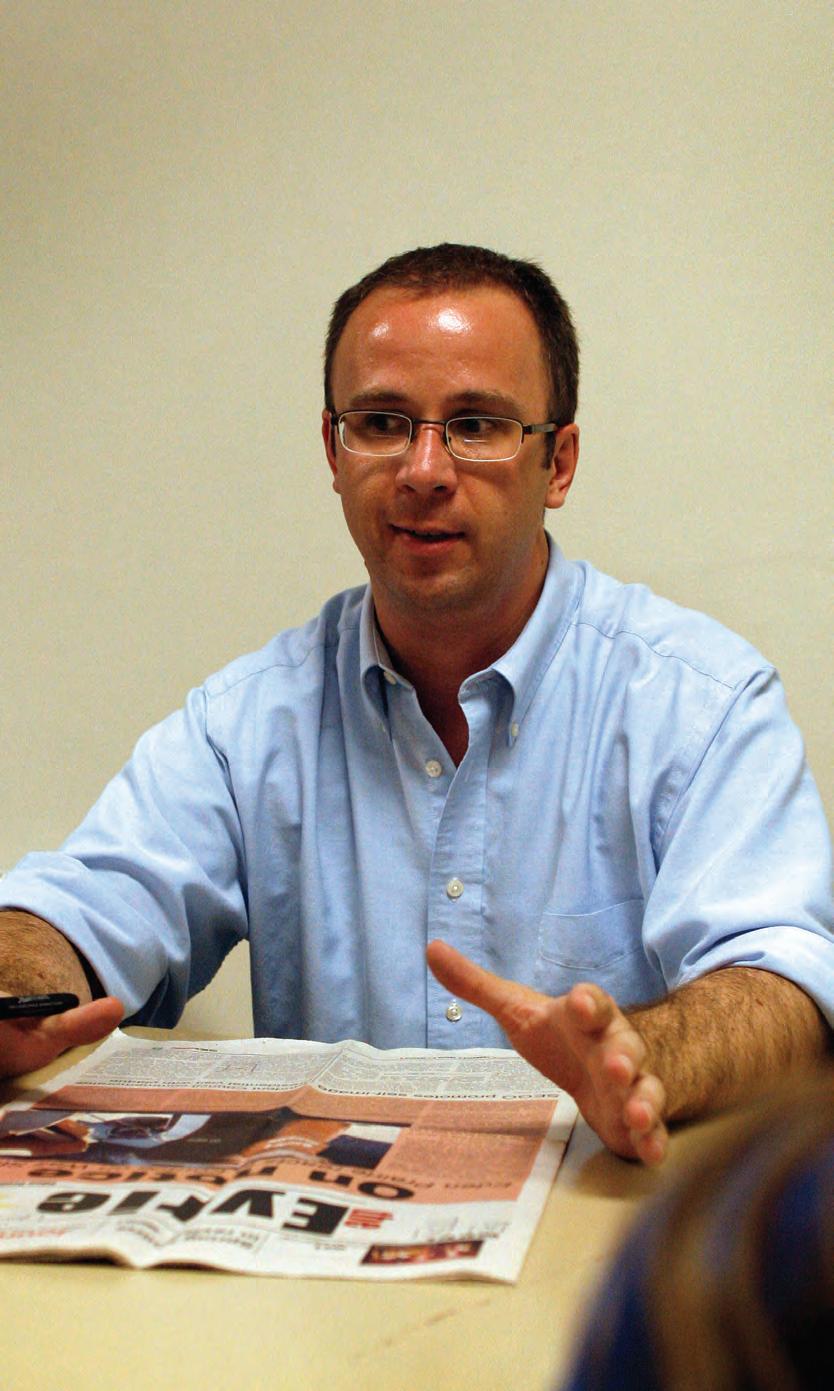
TEAM NSPA/ACP
In 2008, the NSPA/ACP crew enjoys a team dinner at convention: Kathy Huting, contest and critique coordinator; Marc Wood, communications director; Mike Gesellchen, administrative assistant; Emily Griesser, member services director and Logan Aimone, executive director.
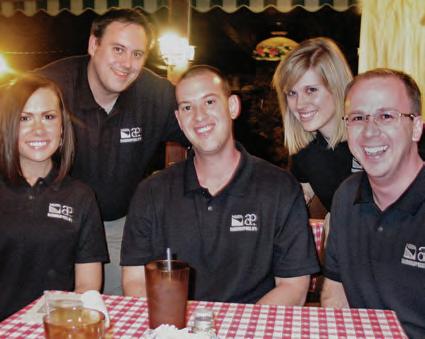
GETTING READY
NSPA/ACP handled registration at both the high school and college conventions. Jacqueline Flaum, administrative assistant and Logan Aimone executive director, prepare to open the registration desk at the 2011 National College Media Convention in Orlando, Florida.
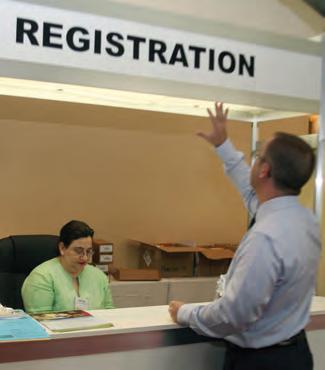
047 PROFILES // LOGAN AIMONE
MITSU
KLOS, executive director from 201315, announces NSPA awards at the 2014 convention in Washington, D.C. With 6,406 delegates, the convention was the largest in history.
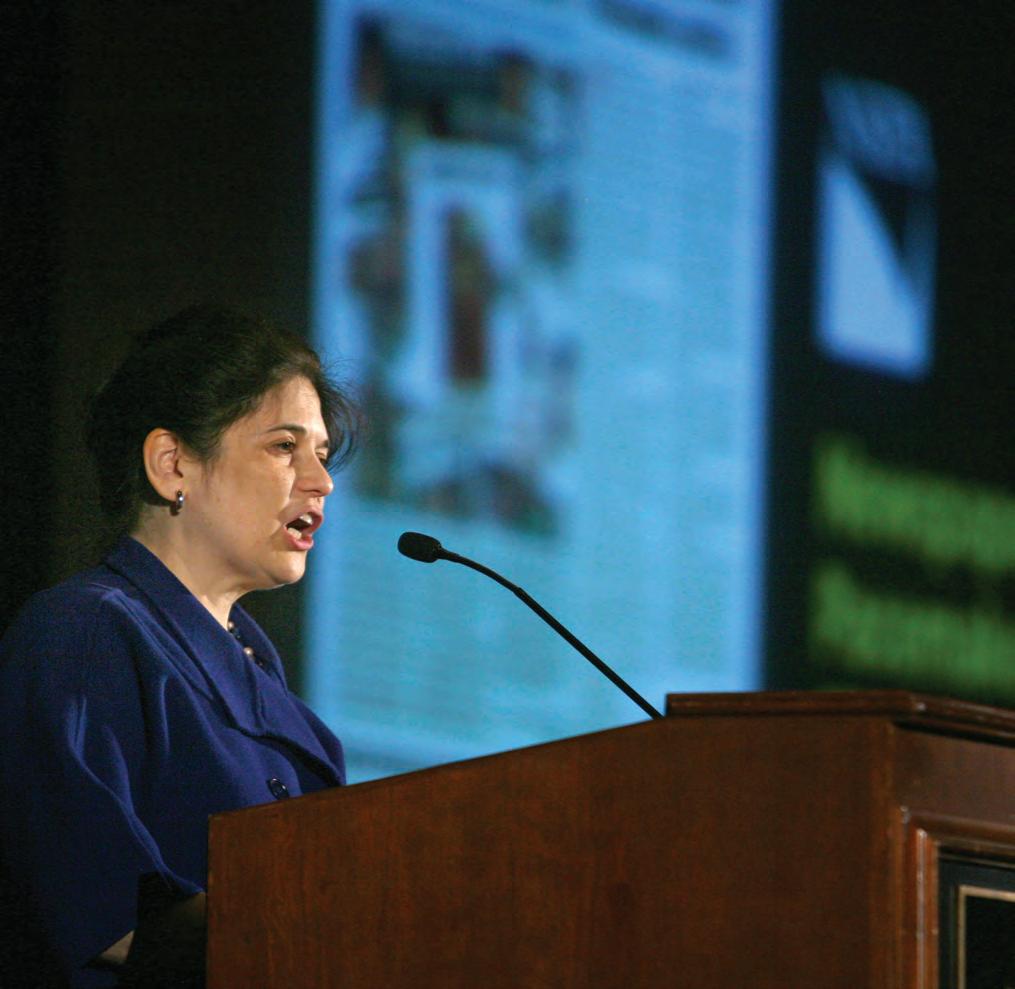
INFORMAL MEETING
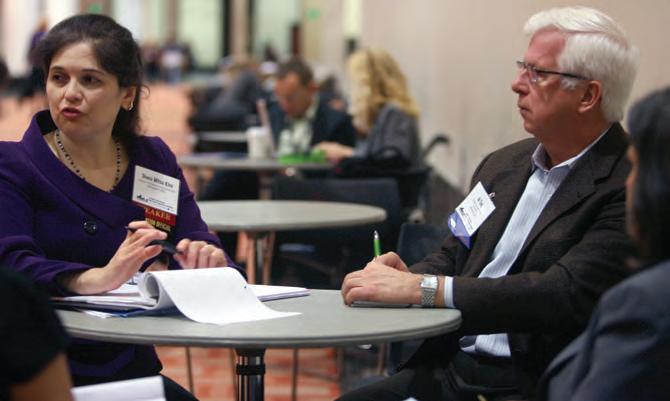
048 PROFILES // DIANA MITSU KLOS
Diana Mitsu Klos, executive director and Al Tims, board president, share ideas with other board members during a high school convention.
DIANA
DIANA
Mitsu Klos
EXECUTIVE DIRECTOR MAKES HISTORY AS THE FIRST ASIAN AMERICAN AND THE SECOND WOMAN TO LEAD NSPA/ACP.
DIANA MITSU KLOS made history when she became the executive director in 2013. Not only was she the first woman to have the job since Jeanne Buckeye was executive director in 197578, she was also the first Asian American.
“I remember thinking hiring me was a bit of a milestone for the organization,” she said. “I was so humbled to be in that position at that time. Student journalism is so important to the survival of American democracy.”
Journalism faced transition and change, and National Scholastic Press Association, Associated Collegiate Press and the Minnesota High School Press Association had to meet those changes. Mitsu Klos said change defined her time as executive director.
“It was a time of financial reckoning for the profession and for journalism education,” she said. “We really needed to focus on bringing resources to students and advisers and celebrating their successes with them.
“It was a time when we recognized you have to meet people where they are, and that wasn’t just hard-copy.”
One of the first projects Mitsu Klos directed was updating the organization’s websites and adapting to a more modern content management system to bring NSPA/ACP into the new century.
“We streamlined registration for conventions, workshops and contests,” she said. “We wanted to make it easier for members and others to connect with us.”
Their efforts were rewarded as contest and convention numbers grew and communication with schools
increased significantly. Mitsu Klos said the staff was realigned when financial tracking, information tracking and other mechanical responsibilities were outsourced so more time could be spent on building relationships and expanding the reach of the organization.
“We listened to all of the feedback we could gather. As a result, we focused on engaging in social media because that was where young people and advisers were going for information,” she said. “We sought out various news organizations on social networking and how to connect. The organization now has a strong on-going social media presence.”
The board of directors played a key role in Mitsu Klos’ tenure. She lived in northern Virginia through her tenure and both worked remotely and flew frequently to Minneapolis. She said it was novel then, but this approach to work is likely going to be far more common in the American workforce post-pandemic.
“There was an energy and passion from the new board members to build on significant contributions from previous directors,” Mitsu Klos said. “It was a time of significant challenges in establishing how to work with longtime convention partners, and the board was a great resource. Those partner relationships continue to evolve and at some point may come to a place where there is increasing consolidation.”
Mitsu Klos said some of her favorite memories are from the ACP midwinter conventions, usually on the West Coast.
“David Carr, The New York Times media columnist, was scheduled to
be a 2015 keynote speaker in Los Angeles,” Klos said. “But a week before he was to speak, he collapsed in the newsroom and died.
“I immediately turned to Brian Stelter, who was close to David Carr and had worked with him at The New York Times before he moved to CNN. I also knew Stelter had been editor of the Towson University student newspaper, The Towerlight, and after graduation served on their board. He agreed to come to L.A. and CNN covered his expenses.
“Brian was honest, candid and funny and totally focused on the students,” she said.
As it turns out, Stelter had attended an ACP convention when he was a college student. Mitsu Klos said his commitment was eye-opening.
“I understood that conventions could be life-changing experiences,” she said. “It was such an honor to be part of that work.”
In March 2014, University of Southern California professor Robert Hernandez was the closing keynoter at the ACP conference in San Diego. Traveling from a speaking engagement in the East, his flight was delayed in Chicago due to bad weather. Hernandez quickly prepared a brief introductory video and then live tweeted with the students — while airborne.
“Everyone in the audience had their phones out and the hashtag #ACPressAMA briefly trended on Twitter on that Sunday morning,” Klos said. “It reinforced the increasing necessity of building ample wifi options into convention hotel contracts.” n
049 PROFILES // DIANA MITSU KLOS
ELISIA
NSPA/ACP PRESIDENT FROM 2017-2020 LEADS THE RESTRUCTURING OF THE BOARD AND ITS BYLAWS.
SHE IS AN AGENT OF CHANGE, but not for the sake of change.
Elisia Cohen, director of the Hubbard School of Journalism and Mass Communication at the University of Minnesota, came to the Minnesota position from a strategic communications background.
She said she had little experience with student media, but that didn’t stop her from leading the NSPA/ACP board of directors.
In three years as president — from 2017 to summer 2020, she guided the board through an introspective look at the organization’s purpose and the board’s role. The result was a restructuring of board makeup and organization policies.
“My mother was a high school journalism teacher in Louisville, Kentucky, but I had little direct experience with scholastic journalism,” Cohen said. “I tried to learn as much about NSPA/ ACP and the relationship with the School of Journalism as I could.
“I discovered there was no formal statement about NSPA’s relationship to the school or that the director of the school would serve as president of the board. The bylaws hadn’t been updated in a long time,” she said. “It seemed the right time to solidify what had been practice for so long.”
Additionally, university policies had changed. While there was always a strong conflict-of-interest policy for board members, Cohen said, the board needed to modernize the policy to align with the university and to clarify the relationship between NSPA/ACP and the school.
After working on the bylaw revisions for more than a year, a committee led by Chuck Clark, board member and student-publications director at Western Kentucky University, approved a document that called for
revised board composition, affiliation agreements and investment policies.
“The board wasn’t making changes just for change’s sake. The document called for changes that really made a difference and benefited the organization,” Cohen said. “The membership of the board is more secure and gives the board an opportunity to think about the leadership of the organization as new members are invited to the board,” she said.
“The new document keeps the good parts of the relationship with the school — offering support when needed, finding volunteers to help — and eliminating conflict-of-interest issues.”
While the bylaws and policies were being reviewed, Cohen and the board faced other challenges.
“I was president when the pandemic began. We navigated the ACP summer Mega Workshop online, and it was online again in 2021 before returning in person in 2022.
“We had to cancel the face-to-face National High School Journalism Convention in Nashville and develop a virtual event. The ACP convention also became a virtual event, and then all of the conventions in 2020 and 2021 were virtual,” Cohen said. “Those changes had a negative effect on our finances.”
As part of the organization’s review, a new financial management firm changed investment strategies. That, Cohen said, was a lifesaver.
“They changed our investment strategy to a more conservative approach so we invested more securely,” Cohen said. “That helped us get bids for supplies and services and helped us secure federal Payroll Protection Program funds after the pandemic hit.”
Training for advisers and staffs and new contests were developed to serve constituents and bring in additional
revenue, and Ron Johnson was hired to focus on external relations, which became vital during COVID-19, she said.
But Cohen said perhaps the biggest change to happen while she was president was relocating the office.
“I found a pro bono lawyer to help with the new lease agreement. We located a beautiful space just a few blocks from where the office had been,” Cohen said.
The timing was right to step down as president in 2021, she said.
“I wanted to be sure I understood both organizations and the board,” Cohen said. “The board has always been a collaborative board believing in shared governance.”
She credited current president Jeanne Acton and president-elect Elizabeth Smith for their leadership.
“The mixed leadership, with high school and college representation, gives stability for the board to think about who would be in leadership positions over the long term.”
Cohen predicted the board will continue to act as an agent of change.
“It’s critical that NSPA/ACP serve as an independent, member-based, studentfocused organization recognizing and awarding the best of student journalism across the country. Because of its strong focus on students and recognizing their accomplishments it is special and different from any other organization,” Cohen said.
With strategic planning, she said, there is an opportunity to grow by reaching rural, inner-city or any schools who can’t afford to travel but could attend low cost or free virtual sessions and submit their work for competition.
“There’s growing interest in journalism,” Cohen said. “And, the racial change happening in our country right now provides an interest level and opportunity to grow.” n
050 PROFILES // ELISIA COHEN
Cohen
COHEN, president of the board from 2017-20, welcomes student journalists and advisers to the University of Minnesota for the College Media Mega Workshop.
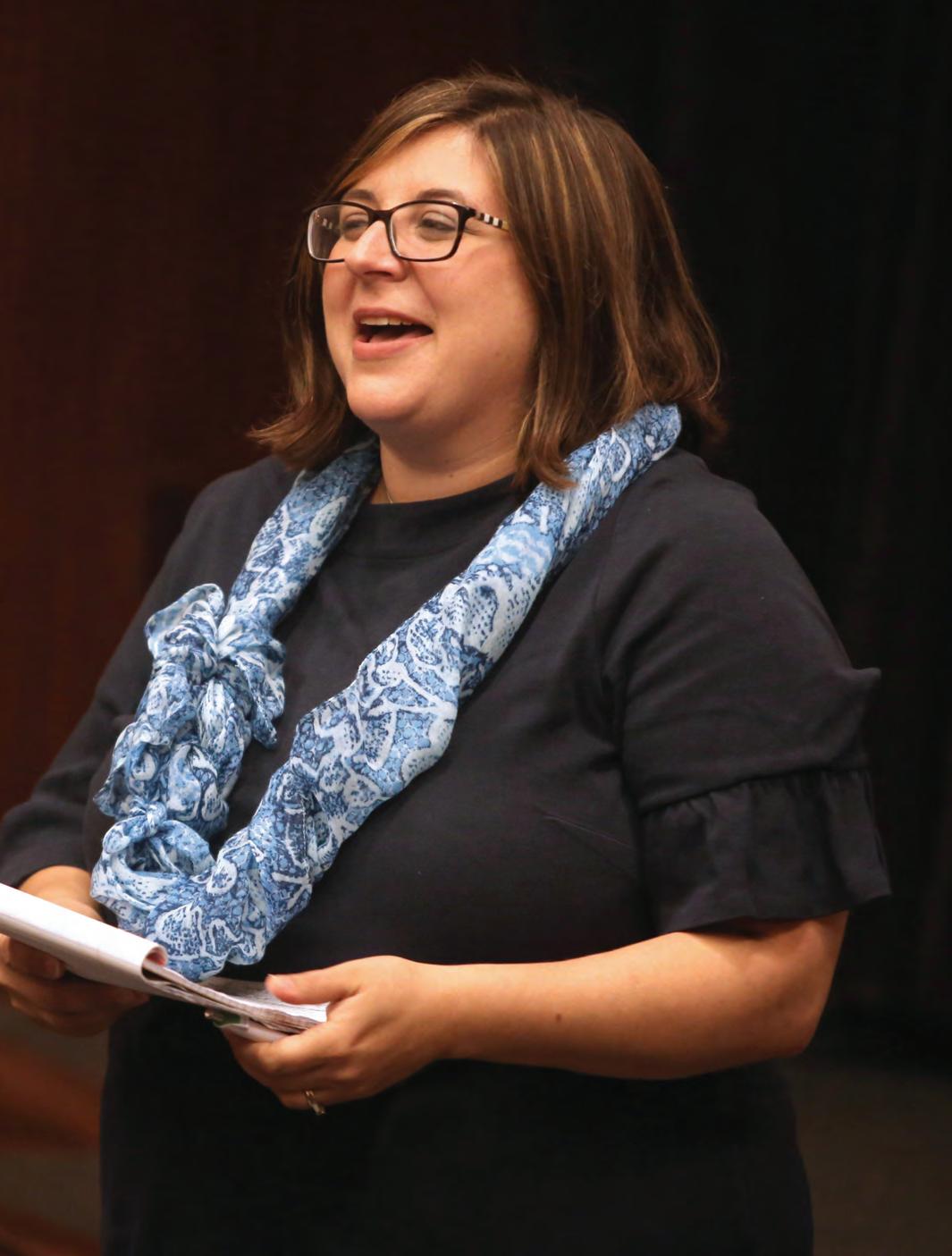
051 PROFILES // ELISIA COHEN
ELISIA
JEANNE
Acton
FIRST BOARD-ELECTED PRESIDENT SERVES DURING AN ERA OF UNPRECEDENTED CHALLENGE AND CHANGE.
AS THE FIRST board-elected president, Jeanne Acton took the helm at a time of unprecedented challenge and change.
The COVID-19 pandemic, declining revenue sources and bylaw revisions might have been daunting, but Acton, who was journalism director of Texas’ University Interscholastic League, one of the nation’s largest scholastic journalism organizations, said the NSPA/ACP board was revitalized, and the organizations prospered.
The bylaw revision came about at the suggestion of Elisia Cohen, director of the Hubbard School of Journalism and Mass Communication at the University of Minnesota, who was then president of the board. The new bylaws called for the board to elect the president from its membership.
“It’s a good change,” Acton said. “The president will always be someone who has current connections to high school or college media.”
The bylaws established the president and president elect will serve two-year terms and will alternate between a NSPA representative and an ACP representative.
“The leadership team will come at things a bit differently now because we will always have someone who has a hands-on, real-experience approach in the mix,” Acton said. “The transition should be smooth because the president will stay on the board for an additional two years as past president and consultant.”
While the leadership roles of the board have changed, the makeup of the board has remained relatively the same, which gives consistency to NSPA/ ACP, she said. Much of the board has worked with Laura Widmer, executive director, and Gary Lundgren, associate director, for several years, and Acton said the board supports them.
“Gary and Laura are servant leaders who are responsive to the membership needs,”
Acton said. “It’s easy for the board to support them because they are 100 percent invested in the success of NSPA and ACP.
“I look forward to going to Minnesota for meetings because of the relationships we have. I love the closeness of the board — and the fact we can have fun as well as frank discussions. There are still challenges ahead, but the organization is in a good place.”
With the economic loss of face-toface conventions, Acton said the forward thinking of Widmer and Lundgren kept the organization going strong.
“Surviving the pandemic was our greatest challenge. Laura and Gary were creative, flexible, tight with the budget and developed new revenue streams,” Acton said. “Media is constantly changing, and they did a fabulous job of staying current and helping student staffs stay current, too.“
In addition to the virtual scholastic and collegiate national conventions, NSPA/ACP staff created workshops and programs to serve constituents.
“Even when awards ceremonies were virtual, they were exciting,” Acton said. “Online conferences and new contests like Clips and Clicks helped students stay current with techniques and trends while benefiting the organization with a new revenue stream. That meant NSPA/ACP could help other student media organizations through collaboration and partnerships.
“These are uncertain times and all the student journalism organizations need to support each other if we are to survive,” Acton said. “NSPA/ACP has been in a position to support groups in a way that keeps them solvent.”
When Dallas County Schools found they were not able to serve as the sponsoring agency for the Gloria Shields Summer Workshop, the workshop
directors reached out to NSPA to become partners, Acton said. Although the pandemic has curbed enrollment these last two years, the workshop has grown, and the future is bright for this strong collaborative effort. The executive board supports more collaboration with organizations because that strengthens all of us to serve students and teachers better.”
Other partnerships have been formed with related student media groups. A new agreement reunited ACP with College Media Association, after a oneyear hiatus. A three-year partnership was formed with College Media Business and Advertising Managers, and, on the West Coast, the California College Media Association and the Journalism Association of Community Colleges are now partners for ACP spring conventions.
In July 2022, Quill and Scroll merged with NSPA to create a stronger national honorary organization.
“I think the partnerships we are forming will become our greatest legacy. We need journalism and we need to help it survive — to grow, get better and stronger. We must start educating at a young age to help students understand ethical journalism. Without journalism democracy dies,” Acton said.
NSPA’s mission supports student journalism through education and recognition, she said.
“Giving awards to schools and individuals validates student work and best practices,” Acton said. “I don’t know exactly what the future holds for NSPA and ACP, but I know it will be good for student journalists. Laura and Gary are such a great team and will continue to grow the organization to provide invaluable services for our students and advisers.
“Scholastic journalism will be stronger because of them.” n
052 PROFILES // JEANNE ACTON
LEADING FROM THE HEART

The president’s job includes more than leading board meetings and making difficult operational and financial decisions. Whether presenting an NSPA Pioneer Award to long-time Texas adviser Lori Ogleebee (left) or waving to family at home on FaceTime with a student receiving an award (below) — Jeanne Acton is an enthusiastic ambassador for NSPA/ACP.
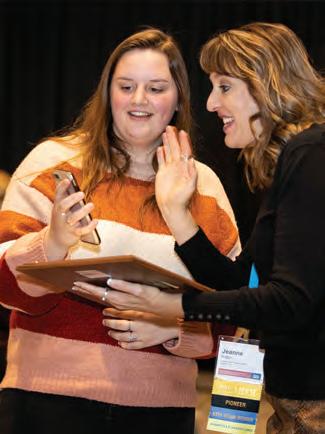
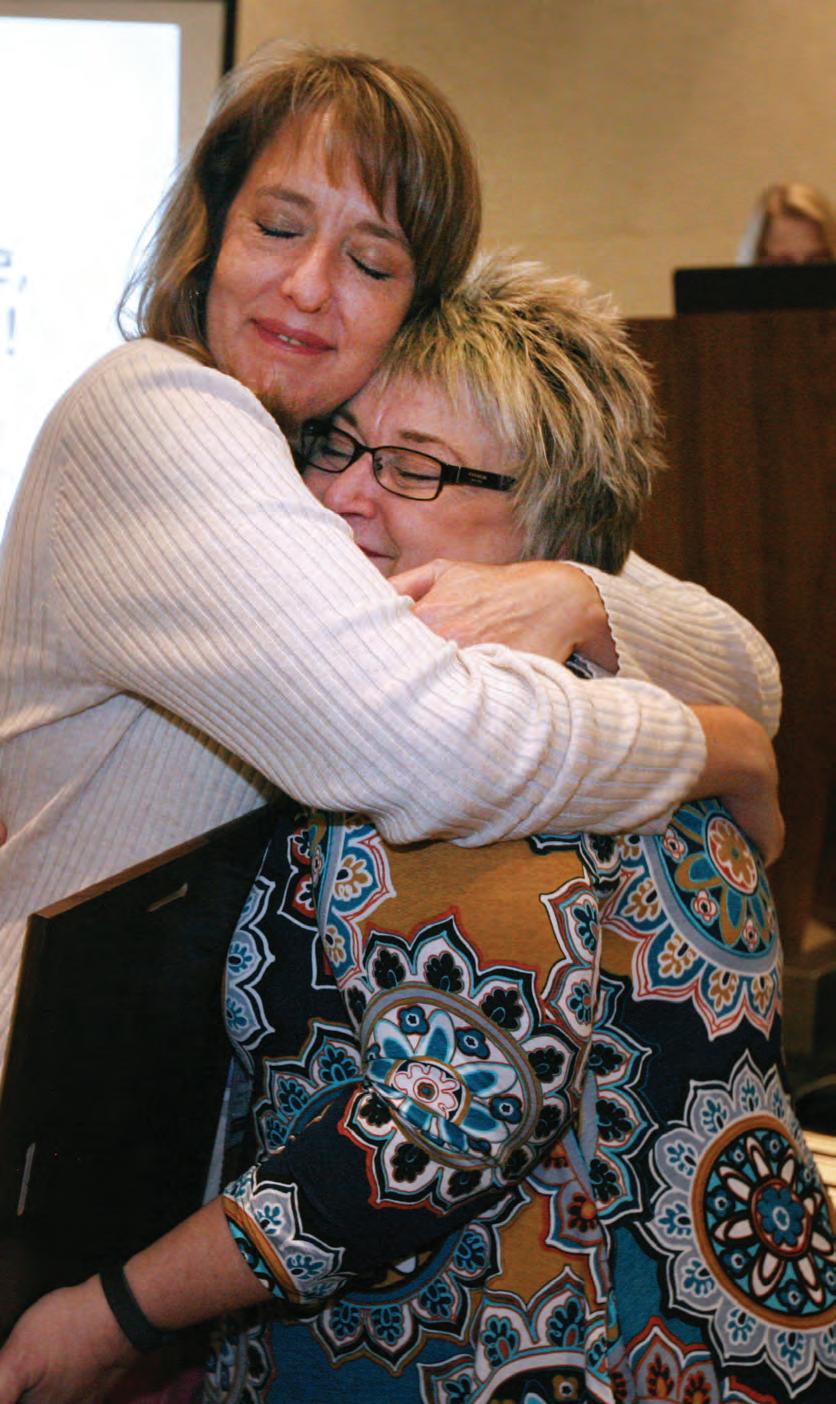
053 PROFILES // JEANNE ACTON
JEANNE ACTON, president of NSPA/ ACP board of directors; Elizabeth Smith, presidentelect and Chuck Clark, treasurer at spring 2021 executive board retreat.
AT THE PODIUM
NSPA/ACP executive director Laura Widmer, welcomes students and advisers to the ACP awards ceremony at the 2018 National College Media Convention at the Galt House in Louisville, Kentucky. Renewing the ACP partnership with the College Media Association, a group Widmer served as president from 1991-93, was a priority. ACP and CMA hosted separate convention in 2016, but reunited in 2017.
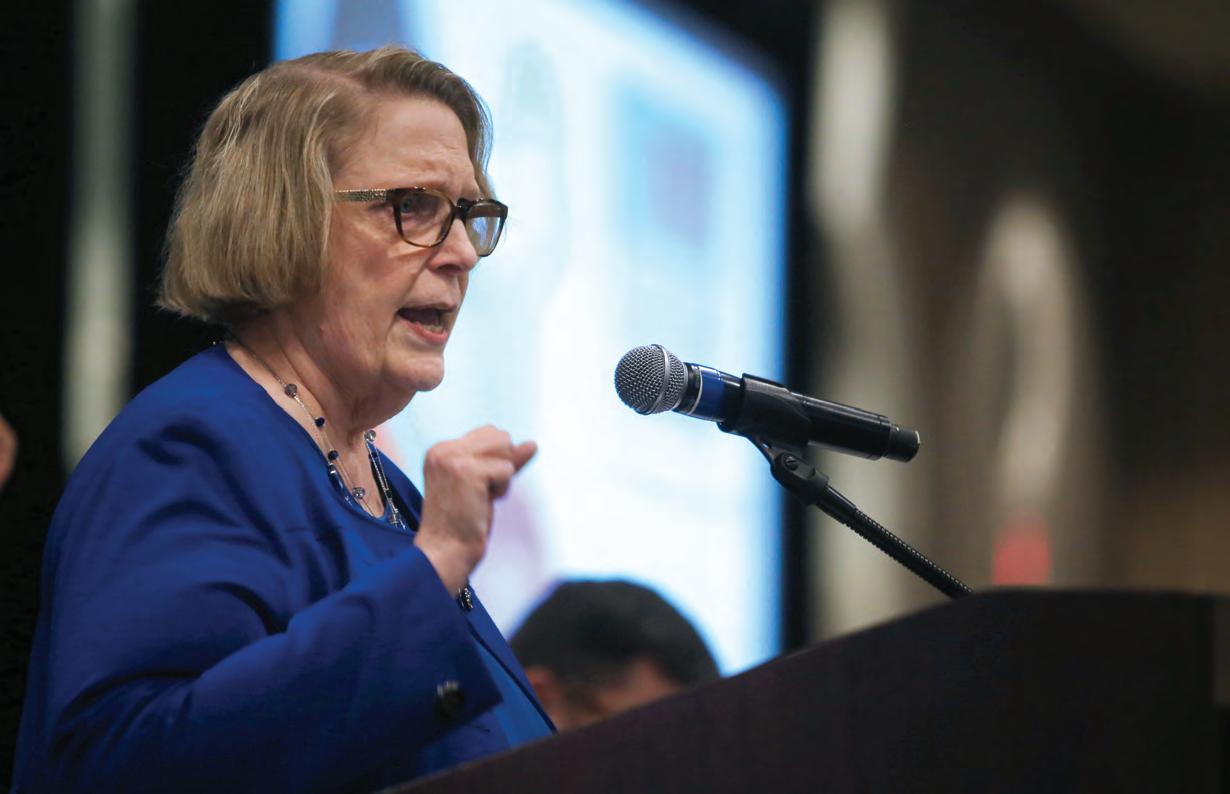
BEARCAT JOURNALISTS
Recognizing her eight years of service as a member of the board of directors, Laura Widmer, executive director, presents Ann Visser with a plaque at her last meeting. They became lifetime friends as staff members on the Tower at Northwest Missouri State University, home of the Bearcats. Their yearbook adviser was Linda Puntney.
DYNAMIC DUO
In 1977, a young Laura Widmer joined the Tower staff at Northwest Missouri State University. Nearly 50 years later, Linda Puntney, her yearbook adviser, remains a valued mentor and cherished friend. In 2016-17, Puntney served as JEA interim executive director at the same time Widmer was named NSPA executive director — providing a unique opportunity for the friends to work closely together again. As a final act, they brought down the house, or at least concluded the Seattle convention, with their famous journalism tune — “There’s no ism like journalism, like no ism I know.”
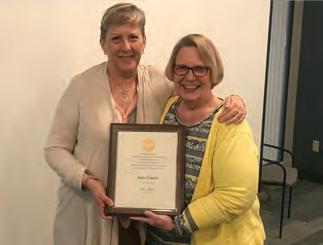
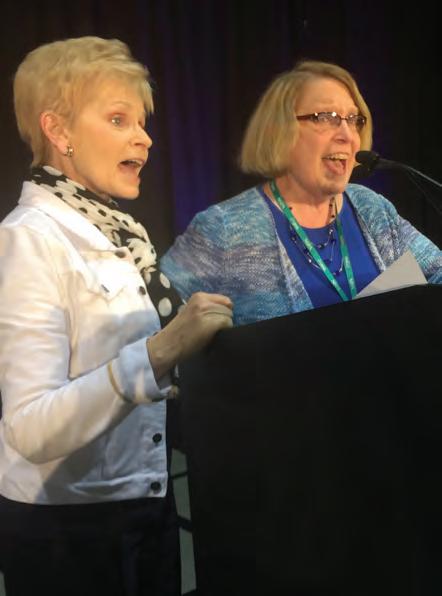
054 PROFILES // L AURA WIDMER
LAURA
Widmer
ACCOMPLISHED FORMER COLLEGIATE ADVISER GUIDES NSPA/ACP THROUGH ITS 100TH YEAR, UNPRECIDENTED PANDEMIC CHALLENGE.
IT WAS A MOVE THAT MADE SENSE.
In 2015, Laura Widmer became the associate director and then the executive director of the National Scholastic Press Association and Associated Collegiate Press.
“When I was a collegiate adviser, I always thought if I ever wanted to make a career change, NSPA/ACP would provide me the best of both worlds — scholastic journalism and teaching.
“I was right,” she said. “I love it.”
During the seven years she has been executive director, Widmer cites four areas as the organization’s biggest achievements —
Expanding the visibility of the organization, with a genuine interest in listening to members.
Extending resources available to members, including Pacemaker Master Classes and town hall meetings.
Updating Pacemaker judging and extending transparency.
Renewing the ACP partnership with the College Media Association, a group Widmer served as president, from 1991-93, when she was publications adviser at Northwest Missouri State University, Maryville.
Widmer brought a multitude of journalistic experiences with her to this position. She advised middle school and high school yearbooks and a high school newspaper, as well as collegiate magazine, online magazine, newspaper, online newspaper, yearbook and DVD yearbook. Additionally, she has owned her own newspaper.
“That gave me even more insight into the array of tools today’s journalists must possess,” she said
As production processes and delivery have changed over the years, Widmer has noted one constant.
“Good storytelling is still good storytelling. Technology has made research easier and faster. Sure, you may have additional ways to tell the story — audio, video, elaborate infographics and words, but it’s all about informing our readers and listeners,” she said.
Widmer has received numerous awards and recognitions, including NSPA’s Pioneer Award and induction into the Hall of Fame of CMA and of the Missouri College Media Association. She lists among her biggest personal achievements the team and advisory committees now in place leading NSPA/ACP.
Planning and implementing journalism conventions for both NSPA and ACP is a significant part of Widmer’s job as executive director. Her attendance at conventions has played a role in her convention management today.
“My first convention was in New Orleans in 1977. I learned traveling with friends can be so rewarding. We saw everything about New Orleans,” she said.
“My first convention as a high school adviser was in Kansas City in
1981. My first convention as a college adviser was in Chicago in 1983.”
As those conventions have continued to be a part of her life, Widmer has enjoyed the opportunity to connect with several prestigious and wellknown journalists of the time.
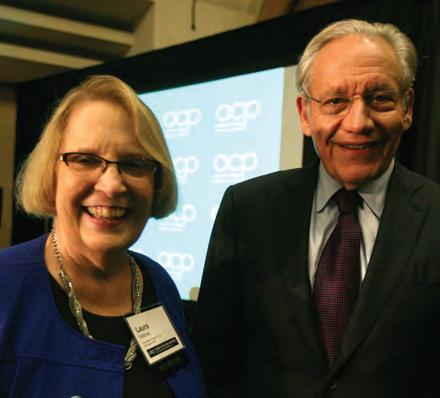
“At an ACP convention, Bob Woodward spoke to a standing-room only crowd. Afterwards, he spent two hours holding court with collegiate journalists. What an amazing opportunity for those students. He was so giving, and he was so impressed with the great conversations he had with them,” Widmer said.
While dealing with the COVID-19 and its effects on schools and journalism programs across the country, Widmer and her crew, along with the help of advisers from across the nation, have worked with convention partners Journalism Education Association and CMA to give staffs an online convention experience — and the components that have informed and inspired student journalists through the years.
Widmer noted those virtual conventions as the biggest challenge of her time as director.
As NSPA/ACP celebrates its 100th anniversary, Widmer gives credit to the organization’s past leaders.
“There have been many executive directors who were visionaries and transformed both organizations over the years,” Widmer said. “NSPA and ACP have evolved from awards organizations to true scholastic press organizations. We provide awards, education and additional services to our members.
“NSPA and ACP are the home of the Pacemaker. It’s the Pacemaker that gives us our identity. If you earned a Pacemaker, your media outlet is one of the best in the country.”
055 PROFILES // L AURA WIDMER
n
LAURA WIDMER, current NSPA/ACP executive director with Bob Woodward, a keynoter at the 2016 college convention in Washington, D.C.
TIMELINE
Looking back on 100 years of NSPA/ACP history, marked by ups and downs, and its impact on student media.
56 1921
It all started on April 22-23, when 126 editors and advisers from four states gathered in Madison, Wisconsin, launching the first national press association for scholastic and collegiate publications.
60 1927
Recognized as the top award in scholastic and collegiate journalism, the first “Pace-maker” is presented. Since then, 2,600 Pacemakers have been awarded by NSPA and 1,825 by ACP.
64 1941
Despite shortages, collegiate and scholastic newspapers produce special editions during World War II, some earning money for war bonds. Conventions are put on hold.
81 1988
In Hazelwood v. Kulmeier, the U.S. Supreme Court rules that schools may restrict what is published in student newspapers if the papers have not been established as a public forum. The impact is still felt today.
NSPA & ACP THROUGH THE DECADES
WISCONSIN ROOTS
Central Interscholastic Press Association, which would become National Scholastic Press Association, was organized by William Bleyer (front right), E. Marion Johnson (back right) and H.E. Birdsong (backcenter), all members of the journalism faculty at University of Wisconsin, photographed here in the Badger yearbook.
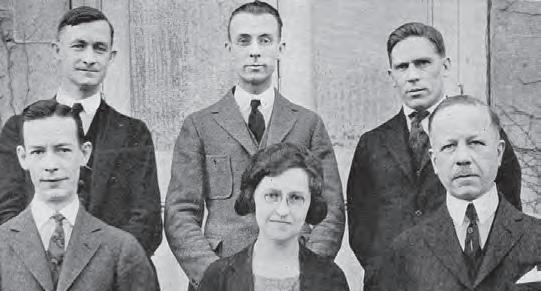
1921
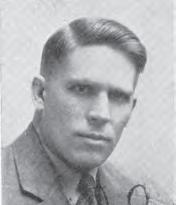
⊲ WORLDWIDE
1921 DeWitt Wallace founds Reader’s Digest magazine.
1922 Tutankhamun’s tomb is discovered in Egypt.
1924 George and Ira Gershwin compose “Fascinating Rhythm.”
1925 Crossword puzzles become popular.
1926 The Book-ofthe-Month Club enrolls 40,000 in the first year.
1927 Motion pictures synchronize audio and video in theaters.
1928 Walt Disney releases the first Mickey Mouse cartoon.
1929 The Stock Market crash ushers in the Great Depression.
34 SCHOOLS FROM FOUR STATES MEET
School publications experience rapid growth, a postWorld War I development.
On April 22-23, 126 editors and advisers, with 34 schools from four states, gathers in Madison, Wisconsin. Organized by William Bleyer, E. Marion Johnson and H.E. Birdsong at the University of Wisconsin, the meeting lays the foundation for Central Interscholastic Press Association — which would become National Scholastic Press Association
MAGAZINE BEGINS 60-YEAR RUN
Scholastic Editor, the first bulletin published in the United States focused on school journalism and journalists, outlines its guiding principles in the first issue.
“Among the membership of CIPA are a great many publications which are published by small high schools where journalism is not taught as a regular subject and for the editors of these papers and magazines we hope to give valuable summaries of some of the fundamentals of the profession.”
The founder, E. Marion Johnson, is active in its management until 1936. Its first edition offers nuggets of advice — Get names right.
Never betray a confidence, no matter how big the scoop.
Remember you can be both a gentleman and good reporter.
A hyphenated word at the end of the first deck of a headline is a sure sign of a careless editor.
1922
< NEW ORGANIZATION IS NAMED CIPA
A second meeting attracts twice the delegates and three times more schools. Organizational plans are completed, and delegates name the new organization the Central Interscholastic Press Association.
Professor E. Marion Johnson, of the University of Wisconsin, guides the organization, with assistance from other faculty members and journalism students. One of those students, Fred Kildow, would serve as the director and emeritus director for nearly 50 years.
1923
ALL-AMERICAN RATING BEGINS
The All-American critique designation is announced. From First Class-designated publications of each division, the judges select the outstanding publications as “the All-American class.”
FIRST EDITION
The inaugural edition of The Scholastic Editor was the association’s first effort to unify student journalists and journalism teachers across the nation. The typewritten, memographed publication noted for its humble start, it outlined plans for the 1922 contest, with advice as crucial then as it is today — “The time is very short. Mail your entries today.”
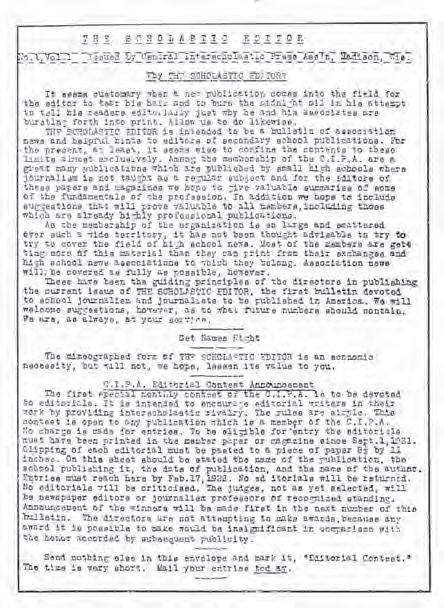
1924
MEMBERSHIP EXPANDS TO 45 STATES
“Association founded by 41 schools in 1921 now has 845 members in 45 states” proclaims the Scholastic Editor headline. CIPA membership grows from 63 in 1921.
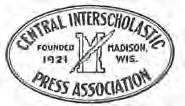
TIMELINE
058
// 1920s
E. MARION JOHNSON
AN UNCERTAIN FUTURE
E. Marion Johnson was appointed chair of the University of Minnesota journalism department and moves to Minneapolis. At the same are no conventions or contests offered in 1926-27. As a result, members had a lot of questions about the organization’s future. A piece by Johnson in the November, 1926, Scholastic Editor acknowledges the questions, but offers few answers. “It will only be a short time before several announcements of real interest to everyone of our readers and the school world in general, will be made,” he said. Ultimately, the organization was renamed the National Scholastic Press Asssociation with its headquarters at the University of Minnesota.

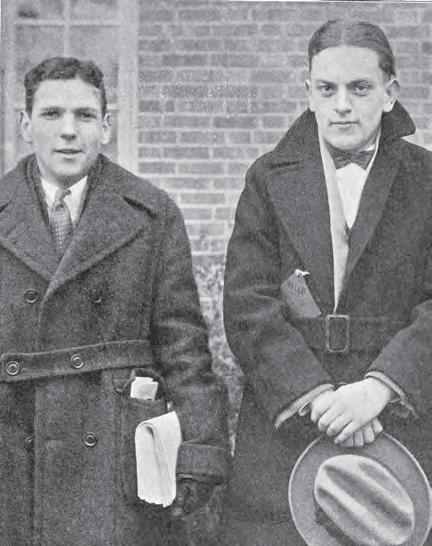
1924 CONVENTION
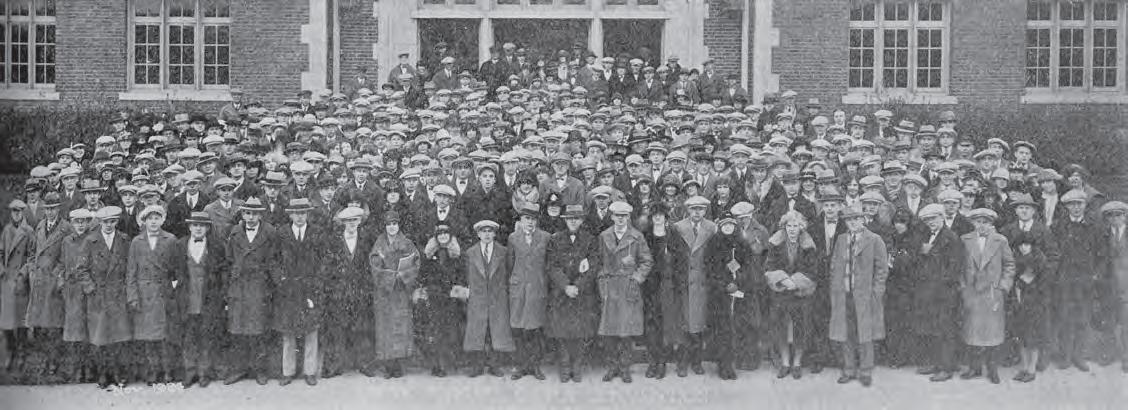
Approximately 885 delegates, representing 307 publications from 198 schools, gathered in Madison, Wisconsin for the fifth annual convention.
The East was represented by Robert Quick, Newton High School, Newtonville, Massachusetts and the West by Charles Mann, Stadium High School, Tacoma, Washington.
For $1.75, delegates purchased a coupon book that provided admission to convention features including the convention banquet, “vodvil” performances, a carnival ball, “publication criticism” and convention exposition.
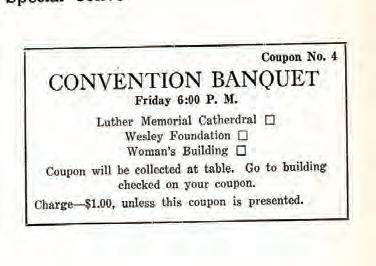

TIMELINE
059
// 1920s
“PACE-MAKER” PAPERS
Four scholastic newspapers tied in the All-American contest in 1927 and earned the “Pace-maker” award.

The Southerner, South High School, Minneapolis
South Side Times, South Side High School, Fort Wayne, Indiana
The Red and Black, East Salt Lake City (Utah) High School
Central High News, Central High School, Minneapolis
TOP PRIZE
Recognized as the top award in scholastic and collegiate journalism, the “Pace-maker” was awarded for the first time in 1927 to The Quest magazine from Central High School, Minneapolis. Director E. Marion Johnson presents the silver loving cup to editors Richard Moran and Eleanor Fowler. The top All-American winners were awarded Pacemaker status.
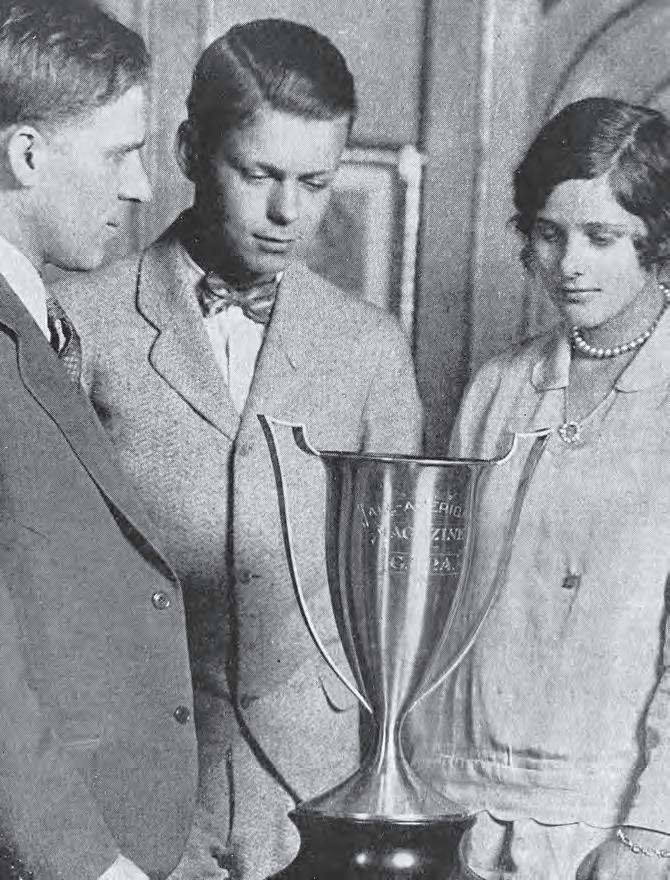
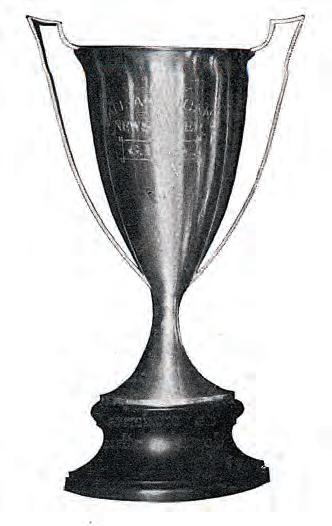
060 TIMELINE // 1920s
NSPA & ACP THROUGH THE DECADES
< ADVISER ORGANIZATION CONVENES
Rowena Harvey, South Side High School, Fort Wayne, Indiana, proposes a national association of high school journalism directors, and the American Association of High School Teachers of Journalistic Writing convenes its first meeting at the sixth CIPA convention.
In 1930, it becomes the National Association of Journalism Advisers, and, in 1935, it becomes the National Association of Journalism Directors. In 1963, 38 years later, it becomes Journalism Education Association.
1925

418 YEARBOOKS JUDGED
Approximately 418 yearbooks are judged in the fifth All-American Yearbook contest. The top five collegiate and scholastic yearbooks competed for the All-American cup, and winners were the Savitar, University of Missouri, and the Totem, South Side High School, Fort Wayne, Indiana.
EUROPEAN JOURNALISM TOUR
A full-page ad in Scholastic Editor promotes the European Journalism Tour. Described as a “purposeful 45day tour,” it features “fast ships that insure members of the tour the maximum of time in Europe.” The cost of the tour ranges from $465 to $520 and includes an Editing of School Publications course. E. Marion Johnson conducts tours.
1926
SOUTH SIDE TIMES SETS THE PACE
For the second time in three years, The South Side Times newspaper, advised by Rowena Harvey, earns the All-American Cup and establishes itself as one of the best scholastic newspapers of the era.
< QUILL & SCROLL FOUNDED IN IOWA
At the University of Iowa, George H. Gallup Sr. founds Quill and Scroll, which would grow into an international honorary. Gallup was also one of the original judges of the NSPA “Pace-maker” competition.

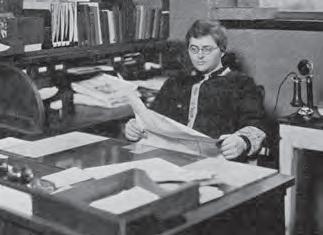
In July 2022, Quill and Scroll merges with NSPA.
MAGAZINE MOVES TO MINNEAPOLIS
Scholastic Editor moves to Minneapolis “in order that it may continue under the editorship of E. Marion Johnson, who has been appointed chairman of the University of Minnesota Department of Journalism.” The magazine moves to Folwell Hall, then home of the journalism department.
As questions increase about CIPA’s future, the magazine promises “several announcements of real interest to everyone of our readers and the school world in general.” The association does not function during the 1926-27 school year
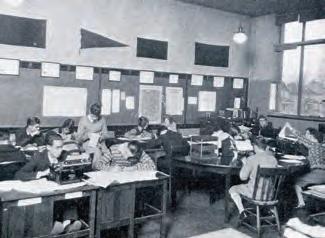
1927
FIRST PACEMAKERS PRESENTED
The Pacemaker awards are presented for the first time. They are recognized as the top prizes in scholastic and collegiate journalism.
“The designation of Pace-Maker is a very appropriate one in the spirited race of newspapers, magazines and annuals for the highest honors,” Scholastic Editor reports. Gallup H. Gallup judges the competition, and the Pace-Maker is awarded a “silver loving cup.”
THE SOUTH SIDE TIMES and the journalism program at South Side High School, Fort Wayne, Indiana, was an early pioneer in scholastic journalism. (top) The cover of the February, 1924, Scholastic Editor magazine showcases The South Side Times. (center) Adviser Rowena Harvey sit at her desk complete with a telephone. (bottom) The South Side Times editorial staff works at individual desks and a circular copy desk modeled after professional newsrooms. 061
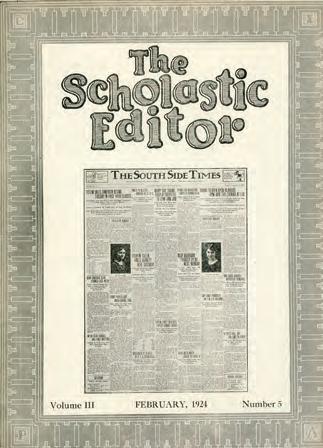 ROWENA HARVEY
ROWENA HARVEY
TIMELINE
// 1920s
GEORGE H. GALLUP
⊲ EARLY INNOVATOR
DYNAMIC DUO
“Director Fred Kildow, an assistant professor of journalism who, with his splendid background and long period of work with the group, is admirably fitted to direct its destinies,” Scholastic Editor magazine reports in 1936. Lucille Kildow, his wife, serves as assistant director. The dynamic husband-and-wife team are “in a student-made flash photo” at the 1936 NSPA Detroit convention.

NSPA & ACP THROUGH THE DECADES
1928
< CIPA BECOMES NSPA; KILDOW HIRED
The organization is renamed the National Scholastic Press Association, and it moves to the University of Minnesota and Pillsbury Hall, the journalism department’s new home. Membership dues range from $2.50 to $3.50 per year for high school publications, depending on school enrollment. A contest entry and publication critique are included in the dues.
A new NSPA insignia is provided to charter members. Charter members are also invited to vote on the constitution “when it’s drawn up.” E. Maron Johnson hires Fred Kildow to serve on the journalism faculty and manage NSPA.
1929
CONVENTION SHIFTS TO SPRING
NSPA hosts its first spring convention, attracting 750 delegates from 21 states to Minneapolis. But conventions return to the fall, with no spring convention until 1970.
1930

< SANDBURG KEYNOTES CONVENTION
Carl Sandburg, American poet, biographer, journalist and editor, headlines the 1930 convention, attended by 1,300 student journalists in Cleveland. “It was a keen convention!” the Scholastic Editor headline says.
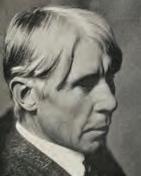
NSPA DIRECTOR WARNS AGAINST FRAUD
Fred Kildow warns members that the organization “National Scholastic Publications Contests,” at 109. N. Wabash, Chicago, is not affiliated with NSPA.
“Before you join some other group, find out who is behind it, find out if it is run for the benefit of scholastic publications or personal profit, find out how old it is, and if it is recognized by any great educational institution,” Kildow said.
1931
⊲ WORLDWIDE
1930 Worldwide depression gives rise to political extremism.

1931 New York City’s Empire State and Chrysler buildings are completed.
1932 Franklin Delano Roosevelt becomes president amid bank panics.
“LET’S GET TOGETHER” WITH CSPA
With the headline “Let’s Get Together,” the editor of Scholastic Editor magazine suggests combining NSPA and Columbia Scholastic Press Association and proposes two conventions, a fall meeting in the west and a spring gathering in New York City.
“We’re pretty sure the NSPA is open-minded on this subject. Not a merger — but a combination — for more honor and glory for both.”
The idea was never mentioned again in the magazine and the two organizations enjoy a friendly relationship for a century.
OFFICIAL DELEGATE
Students and advisers attending the 1935 convention in Milwaukee, Wisconsin wore buttons for admission to events. The name and city of each delegate was painstakingly handwritten.
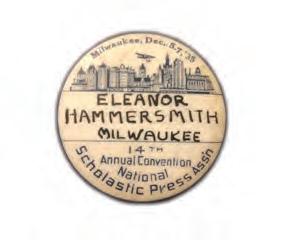
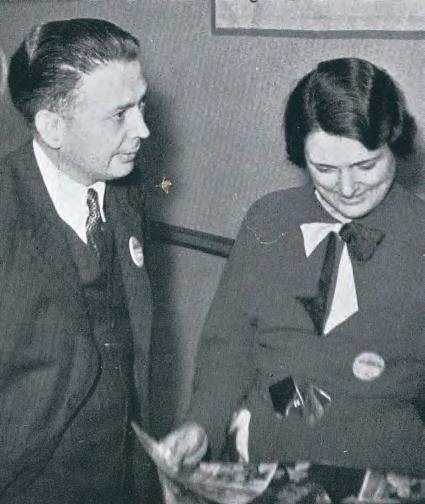
1933 FDR declares a bank holiday in his first “fireside chat.”
1934 Hitler seizes power and names himself German Fuhrer.
PALMER HOUSE HOSTS CONVENTIONS
Chicago’s Palmer House begins its long association with NSPA and ACP as the 1931 NSPA convention site. The hotel opened in 1871 and fell victim to the Great Chicago Fire only 13 days after its grand opening. It was rebuilt and “became the foremost gathering place for social and business life in the middle-west.” Mark Twain was often a guest, Scholastic Editor reports.
FRED KILDOW
062 TIMELINE
1930s
CARL SANDBURG
// 1920s,
DETROIT BANQUET
“For nearly three hours, Mr. and Mrs. Henry Ford look on approvingly from their balcony table,” as 1,726 students and their advisers from 25 states sat in the Grand Ballroom and Crystal Room at the “swank” Book-Cadillac Hotel in Detroit for a seven-course feast during the 1936 NSPA Detroit convention,” Scholastic Editor magazine reports. Ford’s bodyguards did not allow autographs and photos.
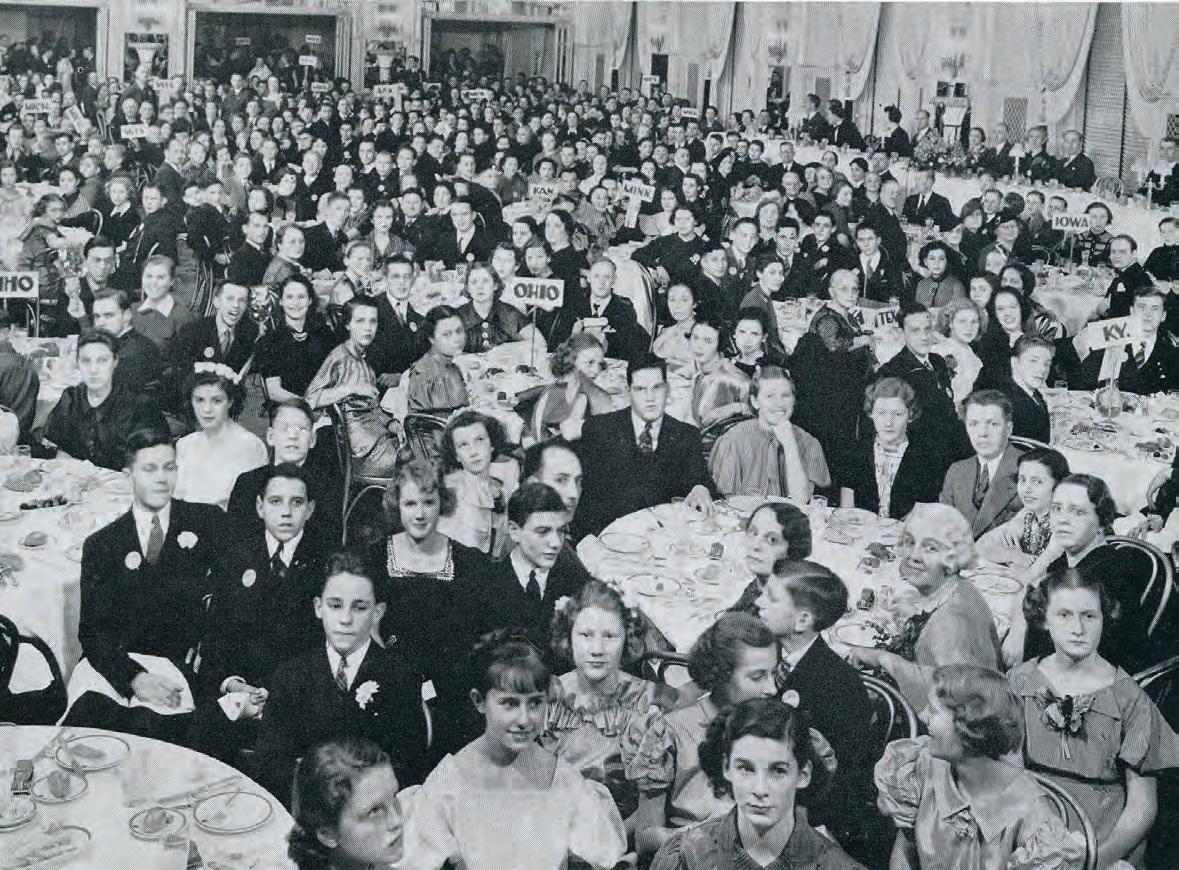
CORN LEIS
Eighteen Iowa schools made souvenir corn leis for distribution to the delegates at the Des Moines, Iowa convention mixer including staff members of the Cub Gazette, Mason City: Ida Learner, Virginia Farmakis, John Monger, Majory Barton and Eileen Payne. Elizabeth Graves, IHPA president, is their adviser.
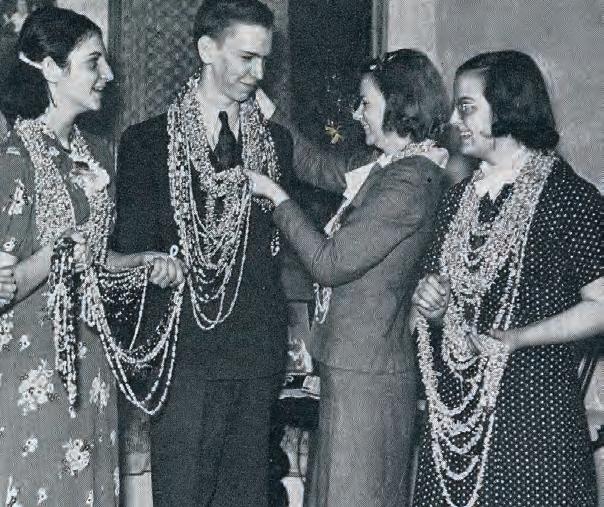
TIMELINE // 1920s, 1930s
063
LARGER THAN LIFE
“The editor of the Villanova College undergraduate publication studies “Life” magazine for new ideas on picture-story treatment,” says Scholastic Editor magazine.
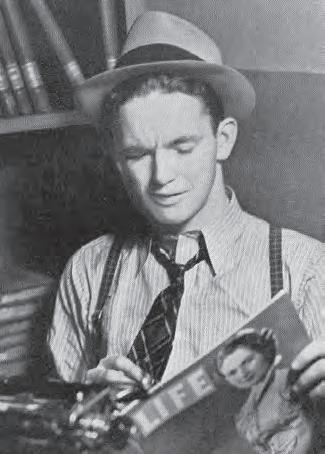
⊲ CONVENTION SCENE
THE COGWHEEL CREW
Meet the staff executives of Pacemaker paper The Cogwheel, Mechanic Arts High, St. Paul, Minnesota — Front row: Myra Foss, associate editor; Herbert Arnesen, editor-in-chief; and Patricia Bork, associate editor. Back row: Robert Baker, sports editor; Robert Cleland, managing editor; and Irving Kreidberg, associate editor. Their adviser was Mary E. Copley, and their hobbies were listed as typography, make-up and staff responsibility.

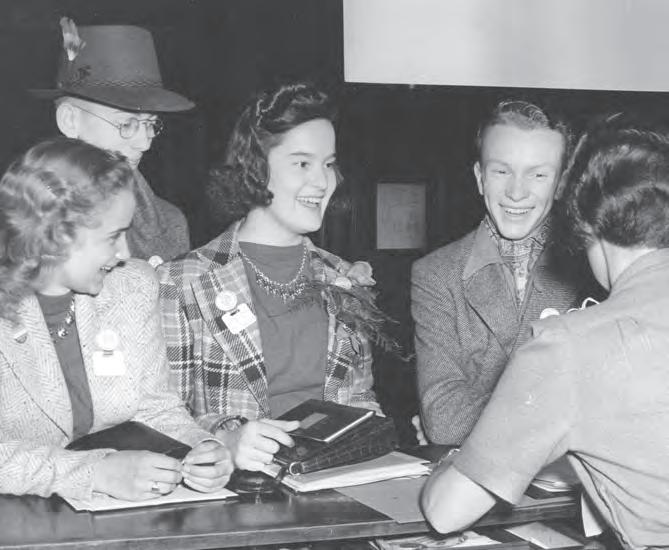
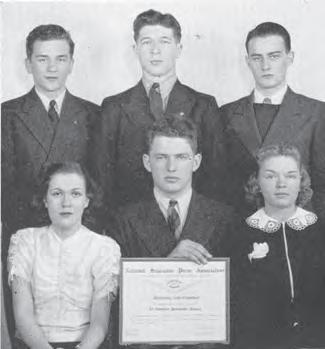
ATTENDANCE
reaches an all-time high in the fall of 1939 with a total of 3,270 delegates. In Chicago, NSPA attracts 2,720 and ACP drew 550 to Des Moines, Iowa. (top) In Chicago, delegates register and pick-up their programs and nametags. (bottom) Exhibits include a popular Scholastic Editor magazine booth.
064 TIMELINE // 1930s, 1940s
NSPA & ACP THROUGH THE DECADES
⊲ WORLDWIDE
1935 Italy invades
Ethiopia, and Germany builds its military.
1936 Margaret Mitchell publishes “Gone With the Wind.”
1937 Disney releases “Snow White,” its first featurelength cartoon.
1938 Chester Carlson produces the first xerographic copy.

1939 Germany invades Poland and launches World War II.
1940 Germany invades Denmark, Norway and Holland.
1941 Japan attacks Pearl Harbor, and the U.S. declares war.
1942 Nazis begin the systematic murder of Jews in gas chambers.
1943 Germany’s Sixth Army surrenders to the Russians.
1944 U.S .troops are on every front, and the Allies launch D-Day.
1945 U.S. atomic bombs obliterate Hiroshima and Nagasaki, Japan.
1947 Jackie Robinson breaks the color barrier in Major League Baseball.
1949 George Orwell publishes “1984.”
1932
YEARBOOKS BECOME A BIG BUSINESS
Scholastic Editor advertisements reflect a highly competitive yearbook industry, with more than eight companies competing for business. At the time, schools contracted with engravers, printers and cover manufacturers rather than a single company that handled all aspects of yearbook production, thus making project and business management more complex.
1933
ASSOCIATED COLLEGIATE PRESS FORMED
Responding to strong interest from collegiate advisers for a separate organization, director Fred Kildow leads the formation of Associated College Press as a division of NSPA, and ACP quickly parallels NSPA in services. In February 1933, ACP has more than 150 member institutions, and NSPA reports 2,000 members.
1934
THE PIC: INNOVATIVE NEWSPAPER INSERT
The Pic, an eight-page supplement for the high school newspapers and magazines, is heralded as an innovation in high school journalism. Conceived by NSPA, the publication is available without cost for distribution by high schools with their regular issues.
KEYS MARK 15TH NSPA ANNIVERSARY
To mark its 15th birthday, NSPA presents gold service keys and pins to faculty advisers who had served 15 years. Eight of 52 recipients were present at the Milwaukee convention. Also honored are George Greene, one of the organization’s founders as a University of Wisconsin student Wisconsin, and Grant Hyde, director of the Wisconsin journalism school.
1940
NEW OFFICES MEET LONG-TERM NEEDS
NSPA/ACP relocates from Pillsbury Hall to five groundfloor rooms in William J. Murphy Hall, the new $275,000 journalism building at the University of Minnesota.
1941
WAR CANCELS NSPA CONVENTIONS
War put high school conventions on hold from 194145. Scholastic Editor publishes articles on how high schools and colleges could continue publication in spite of wartime shortages, and encouraged scholastic journalism to continue, as it aided national morale and fought Nazi propaganda.
“This is your invitation to attend NSPA’s war-time convention — to be held within the pages of the Scholastic Editor’s December Convention Issue,” the magazine announced. “Until peace comes, national high school meetings are suspended, so instead of going to convention, let convention come to you. It’s complete with round table discussions, and helpful ‘talks’ on your current journalism problems.”
ACP continues to meet. At the 1941 convention in St. Louis, Missouri, a panel discussion is offered — “Shall College Students be Drafted?” The discussion was broadcast over CBS radio from station KMOX.
FROM THE PRESIDENT
A highlight of the NSPA 1939 banquet in Chicago was the reading of a congratulatory wire from President Franklin Roosevelt by director Fred Kildow. “It gives me great pleasure to send cordial greetings to all those who attend the eighteenth annual convention of the National Scholastic Press Association with best wishes for a successful meeting and one which will promote the highest interests of scholastic journalism,” Roosevelt said.
SUITE SURPRISE
Frank Wirth and William Moran, convention delegates from Harlan, Iowa, found they had no reservations upon arrival at the 1938 NSPA Des Moines convention. Remembering that Iowa Gov. Nelson Kraschel came from Harlan, they phoned him and were welcomed by his wife, Alice, in the governor’s hotel suite.
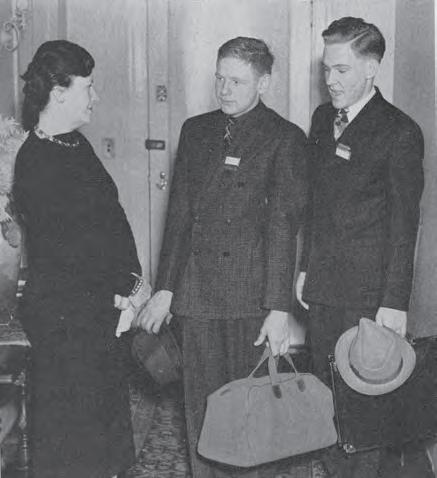
065 TIMELINE // 1930s, 1940s
WHEN THE NEW $275,000 University of Minnesota journalism building opens in 1940, NSPA/ACP moves from Pillsbury Hall to five ground-floor rooms in William J. Murphy Hall “We’re proud of our new quarters because they’re up-to-the-minute as the spirit which animates the members of NSPA,” director Fred Kildow said. “Our new offices are designed with us — with our future needs specifically in mind.” Murphy Hall houses the organizations until 1974.
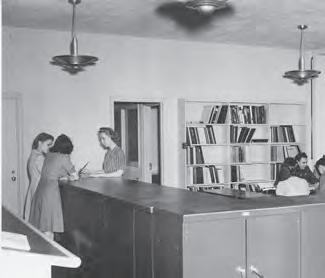
“LADIES OF THE STUDENT PRESS”
Sexist by current standards, a 1941 Scholastic Editor page features “Ladies of the Student Press” with the subheadline “picture proof of lovely feminine charm that brightens six publications offices.” The page presents photos of girls working on publications.
1943
< NSPA WELCOMES “YOUNG EXECUTIVE”
After serving as assistant director for 15 years, Lucille Kildow steps down.
Glenn Hanson, 22, becomes assistant director and the organization’s youngest executive. Kildow continues as an adviser.
Hanson, a University of Minnesota graduate, was active in scholastic journalism since he was a student at Central High School, St. Paul, Minnesota, where he was art editor of the literary arts magazine and editor of the yearbook and weekly newspaper.
After leaving NSPA, Hanson was an associate professor of journalism at the University of Illinois, Urbana and continued to contribute to association publications including editing “The Now Look in Yearbooks,” a highly popular guidebook published by NSPA in 1971.
1945
KILDOW TAKES LEAVE TO TEACH ABROAD
Director Fred Kildow obtains a one-year leave of absence to teach journalism at the Army’s University Center No. 1, Shirenham, England. Lucile Kildow serves as acting director.
1946
< QUALE BECOMES ASSISTANT DIRECTOR
A 28-year-old journalist just returned from the Army, Otto Quale is named the assistant director. In 1949 he was also named executive secretary of the Minnesota High School Press Association. Quale leaves in 1950 to manage Jostens yearbook division, then called American Yearbook Co., and he returns in 1968 as NSPA/ACP director.

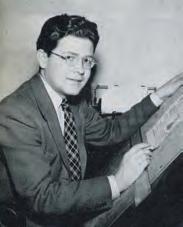
1947
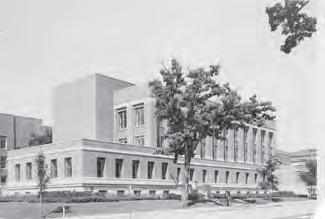
< NSPA UNVAILS MODERN EMBLEM
Modern in spirit and clean-cut in design, the newly adopted NSPA emblem represents a sharp break from the old insignia which has been used for more than two decades, reports Scholastic Editor magazine. Members received the insignia to display in their 1946-47 publications.
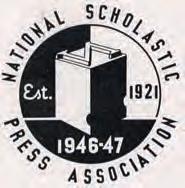
The drawing of a piece of type is symbolic of journalism. The “N” is in 48-point Caslon. The design and lettering are executed with sharp contrasts of lights and darks to harmonize with the spirit of modern typography.
SHORTAGES THREATEN YEARBOOKS
A post-war boom for printed materials threatens the timely production of 1947 yearbooks. Paper mills, engravers, printers and cover manufacturers can’t keep up with demand

⊲ HOME SWEET HOME
GLENN HANSON
066 TIMELINE // 1940s
NSPA & ACP THROUGH THE DECADES
OTTO QUALE
⊲ WITH LOVE FROM JEFFERSON HIGH
LEARNING FROM THE PROS
Journalism students from Polytechnic High School, Los Angeles, study metropolitan newspapers to keep abreast with the times. They relate war news to their school environment, Scholastic Editor reports.

HOSPITAL WITH A HEART, Margaret Ethel West Weaver writes in Scholastic Editor magazine —“The Monticello yearbook, Thomas Jefferson High School, San Antonio, actually went to war one full year before Pearl Harbor, and it’s staying in this war until the very moment of final victory.” For several consecutive years, the yearbook’s theme focuses on war and service. The 1944 theme, “Hospital With a Heart,” engages the student body as the yearbook staff encourages student groups to visit wounded veterans at nearby Brooke Army Medical Center. From music in the surgical ward, to delivering gifts and valentines, the yearbook captures the visits in photos.

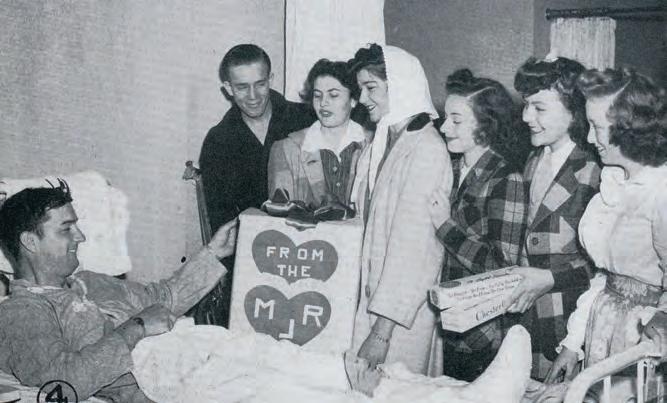
CURRENT EVENTS
Servicemen stationed on the Northwestern University campus, Evanston, Illinois, enjoy reading the Daily Northwestern, student newspaper. Daily Northwestern editors make it a policy to produce content of interest to all reader groups.
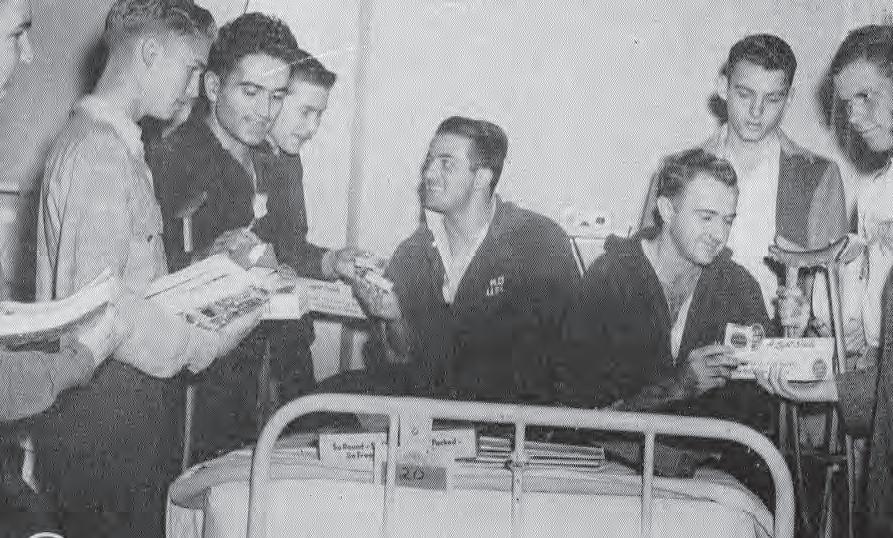
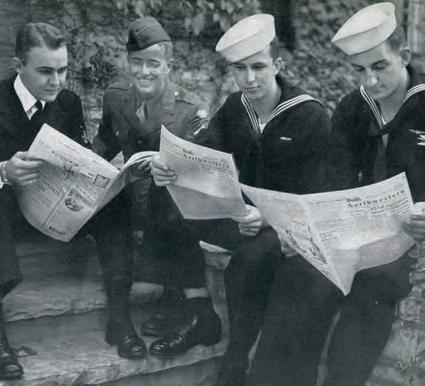
067 TIMELINE // 1940s
FRONT-PAGE NEWS — The South Dakota Collegian published a “Special Invasion Issue” reporting on D-Day and its importance to South Dakota State College, Brookings, students. Comprehensive coverage of the end of the war was published in a special “Victory” edition of The Cougar, University of Houston.
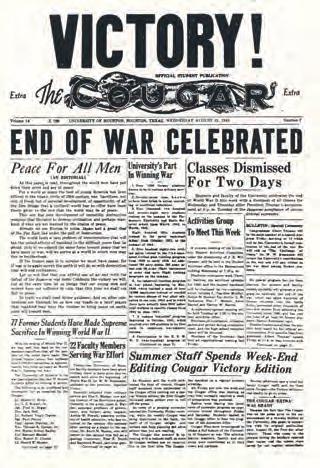
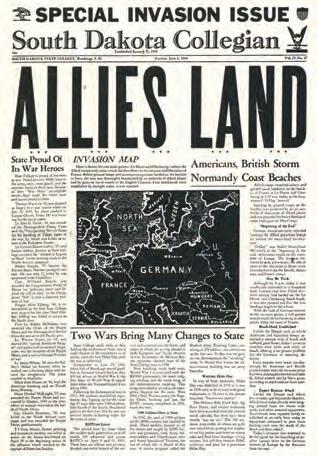
NSPA & ACP THROUGH THE DECADES
< YEARBOOK EXPERT ON RADIO
Yearbook expert C.J. “Chief” Medlin, Kansas State College, now Kansas Sate University, Royal Purple adviser, discusses high school yearbook publishing in five broadcasts over AM radio station KSAC.
ADVISER SHORT COURSE A SUCCESS
Approximately 95 advisers from 22 states attend the first short course for advisers held at the University of Minnesota and hosted by the Minnesota School of Journalism, the National Association of Journalism Directors (now JEA) and NSPA. The short course offered an intensive week of instruction for both newspaper and yearbook advisers.
A second adviser short course was held in Minnesota in 1949, but did not attract as many participants. By the early 1950s, adviser courses were being offered at existing journalism workshops across the country, offering training closer to home.
1951
< TOWLEY NAMED ASSISTANT DIRECTOR
Carl Towley, Hopkins High School (Minnesota) journalism teacher, is named assistant director of the organization and editor of Scholastic Editor, after the departure of Otto Quale.
In 1952, Towley resigns as assistant director and returns to Hopkins High School, while he continues as editor of Scholastic Editor and works at NSPA during summers.
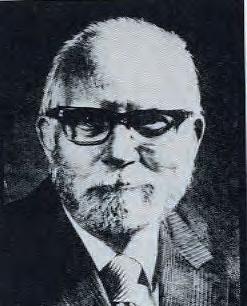
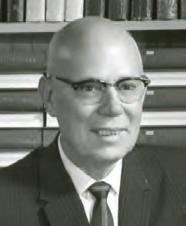
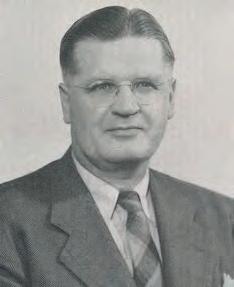
In 1954, the National Association of Journalism Directors (now JEA) then housed with NSPA/ACP, hires Towley as executive secretary, a part-time position.
Towley suffers a fatal heart attack at school shortly after learning his yearbook staff dedicated the 1959 yearbook to him. He dies on May 18, 1959, at age 53.
1953
< SANDERSON JOINS NSPA/ACP
Arthur “Sandy” Sanderson is named assistant director NSPA/ACP. “In my planning of the ACP convention, one of the first things that came to mind was to schedule special sessions exclusively for the advisers,” Sanderson wrote in a history of the College Media Association published in 1994. “At our 1954 Washington D.C. convention, some of us got the idea of forming an (adviser) association and laid the groundwork.”
FALL CONVENTION SHIFTS TO AUGUST
Instead of a Thanksgiving-weekend convention, NSPA convenes a late August convention, Aug. 26-28 at the University of Minnesota.
“A summer meeting is certainly an adventure into the unknown for NSPA and its members,” director Fred Kildow writes in a letter to advisers. “Your delegates will be able to use all they learn at the conference all year, instead of only part of a year as in the past.”
The annual summer conference continues through 1960. It was on campus at the University of Minnesota (1953, 1954) and the University of Michigan (1956), as well as hotels in Chicago (1955, 1957, 1960) and Washington, D.C. (1959).
In addition to its traditional fall conference in Chicago, ACP offers a sectional meeting in Los Angeles for West Coast colleges and universities.
⊲ HOT OFF THE PRESS
068 TIMELINE // 1940s, 1950s
CARL TOWLEY
C.J. “CHIEF” MEDLIN
ARTHUR “SANDY” SANDERSON
HIGH SCHOOL NEWSPAPERS provided war coverage and published special editions. (top) At Garfield High School, Seattle, Washington, the Messenger demonstrated the power of the press by publishing a War Bond Extra that helped the school raise $15,943 more than its $150,00 quota. (left) The Totem staff, Lincoln High School, Seattle, Washington, assembles its special 20-page Service Roster issue containing the name, rank, branch of service and date of graduation of all alumni serving in the armed forces.
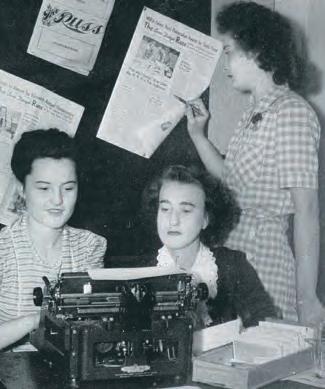
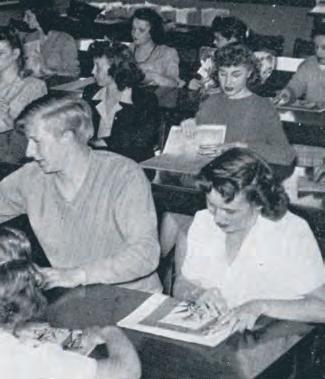
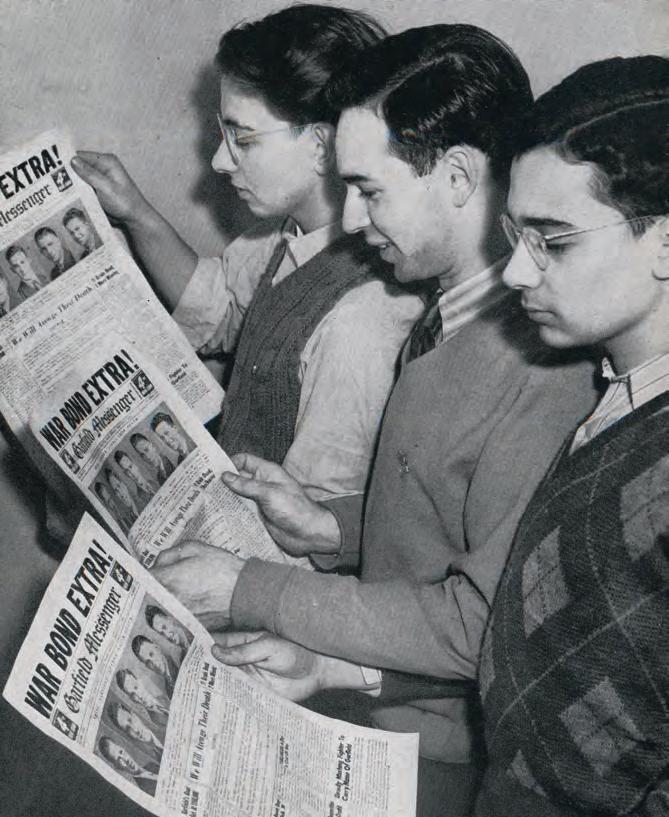
EDITORIAL LEADERSHIP
With the next deadline quickly approaching, the editors of The Russ, San Diego High School, consult the previous edition of the award-winning newspaper as they brainstorm timely story assignments for the present issue.
ADVISER SHORT
COURSE
NSPA director Fred Kildow (center) prepares to award diplomas. Advisers from across the nation attended the course sponsored by NSPA, the University of Minnesota and the National Association of Journalism Directors. Instructors included Edna Gercken, Albert Lea High School (Minnesota); Thomas Barnhart, University of Minnesota; Otto Quale, assistant NSPA director; Maude Staudenmayer, NAJD president; A. L. Terlouw, Eastman Kodak Co.; Carl Towley, Hopkins High School (Minnesota); Dolores Merchant, editor of Scholastic Editor and C.J. Medlin, graduate manager of publications, Kansas State College.
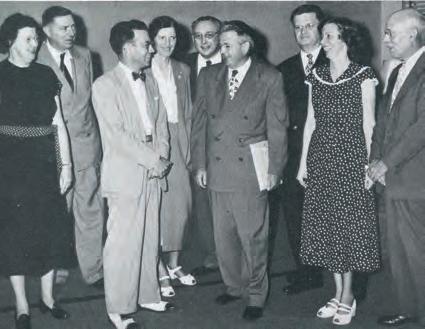
069 TIMELINE // 1940s, 1950s ⊲ WAR BOND EXTRA!
“A SEAMAN SENDS FOR A YEARBOOK”

NEWS FROM HOME was a precious commodity and the May, 1944, edition of Scholastic Editor magazine includes a letter from Darwin Shoop, seaman second class at Farragut, Idaho. Scholastic Editor contacted Shoop after he wired a money order to Topeka High School (Kansas) eager to receive a copy of the 1944 Sunflower yearbook from his alma mater.

070 TIMELINE // 1950s
⊲
NSPA & ACP THROUGH THE DECADES
⊲ WORLDWIDE
1950 Cartoonist Charles Schulz introduces “Peanuts” and Charlie Brown.
1951 United Nations forces re-take Seoul from North Korean forces.
1952 2,000+ new TV stations open, with 65 million watching.
1953 A demilitarized zone divides North and South Korea.
1954 Jonas Salk develops the injectable vaccine for polio.
1955 Jim Henson creates Kermit the Frog, the first of the Muppets.
1956 Elvis Presley goes national with “Heartbreak Hotel.”
1957 The Soviets launch two Sputnik satellites and scare the U.S.
1959 Alaska and Hawaii become the 49th and 50th states.
1954
ADVISERS LIKE AUGUST CONFERENCE
The 1953 NSPA summer conference was a success, according to survey results in Scholastic Editor.
The advisers show strong support for a summer meeting, preferably the campus location rather than a hotel, and they praised the meals and rooms. The summer conference returns to the University of Minnesota campus for a second year.
1955
COLLEGIATE ADVISER GROUP FORMED
At the Detroit ACP conference, about 50 collegiate advisers form the National Council of College Publications Advisers
NCCPA headquarters is in the University of Minnesota journalism building with NSPA/ACP, NAJD and MHSPA. Arthur M. “Sandy” Sanderson, ACP/NSPA assistant director, serves as the first NCCPA executive secretary-treasurer.
In 1956, NCCPA moves to the University of Iowa for the next 10 years.
NCCPA becomes College Media Advisers in 1984 and then College Media Association in 2011.
1956
NSPA RECOGNIZES ADVISERS
An NSPA Advisers Honor Roll is established to recognize student publication advisers and journalism teachers with at least 20 years of experience
1957
NEARLY 4,000 MEMBERS IN 36TH YEAR
As NSPA completes its 36th year, Scholastic Editor reports the association serves nearly 4,000 publications in the U.S. and Canada.
1958
NSPA CANCELS 1958 CONFERENCE
The 1958 NSPA conference is postponed until 1959. Director Fred Kildow said that conference planning suffered because of the demands of providing essential services.
“Unless NSPA can provide an outstanding conference, we will not hold one,” Kildow told members in a letter.
1959
< NSPA PUBLISHES NEWSPAPER INSERT
NSPA signs an agreement to distribute the magazine Scholastic Roto to high schools across the nation for insertion into student newspapers. At this point, the financially lucrative magazine inserts had been published for 20 years. The magazine insert is renamed Scholastic Scene and continues until 1969.
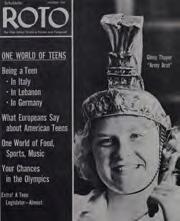
COURIER INTERVIEW
Interviewing is an important part of a Courier staff member’s training at Normandy High School, St. Louis, Missouri. Student reporter Don Peet interviews actress Gene Tierney, best known for her role in Laura, who visited the high school to promote the Fourth War Loan drive.

YEARBOOKS ON THE RUNWAY
Among promotion plans used by the 1950 Gopher, yearbook of the University of Minnesota, Minneapolis, is the staging of a campus fashion show.
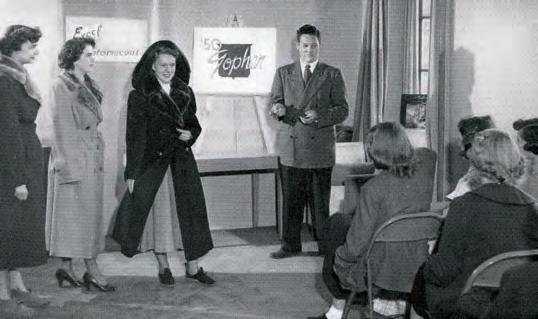
071 TIMELINE // 1950s
SCHOLASTIC ROTO
NSPA & ACP THROUGH THE DECADES
WORLDWIDE
1962 U.S. troops in Vietnam are ordered to fire if fired upon.
1963 President John F. Kennedy is assassinated Nov. 22 in Dallas.
1966 U.S. escalates its military presence in Vietnam.
1967 Thurgood Marshall is sworn in to the U.S. Supreme Court.
1968 The U.S. and North Vietnam conduct peace talks in Paris.
1969 The Supreme Court’s decision in Tinker v. Des Moines Independent School District establishes 20 years of student speech and press rights.
1960
NSPA CELEBRATES 40TH YEAR
“Life begins at 40” notes Scholastic Editor on the 40th year of NSPA.
The magazine reports that NSPA serves nearly 4,000 member-publications. Approximately 75,000 newspapers, yearbooks and magazines have been analyzed and evaluated by NSPA during the four decades.
NEWSPAPER PACEMAKER RETURNS
Pacemakers for student newspapers return and are co-sponsored by the American Newspaper Publishers Association. No Pacemakers were presented from 1948-1960, and ANPA selects the top-five high school and collegiate newspapers.
NOVEMBER CONVENTION RETURNS
The NSPA conference returns to Thanksgiving weekend after several years of late summer workshops. Scholastic Editor reports that many students and advisers had been unable to attend in the summer.
In 1965, the convention schedule changes. The conference begins at 8 a.m. on Friday rather than its traditional kickoff at noon on Thanksgiving.
“A revised NSPA conference schedule will permit many delegates to enjoy Thanksgiving dinner at home this year and still attend the entire conference,” Scholastic Editor reports.
1961
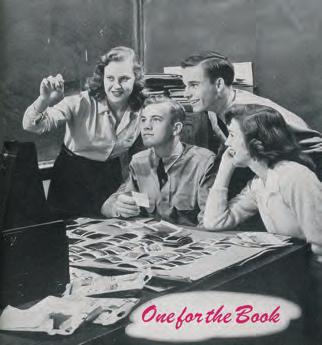

< EDITOR, ASSISTANT DIRECTOR HIRED
Kathy Leabo and C.J. “Skip” Leabo join the NSPA/ ACP staff as Scholastic Editor editor and assistant director.
Kathleen, home-decorations editor for the San Francisco Chronicle, “was virtually born into scholastic journalism,” Scholastic Editor reports. She is the daughter of Fred and Lucille Kildow, NSPA/ACP director and associate director. Skip worked for the Associated Press.


“Because family relationships are involved, the School of Journalism faculty was consulted on these appointments. The faculty reviewed the qualifications of all available candidates and unanimously approved the appointments,” the magazine reports.
1963
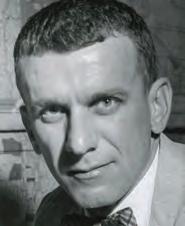
KILDOW RETIRES AS MHSPA DIRECTOR
A recognition dinner marks the retirement of Fred Kildow as director of Minnesota High School Press Association.
Kildow, continuing as NSPA/ACP director, has directed MHSPA for 35 years. Succeeding him is J.C. Sim also on the Minnesota School of Journalism faculty.
Kildow retires from the faculty in 1965 and continues as NSPA/ACP director until 1968.
ADVISER GROUP RENAMED TO JEA
The National Association of Journalism Directors meets concurrently with NSPA and votes to change its name to the Journalism Education Association
072 TIMELINE // 1960s ⊲ ON THE COVER
SCOOP! Fun photos of student journalists in action — a reporter, a yearbook staff and a typesetter — give the covers of Scholastic Editor magazine appeal.
KATHY LEABO
C.J. “SKIP” LEABO
JOURNALISM FIELD TRIP BY AIR
When journalism students at Jefferson High School, Lafayette, Indiana, decided to tour a metropolitan newspaper, they made a real trip of it. Chartering a 21-passenger plane, they flew to Chicago for a tour of the Tribune. For many students it was the first time in the air; besides visiting the newspaper, the class went to the Art Museum and had a little time to spare for shopping or a show. Charles Hopkins, adviser, comments on the financing of the 1950 trip: “Each student paid his own fare, which because of special charter rates for a school-combined with meals and spending money did not come to more than $15 per student.”
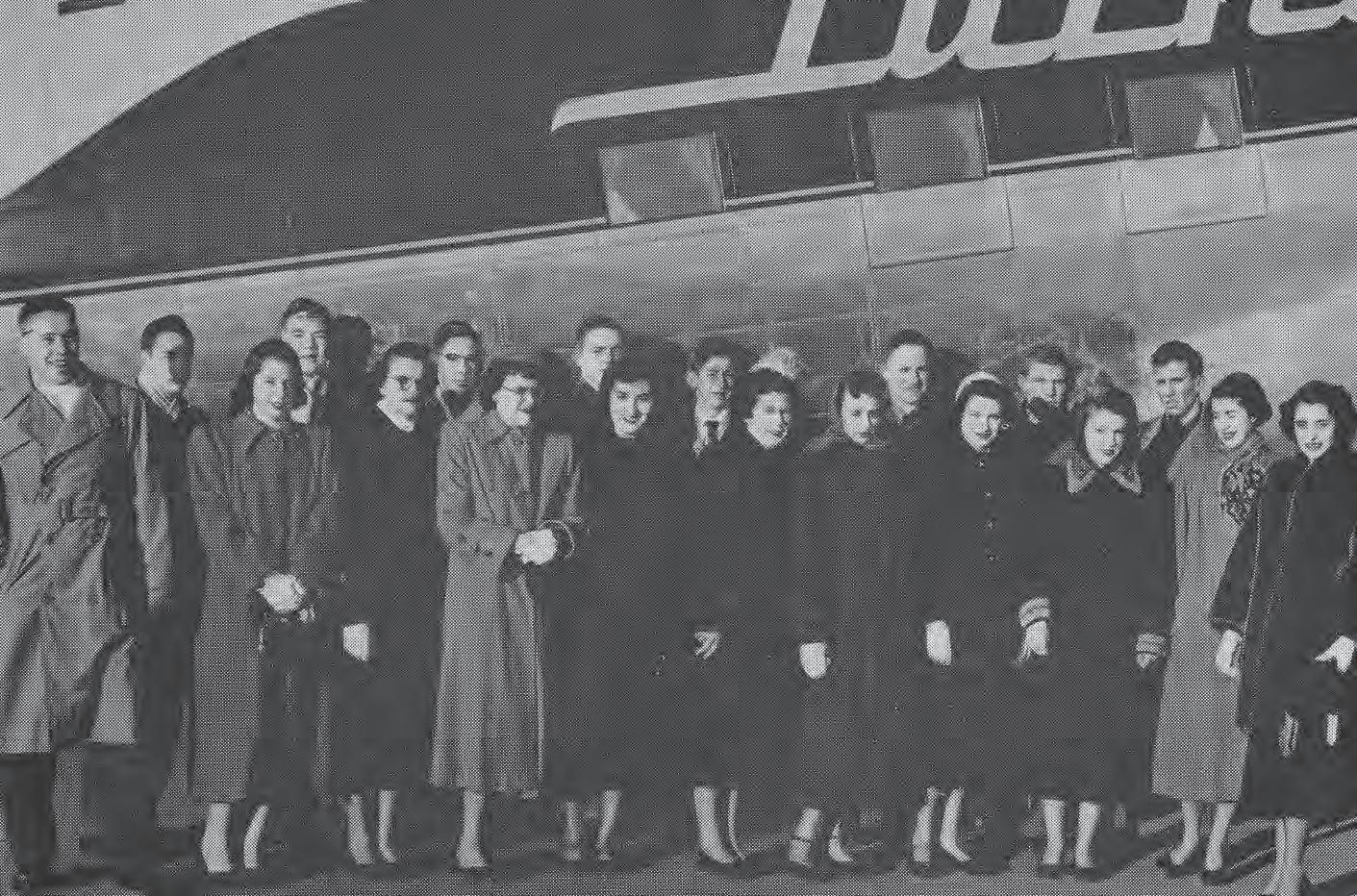
ARRIVING IN MINNEAPOLIS
Student journalists from Kansas City East High School (Kansas) and ShawneeMission High School (Kansas), arrive on the University of Minnesota campus in 1953 for the three-day NSPA conference. From 1953-60, NSPA hosted a summer conference rather than a November convention.
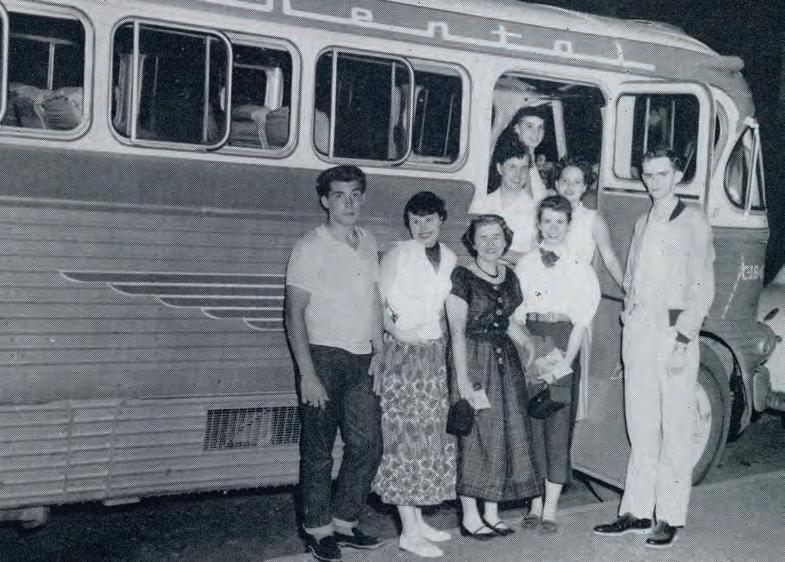
073 TIMELINE // 1960s
PHOTOGRAPHY STUDENTS
In 1962, photography students at Broad Ripple High School, Indianapolis, use an 8 x 10 studio camera for an assignment. “Each student uses this camera to take a portrait which he then develops and prints in the school photo lab, using knowledge gained in classroom lectures and demonstrations,” Scholastic Editor magazine explains.

“HISTORY IN THE MAKING”
CONFERENCE FUN
“NSPA conference blends work and fun” proclaims the headline accompanying this cover photo on the January, 1951, edition of Scholastic Editor magazine. Since the first convention in 1921, a banquet and convention dance were highly popular with NSPA delegates.

STUDENT PUBLICATIONS at Little Rock Central High School (Arkansas), cover the 1957 forced desegregation after U.S. Supreme Court ruled that segregation by race in public schools was unconstitutional. The Tiger newspaper reports the story on its Sept. 19, 1957, front page. The Pix yearbook featured two spreads with the headline “Integration … History In the Making.” The student publications are on display at Little Rock Central High School National Historic Site.
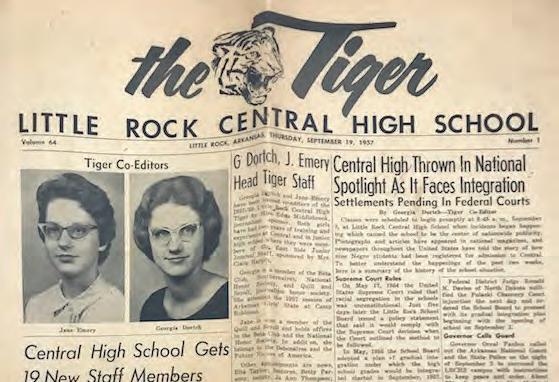
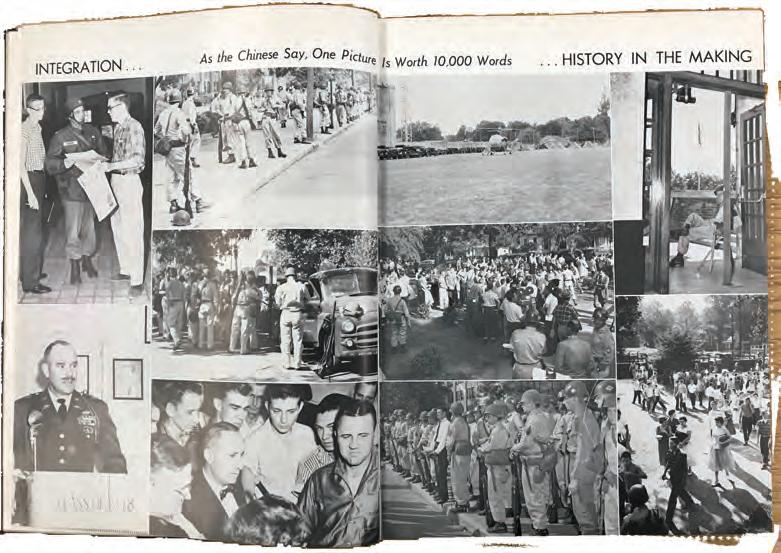
074 TIMELINE // 1960s
⊲
NSPA & ACP THROUGH THE DECADES
1966
< FOUNDER E. MARION JOHNSON, 73, DIES
Edward Marion Johnson, a founder and first director of NSPA, dies at age 73.
Known as “Johnny” by his students, he was asked by students and associates to be the faculty adviser of a high school press association they created at the University of Wisconsin in 1921.
With the blessing of the University of Wisconsin, Johnson had moved NSPA and Scholastic Editor to the University of Minnesota in 1928 when he became chair of the Department of Journalism. He directed NSPA for his first two years in Minneapolis. He left Minnesota in 1930 to enter business.
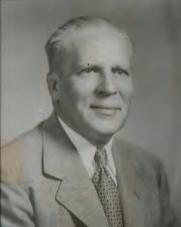
1968
< KILDOW RETIRES; QUALE NEW DIRECTOR
For the first time in 45 years, NSPA/ACP welcomes a new director — Otto Quale
The vice president of Jostens, Quale had established and managed the company’s yearbook business. Early in his career, from 1946-50, Quale served as NSPA/ACP assistant director and MHSPA director. He serves as director until 1973.
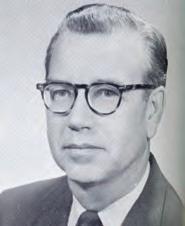
At his first conference as NSPA director, Quale rides into the opening ceremony at the Palmer House ballroom in Chicago on a Bonanza mini-motorcycle. A student from Walton, Nebraska, won the donated mini-bike in a drawing.
MAGAZINE NAME, FOCUS CHANGES
Scholastic Editor gets a new name.
AT THE TYPEWRITER
“Newspaper staffs throughout the country spent many hours at their typewriters to earn the ratings printed in this issue. This excellent picture appeared in the 1955 Whirlgig, Greensboro High School (North Carolina),” reports Scholastic Editor magazine.
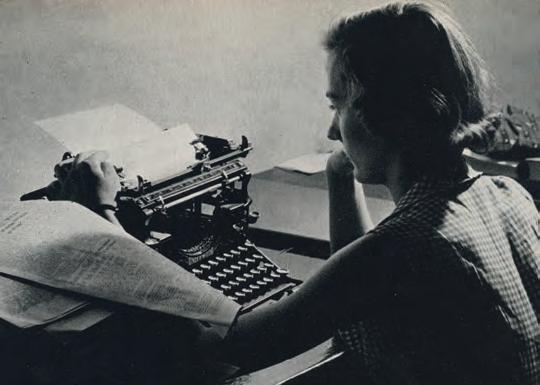
⊲ WORLDWIDE
1970 The Doonesbury cartoon strip debuts in 30 newspapers.
1971 Norman Lear pokes at controversy in his TV show “All in the Family.”
1972 U.S. bombs North Vietnamese cities.
1973 The Watergate hearings begin.
1974 President Nixon resigns, and President Ford pardons him.
1975 U.S. evacuates personnel and refugees from South Vietnam.
1977 George Lucas directs “Star Wars.”
1979 Inflation hits 13.3 percent in Amercan ans Iran holds 50 U.S. hostages.
“To keep its readers attuned to fast-moving, day-by-day advances in the graphic arts and mass communication, Scholastic Editor is broadening both its editorial and advertising concepts,” Otto Quale, NSPA/ACP director, said in his April column. While members still refer to the magazine as Scholastic Editor, its new name is Scholastic Editor Graphics/Communications.
As a nod to the new name, “Graphics/Communications” appears boldly on the cover with “Scholastic Editor” as a tagline. The magazine later reports confusion with members and libraries, so the nameplate is redesigned in 1969 with returned emphasis on “Scholastic Editor.”
KILDOWS PRESENTED CSPA GOLD KEYS
Fred and Lucille Kildow were both presented the Gold Key, Columbia Scholastic Press Association’s highest honor, for decades of work directing NSPA/ACP. They retired in January 1968.
1969
ACP, NCCPA LAUNCH AD BIZ AWARD
ACP and the National Council of College Publications Advisers launch the Pegasus Award for college newspaper advertising management. A Reader’s Digest Foundation grant funds cash prizes of $100 to $300. Fred Weddle, business manager of the Indiana Daily Student newspaper, was the first-place winner, and his winning entry appeared on two pages in Scholastic Editor.
ALL-AMERICAN DISPLAY
Displays of top-rated publications are a popular attraction at both the scholastic and collegiate conventions. Harold Haines, Louis Gellerman (sitting), Staten Eubanks, Owen Gingerich, Carroll Lindman, Roger Walks, Calvin John, delegates at the 1950 ACP convention in Chicago, study All-American newspapers for ideas.
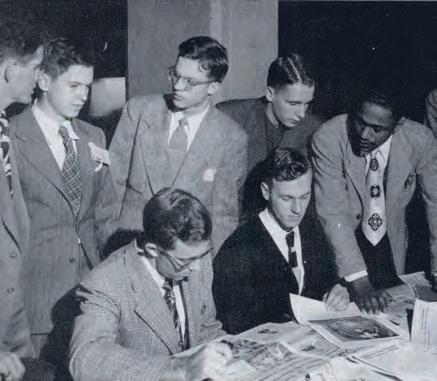 E. MARION JOHNSON
E. MARION JOHNSON
075 TIMELINE // 1960s
OTTO QUALE
UNEXCUSED ABSENCE
President Eisenhower visits Minnesota to dedicate the Hiawatha Bridge spanning the Mississippi River. More than 20,000 people attended the event in 1960.
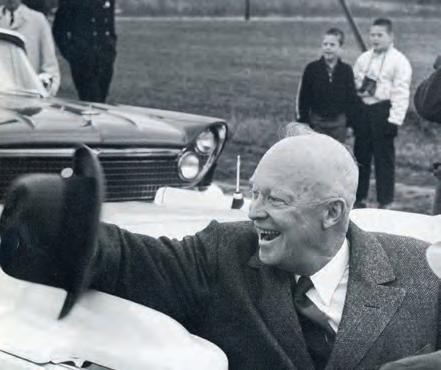
Charlie Bass, a photographer for the Pacemaker-winning Rocket newspaper at John Marshall High School, Rochester, Minnesota, captures the visit on his Leica camera. Scholastic Editor magazine reports the 17-year-old photographer received an unexcused absence for skipping classes to capture history.
NSPA & ACP THROUGH THE DECADES
1970
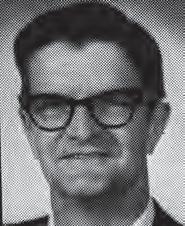
NSPA, JEA CO-HOST SPRING CONVENTION
“By popular demand, NSPA and JEA will hold a National Spring Convention,” Scholastic Editor reports. Up to this time, the organizations had not met together in the spring, and joint spring conventions continue through 1977
< PIONEER AWARD MARKS 50TH YEAR
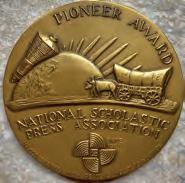
NSPA’s 50th anniversary is celebrated on Nov. 26-28, at the 43rd annual conference at Chicago’s Palmer House. To honor individual contributions to scholastic journalism, NSPA presents Pioneer Award medallions to 50 people, plus 14 posthumous awards.
Joseph Murphy, CSPA director emeritus and founder, gives the response on behalf of all recipients. NSPA continues to recognize Pioneer Award winners each year.
1971
“THE NOW LOOK IN YEARBOOK”
NSPA publishes “The Now Look in Yearbook,” an instructional manual on design.
“The yearbook that ignores today’s Go-Go style will soon be Gone-Gone,” the book’s subtitle asserts, and the era’s top yearbooks will be untraditional and bold.
The manual was written by Glenn Hansen, former NSPA assistant director and an associate professor of journalism at the University of Illinois, Urbana.
1973
< WIKOFF NAMED EXECUTIVE DIRECTOR
Wally Wikoff, a former journalist and the vice president for development at Hamline University, is named executive director. Wikoff replaces Otto Qualle, who will now lead an advertising agency. Wikoff serves until October 1975.
FOUR YEARBOOKS WIN TOP NSPA HONOR
Four yearbooks win the first Herff Jones Citation for Excellence, given to yearbooks earning All-American ratings with all five Marks of Distinction — at the time, NSPA’s top yearbook award. Pacemakers, limited to newspapers, are sponsored by the American Newspaper Publishers Association.
In 1974, the award becomes the Five-Star Award, with seven yearbook companies as sponsors, and in 1980, it joins the Pacemakers.
1974
VDTs ARRIVE IN COLLEGE NEWSROOMS
STUDENT PRESS CONFERENCE
When Eleanor Roosevelt visited Ball State Teachers College, now Ball State University, Muncie, Indiana, to deliver a convocation speech on political leadership in 1960, a student press conference was arranged after her talk with a student reporter and editor from the campus newspaper.
Professors Louis Ingelhart (left) and Earl Conn (right) facilitate the event. Conn wrote about arranging student press opportunities in the May, 1961, Scholastic Editor magazine.
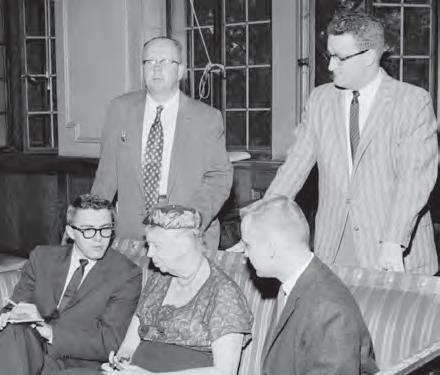
Decades before desktop computers arrive, both commercial and collegiate daily newspapers install video display terminals for text editing. Scholastic Editor shows Kansas State University’s “TV screen editing terminals.”

MURPHY
HALL TO WASHINGTON AVE.
After 34 years in Murphy Hall, NSPA/ACP offices move elsewhere on campus to 720 Washington Avenue SE to provide more space for the journalism department.
076 TIMELINE // 1970s
WALLY WIKOFF
DECADES OF SERVICE
Through the decades, Lucille Kildow serves NSPA/ACP in a variety of roles including acting director and assistant director. It was her work managing the critical service that she enjoyed the most. A noted yearbook expert, Kildow supervised judging for more than 35 years. In 1960, she trains staff members Phyllis Hayward and Janice Byce.
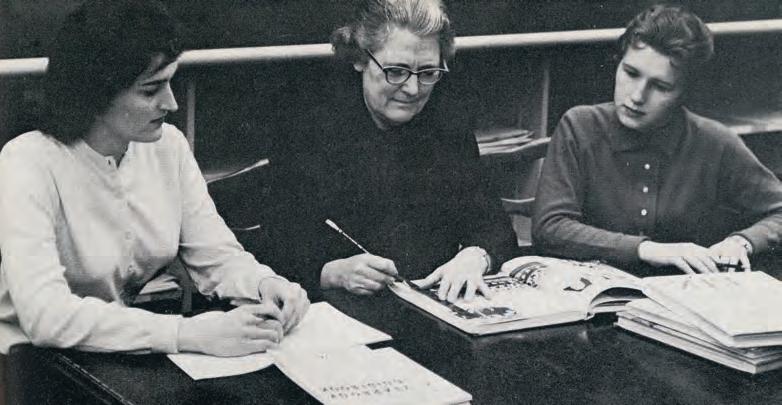
PACEMAKER AWARDS for newspapers
are presented at the all-convention NSPA awards banquet at Conrad Hilton Hotel on Nov. 28, 1964, by Hoyt Cater, publisher of the Elgin (Illinois) Courier-News to: Ann White, South Side Times, South Side High School, Fort Wayne, Indiana; Dierdre Mair and Steve Nagy, Rocket, John Marshall High School, Rochester, Minnesota; Jackie Sharkey, Trumpeter, Catalina High School, Phoenix; Charles Overby and David Thomas, Rambler, Provine High School, Jackson, Mississippi; Janice Gutman, Proviso Pageant, Proviso East High School, Maywood, Illinois.
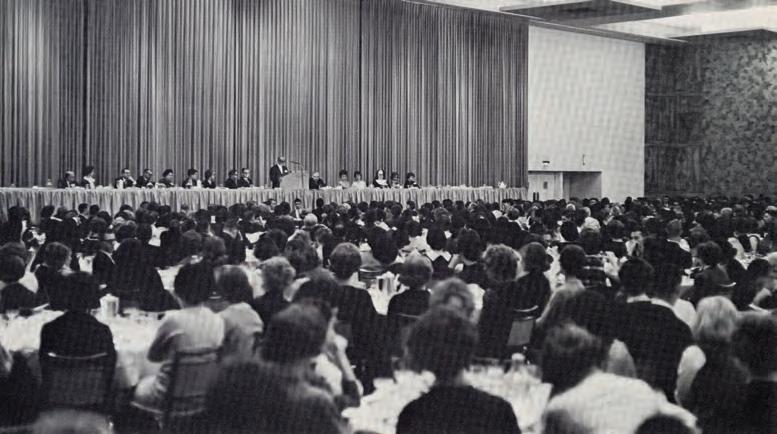
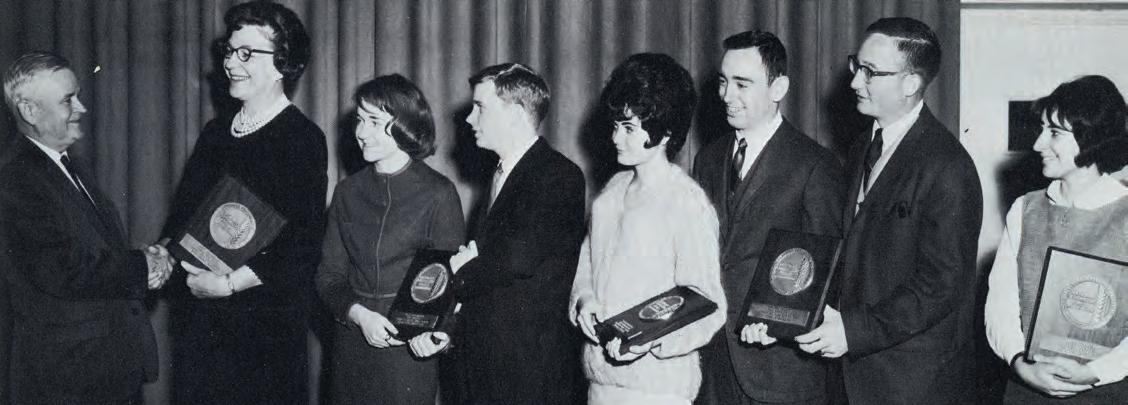
077 TIMELINE // 1970s
⊲
PACEMAKER CLASS OF 1964
HISTORIC MEETING
In 1967, the top executives of the nation’s three scholastic press organizations appear together for the first time in the history of the NSPA/JEA conventions — Lester Benz, Quill and Scroll; Fred Kildow, NSPA/ACP and Joseph Murphy, Columbia Scholastic Press Association. The convention was held in Chicago at the Edgewater Beach.
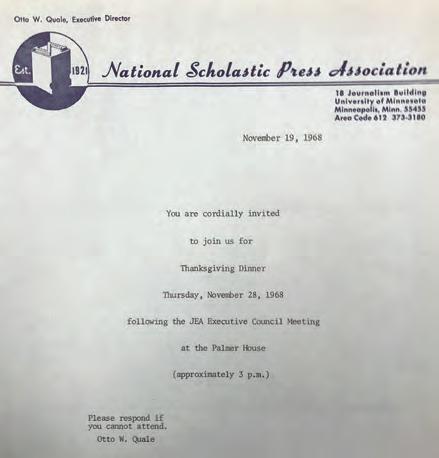

NSPA & ACP THROUGH THE DECADES
1975
<
BUCKEYE SERVES 3 YEARS AS DIRECTOR
Jeanne Buckeye succeeds Wally Wikoff as executive director. In her previous three years with NSPA/ACP, Buckeye serves as Scholastic Editor editor and associate director and as acting director. Buckeye resigns, departing in September, 1978, to begin graduate study full time.
“Having seen ACP and NSPA through some hard times, having made some positive contributions and having met my personal goals as well, I feel it is now time for me to move on,” Buckeye said.
1976
COLLEGE YEARBOOKS: “ALIVE AND KICKING”
“College yearbooks are alive and kicking,” Scholastic Editor reports.
“Across the country, circulation of college yearbooks is up and a number of books which died during the late 1960s and early 1970s have been revived. The University of Wisconsin Badger, University of Oregon Oregana and Michigan State University Red Cedar Log were among the high-profile comeback yearbooks.
1978
<
HOWELL SUCCEEDS BUCKEYE
Les Howell, a former award-winning publications adviser, succeeds Jeanne Buckeye as executive director. His “The Director’s Chair” column in Scholastic Editor reports that critique turnaround time has greatly improved, the quality of the critique certificates is upgraded and Super Critiques were launched, along with a new Scholastic Photographer magazine. After serving slightly more than a year, Howell resigns in November 1979. A national search launches for his replacement.
NSPA, JEA HOST SEPARATE CONVENTIONS
The 51st annual NSPA convention is the first in decades not co-sponsored with JEA. The October event in Minneapolis is designed as an “editors and advisers conference” featuring “intensive learning and participatory sessions.”
In 1979 and 1980, the NSPA conference was held at the Palmer House in Chicago. NSPA did not offer a spring conference from 1978-1980. Joint fall conventions resumed in 1981 in Kansas City, Missouri. In 1990 in Seattle, NSPA and JEA co-sponsored a spring convention for the first time since 1977.
1980
Beginning in 1946, the NSPA conference starts at noon on Thanksgiving. In 1965, the convention schedule changes and the conference begins at 8 a.m. on Friday to allow students and advisers to have Thanksgiving dinner at home before traveling. In 1968, when the conference started on Thanksgiving, NSPA hosted Thanksgiving dinner at the Palmer House for conference officials at 3 p.m. after the JEA Executive Council meeting. Executive director Otto Quale mailed invitations on NSPA letterhead.
< ROLNICKI BEGINS 26 YEARS AS LEADER
Tom Rolnicki, an award-winning teacher and adviser at both the high school and collegiate levels, is named executive director, a position he would have for 26 years.
During the 1970s, Rolnicki had served in JEA leadership roles, including vice president, Midwest regional director and director of the JEA Summer Seminar for teachers.
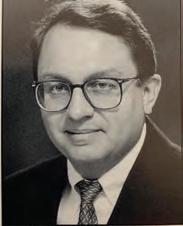
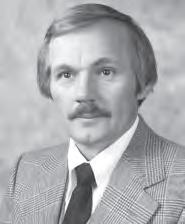
Renewing and strengthening relationships with JEA and NCCPA is one of Rolnicki’s top priorities. He and Jerry Kline attend the JEA and NCCPA spring conventions to discuss future cooperation.
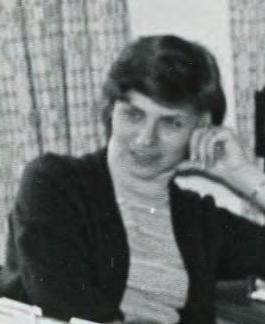
078 TIMELINE // 1970s, 1980s
JEANNE BUCKEYE
“YOU ARE CORDIALLY INVITED”
LES HOWELL
TOM ROLNICKI
AFTER34 YEARS in the Journalism Building, the NSPA/ACP offices move from Murphy Hall to the corner of Oak Street and Washington Avenue SE where 720 Washington Avenue SE, Suite 205, will be home for the next eight years. (top) Jeanne Buckeye, conference coordinator and Betty Fornell, bookkeeper, discuss organization business. (center) Director Wally Wikoff works at his desk opening mail. (bottom) The NSPA/ACP offices are located on the second floor above The Best Steak House. In 2022, Bruegger’s Bagels is located on the ground floor and the University of Minnesota Physicians occupy the top floors.
YEARBOOK STAFF MEETING
The Annual W yearbook staff, Waukegan High School (Illinois) discuss content and coverage while double-checking lists of story and photo ideas. “A school yearbook is a true source of history,” Scholastic Editor magazine reports.
ALL-AMERICAN RATING
In journalism classrooms across the country, rating certificates from the NSPA line the walls. For more than 40 years, the certificates featured a very traditional design with the original National Scholastic Press Association circular logo. The coveted All-American rating is highest honor from the critical service.
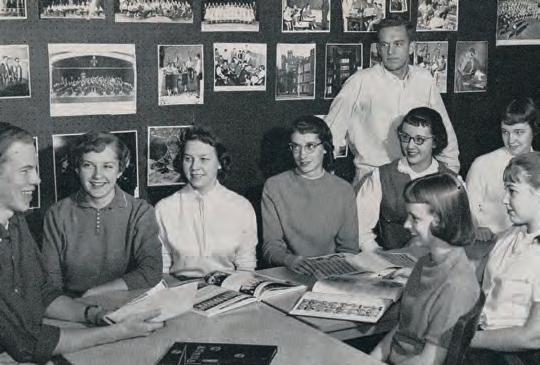
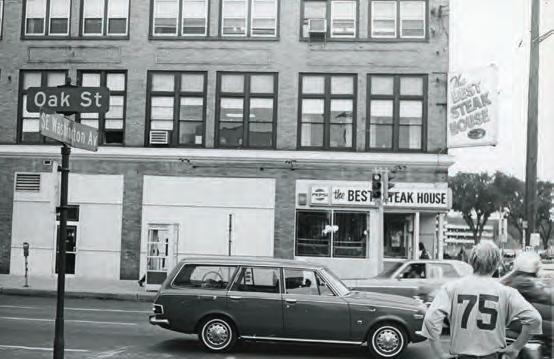

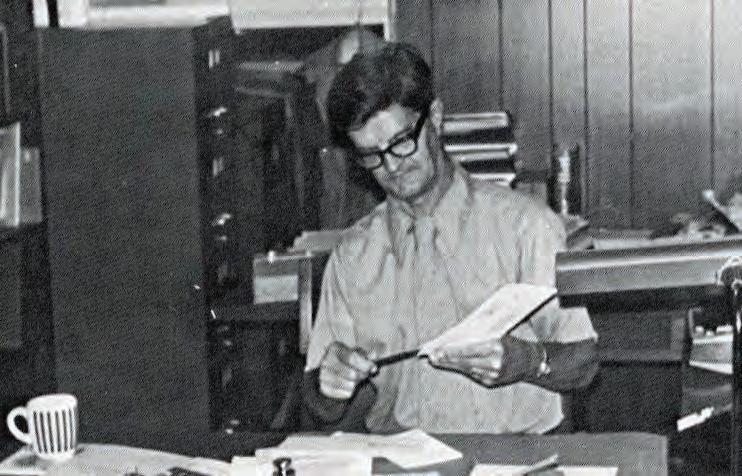
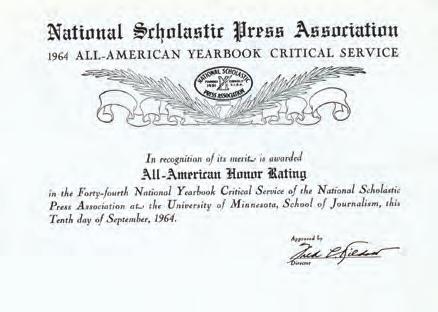
TIMELINE
1980s
079
// 1970s,
⊲ CORNER OFFICE
ILLUSTRATING THE POINT
Informing and entertaining, a speaker at the 1979 colllege media convention in San Francisco, uses his artistic talent to accent his presentation with an illustration called “Good Investigative Material.”
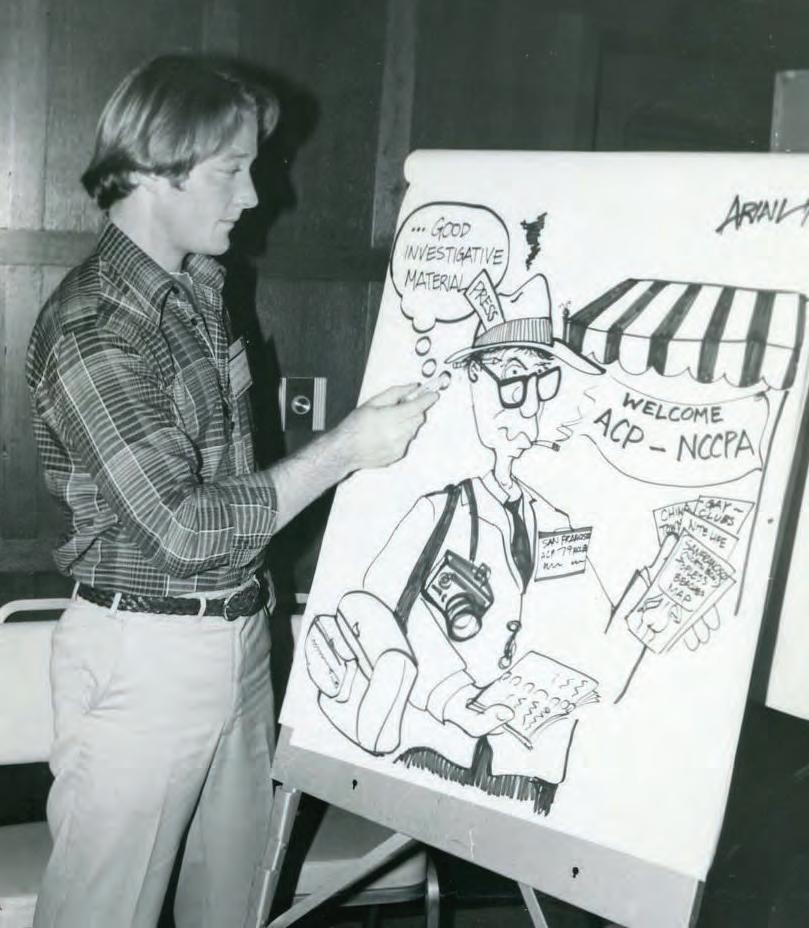
COVERING THE UNCOVERED
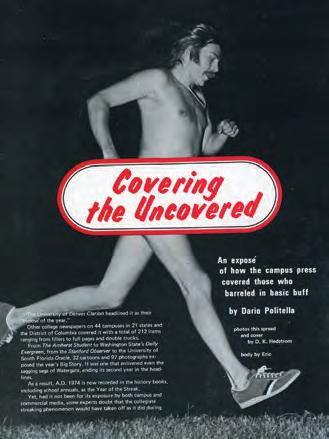
The University of Denver Clarion headlined it as their exposé of the year. Other college newspapers on 44 campuses in 21 states and the District of Columbia covered it with a total of 212 items ranging from filler to full pages and double trucks. In all, 32 cartoons and 97 photographs exposed the year’s big story. Dario Politella analyzes the coverage of streaking in collegiate newspapers in his article published in Scholastic Editor magazine in 1974.
REBRANDING
In the 1970s, new logos for NSPA and ACP were introduced, replacing a graphic created in 1947. For the first time, ACP receives its own logo.

CONVENTION TOUR
F. Gerald “Jerry” Kline, president of the board, addresses organizational and financial challenges facing NSPA/ACP at the 1979 college media convention in San Francisco. One of Kline’s first priorities was attending the high school and college conventions to renew and strengthen relationships with JEA and NCCPA (now CMA).

080 TIMELINE // 1980s
THE DECADES
KLINE LEADS THROUGH TOUGH TIMES
F. Gerald “Jerry” Kline, professor and director of the University of Minnesota School of Journalism and Mass Communication is elected to the Board of Directors and has been named president of the board. Kline says he intends to play an active role in leading the organizations.
Kline addresses organizational and financial challenges facing the organization in his column appearing in Scholastic Editor throughout the 1979-80 school year.

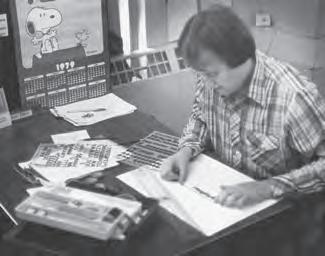
“Our income is not sufficient to cover organizational expenses, let alone develop new projects to meet changing demands,” Kline writes. Dow Jones & Company Inc. and the Gannett Newspaper Foundation provide grants totaling $7,500 to stabilize operations. In addition, Kline leads the reorganization of the governing board and bylaws revisions.
NSPA and ACP membership increases more than 40 percent during his tenure as board president. New programs include summer collegiate workshops and a mid-year ACP national conference.
Kline serves as board president from 1980 until his death from lymphatic cancer on Feb. 3, 1984. He was 49.
1981
PACEMAKERS RETURN FOR YEARBOOKS
Pacemakers for yearbooks are reestablished, replacing the Five-Star Award. Yearbook Pacemakers were presented from 1927-1937 and then dropped. Newspaper Pacemakers also started in 1927 and were presented continuously, except from 1948-1960.
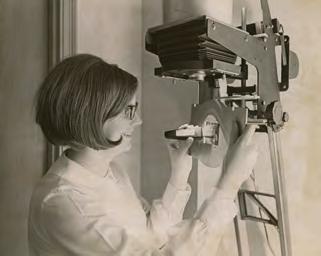
NSPA, JEA REUNITE AS PARTNERS
The fall convention, in Kansas City, Missouri, marks not only the 60th NSPA anniversary, but it reunites NSPA and JEA as convention partners. The organizations hosted separate conventions from 1978-1980. Thirty years after reuniting, the partners have jointly sponsored 72 conventions.
1984
FIRST SCHOLASTIC PRESS FREEDOM AWARD
The first Scholastic Press Freedom Award, sponsored by NSPA/ACP and the Student Press Law Center, honors Cathy Kuhlmeier, Leslie Smart and Leanne Tippett, graduates of Hazelwood East High School in St. Louis, Missouri.
School officials had refused to publish a set of stories on teen issues in the May 13, 1983, issue of the Spectrum newspaper, prompting the Hazelwood v. Kuhlmeier lawsuit, with profound implications on student journalism.
The award was presented at the Little Rock convention on Nov. 11, 1984 — the week the trial started. The student journalists also appear on Phil Donahue’s TV talk show.
1985
AIDS: MOST COVERED NON-SCHOOL STORY
AIDS was one of the most covered “non-school stories” in the high school press during the 1985-86 school year, Trends magazine reports. NSPA praises Highlights, at Coral Gables High School (Florida), for “its maturity and frankness in reporting the way the AIDS virus is spread.”
PUBLICATIONS PRODUCTION was a hands-on activity before the invention of desktop publishing in the mid 1980s. (top) Images were shot on film and after developing, the negatives were placed into an enlarger for printing on photo paper. (center) Cropping required the photo be sized so it could be proportionately enlarged or reduced to fit the space on the layout. (bottom) Headlines were often created using transfer lettering. Ron Johnson, editor of the 1979 Reveille, Fort Hays State University, Kansas, positions the letters carefully on a yearbook pasteup board. In 2022, Johnson serves as the communications director for NSPA/ACP.
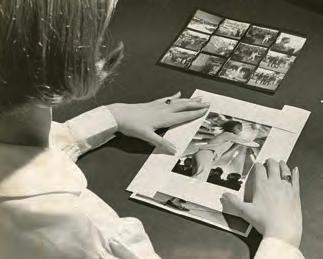
<
081 TIMELINE // 1980s
⊲ CAMERA READY
NSPA & ACP THROUGH
F. GERALD “JERRY” KLINE
⊲ FIVE-STAR WINNERS
NSPA & ACP THROUGH THE DECADES
1986
⊲ WORLDWIDE
1980 Ronald Reagan is elected president.
1981 Sandra Day O’Connor joins the Supreme Court.
1982 Citizens keep cable TV under local government control.
1983 A suicide bomber in Beirut kills 241 soldiers, mostly Marines.
1984 U.S. and French researchers discover the AIDS virus.
1985 Mikhail Gorbachev becomes the last leader of the USSR.
1986 Space Shuttle Challenger explodes after takeoff.
1987 Van Gogh’s ”Sunflowers” sells for a record $39.9 million.
1988 The Supreme Court upholds censorship at Hazelwood East High School, Hazelwood, Missouri.
1989 Exxon’s Valdez oil spill is the world’s worst environmental damage.
SETTING THE PACE — From 197479, the Five Star yearbook award was presented instead of the Pacemaker. Engraved plaques were presented to NSPA 1974 Five Star Yearbook Award winners and the 1974 Newspaper Pacemaker winners at the Los Angeles convention. The winners were Randy Palowski and Barbara Greci, co-editors, Aries, Millikan High School (Long Beach, California); Becci Brodehl, editor, Tokay Press, Tokay High School (Lodi, California); Vivian Svestka, editor, Hornet, Hazen (Arkansas) High School; Cinthia Hossler, editor, Pennant Annual, Elkhart Central High School (Elkhart, Indiana).
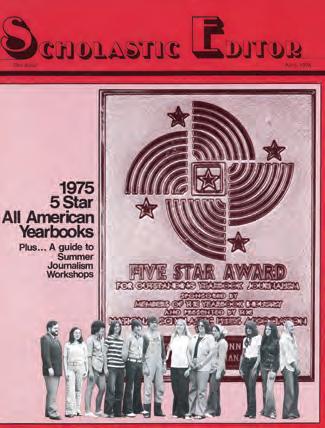
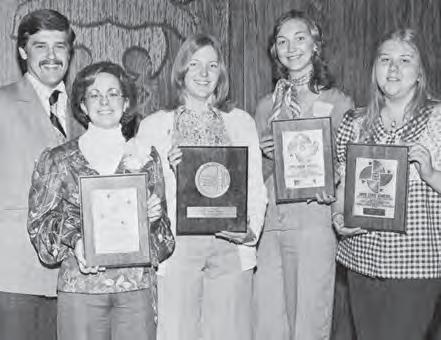
BEST OF SHOW: FIRST WINNERS
NSPA’s inaugural Best of Show competition highlights the Chicago convention, with four publications taking home the first gold-cup trophies awarded by NSPA:
Pioneer (yearbook), Kirkwood High School (Missouri)
Falcon (yearbook), Fairfield High School, Langdon, Kansas
Featherduster (newspaper), Westlake High School, Austin, Texas
Arlingtonian (newspaper), Upper Arlington High School (Ohio
NSPA LEADS “DESKTOP REVOLUTION”
With the growing popularity of the Apple Macintosh 512k and Aldus PageMaker design software, desktop publishing appears in school publications offices across the nation.
Trends introduces its popular “Desktop Repartee” column by Bruce Watterson. The same year, NSPA launches the first desktop publishing workshop taught by Watterson and Jim Jordan.
1987
FIRST ALL-AMERICAN VIDEO YEARBOOKS
Four high schools and four colleges receive the first All-American ratings for video yearbooks. The video yearbooks were produced during the 1985-86 school year and varied in length from 30 minutes to an hour.
1988
HALL OF FAME CHARTER MEMBERS
Charter members of the ACP/NSPA Hall of Fame feature 16 college and 13 high school publications. To earn Hall of Fame status, publications earned 10 consecutive All-American ratings starting in 1976. As of 2021, there are 69 collegiate and 225 high school publications inducted into the Hall of Fame.
CARTER KEYNOTES CONVENTION
Former President Jimmy Carter, keynote speaker for the ACP/CMA National College Media Convention in Atlanta, leads a town hall-style press conference.
1990
NSPA, JEA SPRING CONVENTIONS RETURN
For the first time since 1977, NSPA sponsors a spring convention with JEA, with CBS news anchor Harry Smith as keynote speaker at the Seattle convention. The spring-convention partnership continues today.
082 TIMELINE // 1980s, 1990s
THENSPA WORKSHOP, co-hosted by the Minnesota High School Press Association, brought student journalists from across Minnesota and the nation to the University of Minnesota campus each summer. In 1982, Lynn (Rosenfeld) Loewy, Spring Woods High School, Houston and Bruce Watterson, Ole Main High School, North LIttle Rock, Arkansas teach writing and design. Donn Poll, NSPA graphic designer, demonstrates paste-up techniques during the new Redesign Workshop. After several decades, the workshop ended in 2016.
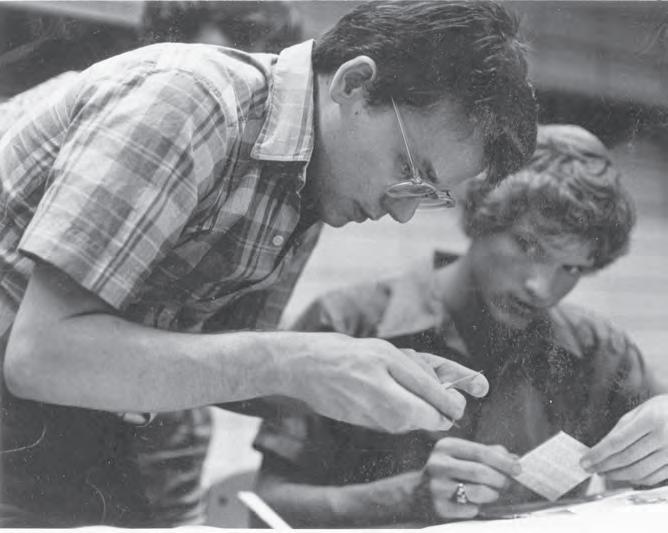
WHEN PRINCIPAL Robert Reynolds removed an article on divorce and another on teen pregnancy from the May 13, 1983, issue of The Spectrum newspaper at Hazelwood East High School, St. Louis, Missouri, editor Cathy Kuhlmeier and reporters Leslie Smart and Leanne Tippett sued, claiming their First Amendment rights had been violated. Ultimately, on Jan. 13, 1988, the U.S. Supreme Court ruled that schools may restrict what is published in student newspapers if the papers have not been established as public forums. The Court also decided that the schools may limit the First Amendment rights of students if the student speech is inconsistent with the schools’ basic educational mission.
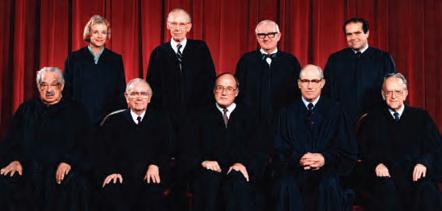
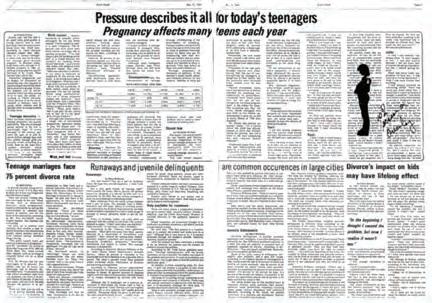
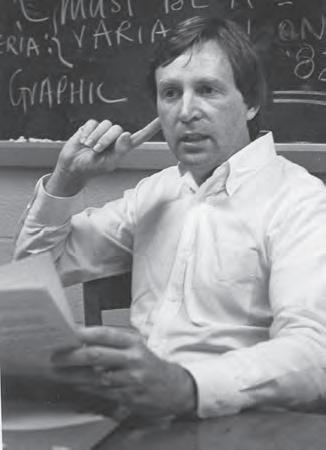
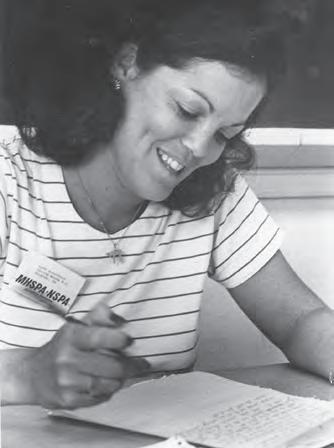
083 TIMELINE // 1980s, 1990s
⊲ SUMMER IN CITY
⊲ HAZELWOOD V. KUHLMEIER
STUDENTS ON THE SET
While attending the 1988 Washington, D.C, convention, adviser Jack Harkrider, Anderson High School, Austin, Texas, and his students were allowed on the set to watch Ted Koppell broadcast live. After the newscast, Koppell spent about 15 minutes talking to the students. “Ted was great — he’s an amazing interviewer. He was very enthusiastic and motivational for the students,” Bradley Wilson said. Wilson was student teaching with Harkrider.
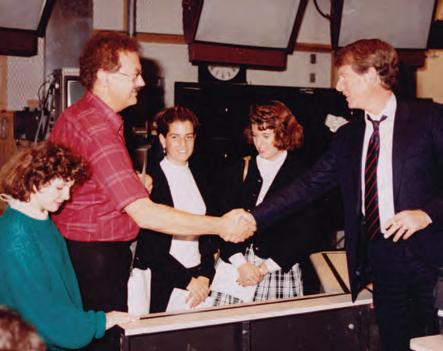
DATELINE ATLANTA
A short walk from the hotel, CNN Center, headquarters of the news network, was a popular attraction for student journalists and their advisers attending the 2004 Atlanta convention. Craig Coyle, Lamar High School, Arlington, Texas, takes a staff photo at the iconic CNN sign.
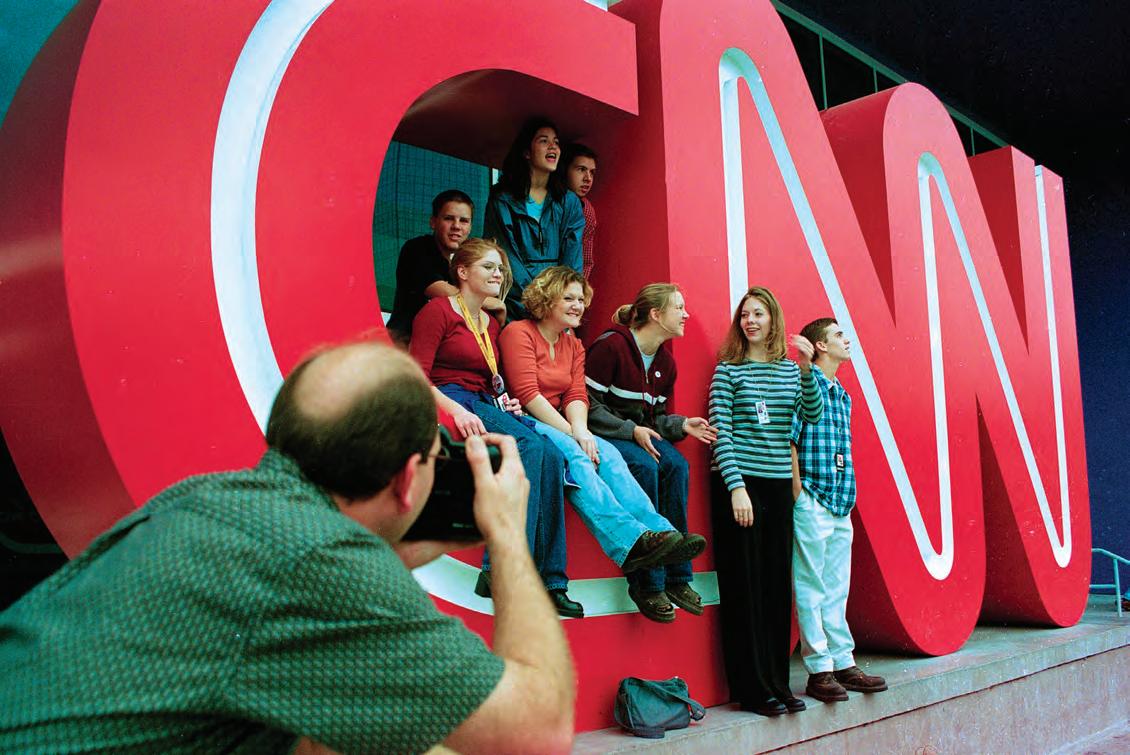
TIMELINE // 1990s, 2000s
084
NSPA & ACP THROUGH THE DECADES
⊲ WORLDWIDE
1990 The Paris Summit ends the Cold War.
1991 The Gulf War in Kuwait and Iraq spikes stock prices.
1992 Police acquittals ignite Los Angeles riots in the Rodney King beating case.
1993 Janet Reno becomes the first female attorney general.
1994 The magnitude 6.7 Northridge earthquake hits Los Angeles.
1995 Nearly 200 die in the Oklahoma City bombing.
1996 The AIDS Memorial Quilt unfolds across the National Mall.
1997 Princess Diana dies in car crash.
1998 President Clinton is impeached.
1999 A mass shooting at Columbine High School, Littleton, Colorado, kills 15 and injures 28.
TECHNOLOGY TRANSFORMS JOURNALISM
The inaugural NSPA Computer Assisted Publishing Trendsetter Awards recognize 25 high school journalists.
From the pages of Trends: “When students at South Eugene (Oregon) High School received their yearbooks, there was an unexpected surprise tucked into the back cover — a compact disc. It contains a track full of computer information that can be used to bring-up an audio-visual yearbook called the Electronic Eugenean.”
1993
BEST OF THE HIGH SCHOOL PRESS DEBUTS
The Best of the High School Press begins as a special edition of Trends in High School Media. In his welcome column, director Tom Rolnicki says 500 newspapers, yearbooks and magazines were reviewed for possible selection in the publication.
1995
NSPA/ACP ARRIVES ON WORLD WIDE WEB
“Students and advisers with World Wide Web access through the Internet can now join NSPA and other connected members in high school journalism cyberspace,” Trends reports.
“With Internet access through computers with modem hook-ups in high schools becoming common, NSPA officials decided the time was right to begin offering some of its services on-line and add some new programs just for Internet users.”
1996
75TH CELEBRATED IN CHICAGO
NSPA officially celebrates its 75th anniversary during the fall convention in Chicago — the city often considered NSPA’s convention home
NEW MEDIA CRITIQUES INTRODUCED
Website critiques are introduced, in addition to existing critiques for literary arts magazines, newspaper/ newsmagazines and yearbooks. Broadcast critiques are added in 2020.
NSPA ADDS BROADCAST PACEMAKER
Reflecting the growing popularity of scholastic broadcasting programs, NSPA adds Broadcast to its prestigious Pacemaker competition.
2001
HISTORIC PUBLICATION
9-11: The College Press Responds — ACP publishes a 56-page book showcasing the coverage from 77 collegiate newspapers.
2006
ROLNICKI’S 26-YEAR TENURE ENDS
Tom Rolnicki, executive director since 1980, is relieved of his duties on June 7, and a national search is launched for the next leader. Renee McGivern is named interim director of operations.
SENIOR SUPERLATIVES
A popular May, 1988, Trends cover features the “greats” including Elizabeth Taylor, Norma Jean Baker, Lauren Becall, James Dean as well as (top row) Judi Coolidge, Bruce Watterson (second row) Ann Gramlich Akers, Nancy Hall, John Custinger (third row) Jim Jordan (bottom row) Dot McPhillips, Judy Allen.
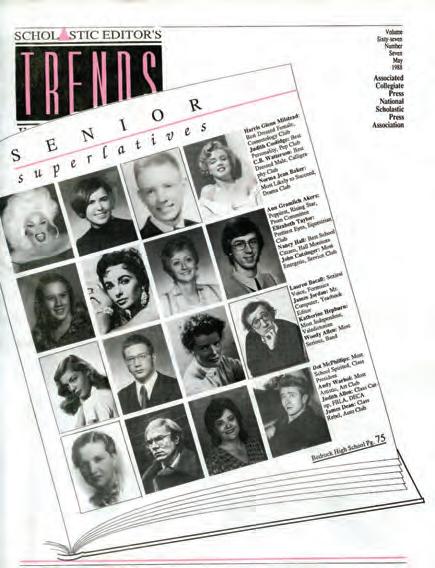
085 TIMELINE // 1990s, 2000s
THE U.S. SUPREME COURT RULES in 1969, that Mary Beth and John Tinker, Des Moines, Iowa, had the right to protest the Vietnam War by wearing black armbands at school. The decision establishes the bedrock of student-press rights for nearly two decades. In recent years, Mary Beth and her Tinker Tour have educated thousands of students coast to coast. In 2013, the tour stopped in Boston at the National High School Journalism Convention where Tinker and attorney Mike Hiestand met with students.

NSPA & ACP THROUGH THE DECADES
2007
< BOARD NAMES AIMONE
An award-winning journalism teacher and adviser is named NSPA/ACP executive director on April 27. Logan Aimone comes from Wenatchee (Washington) High School, where he has been a journalism teacher and student publications adviser for 10 years. He was named a Distinguished Adviser by the Dow Jones Newspaper Fund.
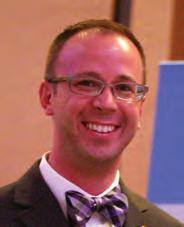
BLEND MAGAZINE DEBUTS
NSPA partners with Ball State University to publish Blend magazine. The magazine is mailed to all NSPA members and published until 2013.
GREAT RECESSION IMPACTS PROGRAMS
⊲ WORLDWIDE
2000 Hillary Clinton becomes the first former first lady elected to the U.S. Senate.
2001 In the worst terror attack in U.S. history, more than 3,000 people perish in New York World Trade Center and the Pentagon in Washington D.C. attacks.
2005 Hurricane Katrina blasts New Orleans causing destruction estimated at $26 billion.
2008 Barack Obama elected 44th President of U.S.
2010 Swine flu (H1N1), the first influenza pandemic in 40 years, sends masses into panic.
2011 Osama Bin Laden is killed after a 10-year manhunt.
2012 A gunman kills 26 people, mostly children, at Sandy Hook Elementary School, Newtown, Connecticut, before killing himself.
2015 In a 5-4 decision the Supreme Court votes to allow same-sex marriages throughout the country.
As the country struggles with the Great Recession from 2007-2009, the impact on member schools is significant, reducing travel and in some cases membership. College newspapers cut pages, sections or publishing days or published online only, and some college yearbooks stopped publishing.
2008
PDF CRITIQUE FORMS BEGIN
NSPA is the first association to switch to PDF critique forms, making it much quicker to get critiques to and from judges while reducing shipping and printing expenses
2009
MULTIMEDIA GUIDEBOOK PUBLISHED
Debuting at the JEA/NSPA Phoenix convention, the Multimedia Guidebook offers the first published criteria used for contests and critiques. The open-source guidelines were adopted or adapted by several state associations. Website critiques are introduced.
FIRST-EVER CODE OF ETHICS
Randy Swikle writes the first-ever code of ethics for high school journalists. The Model Code of Ethics is sent to all NSPA members and included in adviser resource materials through some yearbook publishing companies.
RECORD-BREAKING CONVENTIONS
JEA/NSPA Washington, D.C., convention sets an attendance record at 6,353 that lasts for five years, only to be broken by the next D.C. convention in 2014 with 6,406 attendees.
2011
ACP WORKSHOP MOVES TO MINNEAPOLIS
The ACP Summer Workshop moves to University of Minnesota with emphasis on hands-on application of newsroom training. CMA joined the workshop in 2016. In 2017, the College Media Mega Workshop was sponsored by ACP, CBI, CMA and CMBAM on the University of Minnesota campus. During the pandemic, the workshop switched to a virtual format. In 2022, an in-person workshop returned with ACP as sole sponsor.
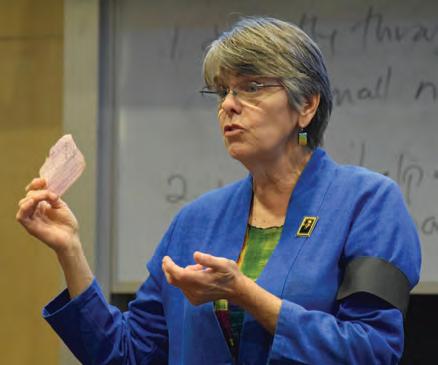
086 TIMELINE // 2000s, 2010s
⊲ TINKER TOUR
LOGAN AIMONE
CUTTING THE CAKE, executive director Tom Rolnicki and staff member Wendi Buck prepare to serve the approximately 200 advisers gathered to celebrate the 75h anniversary of NSPA at the Chicago Hyatt during the 1999 fall convention. The organization provided commemorative anniversary pins to Pioneer Award recipients in attendance.
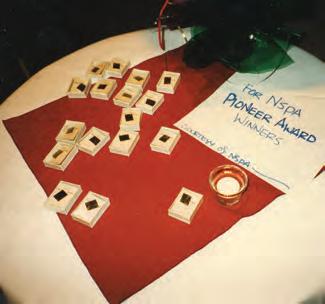
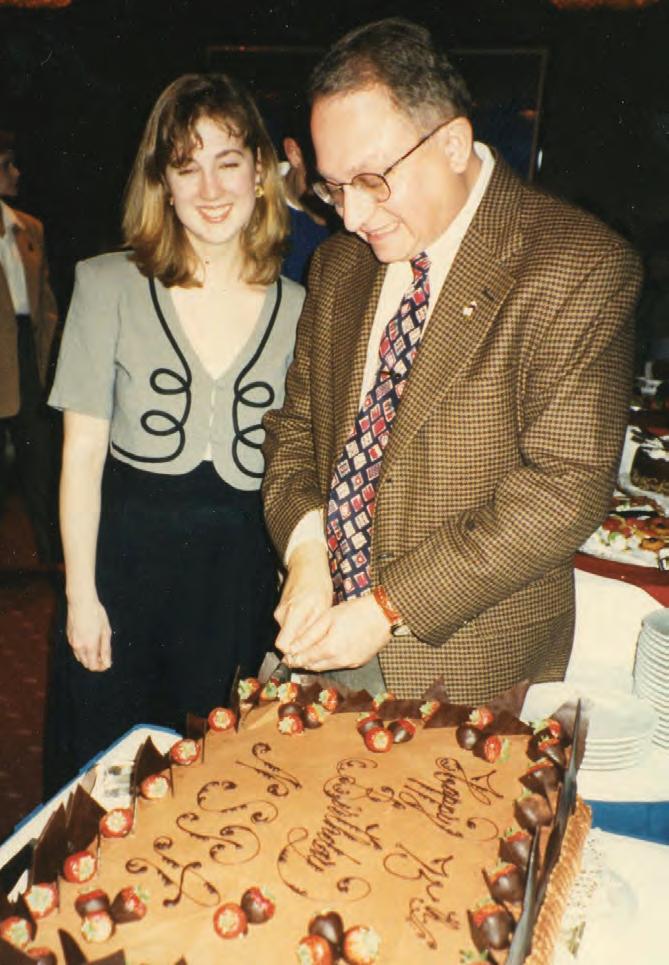
ON-THE-SPOT REPORTING
Positioned by a power outlet, a high school journalist writes a news story for the on-site contest at the national convention using an electric typewriter. While technology has replaced typewriters with laptops and smartphones, the challenge of writing on deadline hasn’t changed.

AT THE OVERHEAD
Making her point with the aid of visuals on the overhead projector, Susan Komandosky teaches a session called “Organizing for Success,” one of hundreds of educational sessions for students and advisers at the 1990 Indianapolis convention. Komandosky taught journalism and advised publications at Round Rock (Texas) High School.

TIMELINE
⊲ 75TH ANNIVERSARY
087
// 2000s, 2010s
ON-THE-SPOT ADVICE
Critique sessions were a popular offering at both scholastic and collegiate conventions. Mark Witherspoon, Iowa State University, offers detailed suggestions for a college newspaper editor.
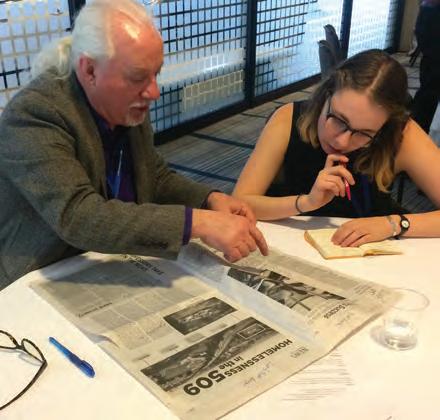
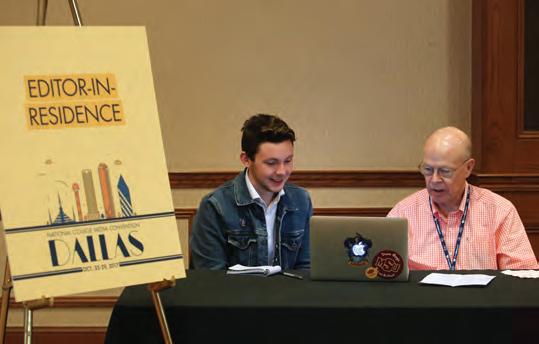
NSPA & ACP THROUGH THE DECADES
2013
LOGAN LEAVES NSPA/ACP
NSPA/ACP and its executive director Logan Aimone mutually agreed to part ways on June 10. Aimone held the position for six years. David Therkelsen serves as interim director.
< APPOINTMENT MAKES HISTORY
The board of directors names Diana Mitsu Klos as NSPA/ ACP executive director as of Nov. 1, making her the first Asian American and second woman to serve as executive director in 92 years. Klos, a media education and nonprofits consultant based in northern Virginia, was a senior staff member at the American Society of News Editors from 1996 to 2012.
2016
MITSU
KLOS DEPARTS
Diana Mitsu Klos steps down as NSPA/ACP executive director effective June 15. “I have loved my time with NSPA/ACP and everyone associated with it. However, this leadership position requires someone who can commit to living in the Twin Cities region full time, which unfortunately I cannot,” Mitsu Klos said. Associate director Laura Widmer is named interim executive director.
< WIDMER NAMED EXECUTIVE DIRECTOR
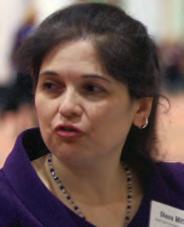
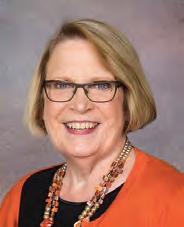
On Aug. 15, the board of directors names associate director Laura Widmer as executive director. Widmer advised student media at middle school, high school and college levels during her 33-year teaching career. While student media director at Northwest Missouri State University, her students and publications were honored with numerous national awards, including the Pacemaker. In 1991, she was elected CMA president.
ACP, CMA HOST SEPARATE CONVENTIONS
For the first time since 1954, ACP and CMA do not share convention sponsorship of the fall National National College Media Convention. ACP’s convention, in Washington, D.C., features two keynote speakers — Washington Post investigative reporter Bob Woodward and expat digital whistleblower Edward Snowden, who spoke remotely from Russia.
2017
EDITOR-IN-RESIDENCE
Serving as co-director of recruiting and hiring for The Washington Post prepares Bill Elsen to share his experience and insights with college and high school journalists as editor-in-residence at conventions after he retired after almost 34 years with the newspaper. “After I left the Post, universities including Virginia Tech, Iowa State, Northwest Missouri State, Kansas State and Nebraska brought me into their newsrooms to meet students and evaluate newsroom production,” he said. The editor-in-residence program was launched in 2005 and continues in 2022. In 2017, Elsen meets with a student journalist at the ACP/CMA convention in Dallas.
088 TIMELINE // 2010s
A PERFECT COMBO: NSPA, GLORIA SHIELDS
To offer its members a quality summer workshop experience, NSPA joins forces with the Gloria Shields Workshop, established by the Dallas County Schools. Now in its 42nd year, the Dallas-based Gloria Shields NSPA Media Workshop is widely regarded as one of the nation’s top summer workshops, serving 500 to 800 students.
LAURA WIDMER
DIANA MITSU KLOS
9-11: THE COLLEGE PRESS RESPONDS
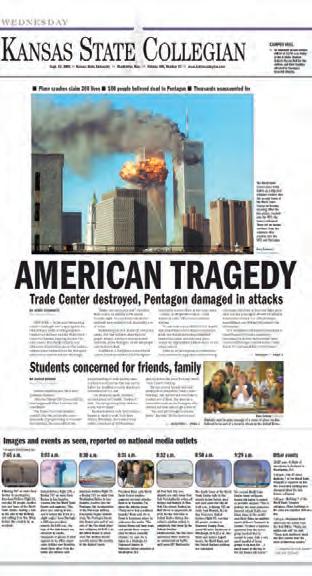
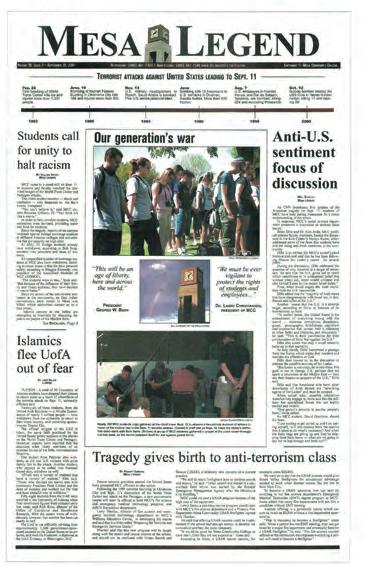

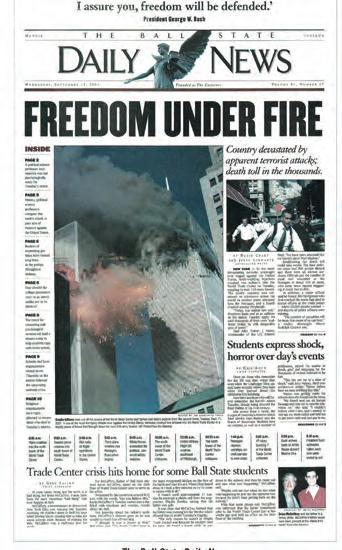
“ITWAS A DAY of stunning surprises, anxiety, tears and, for thousands of collegiate newspaper journalists, a day — and weeks — of adrenaline rushes unlike any they ever had in their newsrooms. The biggest story of their still young journalism careers was unfolding on the morning of Sept. 11, 2001.” These words from executive director Tom Rolnicki introduce a 56-page book published by ACP showcasing the coverage from 77 collegiate newspapers.
PACEMAKER POSE
After receiving her Pacemaker finalist plaque for the SAC.Media website, Mt. San Antonio College, Walnut, California, editor Ferry Baylon poses with the plaque at the 2019 Washington, D.C. convention.
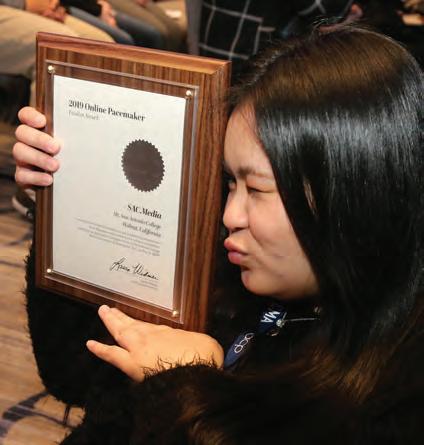
BEST OF SHOW
Since 1986, the Best of Show competition has been a popular offering at NSPA/ACP conventions. The contest ranks student media represented at the convention. At the 2022 ACP conference in Long Beach, the Talon Marks website, Cerritos College (California), took home the iconic gold-cup trophy. Christian Brown, adviser, celebrates with Laura Widmer, executive director.
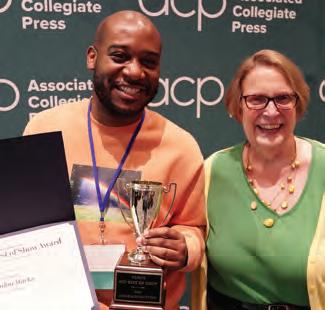
089 TIMELINE // 2010s
⊲
“IN GRATEFUL APPRECIATION”
ACP, CBI, CMA and CMBAM recognize Frank LoMonte, outgoing SPLC executive director, “for his tireless dedication, everlasting enthusiasm and love of the First Amendment and student press freedoms” at a special recognition dinner on July 17, 2017, at the Loring Pasta Bar in Minneapolis during the College Media Mega Workshop. CMA president Kelley Lash presents the plaque.
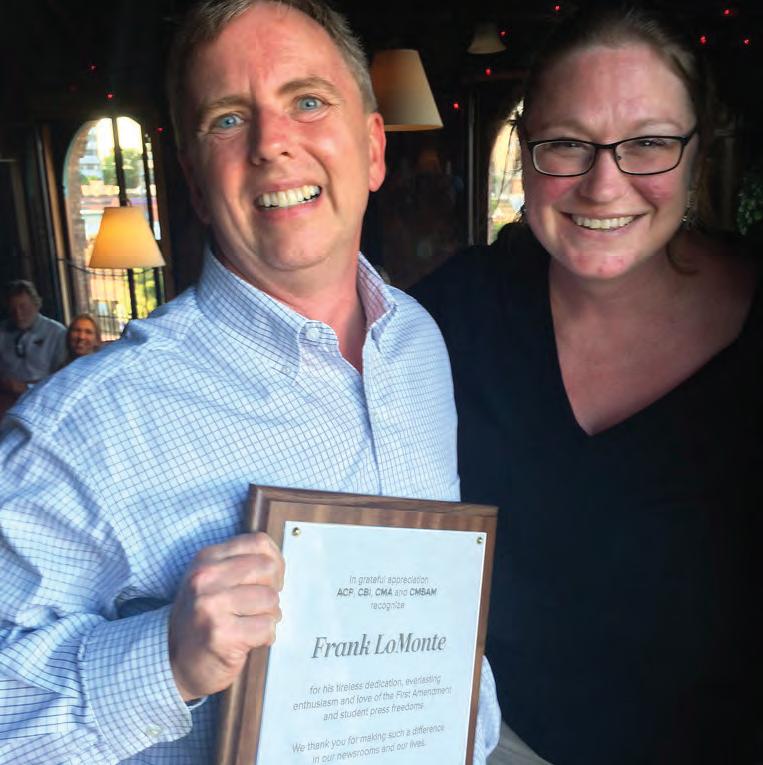
NSPA & ACP THROUGH THE DECADES
⊲ WORLDWIDE
2016 Hillary Clinton wins the popular vote, but Donald Trump gains 306 electoral college votes to Clinton’s 232 to make him the 45th president.
2017 President Trump withdraws the U.S from the Paris Climate Accord.
2018 An expelled student entered Marjory Stoneman Douglas High School, Parkland, Florida, and opened fire — killing 17 people and wounding 17 others
2019 Donald Trump becomes the third president in U.S. history to be impeached.
2020 Death toll from COVID-19 surpasses 300,000, by end of the year.
2021 Pro-Trump rioters stormed the U.S. Capitol as Congress was voting to approve Joe Biden’s victory in the 2020 presidential election.
2022 Queen Elizabeth II dies at the age of 96.
2020
NEW PACEMAKER AWARDS
ACP expands its prestigious Pacemaker awards adding Broadcast, Business and Innovation competitions. In 2022, a Multiplatform Pacemaker competition is added reflecting the changing college media landscape. NSPA adds an Innovation Pacemaker in 2022.
PANDEMIC CANCELS CONVENTIONS
The JEA/NSPA Spring National High School Journalism Convention, originally scheduled for April 16-18 in Nashville, Tennessee, is canceled because of the pandemic. NSPA hosts Minneapolis Live! to virtually present their awards. For the next two years, the following national scholastic and collegiate conventions are conducted virtually:
2020: Fall JEA/NSPA, Orlando, Florida
2020: Fall ACP/CMA, Atlanta
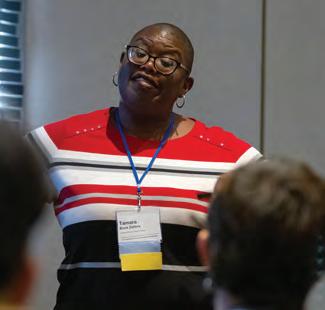
2021: Spring JEA/NSPA, Seattle
2021: Spring ACP, La Jolla, California
2021: Fall JEA/NSPA, Philadelphia
2021: Fall ACP/CMA, New Orleans
BOARD RESTRUCTURES, BYLAWS REVISED
After working on bylaw revisions for more than a year, a board committee led by Chuck Clark, Western Kentucky University, proposes changing the composition of the board, signing an affiliation agreement with the University of Minnesota and redefining investment policies. After approval, the president and president elect are elected from board membership for two-year terms rather than the chair of the UM journalism school permanently serving as the top executive.
2021
IN-PERSON EVENTS RETURN IN PHILLY
NSPA hosts the Philadelphia Storytelling Workshop as part of its Pacemaker Master Class series, marking the return of in-person scholastic journalism events. The workshop attracted approximately 625 attendees and fulfilled a contractual obligation with the Philadelphia Marriott, saving both NSPA and JEA thousands of dollars in penalties.
2022
< QUILL AND SCROLL MERGES WITH NSPA
Quill and Scroll, the international honor society for high school journalists, will joins the nation’s largest press association for high school journalists on July 1. The merger brings together two associations with historic service to scholastic journalism

100
PLUS ONE
BACK TOGETHER AT LAST
On March 3-5, 2022, in-person events returned with the ACP Spring National Media Conference, in Long Beach, California. Presenter Tamara Zellars Buck, Southeast Missouri State University, interacts with student journalists during her “No right-click allowed: How to publish without getting sued” session. Buck serves on the NSPA/ACP board of directors.
Delayed by the pandemic, NSPA/ACP celebrates its 100th anniversary during fall conventions in Washington, D.C. and St. Louis, Missouri, with special recognition ceremonies for the Pacemaker 100 — the 100 scholastic and collegiate publications earning the most Pacemaker honors during the past 100 years. At the collegiate convention, ACP honors 101 journalism educators and advocates with its inaugural ACP Pioneer Awards.
090 TIMELINE // 2020s
WOODWARD AND BERNSTEIN
Investigative journalist Bob Woodward, The Washington Post, has been a keynote speaker at fall conventions for both ACP and NSPA. He answers questions from student editors at the ACP Fall National College Media Convention, Oct. 20-23, 2016, in Washington, D.C. He also keynoted the 2014 JEA/NSPA Fall National High School Journalism Convention. In 2022, Woodward and Carl Bernstein both were keynote speakers at the ACP/CMA Fall National College Media Convention.
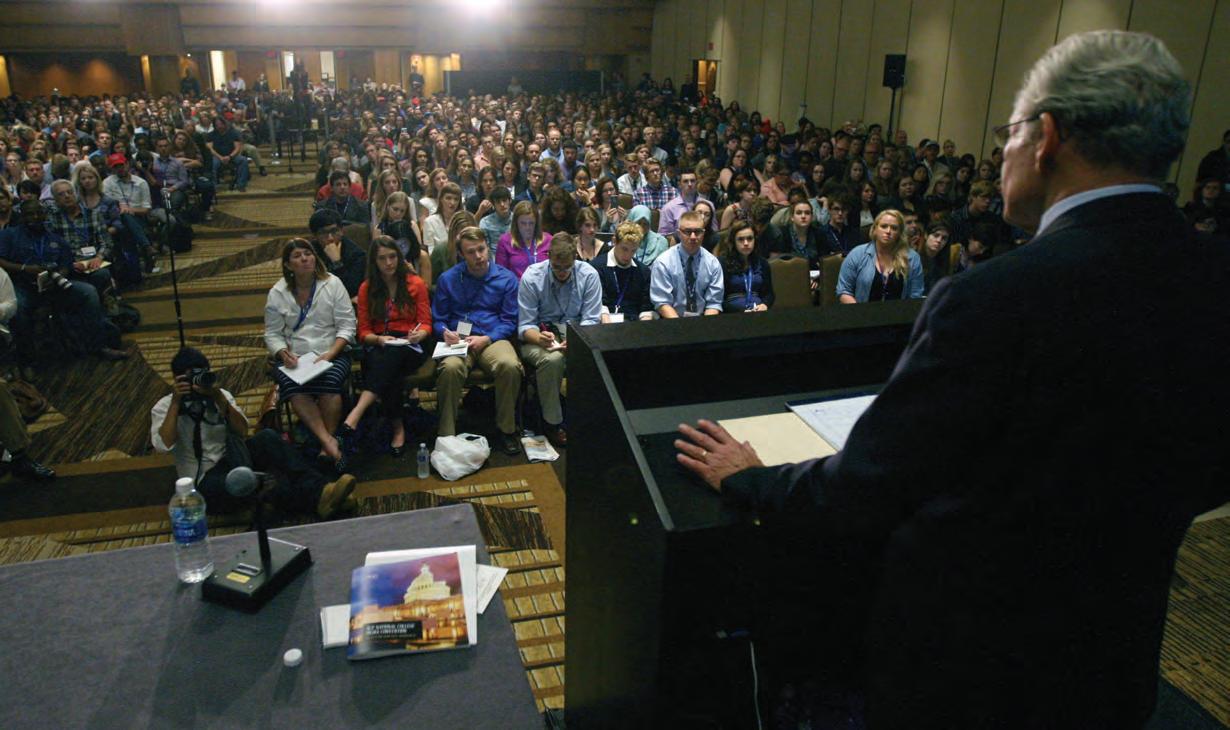
SNOWDEN SPEAKS FROM MOSCOW
On-site conventions bring together student journalists, advisers and speakers from across the nation, even overseas. In fall 2016, communications director Amber Billings recruited ACP keynote speaker Edward Snowden, expat digital whistleblower, who spoke remotely from Moscow.
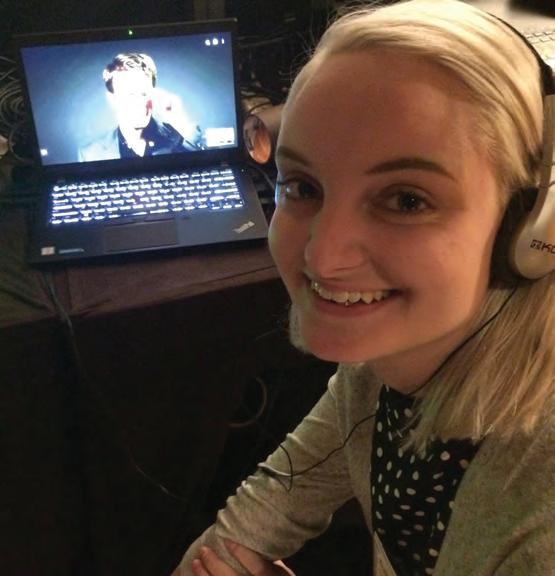
091 TIMELINE // 2020s
ALMANAC
Recapping conventions and key award-winners from the past 100 years — for the record.
96 DIRECTORS
Since 1921, 10 executive directors have guided NSPA/ACP. Fred Kildow was there in the beginning and served for 40 years from 1928-68. In the modern era, Tom Rolnicki served for 26 years from 1980-2006.
96 THE NSPA PIONEER AWARDS
To celebrate its 50th anniversary, NSPA Pioneer Awards were established with an original 50 inductees named. Fifty years later, the Pioneer remains one of the highest honors in scholastic journalism.
98 CONVENTION SITES
The organizations started with a convention in 1921, and they remain popular today. NSPA has hosted or co-hosted 130 and ACP has hosted or co-hosted 156.
103 HALL OF FAME
In 1988, NSPA/ACP inducted the first publications in the Hall of Fame. Today, there are 228 members in the NSPA Hall of Fame and 68 in the ACP Hall of Fame.
FRIENDS & PARTNER ORGANIZATIONS
CHRIS WHITLEY College Media Association President

How have you interacted with ACP?
I went to the Fall National College Media Convention as a student in 1993. I had seen all the cool places the convention had been to in previous years. That year? It was in Dallas. My hometown. I stayed with my parents, for God’s sakes! But what I lacked in adventurous travel, I more than made up for in insight. It was one of my first tastes of the larger media world around me, and it was exciting.
How do your students interact with ACP?
Through conventions and contests. Our college newspaper staff couldn’t meet for its traditional awards ceremony this year because of COVID, so I drove out and delivered our major awards, including the ACP awards, to our students personally. They were all filled with pride to receive those prestigious honors.
How does CMA’s partnership with ACP affect student media?
I think our two organizations complement each other well. CMA and ACP combine to provide services and recognition that help student media and celebrate it too. Our fall convention, which the two put on each year, is still the nation’s largest gathering of college media, and I’m so excited that we’ll finally get to celebrate it in person.
I’m the president of CMA, but I’m also an ACP member. And I’m proud to be a part of both organizations. Both serve the college media community well and should be supported.
The fact that ACP has been serving college media for 100 years is absolutely worth celebrating, and CMA congratulates ACP on that milestone.
SARAH NICHOLS Journalism Education Association President
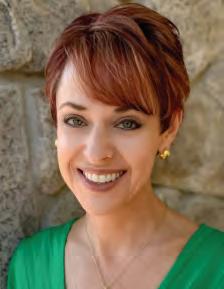
How have you interacted with NSPA?
My earliest interaction with NSPA was as a rookie high school yearbook staffer attending my first national convention in D.C. in November 1993, watching one of our editors accept a Best of Show certificate.
Seeing thousands of other students packed into row after row around us to celebrate and learn together introduced me to the idea of what a huge and exciting community existed.
In the 25+ years since then, I have thoroughly enjoyed every opportunity to learn and grow with NSPA, serving as a convention speaker at every National High School Journalism Convention except two, judging Best of Show, conducting publication critiques, authoring a past edition of the NSPA Yearbook Guidebook, serving on three or four convention local teams, attending site visits and strategic planning sessions and more.
How do your students interact with NSPA?
Attending conventions is a highlight for my students and something they talk about for years afterward. They also interact with NSPA by taking advantage of online resources, entering our publications in contests, submitting work for critique and applying for recognition through the Journalism Honor Roll, all of which shows their pride in being part of such a meaningful and prestigious national organization specific to their work in student media.
How does JEA’s partnership with NSPA affect scholastic media?
JEA’s long and rich history with NSPA has been a powerful force in the scholastic journalism community. Partnering on conventions has created opportunities to ignite a fire in student journalists from any background.
Together we’re truly sowing seeds of the journalism profession and empowering student voices.
094 ALMANAC // FRIENDS AND PARTNERS
HADAR HARRIS Student Press Law Center Executive director
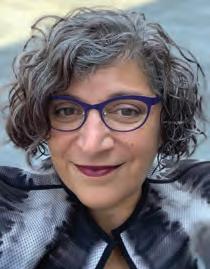
How have you interacted with NSPA and ACP?
There are a handful of organizations that SPLC considers “siblings,” and NSPA and ACP fill that cherished role. We are all laser-focused on serving student journalists and enabling them to do their jobs at the highest level. SPLC has a long history of partnership with NSPA and ACP, but when I joined SPLC five years ago, I got a quick, deep familiarity with both organizations by diving into fall conventions.
In addition to all of the media law workshops that SPLC held at my first conventions, I had the great privilege of awarding the Courage in Journalism Award and the Reveille Seven Award to bold student journalists. What an awesome time it was to help recognize incredible journalism and to work with the NSPA and ACP teams to celebrate their accomplishments!
We have deepened and expanded our relationship as NSPA and ACP have become key partners in Student Press Freedom Day and we continue to work together to ensure that the legal landscape to protect, support and defend the student press freedom rights of student journalists are realized.
How do the SPLC and NSPA/ACP work together?
The partnership between NSPA/ACP and SPLC is one both of the mind and heart.
In the early years of the SPLC, NSPA/ ACP leadership played a pivotal role through participation on the SPLC Board of Directors, and for about a decade, SPLC Staff Attorney Mike Hiestand penned a monthly It’s the Law column for NSPA/ACP publications and websites.
NSPA/ACP have also been active financial supporters of the SPLC.
The affection, support and partnership of our organizations is key to ensuring that student journalists are supported with solid legal information and provided the tools to produce bold, empowered journalism.
EDMUND J. SULLIVAN Columbia Scholastic Press Association Executive director
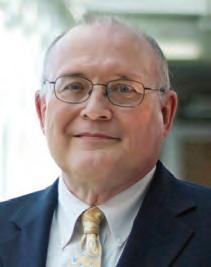
How have you interacted with NSPA and ACP?
I first came across NSPA as a high school editor in Massachusetts in the late 1960s. Although we ultimately enrolled in CSPA, I investigated NSPA’s programs and services at that time. I remember picking Columbia only because it was closer to us.
Both organizations began in the 1920s as student-practiced journalism got organized at both the state and national level. It was important to have these groups holding conferences, offering contests and critiques while giving recognition to what student editors had been doing on their own in the schools and colleges.
The group efforts elevated studentpracticed journalism beyond the walls of their schools and colleges. It also trained students in borrowing and adapting best practices from other students’ work. This helped to increase the capability and quality of student media everywhere. What are challenges have the organizations shared?
Challenge No. 1 is the slow but steady decline in importance given the student media as social media have given students many ways to express themselves and get news from varied sources.
The decline in traditional print newspapers and magazines since 2007 has also magnified the illusion that journalism dying. Newspapers are dying as we knew them, but journalism is very much alive. And the skills, techniques and ethics of the best journalistic practices are ever more needed today.
How do young people identify facts from opinion?
How do they grapple with the tidal wave of opinion on social media?
How do they understand what is important to know from what is not?
Traditional print newspapers used to offer an edited, designed presentation of fact and opinion in a quickly digested format. That neatly summed up presentation is now gone replaced by a helter skelter of largely unverified opinion
Young people, in particular, are the worse for the mass confusion that has resulted.
095 ALMANAC // FRIENDS AND PARTNERS
NSPA/ACP DIRECTORS
PIONEER AWARDS
THE HIGHEST award
NSPA offers to journalism educators, Pioneers are individuals who make substantial contributions to high school publications and journalism programs outside of their primary employment.
To celebrate its 50th anniversary, NSPA Pioneer Awards were established.
The 50 original inductees, named on Nov. 27, 1970, appear in bold. A dot indicates posthumous inductees.
Sister M. Rita Jeanne Abicht
Jeanne Acton
David Adams
Julian Adams
Logan Aimone
Ann Akers
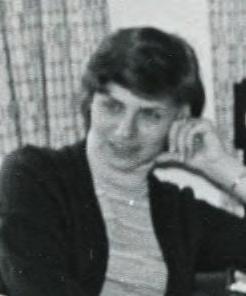
Martha Akers
Olive Allen •
Benjamin W. Allnut
Edmund C. Arnold
Mary Arnold
Robert Atwood
Dan Austin
Ellen Austin
Judy Babb
Bob Bair
Ira L. Baker
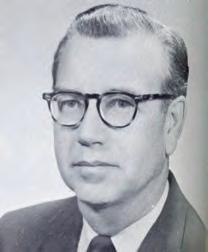

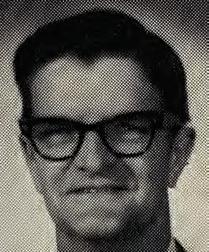
Benjamin H. Baldwin
Michelle Balmeo
Linda Barrington
Marjorie Bell
Mary Benedict
Lester G. Benz
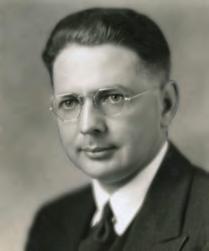
Jane Blystone
Peter Bobkowski
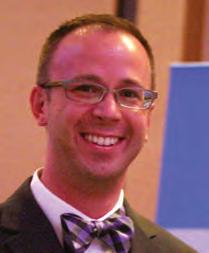

Don Bott
John Bowen
John Boyd
Diane Boyle
Regis L. Boyle
Wayne Brasler
Vicki McCash Brennan
Howard Brier •
Rick Brooks
Deanne Brown
Donald E. Brown
W. Mike Brown
Jeff Browne
Mary Elizabeth Burdette
Robert Button
Laurence R. Campbell
Marilyn K. Chapman

Pat Clark
Molly Clemons
Ron Clemons
Jolene Combs
Judith Coolidge
David Cosgrove
Kathy Craghead
James Crook
Mattie Gay Crump
Alyce Culpepper
Jeffrey Currie
John Cutsinger
Kathy Daly
Sharon Deibel
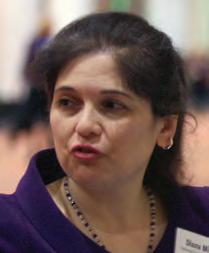
Vince DeMiero
Beth Dickey
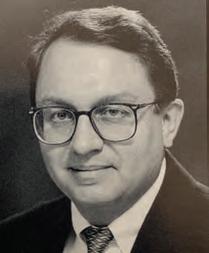
096 ALMANAC // NSPA/ACP DIRECTORS
WALLY WIKOFF 1973-75
OTTO QUALE 1968-73
E. MARION JOHNSON 1921-28
FRED KILDOW 1928-68
JEANNE BUCKEYE 1975-78
LES HOWELL 1978-79
LAURA WIDMER 2015-present
TOM ROLNICKI 1980-2006
DIANA MITSU KLOS 2013-15
LOGAN AIMONE 2007-13
Merle Dieleman
Julie Dodd
Mary Kay Downes
William Downs, Jr.
Linda Drake
Georgia Stilwell Dunn
Wayne Dunn
Jack Dvorak
Gloria Eastman
Mitch Eden
Howard Emerson
Edwin Emery
Paul Ender
Jackie Engel
Tom Engleman
Earl English
Herman A. Estrin
Carrie Faust
Brenda Feldman
Nick Ferentinos
Brenda Field
John Field
Vince Filak
Beth Fitts
Lu Chapin Flannery
Bill Flechtner
Karen Flowers
Virginia Follin
Kathy Roberts Forde
Mary Lu Foreman
Sheryl Fulton
Kelly Furnas
George Gallup Sr.
George Gallup Jr.
Arnetta Garcin
Tom Gayda
Joseph Glowacki
Tony Gomez
Mark Goodman
Brenda Gorsuch
Pat Graff
JoAnne Graham
Kim Green
Nancy Green
Robert Greenman
Dorothy D. Greer
Peggy Gregory
Ruth Marie Griggs
Kathy Habiger
Clarence W. Hach
Max Haddick
Diana Hadley
Carol Hallenbeck
H.L. Hall
Nancy Hall
Bill Hankins
Laurie Hansen
Kathleen Hansen
Glenn Hanson
Jack Harkrider
Charla Harris
Erinn Harris
Rowena Harvey
Nancy Hastings
Susan Hathaway
Bobby Hawthorne
Ann Christine Heintz
Andrea Henderson
R.D. Hendricks
Mike Hiestand
Monica Hill
Barbara Hines
Judith Hines
Richard Holden
Diane Yotsuya Honda
John Hudnall
Harold H. Herbert
Bonnie Horne
Freeman Hover
Rod Howe
Joe Humphrey
Elizabeth Hurley
Orval C. Husted •
Louis E. Ingelhart
Richard Johns
James Jordan
Paul Kandell
Linda Kane
Elwood C. Karwand
Crystal Kazmierski
Lori Keekley
Gretchen Kemp
Jack Kennedy
Linda Kennedy
Ellen Kersey
Val Kibler
Fred Kildow
Lucille Kildow
Bernard Kilgore •
Jane Kirtley
David Knight
Robert Knight
Judy Knudtson
Susan Komandosky
Bruce Konkle
Lillian Lodge Kopenhaver
Hillier Krieghbaum
Konnie Krislock
Carol Lange
C.J. “Skip” Leabo
Kathy Leabo
Janet Levin
Pete LeBlanc
Mark Levin
Gary Lindsay
Richard Lloyd
J. Grady Locklear
Dick LoPachin
Gary Lundgren
Roberta Mace
James Magmer
Leland Mallett
Aaron Manfull
Sharon Martin
Dave Massy
Susan Massy
Steve Matson
Jim McCrossen
Jim McGonnell
Vida B. McGriffin
Richard McNeill
Dorothy McPhillips
C.J. Medlin •
Rob Melton
Carl G. Miller
Bill Mohn
Amy Morgan
Dan Moore
Shirley Moravec
Betty Morton
John Mulligan •
Joseph M. Murphy
Mark Murray
Jeff Nardone
Ed Nell
Terry Nelson
Mark Newton
Casey Nichols
Sarah Nichols
Steve O’Donoghue
Lori Oglesbee
Gloria Olman
Charles O’Malley
Sarah Ortman
J.L. O’Sullivan
Mary Patrick
J.F. Paschal
N.S. Patterson
Nancy Patterson
Cheryl Pell
Meghan Percival
Candace Perkins
Terry Peterson
Kay Phillips
Marci Pieper
Wayna Polk
Margaret Popham •
Homer A. Post
Hazel Glenn Presson
Mary Pulliam
Linda Puntney
Otto W. Quale
Kristi Rathbun
Betsy Pollard Rau
DeWitt C. Reddick
Sally Renaud
Judy Robinson
Mabel E. Robrock
Debra Rothenberger
Martha Rothwell
Charles E. Savedge
Robin Gibson Sawyer
Laura Schaub
Kathy Schrier
John B. Schrodt •
Vicki Scorsone
Albert Scroggins, Jr.
Tracy Anne Sena
Ellen Sengenberger •
Alyce Rogers Sheetz
Gloria Shields
Linda Shockley
Michael Simons
Becky Sipos
Kenson Siver
Sigmund Sluszka
Helen Smith
Nancy Y. Smith
Linda Smoley
Margaret Sorrows
Howard Spanogle
Mary Sparks
L. Curtis Sheffield
Paul Schweiger
Harold Spears
Mary Still •
F. Kenneth Stratton
Lynn Strause
Jim Streisel
Edmund Sullivan
Paul S. Swensson
Randy Swikle
Dow Tate
George Taylor
H.C. Taylor •
Sherri Taylor
Wilma Taylor
Barbara Thill
Albert R. Tims
Cindy Todd
Robert Tottingham
Carl Towley •
Charles Troxell •
Craig Trygstad
Carol Underberger
Rod Vahl
Fern Valentine
Carl Vandermeulen
Ben Van Zante
Ann Visser
Randy Vonderheid
DeWitt Wallace
Bill Ward
Bruce Watterson
Chris Waugaman
Marilyn Weaver
Alan Weintraut
David Weisenburger
Lorraine Wellenstein
Carmen Wendt
Ray Westbrook
John Wheeler
Anne Whitt
Laura Widmer
Tom Winski
Bradley Wilson
Harold Wilson
Jack Wilson
Scott Winter
Jan Wiseman
Sandy Woodcock
Virginia Woodring
Shirley Yaskin
Joanna Zander
Mitch Ziegler
Stan Zoller
Kathleen Zwiebel
PIONEER AWARDS
TOCELEBRATE its 100th year, ACP Pioneer Awards were established by honoring distinguished journalism educators who have made substantial contributions to ACP and provided exceptional leadership in their college media programs.
The original 101 inductees, awarded at the Fall National Media Conference in Washington, D.C., on Oct. 28, 2022, are highlighted on pages 13-14. Additional recipients will be named each year.
097 ALMANAC // NSPA PIONEER AWARDS
CONVENTION SITES
SINCE 1925, with the exception of 197880, National Scholastic Press Association and Journalism Education Association have met jointly at least once a year. During this time, the name of the adviser organization changed several times and the name of the press association changed once.
In 1928, the NSPA name was adopted. In 1963, the JEA name was adopted.
In 1964, on the cover of the 37th convention program, the current names of both organizations appear together for the first time.
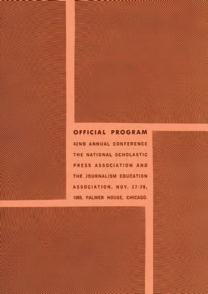
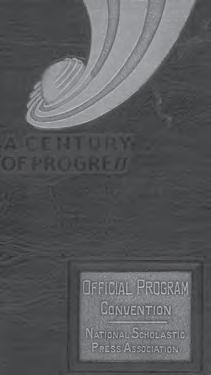

From 1953-60, a summer publications conference was held rather than a convention during the school year. The summer conference rotated from college campuses (University of Minnesota and University of Michigan) to hotel locations (Chicago and Washington, D.C.). In 1958, NSPA did not host a conference.
In 1970, the first spring convention was co-hosted by NSPA and JEA and continued through 1977.
From 1978-80, NSPA and JEA host separate conventions.
In 1981, NSPA and JEA return to co-sponsoring the fall convention.
In 1990, NSPA and JEA co-host the spring convention, marking the return of two co-hosted conventions a year.
1921
April 22-23, Madison, Wisconsin, University of Wisconsin
Dec. 2-3, Madison, Wisconsin, University of Wisconsin
1922
Dec. 1-2, Madison, Wisconsin, University of Wisconsin
1923
Nov. 30-Dec. 1, Madison, Wisconsin, University of Wisconsin
1924
Nov. 28-29, Madison, Wisconsin, University of Wisconsin
1925
Nov. 27-28, Madison, Wisconsin, University of Wisconsin
1926 no convention
1927 no convention
1928 no convention
1929
April 11-13, Minneapolis, Nicollet Hotel
Dec. 5-7, Chicago, Knickerbocker Hotel
1930
Dec. 4-6, Cleveland, Western Reserve University
1931
Dec. 3-5, Chicago, Palmer House
1932
Nov. 3-5, Cincinnati, Hotel Gibson
1933
Oct. 12-14, Chicago, Hotel LaSalle
1934
Oct. 11-13, Kansas City, Missouri, Hotel Muehlebach and Hotel Kansas Citian
1935
Dec. 5-7, Milwaukee, Hotel Schroeder
1936
Dec. 3-5, Detroit, BookCadillac Hotel
1937
Dec. 2-4, Des Moines, Iowa, Fort Des Moines Hotel
1938
Nov. 10-12, Indianapolis, Hotel Mezzanine
1939
Nov. 9-11, Chicago, Stevens Hotel
1940
Nov. 28-30, Cleveland, Statler Hotel and Cleveland Hotel
1941
canceled/World War II
1942
canceled/World War II
1943
canceled/World War II
1944
canceled/World War II
1945
canceled/World War II
1946
Nov. 28-30, Milwaukee, Hotel Schroeder
1947
Nov. 28-29, Cleveland, Statler Hotel and Cleveland Hotel
1948
Nov. 26-27, French Lick, Indiana, French Lick Springs Hotel
1949
Nov. 25-26, Chicago, Stevens Hotel
1950
Nov. 24-25, Chicago, Stevens Hotel
1951
Nov. 23-25, Topeka, Kansas, Topeka High School
1952
Nov. 28-30, Chicago, Conrad Hilton Hotel
1953
Aug. 26-28, Minneapolis, University of Minnesota
1954
Aug. 24-26, Minneapolis, University of Minnesota
1955
Aug. 23-25, Chicago, Conrad Hilton Hotel
1956
Aug. 21-23, Ann Arbor, Michigan, University of Michigan
1957
Aug. 22-24, Chicago, Conrad Hilton Hotel
1958 canceled
1959
Aug. 27-29, Washington, D.C., Hotel Mayflower
1960
Aug. 25-27, Chicago, Conrad Hilton Hotel
1961
Nov. 23-25, Chicago, Conrad Hilton Hotel
1962
Nov. 22-24, Chicago, Conrad Hilton Hotel
1963
Nov. 28-30, Chicago, Conrad Hilton Hotel
1964
Nov. 26-28, Chicago, Conrad Hilton Hotel
1965
Nov. 26-27, Chicago, Conrad Hilton Hotel
1966
Nov. 25-26, Chicago, Edgewater Beach
1967
Nov. 22-25, Chicago, Edgewater Beach
1968
Nov. 28-30, Chicago, Palmer House
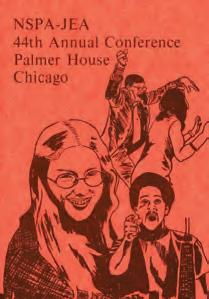
1969
Nov. 27-29, Chicago, Palmer House
ALMANAC // NSPA CONVENTION SITES
098
1925, MADISON, WISCONSIN
1933, CHICAGO
1969, CHICAGO
1971, CHICAGO
1970
April 17-19, Anaheim, California, Convention Center
Nov. 26-28, Chicago, Palmer House
1971
April 16-18, San Francisco, Sheraton-Palace
Nov. 25-27, Chicago, Palmer House
1972
April 14-16, Los Angeles, International

Nov. 23-25, Chicago, Palmer House
1973
April 6-8, Portland, Oregon, Hilton
Nov. 22-24, Atlanta, Hyatt House
1974
April 5-7, San Francisco, Hilton
Nov. 28-30, Chicago, McCormick Inn
1975
April 4-6, Los Angeles, Marriott
Nov. 27-29, Chicago, Palmer House
1976
April 9-11, Portland, Oregon, Sheraton Inn
Nov. 25-27, San Antonio, Convention Center
1977
April 15-17, San Francisco, Hilton
Nov. 25-27, Kansas City, Missouri, Crown Center Hotel
1978
Oct. 6-8, Minneapolis, Radisson
1979
Sept. 27-29, Chicago, Palmer House
1980
Nov. 28-30, Chicago, Palmer House
1981
Nov. 6-8, Kansas City, Missouri, Radisson
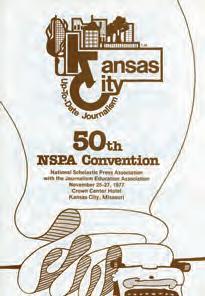
Muehlebach
1982
Nov. 19-21, Chicago, Marriott
1983
Nov. 17-19, St. Louis, Missouri, Riverfront Towers
1984
Nov. 9-11, Little Rock, Arkansas, Excelsior
1985
Nov. 22-24, Cleveland, Bond Court
1986
Nov. 21-23, Chicago, Holiday Inn/ Hyatt Regency
1987
Nov. 20-22, Kansas City, Missouri, Westin Crown Center
1988
Nov. 18-20, Washington, D.C., Hyatt Regency and Quality Inn
1989
Nov. 2-4, St. Louis, Missouri, Marriot Pavilion
1990
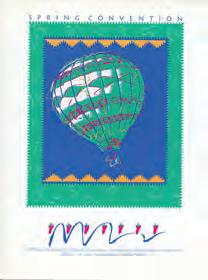
March 30-April 1, Seattle, Red Lion
Oct. 25-28, Indianapolis, Hyatt Regency
1991
April 12-14, Albuquerque, New Mexico, Marriott/Ramada
Nov. 15-17, Chicago, Hyatt Regency
1992
April 10-12, Denver, Radisson
Nov. 19-22, Columbus, Ohio, Hyatt Regency
1993
April 22-25, Long Beach, California, Hyatt & Sheraton
Nov. 18-21, Washington, D.C., Renaissance Techworld Hotel
1994
April 21-24, Portland, Oregon, Hilton & Marriott
Nov. 17-20, Dallas, Hyatt Reunion Center
1995
April 6-8, San Diego, Hyatt
Nov. 16-19, Kansas City, Missouri, Hyatt Regency Crown Center
1996
April 11-14, San Francisco, Hyatt Regency Embarcadero
Nov. 14-17, Chicago, Hyatt
1997
April 17-20, Phoenix, Hyatt Regency
Nov. 13-16, St. Louis, Missouri, Adams Mark
1998
April 16-19, Seattle, Sheraton & Doubletree
Nov. 19-22, Washington, D.C., Marriott Wardman Park
1999
April 8-11, Albuquerque, New Mexico, Hyatt/ Doubletree/ La Posada
Nov. 18-21, Atlanta, Hilton
2000
April 6-9, Anaheim, California, Marriot & Hilton
Nov. 16-19, Kansas City, Missouri, Hyatt Regency & Westin
2001
April 5-8, San Francisco, Marriott
Nov. 8-11, Boston, Sheraton
2002
April 4-7, Phoenix, Hyatt Regency
Nov. 21-24, Dallas, Hyatt Reunion Center
2003
April 10-13, Portland, Oregon, Convention Center
Nov. 20-23, Washington, D.C., Washington Hilton & Towers
2004
April 1-4, San Diego, Town and Country
Nov. 18-21, Atlanta, Hyatt Regency
2005
April 7-10, Seattle, Sheraton
Nov. 10-12, Chicago, Hyatt Regency
2006
April 20-23, San Francisco, Hilton
Nov. 9-12, Nashville, Tennessee, Gaylord Opryland
2007
April 12-15, Denver, Hyatt
Nov. 8-11, Philadelphia, Marriott
2008
April 17-20, Anaheim, California, Marriot
Nov. 13-16, St. Louis, Missouri, Renaissance
2009
April 16-19, Phoenix, Hyatt
Nov. 12-15, Washington, D.C., Marriott Wardman Park
2010
April 15-18, Portland, Oregon, Oregon Convention Center
Nov. 11-14, Kansas City, Missouri, Marriott
2011
April 14-17, Anaheim, California, Marriott
Nov. 17-20, Minneapolis, Hilton/Hyatt/ Convention Center
2012
April 12-15, Seattle, Sheraton/Washington State Convention Center
Nov. 15-18, San Antonio, Marriott Rivercenter/ Riverwalk, Gonzalez Convention Center
2013
April 25-28, San Francisco, Marriott Marquis
Nov. 14-17, Boston, Sheraton Boston, Hynes Convention
2014
April 10-13, San Diego, Hilton San Diego Bayfront
Nov. 6-9, Washington, D.C., Marriott Wardman Park
2015
April 16-19, Denver, Sheraton
Nov. 12-15, Orlando, Florida, Walt Disney World Dolphin
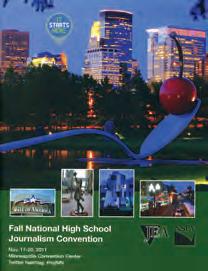
099 ALMANAC // NSPA CONVENTION SITES
1973, PORTLAND, OREGON
1977, KANSAS CITY, MISSOURI
1991, ALBUQUERQUE, N.M.
Continued >
2011, MINNEAPOLIS
2016
April 14-17, Los Angeles, Westin Bonaventure
Nov. 10-13, Indianapolis, J.W. Marriott
2017
April 6-9, Seattle, Sheraton Seattle and Washington State Convention Center
Nov. 16-19, Dallas, Hyatt Regency
2018
April 12-14, San Francisco, Marriott Marquis
Nov. 1-4, Chicago, Hyatt Regency
2019
April 25-27, Anaheim, California, Hilton
Nov. 21-24, Washington, D.C., Marriott Wardman Park
2020
April 16-18, Nashville, Tennessee (canceled COVID 19 pandemic)
Minneapolis Live! NSPA virtual awards ceremony
Nov. 19-21, Orlando, Florida (canceled COVID 19 pandemic),virtual convention
2021
March 15-May 15, Seattle, (canceled COVID 19 pandemic), virtual convention
Nov. 1-Jan. 15, Philadelphia, (canceled COVID 19 pandemic), virtual convention
Nov. 11-13, Philadelphia, Philadelphia Marriott, NSPA Storytelling Workshop
2022
April 7-9, 2022, Los Angeles, Westin Bonaventure
Nov. 10-13, 2022, St. Louis, Missouri, Marriott St. Louis Grand
CONVENTION SITES
COLLEGE
JOURNALISTS were part of NSPA conventions starting in 1921.
The ACP division was launched in 1933, and the first ACP convention was in 1935.
Previous convention names included the National College Publications Conference and the National Conference for the College Press.
At the Detroit ACP convention in 1955, about 50 collegiate advisers formed the National Council of College Publications Advisers.
The organization became College Media Advisers in 1984 and the College Media Association in 2011.
Each fall since 1956, ACP and CMA co-sponsor the nation’s largest convention for collegiate student media. In 2016, the organizations hosted separate conventions with ACP in Washington, D.C, and CMA in Atlanta. A joint convention returned in 2017 in Dallas and continues in 2022.
In 1985, ACP added a spring Midwinter National Journalism Convention, usually held in California.
In 1994, ACP added a regional Best of the Midwest conference generally held in February or March in Minneapolis.
1921
April 22-23, Madison, Wisconsin, University of Wisconsin
1921
Dec. 2-3, Madison, Wisconsin, University of Wisconsin
1922
Dec. 1-2, Madison, Wisconsin, University of Wisconsin
1923
Nov. 30-Dec. 1, Madison, Wisconsin, University of Wisconsin
1924
Nov. 28-29, Madison, Wisconsin, University of Wisconsin
1925
Nov. 27-28, Madison, Wisconsin, University of Wisconsin
1926
1927
1928
1929
April 11-13, Minneapolis, Nicollet Hotel
Dec. 5-7, Chicago, Knickerbocker Hotel
1930
Dec. 4-6, Cleveland, Western Reserve University
1931
Dec. 3-5, Chicago, Palmer House
1932
Nov. 3-5, Cincinnati, Hotel Gibson
1933
Oct. 12-14, Chicago, Hotel LaSalle
1934
Oct. 11-13, Chicago, Bismark Hotel
1935
Oct. 17-19, Chicago, Medinah Club
1936
Oct. 29-31, Louisville, Kentucky, Brown Hotel
1937
Oct. 14-16, Chicago, Medinah Club
1938
Nov. 3-4, Cincinnati, Hotel Gibson
1939
Oct. 26-28, Des Moines, Iowa, Fort Des Moines Hotel
1940
Nov. 7-9, Detroit, Book Cadillac Hotel
1941
Nov. 20-22, St. Louis, Missouri, Statler Hotel
1942
Nov. 5-7, Chicago, Knickerbocker Hotel
1943 canceled/World War II
1944 canceled/World War II
1945 canceled/World War II
1946
Oct. 24-26, Chicago, Hotel Continental
1947
Oct. 23-25, Minneapolis, Hotel Nicollet
1948
Oct. 21-23, Columbus, Ohio, Deshler-Wallick Hotel
1949
Oct. 13-15, Detroit, Hotel Statler
1950
Nov. 2-4, Chicago, Edgewater Beach Hotel
1951
Oct. 18-20, Pittsburgh, Hotel William Penn
1952
Oct. 23-25, New York, Hotel Statler
1953
Oct. 15-17, Chicago, Morrison Hotel
Nov. 5-6, Los Angeles, Ambassador Hotel
1954
Oct. 21-22, Washington, D.C., Hotel Statler
1955
Nov. 17-19, Detroit, Hotel Statler
1956
Nov. 8-10, Cleveland, Hotel Statler
1957
Nov. 7-9, New York, Hotel New Yorker
1958
Nov. 13-15, Chicago, Conrad Hilton
1959
Nov. 12-14, New York, Hotel New Yorker
1960
Nov. 21-23, Chicago, Conrad Hilton
1961
Nov. 2-4, Miami Beach, Florida, Hotel Fontainebleu
1962
Oct. 25-27, Detroit, Sheraton-Cadillac Hotel
1963
Oct. 17-19, New York, Hotel New Yorker
1964
Oct. 22-24, Chicago, Conrad Hilton
1965
Oct. 21-23, San Francisco, Sheraton Palace
1966
Oct. 20-22, Philadelphia, Benjamin Franklin
1967
Oct. 19-21, Chicago, Conrad Hilton
1968
Oct. 31- Nov.2, New York, Waldorf Astoria Hotel
100 ALMANAC // ACP CONVENTION SITES
convention
no
no convention
no convention
> NSPA Convention Sites cont’d
1969
Oct. 30- Nov. 1, Miami Beach, Florida, Americana Hotel
1970
Nov. 5-7, Minneapolis, Leamington
1971
Oct. 21-23, Dallas, Statler Hilton
1972
Nov. 2-4, New York, Statler Hilton
1973
Nov. 1-3, Chicago, Palmer House
1974
Oct. 24-26, Hollywood, Florida, Diplomat Hotel
1975
Oct. 30- Nov. 1, St. Louis, Missouri, Chase-Park Plaza
1976
Nov. 4-6, Chicago, Palmer House
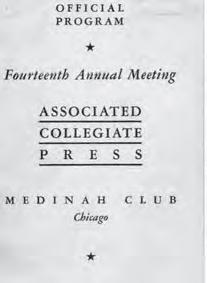
1977
Oct. 27-29, New Orleans, Braniff Place

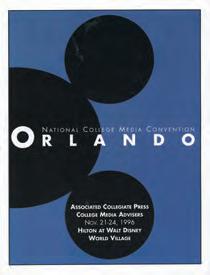
1978
Oct. 26-28, Houston, Shamrock Hilton
1979
Oct. 25-27, San Francisco, Sheraton Palace
1980
Oct. 23-25, Chicago, Hyatt Regency
1981
Oct. 29-31, Miami Beach, Florida, Carillon Beach
1982
Oct. 29-31, St. Louis, Missouri, Chase-Park Plaza
1983
Nov. 2-5, Chicago, Hyatt Regency
1984
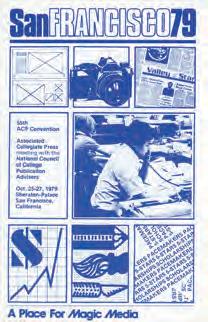
Oct. 24-27, Louisville, Kentucky, Galt House
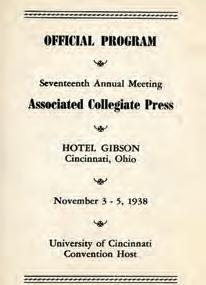
1985
Feb. 8-10, Anaheim, California, Marriott
Oct. 31- Nov. 3, Dallas, Lincoln Hotel
1986
Feb. 14-16, Los Angeles, University Hilton
Nov. 6-9, Washington, D.C., Capitol Hill Hyatt Regency
1987
Feb. 13-15, Long Beach, California, Hyatt Regency
Oct. 29- Nov. 1, St. Louis, Missouri, Sheraton
1988
Feb. 12-14, San Francisco, Galleria Park
Oct. 26-29, Atlanta, Hyatt Regency
1989
Feb. 17-19, Los Angeles, Hilton, Feb. 17-19, 1989
Nov. 16-19, New Orleans, Marriott
1990
Feb. 16-18, San Francisco, Holiday Inn Golden Gateway
Nov. 1-4, Washington, D.C., Hyatt Regency
1991
Feb. 15-17, Costa Mesa, California, Westin South Coast Plaza
Oct. 31- Nov. 3, Denver, Marriott
1993
Feb. 12-14, San Francisco, Holiday Inn Golden Gateway
Oct. 28-31, Dallas, Hyatt Reunion Center
1994
Feb. 18-20, Marina Del Rey, California, Doubletree
Feb. 25-27, Minneapolis, Park Inn International (Best of the Midwest)
Nov. 3-6, New Orleans, Sheraton
1995
Feb. 24-26, San Diego, Doubletree
March 3-5, Minneapolis, Park Inn International (Best of the Midwest)
Nov. 2-5, Washington, D.C., Hilton
1996
Feb. 23-25, San Francisco, Holiday Inn Golden Gateway
Feb. 29-March 3, Minneapolis, Regal
Nov. 21-24, Orlando, Florida, Hilton Disney
1997
Feb. 21-23, Huntington Beach, California, Hilton Waterfront
March 7-9, Minneapolis, Regal (Best of the Midwest)
Oct. 29-Nov.2, Chicago, Sheraton & Towers
1998
Feb. 27-March 1, San Francisco, Holiday Inn Golden Gateway
March 13-15, Milwaukee, Wisconsin (Best of the Midwest)
Nov. 5-8, Kansas City, Missouri, Hyatt Regency
1999
Feb. 25-28, Huntington Beach, California, Hilton Waterfront
March 5-7, Minneapolis, Doubletree Mall of America (Best of the Midwest)
Oct. 28-31, Atlanta, Westin Peachtree Plaza
2000
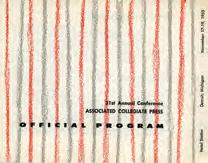
Feb. 24-27, Seattle, Doubletree
March 3-5, Minneapolis, Hilton & Towers (Best of the Midwest)
Nov. 9-12, Washington, D.C., Grand Hyatt
2001
Feb. 22-25, San Francisco, Holiday Inn Golden Gateway
March 2-4, Minneapolis, Regal (Best of the Midwest)
Oct. 25-28, New Orleans, Hyatt
2002

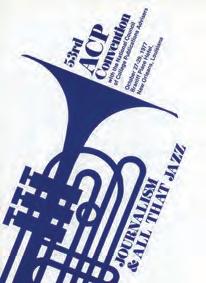
Feb. 28-March 2, Los Angeles, Hyatt
March 8-10, Minneapolis, Radisson Plaza (Best of the Midwest)
Oct. 31- Nov. 3, Orlando, Florida, Hyatt
101 ALMANAC // ACP CONVENTION SITES
1977, NEW ORLEANS
1979, SAN FRANCISCO
1996, ORLANDO, FLORIDA
1997, CHICAGO
1935, CHICAGO
1938, CINCINNATI
1955, DETROIT
Continued >
1970, MINNEAPOLIS
2003
Feb. 28-March 2, Minneapolis, Marriott City Center (Best of the Midwest)
March 6-9, Seattle, Madison Renaissance
Nov. 5-9, Dallas, Hyatt Regency
2004
Feb. 27-29, Minneapolis, Hyatt Regency (Best of the Midwest)
March 4-7, Las Vegas, Alexis Park Hotel
Nov. 3-7, Nashville, Tennessee, Renaissance
2005
Feb. 24-27, San Francisco, Holiday Inn Golden Gateway
March 4-6, Minneapolis, Crowne Plaza Northstar (Best of the Midwest)
Oct. 26-30, Kansas City, Missouri, Hyatt Regency
2006
Feb. 17-19, Minneapolis, Marriott City Center (Best of the Midwest)
March 2-5, Los Angeles, Sheraton Universal
Oct. 25-29, St. Louis, Missouri, Adams Mark
2007
Feb. 16-18, Minneapolis, Crowne Plaza Northstar (Best of the Midwest)
March 8-11, Portland, Oregon, Marriott Downtown
Oct. 24-28, Washington, D.C., Hilton
2008
Feb. 15-17, Minneapolis, Hilton (Best of the Midwest)
Feb. 28-March 2, San Francisco, Holiday Inn
Golden Gateway
Oct. 29- Nov. 2, Kansas City, Missouri, Marriott
2009
Feb. 20-22, Minneapolis, Crowne Plaza Northstar (Best of the Midwest)
Feb. 26-March 1, San Diego, Marriott Mission Valley
Oct. 28- Nov. 1, Austin, Texas, Hilton
2010
Feb. 12-14, Minneapolis, Marriott City Center (Best of the Midwest)
Feb. 25-28, Phoenix, Arizona, Wyndham
Oct. 27-31, Louisville, Kentucky, Galt House
2011
Feb. 11-13, Minneapolis, Marriott City Center (Best of the Midwest)
March 3-6, Los Angeles, Renaissance Hollywood
Oct. 26-30, Orlando, Florida, Renaissance SeaWorld
2012
Feb. 10-12, Minneapolis, Marriott City Center (Best of the Midwest)
March 1-4, Seattle, Renaissance
Oct. 31- Nov. 4, Chicago, Sheraton & Towers
2013
Feb. 8-10, Minneapolis, Radisson Plaza (Best of the Midwest)
Feb. 28-March 3, San Francisco, Westin Market Street
Oct. 23-27, New Orleans, Marriott
2014
Feb. 7-9, Minneapolis, Radisson Plaza (Best of the Midwest)
Feb. 27-March 2, San Diego, Catamaran Resort
Oct. 29- Nov.2, Philadelphia, Marriott
2015
Feb. 6-8, Minneapolis, Radisson Blu (Best of the Midwest)
Feb. 26-March 1, Los Angeles, Sheraton Universal Hollywood
Oct. 28- Nov. 1, Austin, Texas, Hilton
2016
Jan. 29-31, Minneapolis, Millennium Hotel (Best of the Midwest)
Feb. 18-21, Los Angeles, Sheraton Universal Hollywood
Oct. 20-23, Washington, D.C., Grand Hyatt
2017
Feb. 17-19, Minneapolis, Millennium Hotel (Best of the Midwest)
March 2-5, San Francisco, Hyatt Regency
Oct. 25-29, Dallas, Sheraton
2018
Feb. 16-18, Minneapolis, Millennium Hotel (Best of the Midwest)
March 1-3, Long Beach, California, Hyatt Regency
Oct. 25-28, Louisville, Kentucky, Galt House Hotel
2019
Feb. 15-17, Minneapolis, Millennium Hotel (Best of the Midwest)
Feb. 28-March 2, La Jolla, California, Hyatt Regency
Oct. 31- Nov. 3, Washington, D.C., Grand Hyatt
2020
Feb. 21-23, Minneapolis, Millennium Hotel (Best of the Midwest)
Feb. 27-29, San Francisco, Hyatt Regency
Oct. 22-25, Atlanta (canceled COVID 19 pandemic),virtual convention
2021
February, (canceled COVID 19 pandemic), (Best of the Midwest)
March 3-5, (canceled COVID 19 pandemic), virtual convention
Oct. 14-16, New Orleans (canceled COVID 19 pandemic), virtual convention
2022
February, Pandemic cancellation (Best of the Midwest)
March 3-5, Long Beach, Hyatt Regency
Oct. 27-30, Washington D.C., Grand Hyatt DC
HALL OF FAME
THE NSPA Hall of Fame represents sustained excellence by scholastic media. Publications on this list have qualified by earning 10 All-American ratings from the NSPA Critique Service within an 11-year span.
In 1988, 13 publications were charter members and are indicated in green.
NEWSPAPERS (ALPHABETICAL
BY STATE AND CITY)
DEMON DISPATCH, Greenway High Schoola, Phoenix, Arizona (2003)
TRUMPETEER, Catalina High School, Tucson, Arizona (2000)
THE CRUSADER, Salpointe Catholic High School, Tucson, Arizona (2005)
THE MOOR, Alhambra (California) High School (2011)
BLUE & GOLD, Center High School, Antelope, California (2006)
BLUE & WHITE, Bakersfield (California) High School (2002)
HIGHLIGHTS, Beverly Hills (California) High School (2002)
THE EPITAPH, Homestead High School, Cupertino, California (1988)
THE CHARGER, Bullard High School, Fresno, California (2002)
THE GAZETTE, Granite Bay (California) High School (2009)
THE HIGHLANDER, McLean (California) High School (2006)
SPARTAN SCROLL, Schurr High School, Montebello, California (2004)
CAMPANILE, Palo Alto (California) High School (2004)
HIGH TIDE, Redondo Union High School, Redondo Beach, California (2011)
THE CHRONICLE, HarvardWestlake School, Studio City California (2002)
102 ALMANAC // ACP CONVENTION SITES, NSPA HALL OF FAME
> ACP Convention Sites cont’d
THE BROADVIEW, Convent of the Sacred Heart High School, San Francisco, California (2016)
THE LOWELL, Lowell High School, San Francisco, California (2001)
CHARGER ACCOUNT, Leland High School, San Jose, California (2004)
THE STAGG LINE, Amos Alonzo Stagg High School, Stockton, California (2005)
THE LANCER, Thousand Oaks (California) High School (2010)
SCHOLAR & ATHLETE, Tracy (California) Joint Union High School (2002)
ARAPAHOE HERALD, Arapahoe High School, Centennial, Colorado (2004)
ROCKY MOUNTAIN HIGHLIGHTER, Rocky Mountain High School, Fort Collins, Colorado (2008)
THE ORANGE & BLACK, Grand Junction (Colorado) High School (2003)
HIGHLIGHTS, Coral Gables (Florida) Senior High School (1993)
PAW STREET JOURNAL, Dr. Phillips High School, Orlando, Florida (2002)
THE PANTHER, Miami Palmetto High School, Pinecrest, Florida (2002)
THE SOUTHERNER, Henry W. Grady High School, Atlanta, Georgia (2012)
THE TOM TOM, Antioch (Illinois) Community High School (2002)
HY NEWS, Belleville (Illinois) West High School (2004)
U-HIGH MIDWAY, University High School, Chicago, Illinois (1988)
YORK-HI, York Community High School, Elmhurst, Illinois (1994)
DEVILS’ ADVOCATE, Hinsdale (Illinois) Central High School (2003)
THE LION, Lyons Township High School, La Grange, Illinois (1988)
THE CENTRAL TIMES, Naperville (Illinois) Central High School (2001)
TRAPEZE, Oak Park and River Forest High School, Oak Park, Illinois (1993)
SPOKESMAN, Wheeling (Illinois) High School (1988)
THE HILITE, Carmel (Indiana) High School (2002)
THE SPARTANA, Homestead High School, Fort Wayne, Indiana (2006)
CUB REPORTER, Lawrence Central High School, Indianapolis (2004)
SPARTAN SHIELD, Pleasant Valley High School, Bettendorf, Iowa (1998)
THE ECHOES, Abraham Lincoln High School, Council Bluffs, Iowa (1988)
BEAK ‘N EYE, Davenport (Iowa) West High School (2004)
THE LITTLE HAWK, Iowa City (Iowa) High School (1994)
CUB TRACKS, Humboldt (Kansas) High School (2000)
PLAY, Maize (Kansas High School (2001)
NEWTONIAN, Newton (Kansas) High School (2002)
THE MISSION, Shawnee Mission North High School, Overland Park, Kansas (1996)
THE PANTHER PAUSE, Phillipsburg (Kansas) High School (2005)
THE HARBINGER, Shawnee Mission East High School, Prairie Village, Kansas (2016)
THE JAGWIRE, Mill Valley High School, Shawnee, Kansas (2016)
THE TIGER PRINT, Blue Valley High School, Stilwell, Kansas (2002)
PALADIN, Kapaun Mount Carmel High School, Wichita, Kansas (2004)
NORTHWEST EXPLORER, Wichita (Kansas) Northwest High School (2001)
THE BLACK & WHITE, Walt Whitman High School, Bethesda, Maryland (1991)
BUCS’ BLADE, Grand Haven (Michigan) High School (2002)
THE TOWER, Grosse Pointe South High School, Grosse Pointe Farms, Michigan (1988)
THE ECHO, St. Louis Park (Minnesota) High School (1988)
THE CORRAL, Parkway Central High School, Chesterfield, Missouri (2002)
GLOBE, Clayton (Missouri) High School (2006)
THE ROCK, Rock Bridge Senior High School, Columbia, Missouri (2009)
THE SPIRIT, Truman High School, Independence, Missouri (1988)
RED AND BLACK, Jefferson City (Missouri) High School (2001)
THE NORTHMEN’S LOG, Oak Park High School, Kansas City, Missouri (1989)
TROJAN, Park Hill High School, Kansas City, Missouri (1996)
THE KIRKWOOD CALL, Kirkwood (Missouri) High School (1988)
NORTH STAR, Francis Howell North High School, St. Charles, Missouri (2013)
PANORAMA, Ladue Horton Watkins High School, St. Louis, Missouri (2003)
THE INIWA, Great Falls (Montana) High School (2005)
LANCE, Westside High School, Omaha, Nebraska (1988)
THE EXCALIBUR, McQueen High School, Reno, Nevada (2004)
WINGSPAN, West Henderson High School, Hendersonville, North Carolina (2003)
SUDHIAN, Fargo (N.D.) South High School (2001)
THE TORCH, Bexley (Ohio) High School (1994)
PURSUIT, Centerville (Ohio) High School (1991)
BLUE & GOLD, Findlay (Ohio) High School (2003)
LAKEWOOD TIMES, Lakewood (Ohio) High School (1996)
SPARK, Lakota East High School, Liberty Township, Ohio (2010)
THE AXE, South Eugene High School, Eugene, Oregon (1990)
CRIMSON TIMES, Glencoe High School, Hillsboro, Oregon (2004)
THE MILWAUKIAN, Milwaukie (Oregon) High School (1989)
VERDICT, Marshall High School, Portland, Oregon (2002)
STATESMAN, Woodrow Wilson High School, Portland, Oregon (1991)
STINGER, Irmo High School, Columbia, S.C. (2001)
TRIBAL TRIBUNE, Wando High School, Mt. Pleasant, S.C. (2010)
BRANDON VALLEY ECHO, Brandon (South Dakota) Valley High School (2003)
PURPLE AND GOLD, Watertown (South Dakota) High School (1989)
THE SHIELD, McCallum High School, Austin, Texas (1992)
EAGLE EYE, DeSoto (Texas) High School (2004)
PANTHER PRINTS, Duncanville (Texas) High School (2004)
THE RIDER, Legacy High School, Mansfield, Texas (2018)
TJTODAY, Thomas Jefferson High School, for Science & Technology, Alexandria, Virginia (2015)
THE PURPLE TIDE, Chantilly (Virginia) High School (2002)
CHATTERBOX, George Washington High School, Danville, Virginia (2003)
THE PENINSULA OUTLOOK, Peninsula High School, Gig Harbor, Washington (1996)
THE ACADEMY TIMES, Charles Wright Academy, Tacoma, Washington (2008)
JOURNAL, Parkersburg (West Virginia) High School (2000)
MHS TODAY, Milton (Wisconsin) High School (2004)
WARRIOR’S WORD, Wausau (Wisconsin) West High School (2000)
THE STANDARD, The American School in London (England) (2018)
103 ALMANAC // NSPA HALL OF FAME
Continued >
YEARBOOKS (ALPHABETICAL BY STATE AND CITY)
PANTHERON, Brookwood (Ala.) High School (inducted in 2005)
VESPIDAE, McGill-Toolen High School, Mobile, Ala. (1993)
HORIZONS, Salpointe Catholic High School, Tucson, Arizona (2005)
HORNET, Bryant (Arkansas) High School (2008)
WILDCAT, Ole Main High School, North Little Rock, Arkansas (1988)
EPIC, Center High School, Antelope, California (2008)
DECAMHIAN, Del Campo High School, Fair Oaks, California (1994)
WINGSPAN, James Enochs High School, Modesto, California (2022)
RAMPAGES, Casa Roble High School, Orangevale, California (2004)
WINGS, Arrowhead Christian Academy, Redlands, California (2006)
PILOT, Redondo Union High School, Redondo Beach, Calif. (2020)
TONITRUS, Rocklin (California) High School (2008)
DETAILS, Whitney High School, Rocklin, California (2015)
EL CAMINO REAL, San Gabriel (California) High School (2005)
THE AMERICAN, Independence High School, San Jose, California (2001)
THE TALISMAN, Saratoga (California) High School (2011)
EAGLE EYE VIEW, Sierra Middle School, Parker, Colorado (2022)
CHRYSOMALLUS, Lake Mary (Florida) High School (2004)
FUSION, Hagerty High School, Oviedo, Florida (2022)
AFTERMATH, Palm Harbor (Florida) University High School (2009)
SALMAGUNDI, Seminole High School, Sanford, Florida (2001)
THE STAMPEDE, J.W. Mitchell High School, Trinity, Florida (2022)
ARROWHEAD, Vero Beach (Florida) High School (2002)
GOLDEN MEMORIES, Fayette County High School, Fayetteville, Georgia (2004)
SPIRIT, Johnson High School, Gainesville, Georgia (2004)
THE JACKET, Wayne County High School, Jesup, Georgia (1998)
U-HIGHLIGHTS, University of Chicago Laboratory High School, Chicago, Illinois (1996)
ETRUSCAN, Glenbrook South High School, Glenview, Illinois (2013)
YEARLING, Rolling Meadows (Illinois) High School (2004)
THE KEY, Hanover Central High School, Cedar Lake, Indiana (1997)
ALTIS, Columbus (Indiana) East High School (1998)
LOG, Columbus (Indiana) North High School (2010)
LUMINARIAN, Concordia Lutheran High School, Fort Wayne, Indiana (1997)
RETROSPECT, Homestead High School, Fort Wayne, Indiana (2005)
PAW PRINTS, LaCrosse (Indiana) High School (2005)
PARAGON, Munster (Indiana) High School (2005)
SHADOW, Noblesville (Indiana) High School (1997)
SPIRIT, Seeger High School, West Lebanon, Indiana (2006)
THE AERIE, Zionsville (Indiana) Community High School (1998)
CRIMSON AND BLUE, Abraham Lincoln High School, Council Bluffs, Iowa (1991)
RED & WHITE, Iowa City High School, Iowa City, Iowa (1999)
THE DRAGON, Johnston (Iowa) High School (2003)
VIKING, Northeast High School, Arma, Kansas (1994)
THE CHASE, Chase County Junior/Senior High School, Cottonwood Falls, Kansas (2002)
THE PIRATE, Piper High School, Kansas City, Kansas (2003)
FALCON, Fairfield High School, Langdon, Kansas (1998)
REGAL RED, Maize (Kansas) High School (2002)
INDIAN, Shawnee Mission North High School, Overland Park, Kansas (1996)
HAUBERK, Shawnee Mission East High School, Prairie Village, Kansas (2016)
THE JAG, Mill Valley High School, Shawnee, Kansas (2011)
LAIR, Shawnee Mission Northwest High School, Shawnee, Kansas (2004)
REFLECTIONS, Blue Valley High School, Stilwell, Kansas (2005)
THE SYRACUSAN, Syracuse (Kansas) High School (2016)
CRUSADER, Kapaun Mount Carmel High School, Wichita, Kansas (2006)
STAMPEDE, Maize South Middle School, Wichita, Kansas (2006)
SILVERTIP, Wichita (Kansas) Northwest High School (2002)
FINEST HOURS, Winston Churchill High School, Potomac, Maryland (1997)
CENIAD, East Lansing (Michigan) High School (2004)
FENTONIAN, Fenton (Michigan) High School (2004)
EBB TIDE, CarlsonHigh School, Gibraltar, Michigan (2006)
MARTIANAIRE, Goodrich (Michigan) High School (2004)
WARRIOR, Utica (Michigan) High School (1996)
EUREKANA, Eureka (Missouri) High School (2006)
THE PINNACLE, Rockwood Summit High School, Fenton, Missouri (2019)
TORCH, Hazelwood Central High School, Florissant, Missouri (1996)
BULLDOG, Grandview (Missouri) High School (1988)
CAMBIA, Oak Park High School, Kansas City, Missouri (1992)
PIONEER, Kirkwood (Missouri) High School (1988)
EL LEON, Mansfield (Missouri) High School (2002)
MASCOT, Mexico (Missouri) High School (1996)
HOWELLTONIAN, Francis Howell High School, St. Charles, Missouri (2017)
RUSSELLOG, C.M. Russell High School, Great Falls, Montana (2003)
ROUNDUP, Great Falls (Montana) High School (2003)
EL LOBO, Basic High School, Henderson, Nevada (1999)
EL AGUILA, Eldorado High School, Albuquerque, N.M. (2004)
WESTWIND, West Henderson High School, Hendersonville, North Carolina (2002)
YEARBOOK, Bay High School, Bay Village, Ohio (2004)
VIKING, Hoover High School, North Canton, Ohio (2004)
PANTHER TRACKS, Putnam City North High School, Oklahoma City (2005)
TREASURE CHEST, Putnam City High School, Oklahoma City (2004)
EUGENEAN, South Eugene High School, Eugene, Oregon (1999)
HI-S-POTTS, Pottsville (Pennsylvania) Area High School (2001)
GUMBO, Riggs High School, Pierre, South Dakota (1999)
THE FLASHLIGHT, Abilene (Texas) High School (2000)
CARILLON, Bellaire (Texas) High School (2010)
HIGHLANDER, Highland Park High School, Dallas (2005)
THE HILLCREST PANTHER, Hillcrest High School, Dallas (2003)
PANTHER TALE, Duncanville (Texas) High School (2005)
104 ALMANAC // NSPA HALL OF FAME
> NSPA Hall of Fame cont’d
THE ARENA, Legacy High School, Mansfield, Texas (2018)
THE LION, McKinney (Texas) High School (2010)
THE HAWK, Pleasant Grove High School, Texarkana, Texas (2015)
THE TIGER, Texas High School, Texarkana, Texas (2016)
VIRGINIAN, Virginia High School, Bristol, Virginia (1995)
CRAG, Turner Ashby High School, Bridgewater, Virginia (2016)
ODYSSEY, Chantilly (Virginia) High School (2004)
THE GUARDIAN, Westfield High School, Chantilly, Virginia (2015)
SENTRY, Robinson Middle School, Fairfax, Virginia (2008)
THE CLAN, McLean (Virginia) High School (2004)
SAGA, Loudoun Valley High School, Purcellville, Virginia (2002)
MAPLE LEAVES, Fairmont (West Virginia) High School (1994)
MOHIGAN, Morgantown (West Virginia) High School (2007)
CLASSIC, Tremper High School, Kenosha, Wisconsin (1994)
TALON, Milton (Wisconsin) High School (2004)
AURORA, Wausau (Wisconsin) West High School (2001)
NSPA/ACP STAFF
LAURA WIDMER EXECUTIVE DIRECTOR
GARY LUNDGREN ASSOCIATE DIRECTOR
LORI KEEKLEY ASSOCIATE DIRECTOR
ASHLEY TILLEY CONVENTION AND MEMBERSHIP MANAGER
RON JOHNSON COMMUNICATIONS DIRECTOR
JUDY RIEDL BUSINESS AND PROJECTS MANAGER
NATIONAL SCHOLASTIC PRESS ASSOCIATION ASSOCIATED COLLEGIATE PRESS
2829 UNIVERSITY AVENUE SE, SUITE 720 MINNEAPOLIS, MN 55414
INFO@STUDENTPRESS.ORG NSPA.STUDENTPRESS.ORG ACP.STUDENTPRESS.ORG
MAGAZINES (ALPHABETICAL BY STATE AND CITY)
PRISM, Green Fields Country Day School, Tucson, Arizona (inducted in 2004)
REFLECTIONS, Salpointe Catholic High School, Tucson, Arizona (2005)
CONNOTATIONS, Fayetteville (Arkansas) High School (2005)
IKON, Bakersfield (California) High School (1997)
STYLUS, David Starr Jordan High School, Long Beach, California (1996)
SILENT VOICES, Woodward Academy, College Park, Georgia (2004)
RENAISSANCE, University of Chicago Laboratory High School, Chicago, Illinois (2004)
NEW PENNIES, De Kalb (Illinois) High School (1991)
CREATIONS, Warren Township High School, Gurnee, Illinois (2004)
SOJOURN, Highland Park (Illinois) High School (2004)
CONNECTIONS, Newton (Kansas) High School (2002)
EREHWON, Winston Churchill High School, Potomac, Maryland (1996)
STYLUS, Stillwater (Minnesota) Area High School (2002)
HICKMAN REVIEW, David H. Hickman High School, Columbia, Missouri (2001)
ROARS AND WHISPERS, Providence Senior High School, Charlotte, North Carolina (2011)
WINDSCRIPT, Ridley High School, Folsom, Pennsylvania (2009)
ÉLAN, Lamar High School, Arlington, Texas (2000)
VIBRATO, Hockaday School, Dallas (2008)
RUNES, Brighton High School, Salt Lake City (2004)
THRESHOLD, Thomas Jefferson High School, for Science and Technology, Alexandria, Virginia (1998)
EUANTES, George Washington High School, Danville, Virginia (2003)
LITTLE MAGAZINE, Madonna High School, Weirton, West Virginia (2008)
SIGNATURES, Natrona County High School, Casper, Wyoming (2004)
NSPA/ACP BOARD OF DIRECTORS
JEANNE ACTON PRESIDENT UNIVERSITY INTERSCHOLASTIC LEAGUE, AUSTIN, TEXAS
ELIZABETH SMITH PRESIDENT-ELECT PEPPERDINE UNIVERSITY
CHUCK CLARK TREASURER WESTERN KENTUCKY UNIVERSITY
ELISIA COHEN PAST PRESIDENT UNIVERSITY OF MINNESOTA
TAMARA ZELLARS BUCK SOUTHEAST MISSOURI STATE UNIVERSITY
KATHRYN CAMPBELL ST. PAUL ACADEMY AND SUMMIT SCHOOL (MINNESOTA)
MICHELLE CORO GRAND CANYON UNIVERSITY (ARIZONA)
AMY DEVAULT WICHITA STATE UNIVERSITY (KANSAS)
MITCH EDEN KIRKWOOD HIGH SCHOOL (MISSOURI)
RICHARD
“DICK” JOHNS QUILL AND SCROLL, RETIRED (IOWA)
MEGHAN PERCIVAL MCLEAN HIGH SCHOOL (VIRGINIA)
MARGIE RAPER PROSPER-ROCK HILL HIGH SCHOOL (TEXAS)
SARA QUINN UNIVERSITY OF MINNESOTA BECKY TATE SHAWNEE MISSION NORTH HIGH SCHOOL (KANSAS)
NICOLE VARGAS SAN DIEGO CITY COLLEGE
JESSICA YOUNG ORANGE GLEN HIGH SCHOOL (CALIFORNIA)
105 ALMANAC // NSPA HALL OF FAME, NSPA/ACP LEADERSHIP
THE ACP Hall of Fame represents sustained excellence by collegiate media. Publications on this list have qualified by earning 10 All-American ratings from the ACP Critique Service within an 11-year span, 10 Pacemaker awards since 1970 or a combination of 15 Pacemaker and Pacemaker finalist awards since 1970.
In 1988, 16 publications were charter members and are indicated in green.
THE AUBURN PLAINSMAN, Auburn University (Alabama) (2017)
THE DAILY WILDCAT, University of Arizona, Tuscon (2017)
OUACHITONIAN, Ouachita Baptist University, Arkadelphia, Arkansas (1989)
PETIT JEAN, Harding University, Searcy, Arkansas (1988)
THE ORION, California State University, Chico (2005)
THE SUN, Southwestern College, Chula Vista, California (2018)
THE GRAPHIC, Pepperdine University, Malibu, California (1989)
OASIS, Pepperdine University, Malibu, California (1991)
LARIAT. SADDLEBACK COLLEGE, Mission Viejo, California (1994)
THE ADVOCATE, Contra Costa College, San Pablo, California (1996)
EL DON, Santa Ana College (California) (2008)
MORNING GLORY, California Lutheran University, Thousand Oaks, California (1990)
ROUNDUP, Los Angeles Pierce College, Woodland Hills, California (1988)
THE MIAMI HURRICANE, University of Miami, Coral Gables, Florida (1993)
IBIS, University of Miami, Coral Gables, Florida (2017)
FALCON TIMES, MiamiDade Community College, North Miami, Florida (1988)
THE OBSERVER, Broward Community College, Pompano Beach, Florida (1992)
GALERIA, Hillsborough Community College, Tampa, Florida (1994)
TRIAD, Hillsborough Community College, Tampa, Florida (1999)
HAWKEYE, Hillsborough Community College, Tampa, Florida (2000)
USF ORACLE, University of South Florida, Tampa, Florida (1989)
SENTINEL, North Idaho College, Coeur d’Alene (1988)
DAILY EASTERN NEWS, Eastern Illinois University, Charleston (1988)
WESTERN COURIER, Western Illinois University, Macomb (1999)
DAILY VIDETTE, Illinois State University, Normal (1989)
INDIANA DAILY STUDENT, Indiana University, Bloomington (1994)
ARBUTUS, Indiana University, Bloomington (2001)
THE FRANKLIN, Franklin College, Franklin, Indiana (1995)
BALL STATE DAILY NEWS, Ball State University, Muncie, Indiana (1988)
ORIENT, Ball State University, Muncie, Indiana (1988)
STUFF, Saint Joseph’s College, Rensselaer, Indiana (1993)
THE BAKER ORANGE, Baker University, Baldwin City, Kansas (2005)
KANSAS STATE COLLEGIAN, Kansas State University, Manhattan (1988)
ROYAL PURPLE, Kansas State University, Manhattan (1991)
KANZA, Pittsburg State University (Kansas) (1990)
COLLEGE HEIGHTS HERALD, Western Kentucky University, Bowling Green (1989)
TALISMAN, Western Kentucky University, Bowling Green (2009)
LOYOLA MAROON, Loyola University, New Orleans, Louisiana (1988)
XAVIER HERALD, Xavier University, New Orleans, Louisiana (1994)
CENTRAL MICHIGAN LIFE, Central Michigan University, Mount Pleasant (1988)
DELTA COLLEGIATE, Delta College, University Center, Michigan (2001)
CHART, Missouri Southern State College, Joplin, Missouri (1991)
NORTHWEST MISSOURIAN, Northwest Missouri State University Maryville (2000)
TOWER, Northwest Missouri State University, Maryville (1993)
MONTAGE, Saint Louis Community College, Meramec, St. Louis, Missouri (1988)
LANCE, Evangel College, Springfield, Missouri (1998)
THE DAILY TAR HEEL, University of North Carolina, Chapel Hill (2014)
MIDLAND, Midland Lutheran College Fremont, Nebraska (1988)
SPECTATOR, Western Nebraska Community College, Scottsbluff (1997)
THE ITHACAN, Ithaca College, Ithaca, New York (2017)
TORCH, Saint John’s University, Jamaica, New York (1988)
CARDINAL POINTS, State University of New York at Plattsburgh (2010)
FLYER NEWS, University of Dayton, Dayton, Ohio (2000)
SOONER, University of Oklahoma, Norman (2020)
DAILY O’COLLEGIAN, Oklahoma State University, Stillwater (2000)
SPECTRUM, Bloomsburg University, Bloomsburg, Pennsylvania (1998)
THE VOLANTE, University of South Dakota, Vermillion (2019)
OPTIMIST, Abilene Christian University, Abilene, Texas (1988)
THE RANGER, Amarillo College, Amarillo, Texas (1993)
SHORTHORN University of Texas at Arlington (1988)
CACTUS, University of Texas, Austin (1990)
DAILY TEXAN, University of Texas, Austin (1990)
NORTH TEXAS DAILY, University of North Texas, Denton (1990)
THE UNIVERSITY
DAILY, Texas Tech University, Lubbock (1994)
RANGER, San Antonio College (Texas) (1996)
THE CAVALIER DAILY, University of Virginia, Charlottesville (1988)
THE MATC TIMES, Milwaukee Area Technical College, Milwaukee, Wisconsin (1989)
THE ADVANCE-TITAN, University of WisconsinOshkosh (2002)
106 ALMANAC // ACP HALL OF FAME
HALL OF FAME
100 Years of Empowering Student Journalists
Newhouse salutes the National Scholastic Press Association and the Associated Collegiate Press for a century of service and invaluable contributions to the journalism profession.
The Newhouse School at Syracuse University offers eight undergraduate degrees that span all areas of the communications industry, including programs in broadcast and digital journalism; magazine, news and digital journalism; photojournalism; and graphic design.
To learn more about the country’s leading communications school, visit newhouse.syr.edu.

107 ALMANAC // NSPA HALL OF FAME
CONGRATS!

Jostens shares a rich history with the National Scholastic Press Association — both organizations have strong Minnesota roots and have passionately served schools for more than 100 years.

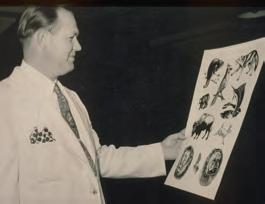


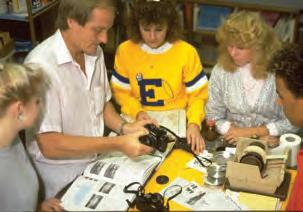
As the nation’s largest yearbook provider, Jostens has been proud to partner with the NSPA for over seven decades. When the company officially entered the yearbook business in 1950, they entrusted Otto W. Quale, a onetime assistant director of the NSPA, to manage their Owatonna, Minn.-based American Yearbook Company.
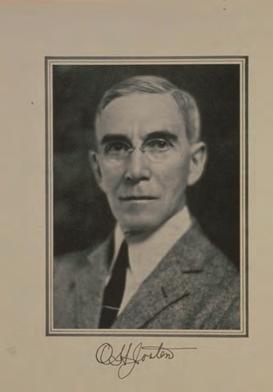
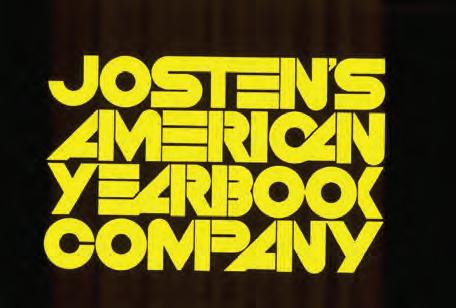
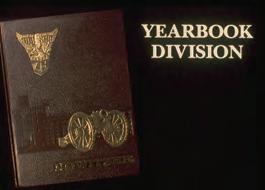
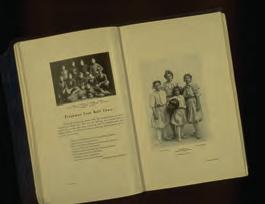
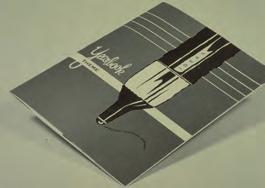

Jostens is thrilled to be celebrating the monumental accomplishments and important contributions of the NSPA. Here’s to the next 100 years!


JOSTENS IS PROUD TO SUPPORT THE YEARBOOK PROGRAMS THAT WERE RECOGNIZED IN THE PACEMAKER 100


CENIAD | East Lansing High School, East Lansing, Michigan



DETAILS | Whitney High School, Rocklin, California
EL PAISANO | Westlake High School, Austin, Texas
ETRUSCAN | Glenbrook South High School, Glenview, Illinois

FENTONIAN | Fenton High School, Fenton, Michigan
HORNET | Bryant High School, Bryant, Arkansas
MARKSMEN | St. Mark’s School of Texas, Dallas, Texas
PIONEER | Kirkwood High School, Kirkwood, Missouri
SAGA | Loudoun Valley High School, Purcellville, Virginia
TONITRUS | Rocklin High School, Rocklin, California

WESTWIND | West Henderson High School, Hendersonville, North Carolina
YEARBOOK | Bay High School, Bay Village, Ohio
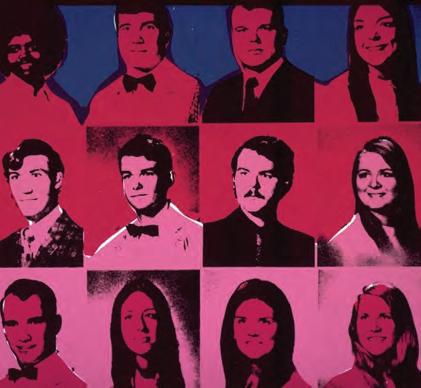
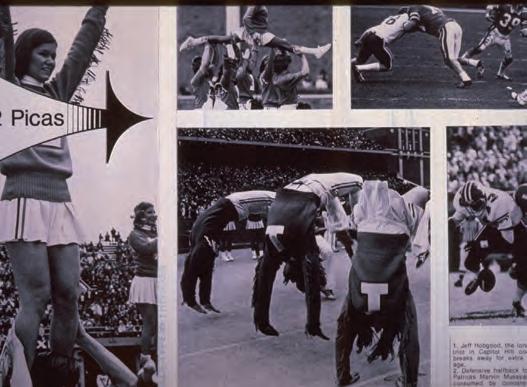
CELEBRATING NSPA’S OF SCHOLASTIC EXCELLENCE 100 YEARS
One hundred years represents millions of stories from multiple generations of students There are stories of love and victory – winning the big game, student activism, getting into the college of their dreams. But there are also stories of heartache and loss – breakups, wars, a pandemic.
Fashions and hairstyles change, traditions change, even what is learned in the classroom has changed over the years, but the commitment you’ve demonstrated has not. Neither has ours. Now in our 85th year, Walsworth has spent decades supporting student journalists and advisers, and we will always be working for you.
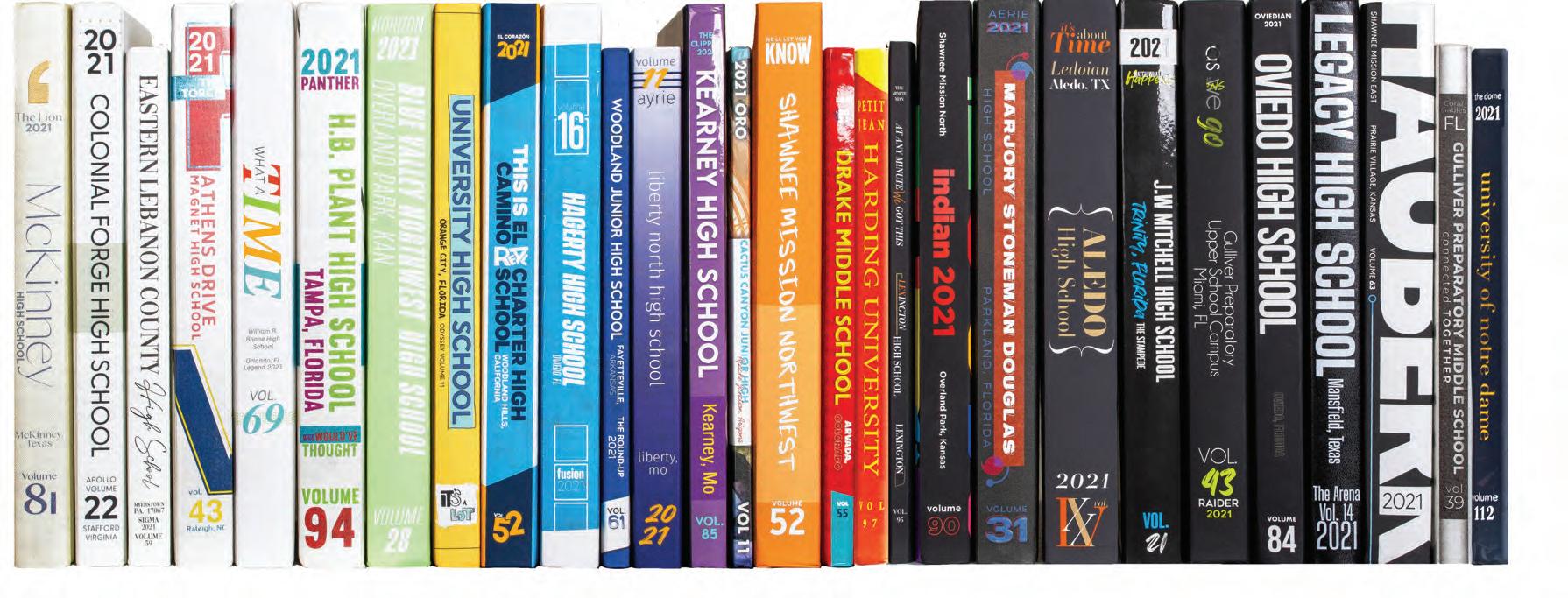
10
TOP
Your task is not easy, but you know that history matters. You pour your heart and soul into your yearbook because you know it’s all worth it. You’re part of the legacy now, and your story is just getting started. Whatever the future brings, Walsworth will stand by you, because that’s what family does.
Congratulations to these five Walsworth schools in the Top 10 NSPA Pacemaker winners of all time!
#1 #2 #3
#4 #9
Lair
Shawnee Mission Northwest High School
Shawnee, Kansas
Decamhian Del Campo High School
Fair Oaks, California
Wings
Arrowhead Christian Academy
Redlands, California
Brickhouse (Indian)
Shawnee Mission North High School
Overland Park, Kansas
Hauberk
Shawnee Mission East High School
Prairie Village, Kansas
CONGRATULATIONS TO OUR 28 NSPA PACEMAKER/PACEMAKER FINALISTS AND CSPA CROWN AWARD WINNERS FOR 2021 !





Celebrate Awesome BEST WISHES MOMENTOUS KUDOS Historic Outstanding
Exceptional YOU ROCK

100 cheers for NSPA as it surpasses 100 years! Congratulations and much deserved praise from your friends at Journalism Education Association • JEA.org FELICITATIONS
WOW
It All Starts Here
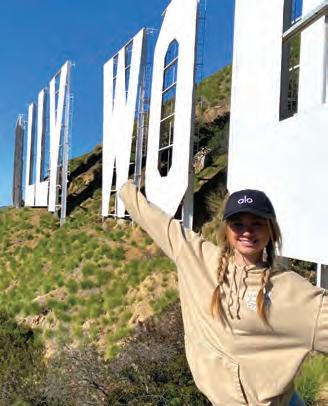
An award-winning journalism career. A major public relations campaign. Industry-changing communications research. An independent film that becomes a Sundance sensation. Elon alumni have done it all, and this is where it starts. Students in Elon’s School of Communications encounter a challenging curriculum and immerse themselves in professional settings. And they do it all under the mentorship of teacher-scholars with years of experience.
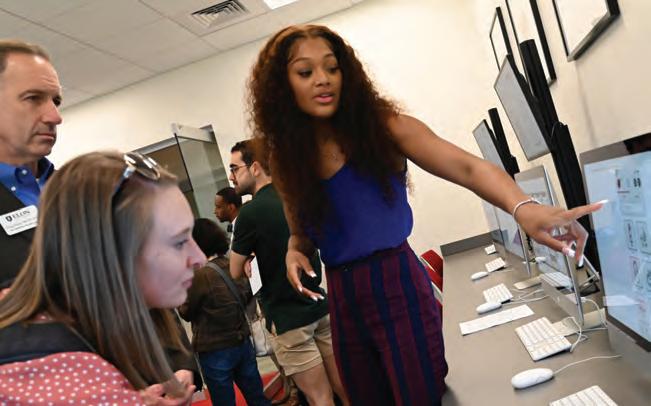


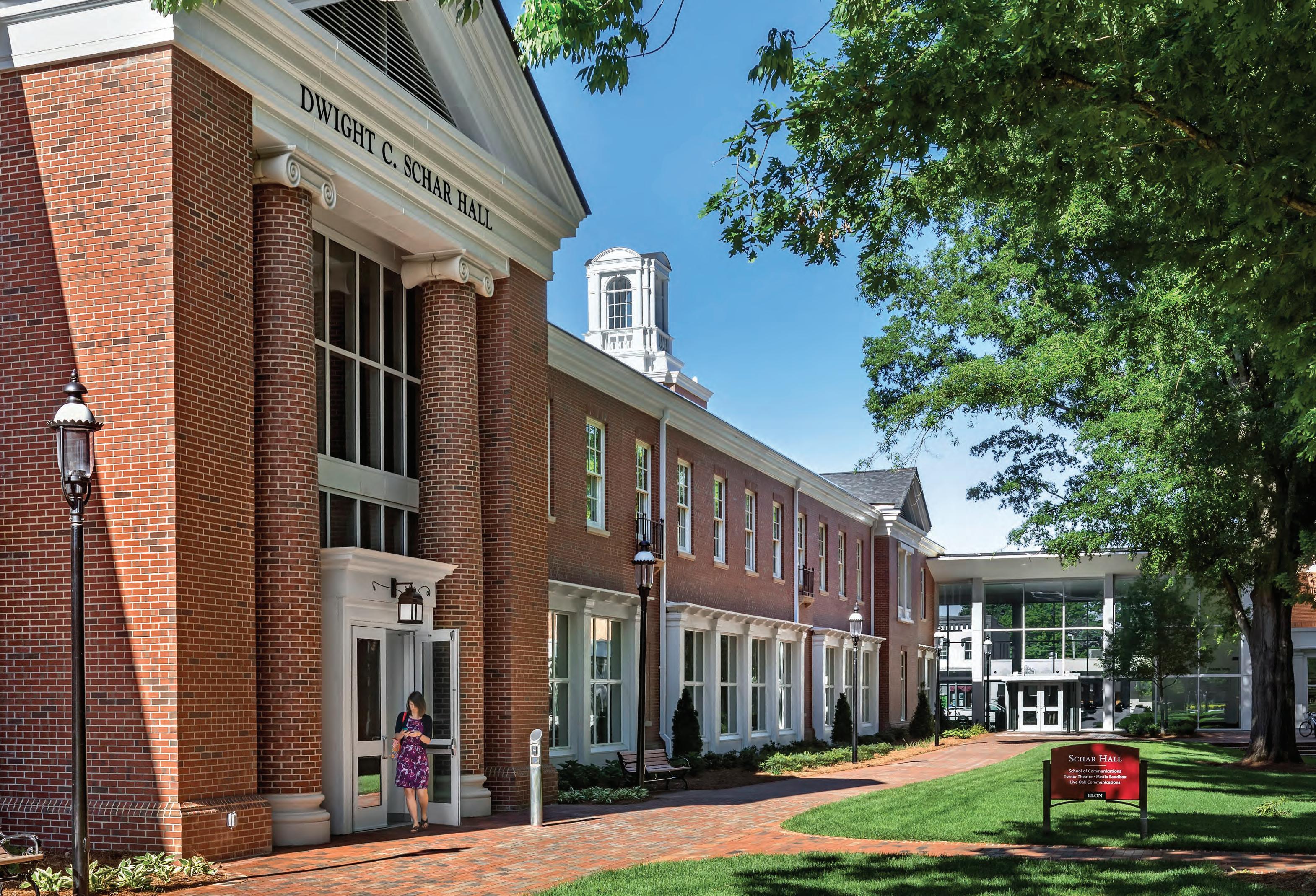
Elon University’s School of Communications is a proud partner of the National Scholastic Press Association. Here’s to another century of educating and training students to become ethical and enterprising journalists.


Congratulations
eloncomm eloncomm
Centennial Celebration
elon.edu/communications
THEY MAY NOT REALIZE IT YET, BUT AT THEIR HANDS HISTORY IS MADE.

WARRIOR SPEAR • NORTH COBB HS • KENNESAW, GA
CONGRATS
ON HITTING THE 100-YEAR MARK.
THANK YOU FOR BEING BY OUR SIDE AS WE WORK TOGETHER TO EMPOWER STUDENT JOURNALISTS.
BY YOUR

SIDE.
NOW. AND FOREVER.

222-151 © Shutterfly Lifetouch LLC At Lifetouch, we believe all moments and milestones deserve to be celebrated and remembered with a yearbook. We support our Yearbook Advisers and students from their first idea to the final yearbook sale. Visit schools.lifetouch.com/yearbooks to learn more about our innovative programs and educational support. Happy 100th Birthday! Congratulations NSPA/ACP. Your commitment to achieve excellence in scholastic journalism is inspiring!
CONGRATULATES YOU ON YOUR BIRTHDAY We’re
celebrating, too
Job well done, NSPA and ACP. You’ve served student journalism proudly, fully and effectively for 100 years. At the Frank W. and Sue Mayborn School of Journalism at the University of North Texas, we’re celebrating, too.
From our first program 75 years ago, we’ve worked to train many thousands of journalists and storytellers now working in all corners of the globe.
Today, as a Hispanic-Serving Institution and Minority-Serving Institution, UNT
and the Mayborn School are hard at work helping to create newsrooms and agencies that more accurately reflect the audiences they serve. And, like you, we plan to continue innovating and adapting to serve the students of tomorrow. Again, congratulations on your birthday. We’re celebrating right along with you.
Learn more about our history and our programs at journalism.unt.edu
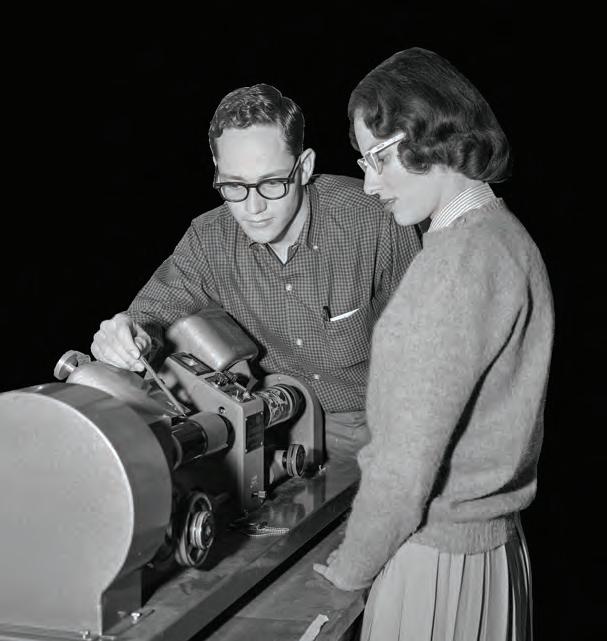

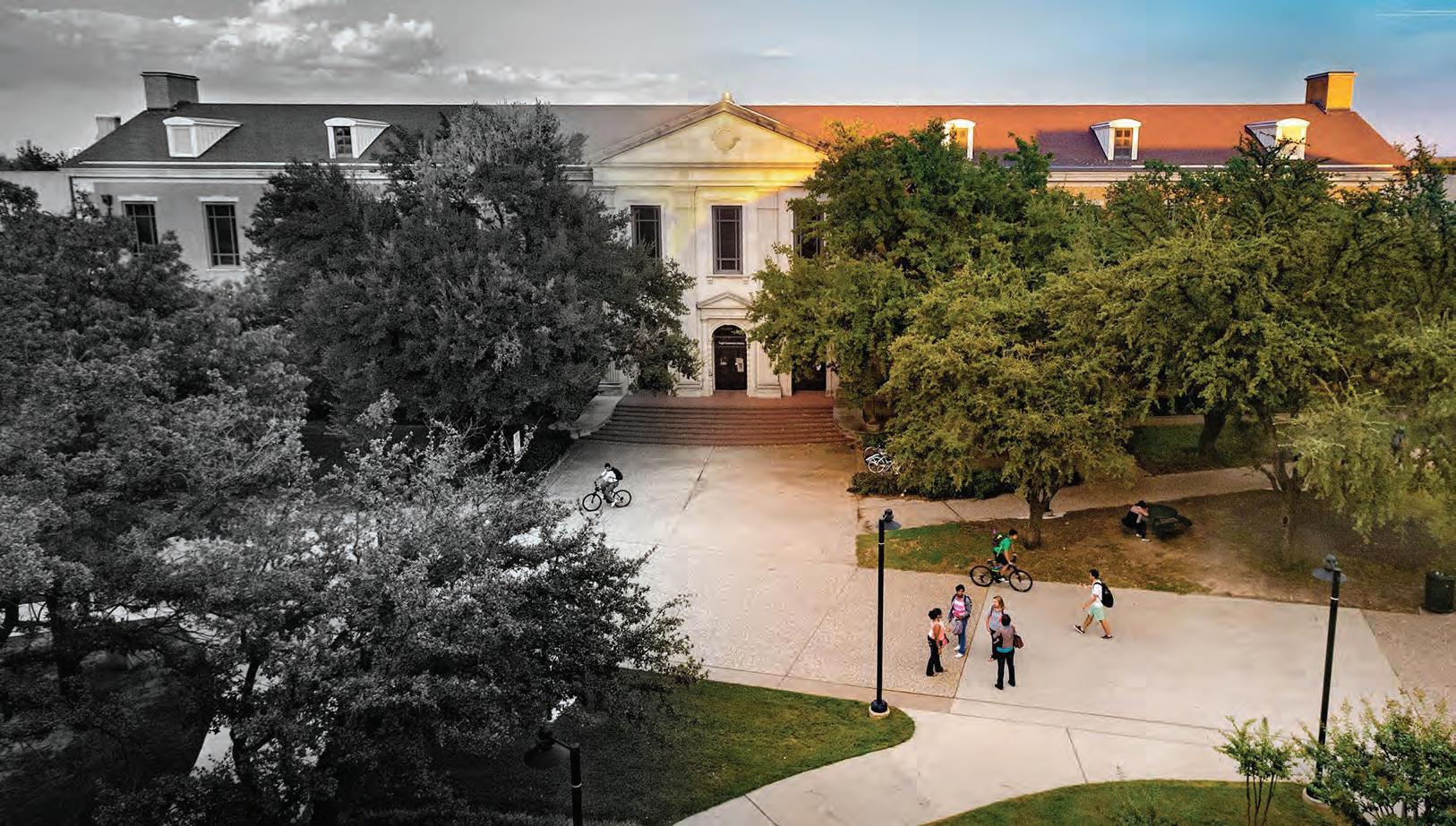
Mayborn School of Journalism | journalism@unt.edu | journalism.unt.edu

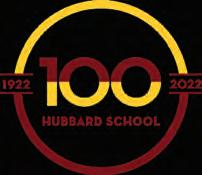
We’re a proud partner of the National Scholastic Press Association and the Associated Collegiate Press and congratulate them on 100 years. Celebrating 100 Years of Journalism Education at the University of Minnesota Discover your voice here. hsjmc.umn.edu | Twitter @UMN_HSJMC | Instagram & Facebook @UMNHSJMC

The members of SPJ congratulate the National Scholastic Press Association and Associated Collegiate Press for 100 years of achievements and success.
Welcome to the century club! We look forward to many more decades of working together to advance journalism and media.

Experience Create Thrive
A creative community that provides the resources, opportunities and environment you need to put your passion into practice — whether you’re starting college or getting a headstart in one of our precollege programs.
mediaschool.indiana.edu

HOW DO YOU DEFINE LEADERSHIP?

WHAT'S NLA'S MISSION? NEED MORE INFORMATON?
The NLA’s mission is to provide a network that empowers news leaders and emerging news leaders to build diverse, sustainable newsrooms that use fact-based information to inform and engage the communities they reflect and serve.
WHY SHOULD I JOIN?
Networking opportunities, a jobs board, member discounts, and innovative training and development programs are just a few of the advantages of NLA membership.
We welcome journalists, news leaders, newsrooms, universities, academics, students and corporate members. For membership rates and more go to: https://www.newsleaders.org/membership or scan the QR code below.
WHO WE ARE MEMBERSHIP RATES
The News Leaders Association knows that leadership comes in many different forms. NLA members are part of a vital network of news leaders with shared values and challenges. NLA strives to provide support and training for all sorts of news leaders at every level of an organization to build trust in journalism in service of democracy.
Through member support, NLA empowers journalists at all levels in digital, print, broadcast and academic newsrooms of all sizes with the training, support and networks they need to lead and transform diverse, sustainable newsrooms.
Professional - $150
Emerging Leaders Professional - $75, Available to journalists with less than 5 years of experience in a leadership role.
Student - $25
Retired - $75
Lifetime - $3,000 (one time payment)
Corporate Membership Package - $1,500**
Newsroom Membership Package - $1,250**
Academic Membership Package - $1,000**
**includes 10 professional memberships
For other membership opportunities contact us at membership@newsleaders.org
TO JOIN OR FOR MORE INFORMATION, GO TO HTTPS://WWW.NEWSLEADERS.ORG/MEMBERSHIP OR SCAN THE QR CODE ON THE LEFT .

The News Leaders Association (NLA) knows that leadership comes in many different forms. Become an NLA member.


National Scholastic Press Association Top 100 Pacemaker Award Honorees Congratulations Your story starts here. cronkite.asu.edu/explore


Create Once. Publish Everywhere. mysnworks.com • wesley@mysnworks.com MANAGE YOUR CONTENT NOT YOUR WEBSITE mySNworks.com SNworks makes your life on the web easier. CONGRATULATIONS! Thank you for supporting student journalists for the last 100 years.
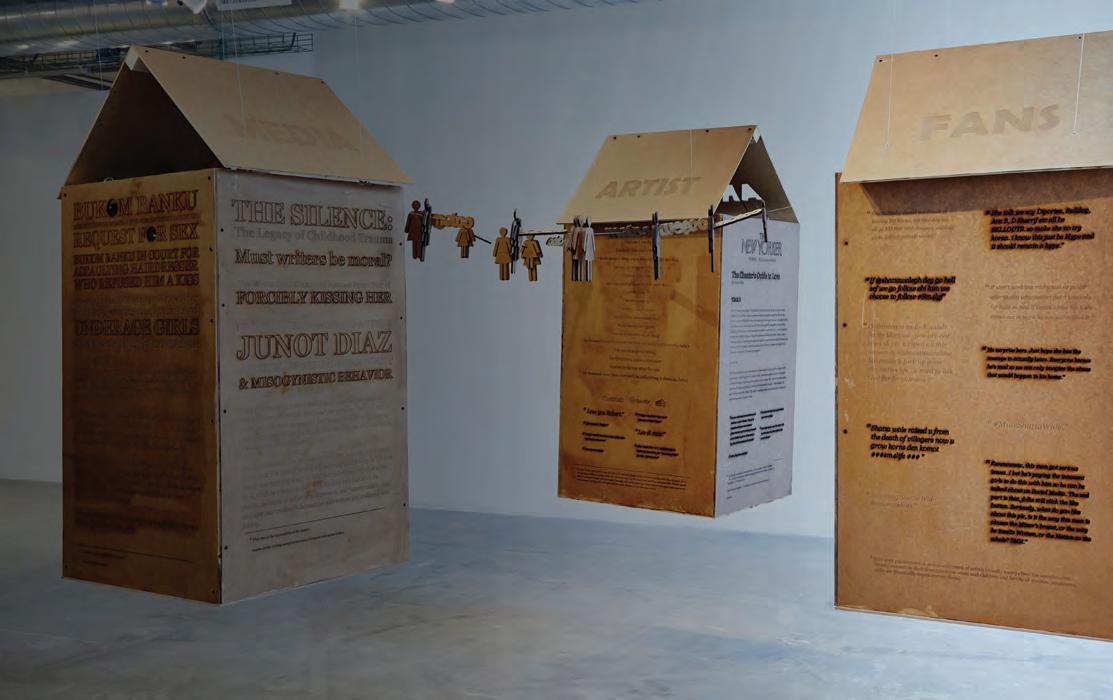

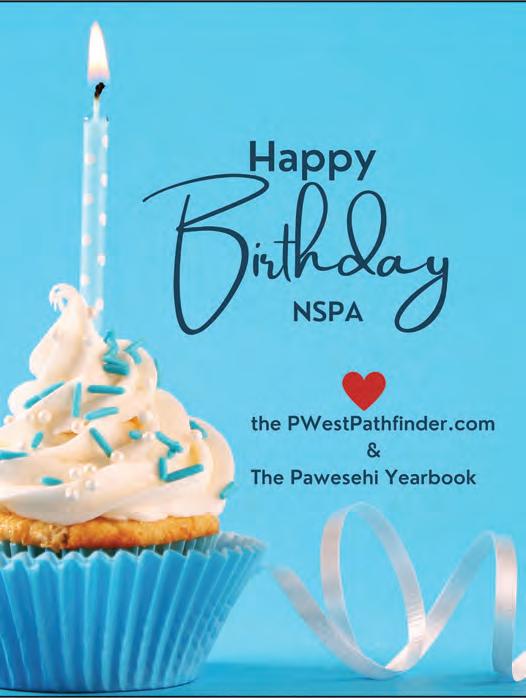
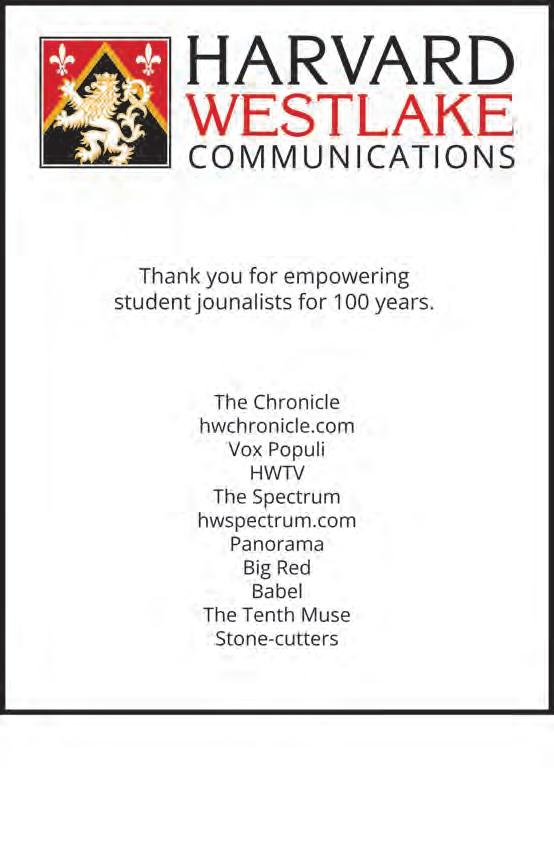
Ama Asantewa Diaka (MFA 2019), Tentacles , 2019 Apply Now saic.edu/gradapp SAIC GRADUATE ADMISSIONS | 312.629.6100 | saic.edu/gr | gradmiss@saic.edu STUDY WRITING AT THE NATION’S MOST INFLUENTIAL ART & DESIGN SCHOOL Tap into the unique potential of interdisciplinary writing through a curriculum modeled on studio art training and develop a range of hybrid work and collaborative projects. ___
CONGRATULATIONS TO THE ACP AND NSPA
FOR 100 YEARS OF GUIDANCE AND SUPPORT FROM THE


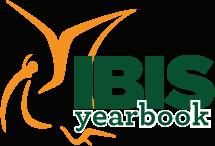

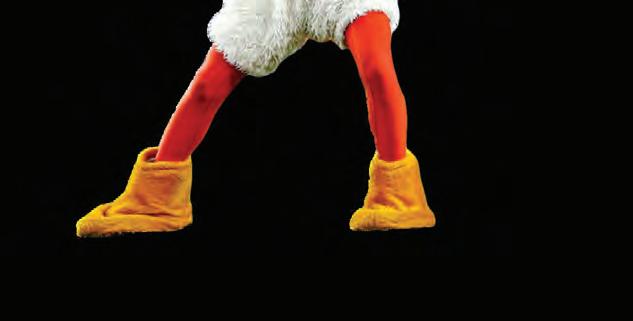



The Bell
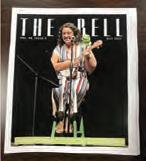
LIBERTY HIGH SCHOOL LIBERTY, MO
Thanks to NSPA for 100 years of empowering young journalists.
Friends of NSPA
Martha Akers
William Crisafi
Annette Deming
Gloria Eastman
Jessica Hunziker
Debra Klevens
Gary Lundgren
Michael Malcom-Bjorklund
Joanna Meza
LIBERTY HIGH SCHOOL LIBERTY, MO
Thanks to NSPA for 100 years of empowering young journalists.
Sarah Nichols
Meghan Percival
Linda Puntney
Beth Shull
Ray Westbrook
Laura Widmer
Spectator
Yearbook & Photo Jays
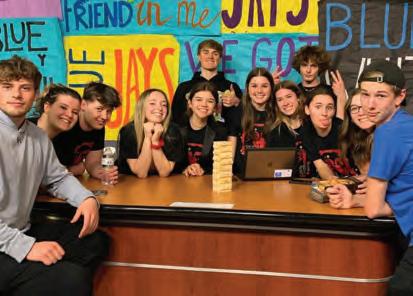

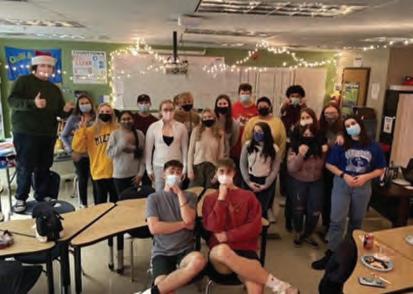
LIBERTY HIGH SCHOOL LIBERTY, MO
Thanks to NSPA for 100 years of empowering young journalists.
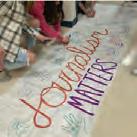
Bruce Watterson
“The Yearbook Whisperer”
Longtime NSPA volunteer, advocate & consultant
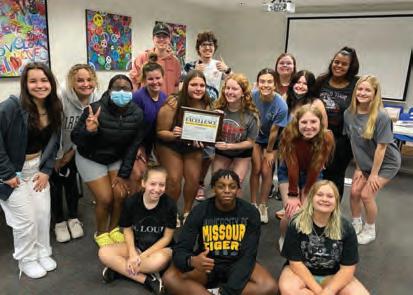
Student Newspaper
KLHS
Student Broadcast
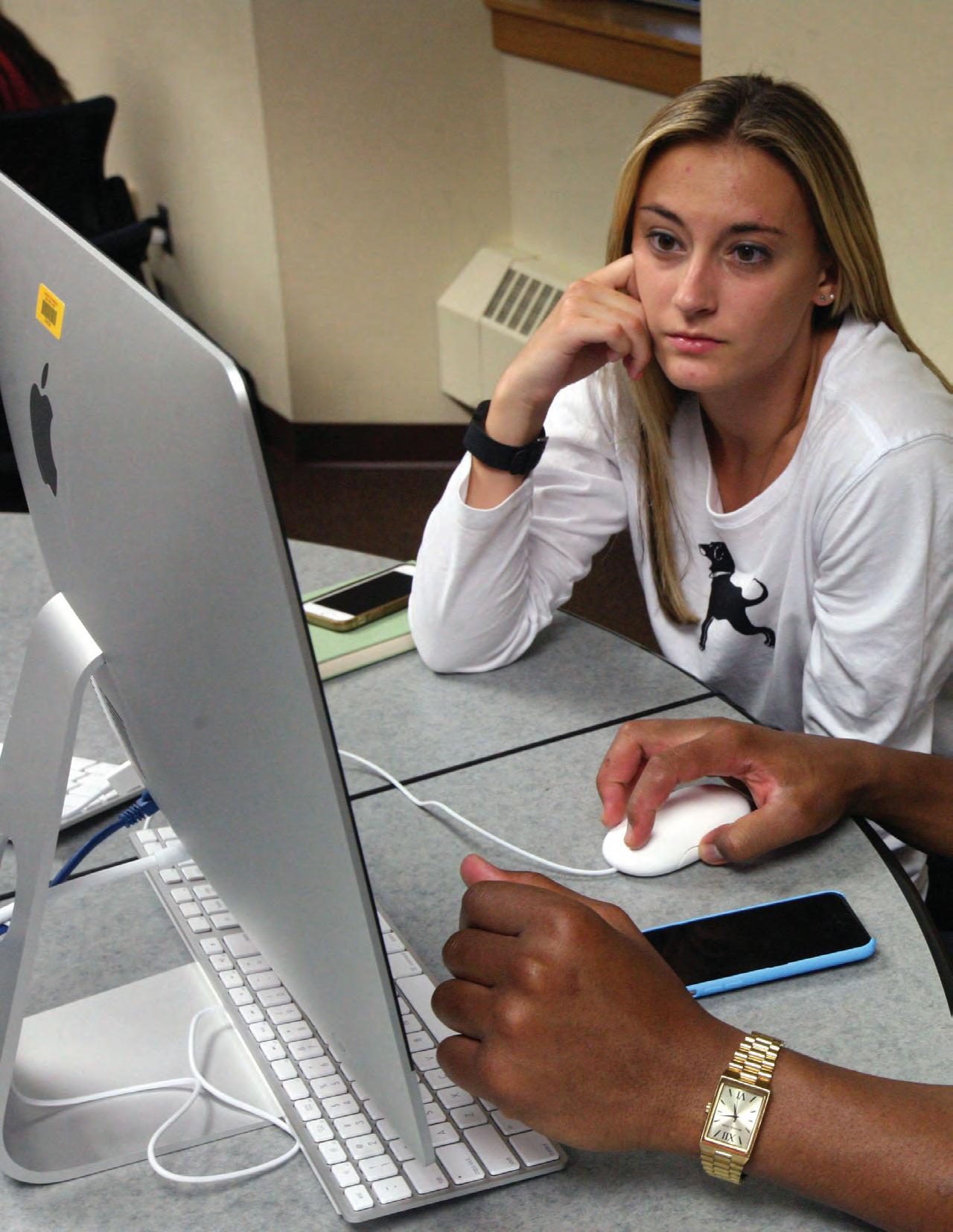
PICTURE PERFECT
Photographers Kayla Ebner and Dashawn Long critique their images during the ACP/CMA Summer Workshop at the University of Minnesota on June 15, 2016. On assignment, the students shot photos in Dinkytown near the campus before returning to the lab to edit the photos and write captions before sharing them with the class. In 2011, the ACP workshop adopted a handson approach to training and moved to campus abandoning a more lecture-oriented approach hosted in urban hotels.
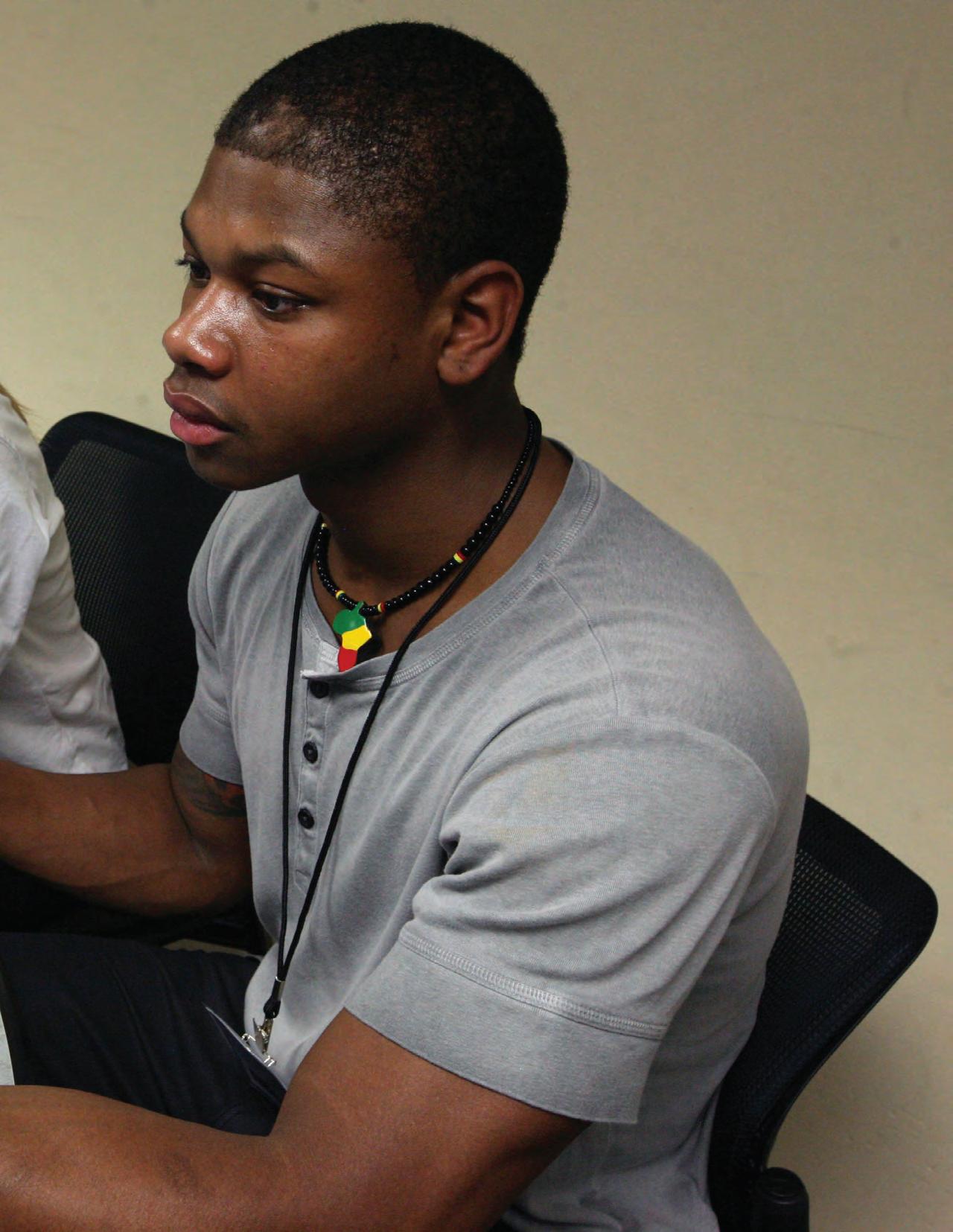
AUCTION ACTION
On the final evening of the Gloria Shields NSPA Media Workshop, the auction is a popular attraction. Students earn “Dallas Dollars” in their classes and bid on prizes big and small. Auctioneer Mitchell Franz (inset) keeps the crowd entertained. The popular workshop is held in Dallas each summer and attracts approximately 600 students from around the country.
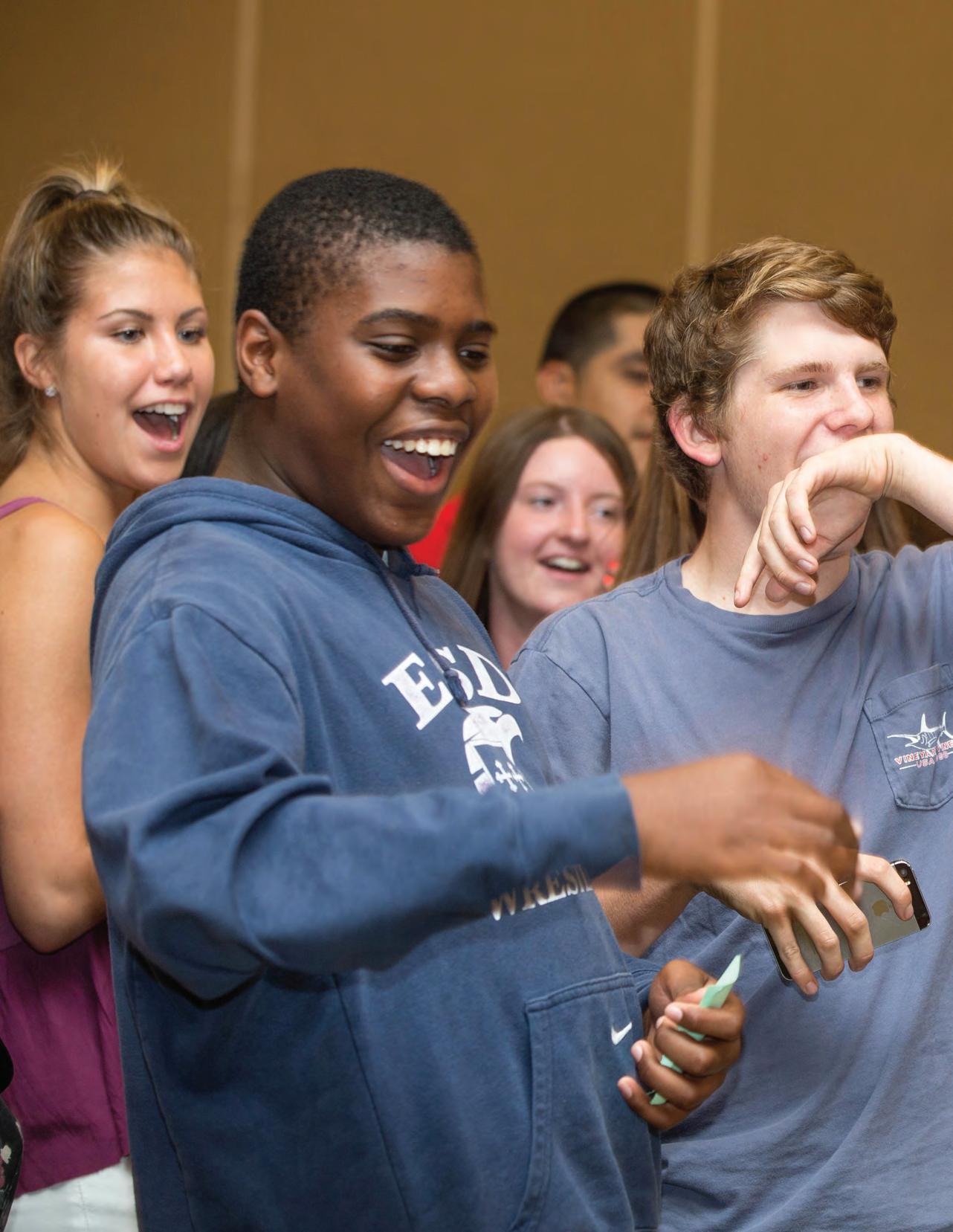
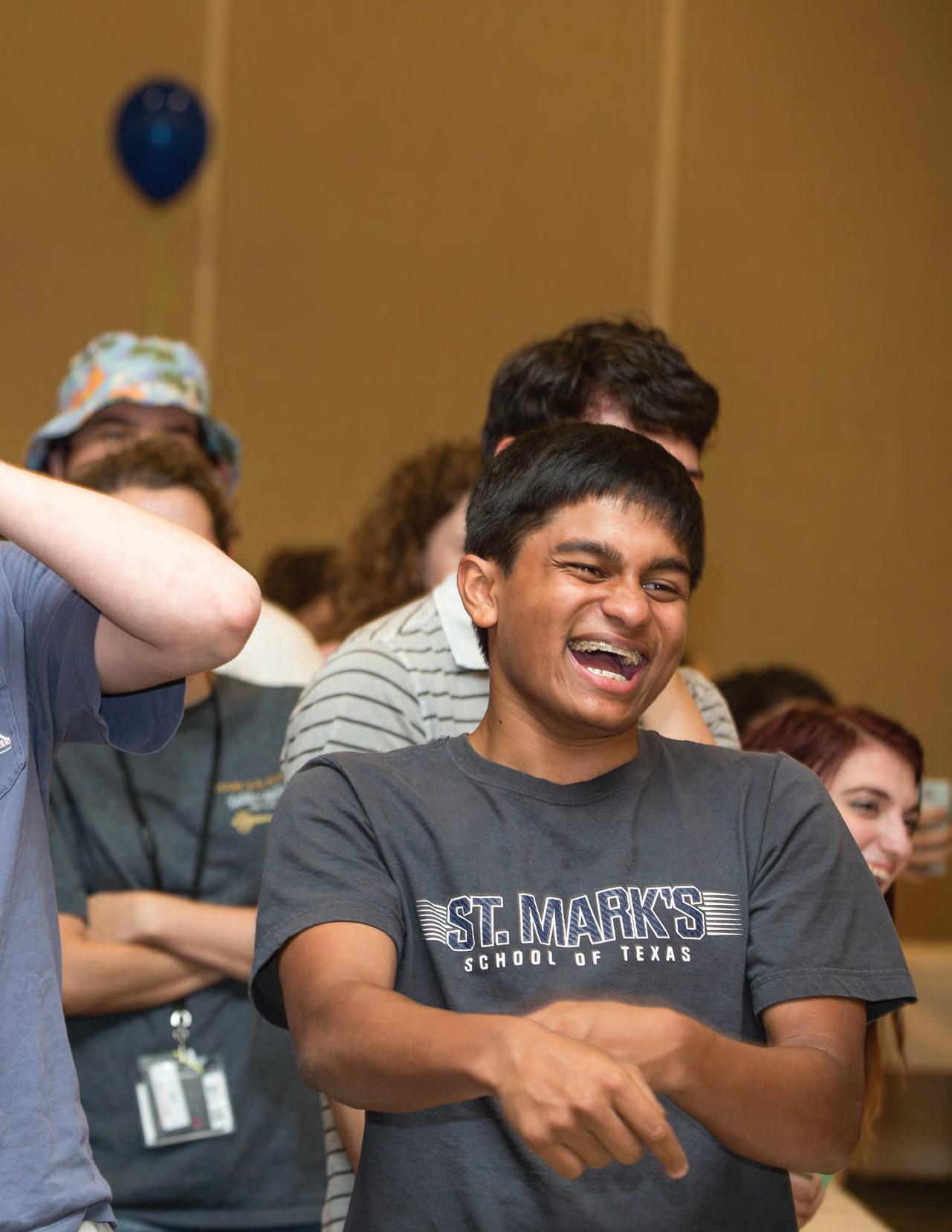

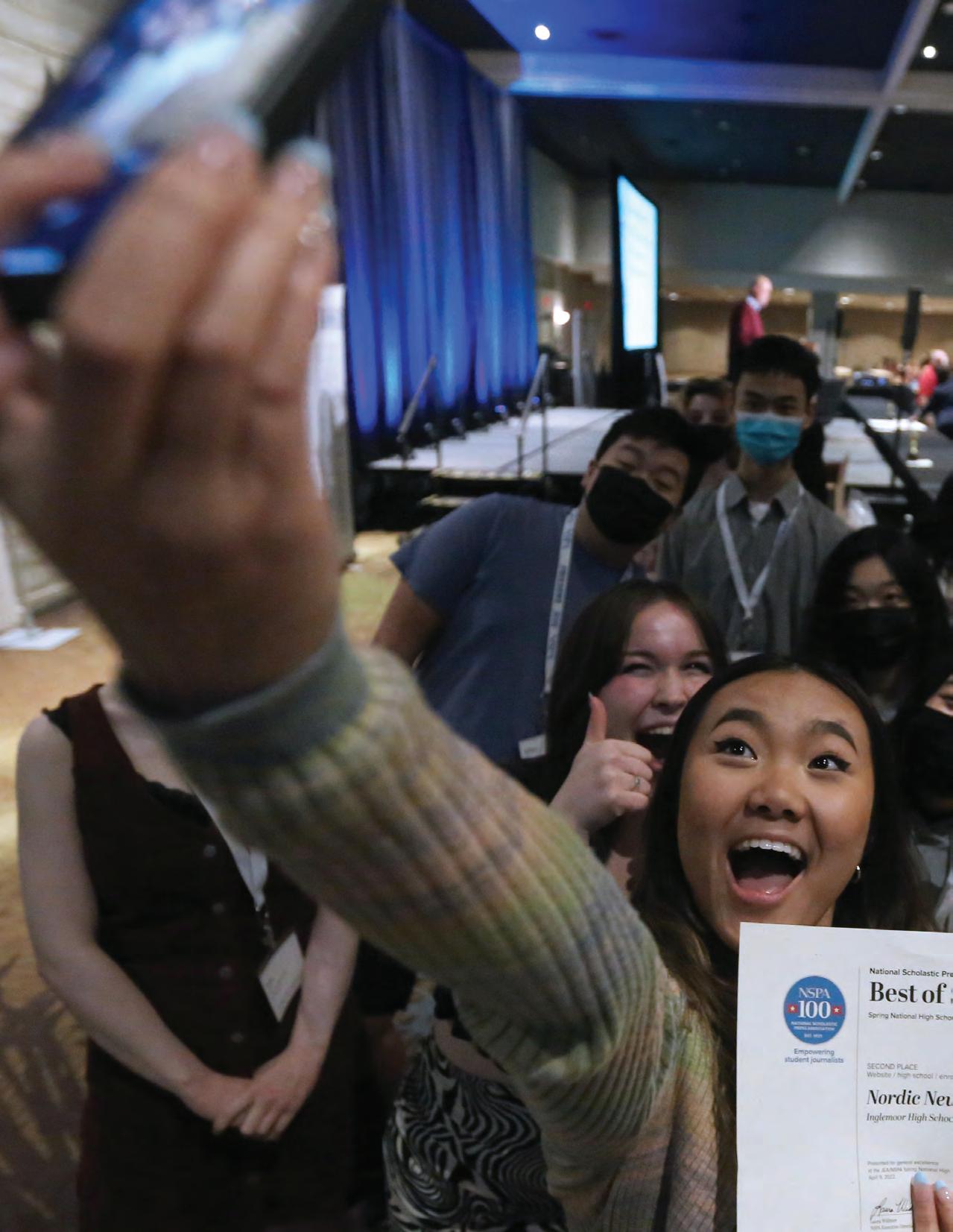
SOMETHING TO CELEBRATE
The Best of Show competition has been a popular offering at conventions since 1986. The highly competitive contest ranks student media represented at the convention. The Nordic News, Inglemoor High School (Kenmore, Washington) staff takes a selfie to celebrate its second place award for its website during the awards ceremony at the 2022 Los Angeles convention.
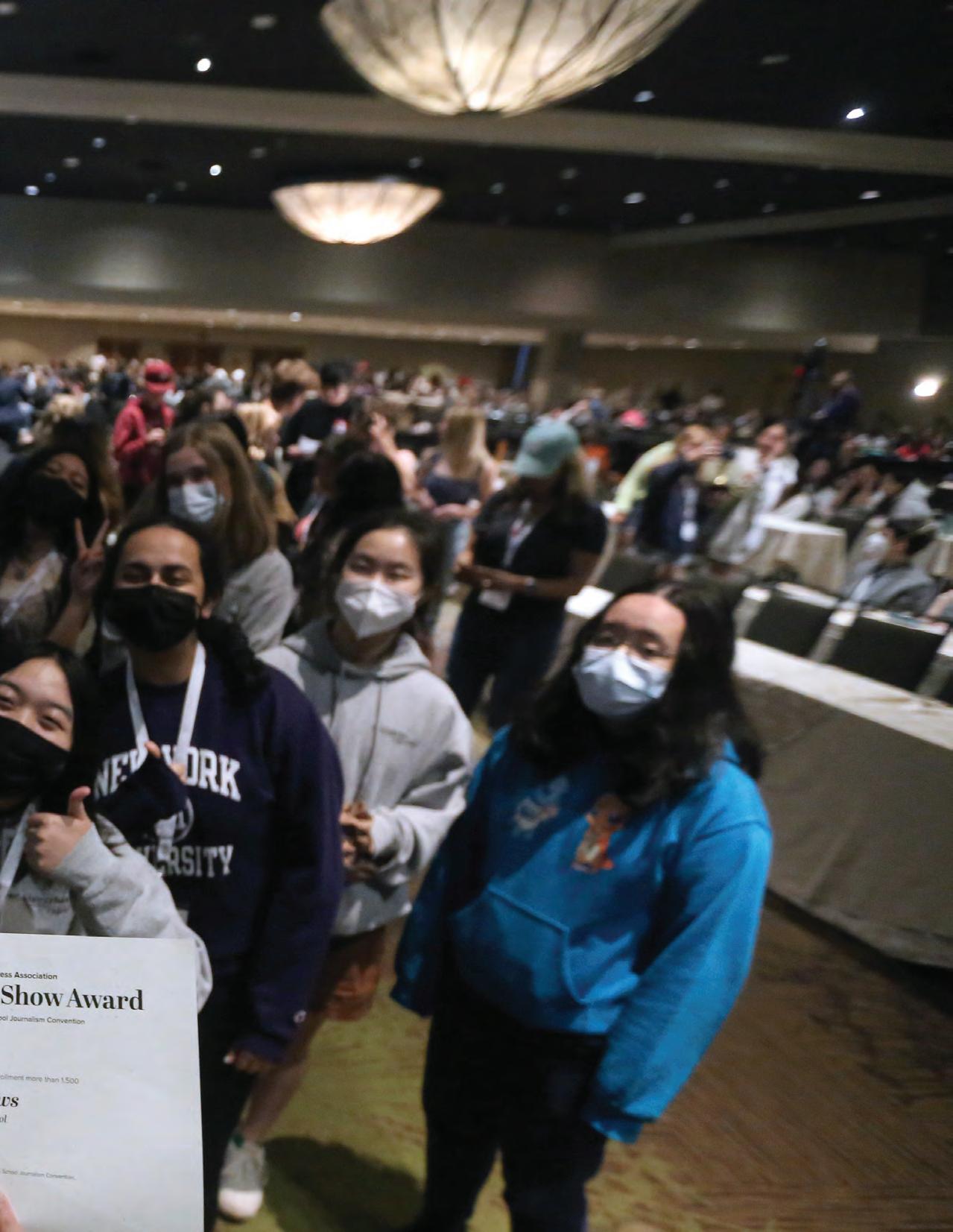
EARLY IN 2023, ADDITIONAL CONTENT, INCLUDING A COMPLETE INDEX FOR THIS BOOK, WILL BE POSTED ON THE NSPA/ACP WEBSITE.
EDITORS
GARY LUNDGREN, RON JOHNSON, LINDA PUNTNEY, LAURA WIDMER

SPECIAL THANKS
MOST OF THE CONVENTION AND WORKSHOP IMAGES FROM THE PAST 20-PLUS YEARS WERE GRACIOUSLY SHARED BY BRADLEY WILSON. THANKS FOR YOUR MAJOR CONTRIBUTIONS TO THIS BOOK AND YOUR SUPPORT OF NSPA/ACP.
THANKS TO HERFF JONES FOR PRINTING OUR HISTORY; WE APPRECIATE YOUR SUPPORT OF NSPA/ACP, YOUR FLEXIBILITY AS THE PANDEMIC ALTERED OUR PLANS AND THE EXTRA EFFORT THE PLANT TEAM INVESTED TO MAKE OUR VISION A REALITY.














































 > Ann Akers continued
> Ann Akers continued





























 ROWENA HARVEY
ROWENA HARVEY





















































 E. MARION JOHNSON
E. MARION JOHNSON































































































































































































































